
Hemet Coin Club
THE BEST LITTLE COIN CLUB IN
SOUTHERN CALIFORNIA
NUMISMATIC AND HISTORICAL QUESTIONS AND FACT (MAY 2021)

Q. I was recently told that there are a number of different portraits on the $10,000 Federal Reserve note? I thought Salmon P. Chase was the only one?
A. It’s a trick question! The 1918 $10,000 FRN, was the only large size $10,000 FRN issued and only 5 are still known to exist. While it is true that the face has the traditional portrait of Salmon P. Chase that is seen on the later small-size $10,000 notes, the reverse has a vignette based on the artist Robert Weirs’ painting “Embarkation of the Pilgrims”. Robert Weir completed the original work in 1843 as a commissioned painting for the Capitol Rotunda where it is displayed today.
However, in 1857, Weir painted a smaller version, which is now in the Brooklyn Museum of Art. In the later work, Weir made changes in light and details and achieved greater focus on the central figures by giving them fuller faces and broader shoulders. It is this second painting that the reverse vignette, engraved by W.W. Rice, is based on.  The painting depicts the Pilgrims on the deck of the ship “Speedwell” in 1620. The are a total of 16 figures identified by name at the center of the composition, that include Plymouth Colony leaders William Brewster (Pastor), holding the Bible; John Carver (1st Governor), kneeling; John Robinson (Pastor), with extended arms, and Miles Standish, kneeling right. The Speedwell was a ship that sailed with the Mayflower to New England. So, technically!, there are 17 identified portraits on the 1918 $10,000 bill.
The painting depicts the Pilgrims on the deck of the ship “Speedwell” in 1620. The are a total of 16 figures identified by name at the center of the composition, that include Plymouth Colony leaders William Brewster (Pastor), holding the Bible; John Carver (1st Governor), kneeling; John Robinson (Pastor), with extended arms, and Miles Standish, kneeling right. The Speedwell was a ship that sailed with the Mayflower to New England. So, technically!, there are 17 identified portraits on the 1918 $10,000 bill.

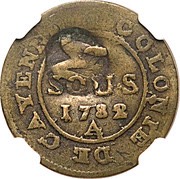
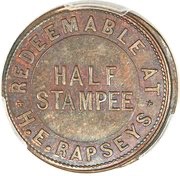
Q. What is a “black dog”?
A. A dog, or a black dog, is/was a debased coin used primarily in the Caribbean Islands around the late 1700’s. Most were made of pewter or copper, typically worth 1½ pence or 1⁄72 of a dollar. The name comes from the negative connotations of the word "dog," as they came from debased silver coins, and the dark color of those same debased coins. Black dogs were also at times called "stampes" or "stampees," as they were typically the coins of other colonial powers—French coins worth 2 sous or, equivalently, 24 diniers—stamped to make them British currency.
However, a black dog and a stampee were not necessarily of equal value. For example, the Spanish dollar was subdivided into bits, each worth 9 pence, 6 black dogs or 4 stampees. Before 1811, 1 dollar equalled 11 bits (making a dog 1⁄66 of a dollar and a stampee 1⁄44 of a dollar); after 1811, 1 dollar equalled 12 bits (making a dog 1⁄72 of a dollar and a stampee 1⁄48 of a dollar). In 1797, however, a "black dog" is equated with a “stampee.” (Editors note: Making change must have been a project!)
Later, stampees were actually locally produced for their own value as a local currency. Generally these pieces were used by slaves and the people dealing with them for small market transactions and as gifts.
EDUCATIONAL FACT:  The modern version of enameling of coins is currently frowned upon as it generally destroys the numismatic value of the host. However, mostly in England, toward the end of the 19th century, a large improvement in artistic and manufacturing skills was used in the making of coin jewelry utilizing enameling techniques.
The modern version of enameling of coins is currently frowned upon as it generally destroys the numismatic value of the host. However, mostly in England, toward the end of the 19th century, a large improvement in artistic and manufacturing skills was used in the making of coin jewelry utilizing enameling techniques.
In most cases, the champleve process was used. This involved delicately cutting away the design of a struck coin to form shallow troughs that were filled with a powdered, glass-based, vitreous compound. The coin then was heated, causing the powder to melt and fuse to the metal surface. The fine edge of each  trough prevented the colors from running into one another. The craftsmen also allowed certain parts of the coin’s images or lettering to stand out and be utilized as part of the overall design.
trough prevented the colors from running into one another. The craftsmen also allowed certain parts of the coin’s images or lettering to stand out and be utilized as part of the overall design.

Coins enameled by this traditional method usually use three to five colors. Shaded portraits, colorful images of national emblems, lifelike animals — all appear to have been “painted” on the coin, imitating or replacing the design that once was there. Quite frequently coins are found with enamel on both sides although, since the coins had to be heated for the enamel powder to melt, it is presently unknown how the original jewelers did it. Since these designs were very complicated, unfortunately, the art form a short life.
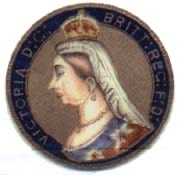
Additionally, the early British laws about defacing coinage made the enameling of coins, at best, questionable, and with the Act of 1920 specifically made it an offense to “melt down, break up or use otherwise than as currency any gold or silver coin.” The defacing of “current copper coin” was also added as a crime under the Coinage Offences Act of 1936.
Though not specifically passed to eliminate the small-time jewelers and manufacturers of enameled coins, these Acts — and the added effect of labor shortages and high production costs caused by the First World War — brought an end to the era of enameled coin jewelry.
1887, Queen Victoria’s Golden Jubilee, saw the largest production of these coins with the heavy demand for Royal memorabilia. Popular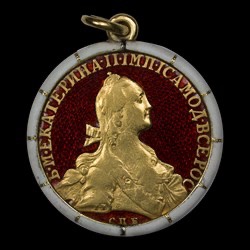 designs included leaves and flower, coats of arms, Britannia and of course, Queen Victoria herself. In some the bust of the monarch are completely removed and replaced in enamels. The rarest enamel coins are those of gold. Few examples can be seen today, and those that do exist are mainly are made from dated sovereigns.
designs included leaves and flower, coats of arms, Britannia and of course, Queen Victoria herself. In some the bust of the monarch are completely removed and replaced in enamels. The rarest enamel coins are those of gold. Few examples can be seen today, and those that do exist are mainly are made from dated sovereigns.
Today these original enameled coins are very collectible and enough were produced that they are not particularly expensive (under $200 for silver coin based examples), although, as is usual of collectibles, fakes abound, so buyer beware!
Currency Note of the Month


While extremely rare, I still wanted to feature one of these notes because they are an excellent example of early banknote design beauty.
This is a 1895 $5 Republic of Hawaii ,Gold Certificate of Deposit. It carries the obligation on the face as follows “ This Certifies, That There Have Been Deposited At The Hawaiian Treasury – Five Dollars – In Gold Coin Payable To The Bearer On Demand”.
Printed by the American Banknote Co. (New York), the front shows a woman identified only as “Haidee” at left. A mansion with palm trees is on the front center. The right side of the bank note shows the head of a bull. The reverse is a very ornate design with a large “Hawaiian Treasury” around the Treasury Seal all in shades of gold ink.
As I noted above, these notes are extremely rare. The above note is a punch cancelled proof and would easily fetch $6-8000 at auction. Issued notes with serial number and signatures are even more valuable, $15-20,000.
Coin of the Month
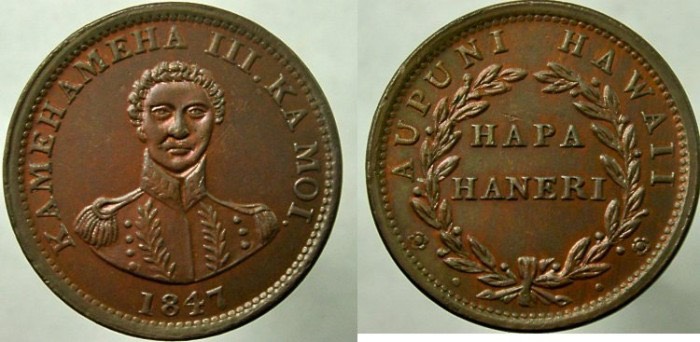
Hawaiian Keneta The ill-fated 1847 Keneta was commissioned by King Kamehameha III to provide small change, which was always in short supply, for use in the Hawaiian Islands. The Legal Code was changed to peg the value of the new copper coin to the US large cent as were other denominations that were to be minted later.
On 3 May 1847 the merchant ship Montreal arrived in Honolulu after sailing from Boston. The 100,000 new Keneta coins were part of the cargo that was delivered. When the coins reached the public they proved a grave disappointment. Reports of the time state that the King's portrait was unrecognizable. In addition, the Keneta also arrived worn or discolored by the humidity and bilge water of the Montreal, in whose hold they had spent many months.
Rejected by the local citizens, the only general usage was by governors of the outer islands who used them as change when collecting duties and taxes. Their legal tender status was removed in 1884, and in the following year 88,305 were sold as scrap and shipped out of the country.
The coin bears a bust of the king on the obverse surrounded by the legend "KAMEHAMEHA III. KA MOI." and the date 1847 below. The reverse has "HAPA HANERI" within a leafy wreath, tied with a bow at bottom, surrounded by "AUPUNI HAWAII."
There are 8 known varieties, 2 obverse and 6 reverse.
The Keneta is about the same size as the United States Large Cent and is 100% copper with a plain edge. Examples are available for $2-300, but beware that valueless souvenir restrikes were made and sometimes sold as authentic!
WEBSITE OF THE MONTH
https://en.wikipedia.org/wiki/List_of_people_on_banknotes
For those of you collecting World Banknotes this website is very useful and interesting for identifying the people on the banknotes you collect. Arranged by country and denomination, it is a quick and easy reference to who the person is on a countries banknote and what made them noteworthy enough to get featured on that banknote!
NUMISMATIC AND HISTORICAL QUESTIONS AND FACT (APRIL)
Q. I know that fractional currency shields were sold to banks to help bank personnel recognize the new notes and identify counterfeits. Were any sold for use by retailers or merchants?
A. It is unknown if any retailers used or purchased shields. They cost $4.50 when they were first sold so banks were almost certainly the primary market although even banks weren’t overly enthusiastic about purchasing one as indicated by the number of unsold shields
But, the Library of Congress (LOC) does have a specimen shield that features advertising.
The shield is framed by a cutout in a sheet on which are printed 27 advertisements for businesses in Cincinnati, Ohio. This was obviously an attempt to generate sales for the businesses and they probably would have paid a fee to have their advertising displayed. The reverse of the shield is marked “Specimen” so there is no way of knowing whether any shields were actually marketed with advertising or if this was an experiment with an example that happened to be saved. The LOC’s example has pencil markings on the advertising overlay that indicate it was the working example used by the printer.
The advertising was copyrighted as noted at the bottom center “Entered according to Act of Congress, in the year 1867, by John Stanton, in the Clerk's Office of the United States, for the Southern District of Ohio.” The printer is also noted at the bottom: “Printed at the office of John Tanner & Co., No. 8 E. Fourth St.,c1867.”
It is the only known shield with advertising and the advertisements are exceptionally interesting!
Q. I recently read a mention about a unique issued WWII Canadian 5 cent piece?
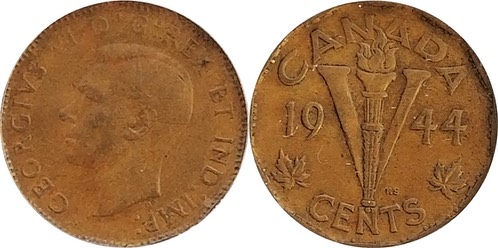
A. During WWII, Canadian nickel was in great demand as a war material. This forced the temporary abandonment of its use in the coining of five-cent pieces. Starting in 1942, the first substitute material employed was a type of brass alloy, called tombac. These type of 5 cent pieces were coined thru 1943 when the Canadian mint decided to change its 5 cent coinage to steel with nickel and chromium plating. However, according to the 1944 Canadian Mint report, $400 in face value, or 8,000 tombac 5 cent pieces were also produced in 1943, dated 1944. No one knows the fate of the other 7,999 coins, but it is known that no other example has surfaced since Michigan dealer John Abbott bought this certified specimen at a sale in 1982. It has since changed hands to an anonymous owner and is currently listed for sale by Heritage with a “Buy Now” price of $777,778, although that listing has been up for some time with no takers. Considering that it is certified as in VF35 condition it is believed to have circulated for some time before being discovered. While there is disagreement as to whether it should be considered a pattern vice a regular issue, the piece is currently unique among Canadian coinage.
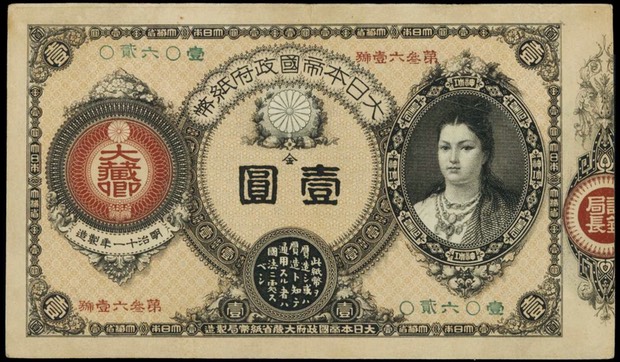
EDUCATIONAL FACT: 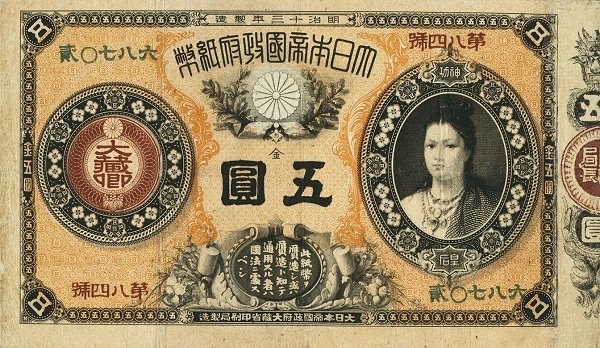 In 1881, Japan, in an effort to prevent counterfeiting, released the first of what are known as “Empress Jingū” notes because of their design. These notes feature an artist's representation of the Empress Jingū that was commissioned by Italian engraver Edoardo Chiossone. This design is notable for being the first portrait on a Japanese banknote, and the only female depicted on Japanese paper currency until 2004, when Higuchi Ichiyō was depicted on the ¥5000. A number of anti-counterfeiting features were designed into the notes, including an elaborate watermark. Also present on the ob
In 1881, Japan, in an effort to prevent counterfeiting, released the first of what are known as “Empress Jingū” notes because of their design. These notes feature an artist's representation of the Empress Jingū that was commissioned by Italian engraver Edoardo Chiossone. This design is notable for being the first portrait on a Japanese banknote, and the only female depicted on Japanese paper currency until 2004, when Higuchi Ichiyō was depicted on the ¥5000. A number of anti-counterfeiting features were designed into the notes, including an elaborate watermark. Also present on the ob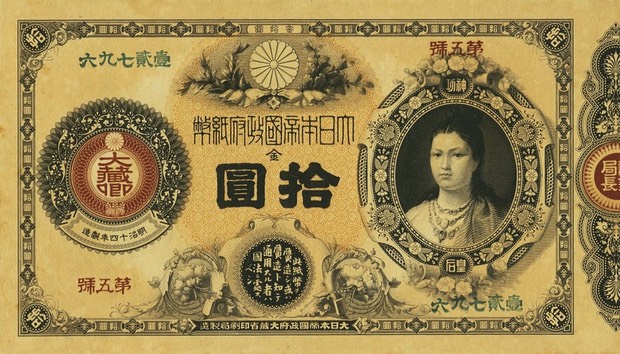 verse are counterfeit penalties which were later expanded in the Meiji era. The reverse side meanwhile features inscriptions from the Ministry of Finance, and displays the Treasurer's seal. ¥5 and ¥10 were released in 1882 and 1883 as well. However, the legend, and it is mostly unverifiable legend, of Empress Empress Jingū is quite the story!
verse are counterfeit penalties which were later expanded in the Meiji era. The reverse side meanwhile features inscriptions from the Ministry of Finance, and displays the Treasurer's seal. ¥5 and ¥10 were released in 1882 and 1883 as well. However, the legend, and it is mostly unverifiable legend, of Empress Empress Jingū is quite the story!
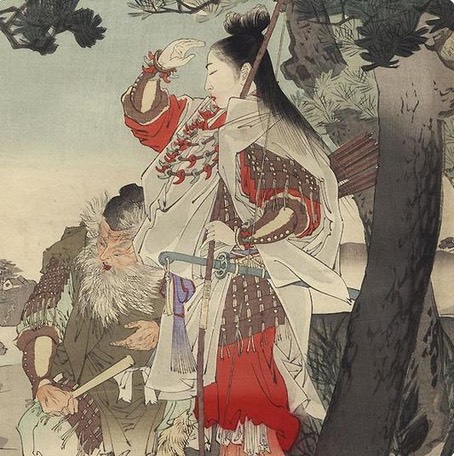
Empress Jingū was a legendary Japanese empress and onna-bugeisha, an educated and trained female Samurai warrior, who ruled as a regent following her husband's death. Her husband ,Emperor Chūai, died in 200 AD having been killed directly or indirectly in battle by rebel forces. Regent Jingū soon focused her rage on the rebels, whom she vanquished in a fit of revenge.
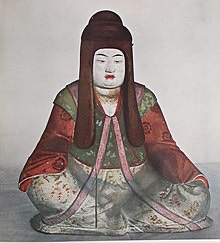
Legends say that she then turned her attention to a "promised land”, most likely the Korean peninsula. Both the Kojiki and the Nihon Shoki semi-historical texts (collectively known as the Kiki) record events that took place during Jingū's alleged lifetime. Empress Jingū is thus considered to be a controversial monarch by historians in terms of her alleged invasion of the Korean Peninsula. The narrative of Empress Jingū invading and conquering the Korean Peninsula is now considered controversial and up for debate as it involves both the Japanese and Korean point of view. However, this was in turn, possibly used as justification for imperial expansion during the Meiji period. The legends state that the Empress Jingū gave birth to a baby boy whom she named Homutawake three years after he was conceived by her late husband.

Empress Jingū's reign is conventionally considered to have been from 201 to 269 AD, and was considered to be the 15th Japanese imperial ruler until the Meiji period. Modern historians have come to the conclusion that the name "Jingū" was used by later genera- tions to describe this legendary Empress. It  has also been proposed that Empress Jingū actually reigned later than she is attested. While the location of Empress Jingū's grave (if any) is unknown, she is traditionally venerated at a kofun-type Imperial Tomb at the Imperial Household’s mausoleum in Nara. It is accepted today that Empress Jingū reigned as a regent until her son became Emperor Ōjin, later deified as the “God of War” Hachiman, upon her death. She was additionally the last de facto ruler of the Yayoi period (300BC to 300AD).
has also been proposed that Empress Jingū actually reigned later than she is attested. While the location of Empress Jingū's grave (if any) is unknown, she is traditionally venerated at a kofun-type Imperial Tomb at the Imperial Household’s mausoleum in Nara. It is accepted today that Empress Jingū reigned as a regent until her son became Emperor Ōjin, later deified as the “God of War” Hachiman, upon her death. She was additionally the last de facto ruler of the Yayoi period (300BC to 300AD).
Whether a product of history or legend, Empress Jingū has left a lasting mark on Japanese culture and will forever be revered as a powerful shaman and onna-bugeisha, imperial ruler of ancient Japan in a world of men, and the mother of the God of War.
Coin(s) of the Month
Faeroe Islands Coinage This month I am actually featuring a set of coins. For those of you that like to collect complete sets, there are only 5 regular circulation coins combined with the same 5 coins in Proof.
The Faeroe Islands are a self governing community of 17 inhabited islands within the kingdom of Denmark. In 1940, when Denmark was occupied by the German Army, the Faeroe Islands were occupied by the British. Since small change was still needed to conduct day to day transactions, the British minted bronze and copper-nickel coinage, with the Denmark name for use in the islands. These were produced in 1, 2, 5, 10, and 25 Ore denominations, with 100 Ore equal to 1 Krone. All the denominations are dated 1941, although they were produced in both 1941 and 1942. The circulating issues are readily available with a circulated set running less than $200. For those with bigger pockets, the proof versions run $5-600 each so they may prove to be a bit more challenging. Today, the Faeroe Islands have their own coinage and currency denominated in Krone which trades on par with the Danish Krone, although it usually is not accepted for circulation in Denmark.
Currency Note of the Month
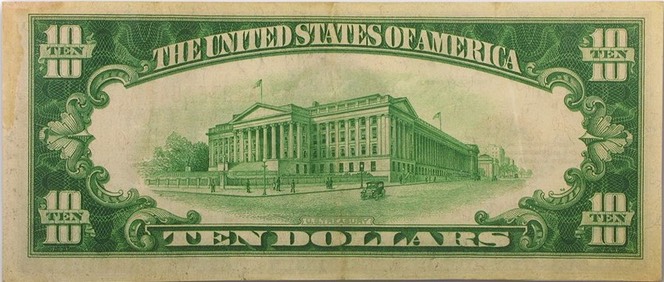
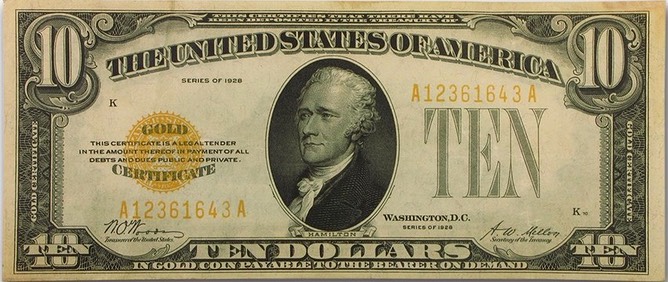
I noticed that I haven’t done a small size note in some time so I thought I would put this one in this month!
This is a Series 1928 $10 Gold Certificate.
In 1928, the government issued a new series of Gold Certificates. These notes are the same size as todays notes. This $10 note features Alexander Hamilton on the face, along with gold serial numbers, a gold Treasury seal, and the legend “Gold Certificate”. Also, starting at the top center and finishing at the bottom center, the notes proclaim that “This certifies that there have been deposited in the Treasury of the United States of America Ten Dollars In gold coin payable to the bearer on demand.”
The reverse has the same green backs as the later Federal Reserve notes with a portrait of the U.S. Treasury Building.
These notes were short-lived due to Executive Order 6102 signed on April 5, 1933, by US President Franklin D. Roosevelt "forbidding the hoarding of gold coin, gold bullion, and gold certificates within the continental United States” and requiring the notes be redeemed in Federal Reserve notes.
Despite the order, a large number of these notes survived and are readily available to collectors today. Nice examples of the $10 Certificate generally sell for less than $200.
BOOK OF THE MONTH
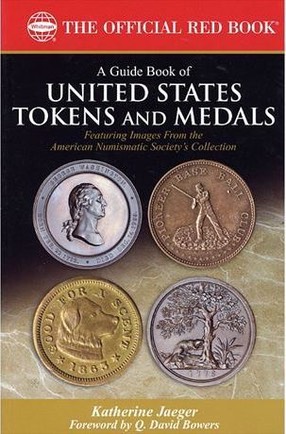
A Guide Book of United States Tokens and Medals (Official Red Book) by Katherine Jaeger
Since the 1700's, Americans have used tokens and medals to en- courage business, lampoon politicians, celebrate special events, pay fares, promote social causes, award the deserving, and scold the wicked. In the Guide Book of United States Tokens and Medals , award-winning author Katherine Jaeger explores these fascinat- ing and collectible pieces of American history, from colonial times to today. Thousands of full-color illustrations, market values, and a grading guide add to the book's reference value. Essential reading for every coin collector and American history buff! Featuring full color images from the American Numismatic Society's Collection.
NUMISMATIC AND HISTORICAL QUESTIONS AND FACT (MARCH)
Q. I recently saw a Tiffany Commission note in a dealers display case and I wondered if you could give me some background about it?
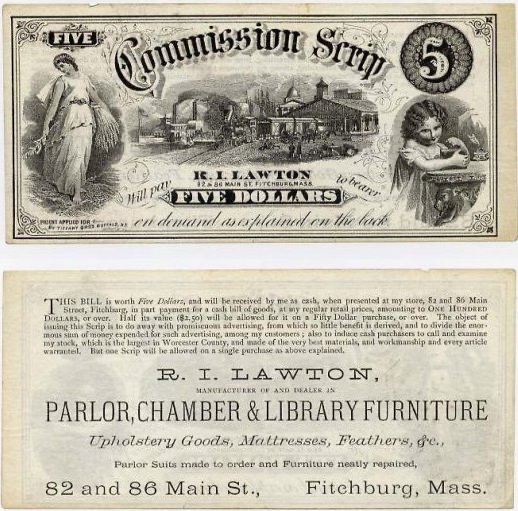
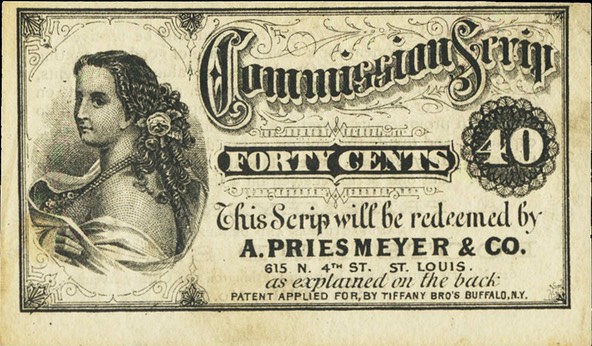
A.Tiffany Brothers Commission Scrip was a patented product directly related to a short lived but severe economic depression during the years 1873-74. In response to the business panic of 1873 Nelson Otis Tiffany and Oscar Fitzallen Tiffany, the Tiffany Brothers, devised a redeemable advertising card, similar to a discount coupon, called "Commission Scrip". Because of the severe economic downturn shop owners preferred receiving cash for purchases and those purchasers who did pay in cash expected to receive a discount. The Tiffany Brothers scrip was intended to encourage cash sales for the merchant. The scrip was very well done with detailed vignettes and printing on the face and the shop owners line of goods, store location, and redeeming offer printed on the back. The note depicted offers to redeem the note for $5 when used in conjunction with cash purchases of $100 or more. it also offers to redeem the note for $2.50 for cash purchases over $50, effectively offering a 5% discount for cash purchases.
Q. One question that I always see asked of dealers and experts is “I have a 2-headed coin. It’s obviously a Mint error, so what is it worth?”
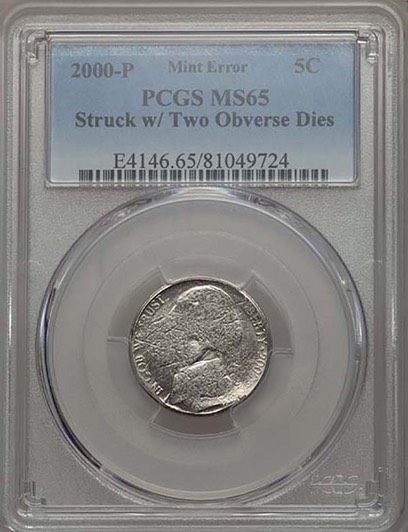
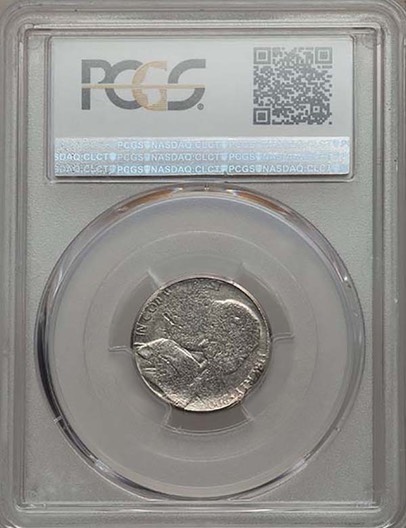
A. Until a few years ago, I would have agreed with all the experts that 2 Headed coins are creations made by either slicing 2 coins in half and gluing or soldering them together. Or, hollowing one coin out so the other coin rests flush when placed in the hollow. In both cases, the alteration is usually easily detectible with a close inspection.
The reason 2 headed coins can’t be accidentally creat- ed, is that the striking dies for the obverse (heads) and the reverse (tails) are deliberately made of different sizes and will not fit into the coin press to create a 2 Headed coin.
BUT! While 3 specimens of 2 Tailed coins exist, (2 Washington Quarters and one Roosevelt Dime), until 2016, a 2 Headed coin Twas believed to not exist nor possible to create.
Then in 2016, a 2 Headed Jefferson nickel was discovered by an anonymous collector and, after being subjected to authentication was certified and holdered. Although slightly weakly struck, it is in gem condition and was certified and authenticated by Professional Coin Grading Service (PCGS) as MS 65. It is exciting that this unique and spectacular major mint error survived the minting process and was discovered in 2016 and certified by PCGS. How PCGS was able to identify that it, is indeed, a true 2 Headed coin is unknown.
This makes it the only known U.S. regular-issue coin of ANY denomination that was struck with two obverse dies (two-headed). It stands alone as a major U.S. numismatic rarity and proves that a United States two- headed coin exists!

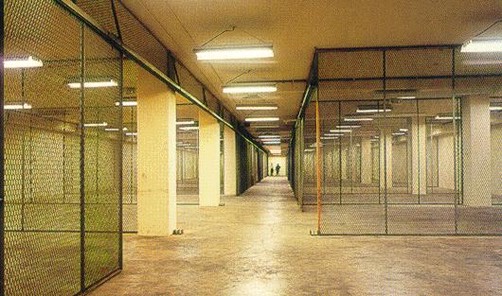

EDUCATIONAL FACT: An interesting and historical place that is rarely men- tioned is the Federal underground facility at Mount Pony, in Culpeper, Virginia. The space was built in 1969 at the height of the Cold War for a very specific purpose: this is where the Federal Reserve stockpiled billions of dollars in cash for emergency use after a war with the Soviet Union.
According to the Brookings Institute, this included a "large number of $2 bills shrink-wrapped and stacked on pallets 9 feet (2.7 meters) high. Following a nuclear attack, this money was to be used to replenish currency supplies east of the Mississippi.” It is estimated that between $2 and $4 Billion dollars in cash was held there.
A stored 30 day supply of food and water could be used sustain 500 Fed employees. The three story structure also used to boast an incinerator, indoor shooting range, and a helipad. It was "radiation hardened" with a two to four foot earth roof and lead lined window shutters.
In addition, the bunker wasn't just a storage place for doomsday economists, it also housed the Culpeper Switch, the central node in the Fedwire system that enables electronic bank transfers.

An old Federal pamphlet notes that Mount Pony was a fitting location for the communications switch, "for its history included such use. The top of the moun- tain was used by the Confederate Army as a signal station and, during World War II, it served as an observation post for spotting aircraft."
After the Cold War ended the Fed transferred the facility to the control of the Library of Congress. The LoC remodeling opened up the side of the structure and created a terraced arcade. Inside, they installed 90 miles of shelving into the climate controlled underground vaults.

The ivy and water features in front of the bunker speak to thenew space's friend-lier purpose. Today it is a mecca for film preservation, where experts archive mul-tiple petabytes (a petabyte is the equivalent of 1.5 million cd-roms) of A/V material each year. According to the Library website, the end goal is that "the entirety of the Library's recorded sound and videotape holdings will be digitized, some using a hands-on, one-at-a-time approach, others—3/4" videotape, initially—as part of a high throughput, robotic operation."
A few of these videos are streamable on their website (www.loc.gov/collections/). The American Memory Collection has turn of the century scenes of New York City, Theodore Roosevelt, A Westinghouse factory and the Spanish American War.
BOOK OF THE MONTH
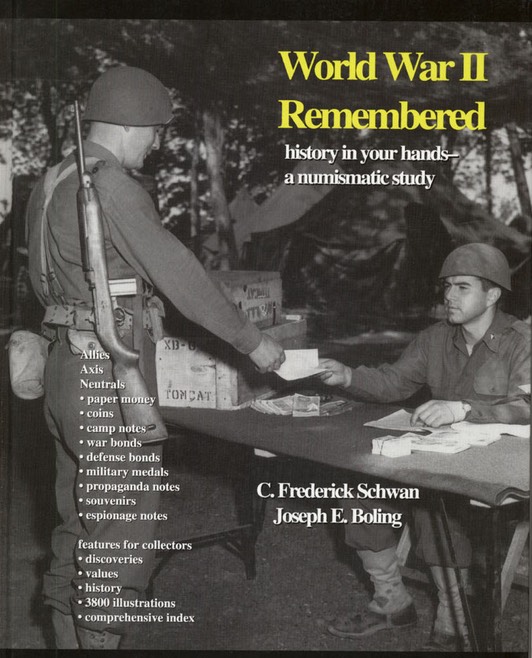
World War II Remembered: History in Your Hands, a Numismatic Study by Fred Schwann
I am surprised that I haven’t previously used this as Book of the Month. It must have been oversight on my part!
This is The most extensive book available on World War II numismatics. While it is out of print, new and used copies are available for $125-$225. It is the reference that most serious collectors use, and while some information has become dated since its 1995 release, it is still the most expansive reference on WWII numismatics written. It is a history book, not just a numismatic listing and for each country listed tells the story of the numismatic items. It allows you to be immersed into the numismatic events of the World War II era. If you have an interest in the story behind World War II numismatic items, then this reference is a must.
Coin of the Month
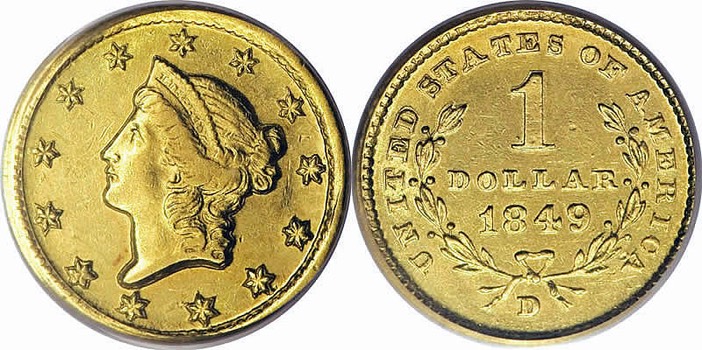
The Liberty Head or “Type 1” Gold Dollar was struck from 1849 to 1854 and represented the first series for the smallest gold denomination ever produced by the United States Mint.
While the gold dollar was not introduced until 1849, its roots can be traced back to 1836, when the denomination was first proposed. Gold dollars had been struck private- ly by the Bechtler family in Georgia and proved to be hugely popular in that area of the country. It was the discovery of gold in California and new gold interests that would eventually lead to the authorization of the denomination.
The chief engraver of the Mint James Barton Longacre was the designer of the new gold dollar and featured the head of Liberty on the obverse. She is facing left and wearing a headband inscribed “LIBERTY” with thirteen stars surrounding. The reverse of the coin contains a wreath encircling the denomination of “1 DOLLAR” and the date. The words “UNITED STATES OF AMERICA” appear around the wreath. The first year of the series saw two distinct varieties, identified by differences in the reverse design. On the earliest coins, and all of those struck at the Dahlonega and New Orleans Mint the wreath is open, while later Philadelphia and Charlotte coins have the wreath closed. The closed wreath design would be used until the end of the type in 1854. Following their introduction, the new gold dollars became a source of much criticism from the public. Their small size made them easy to lose and somewhat difficult to handle. Ultimately it was decided to make the coins wider but thinner. The change in specifications was introduced in 1854 along with a new design which would continue to be struck in two different types until 1889. The short-lived Liberty Head Gold Dollars now stand as the smallest coins produced by the United States Mint.
Minted from 1849 to 1854 at the Philadelphia, Charlotte, Dahlonega, San Francisco, and New Orleans mints. Specs: Weight- .04837 oz. Composition: .900 Gold and .100 Copper. Diameter: 13mm. Reeded Edge.
Currency Note of the Month
ELVIS OBSOLETE NOTE While there is still a law on the books that bars the depiction of a living person on currency, in this case, the person hadn’t even been born yet! This obsolete note is from the Manual Labor Bank of Philadelphia, Pennsylvania dated 1836. The main feature of this $10 note is a vignette of workers in a glass factory. The same vignette is also found on the $20 note issued by the same bank. The central figure in the vignette is dressed like, and even looks like Elvis Presley, making this a popular bank for both collectors and Elvis fans. Of interest is that the bank failed in 1839 since Dr. Thomas W. Dyott, who ran the bank, wouldn't redeem the notes. He was imprisoned but then pardoned. His portrait is on the right along with his signature in the lower right.
These notes are not particularly rare and nice examples can be obtained for under $100.
NUMISMATIC AND HISTORICAL QUESTIONS AND FACT (FEBRUARY)
Q. I collect POW currency and recently heard of some rare Australian notes. What is Camp Seven currency?
A. In 1941, over 2,000 German and Austrian refugees, fleeing Nazi control, were placed aboard the HMT Dunera and transported to Sydney Australia. The conditions before and during the transport were horrific but the refugees were believed to be a German spy threat despite most of the refugees being Jewish. From Sydney, the Dunera Boys, as they were later called, were taken by train to Camp Seven, near Hay. Their money was confiscated and while interned, the only available currency was a series of banknotes and some generic tokens.
The Hay banknotes were special. They were designed by the internees and then printed by a local newspaper. They were so sophisticated that the Australian Treasury feared that they would be traded outside the camp. After three months of circulation in 1941, the notes were confiscated and destroyed, although some examples were kept as souvenirs by internees and Camp guards.
There were five denominations of notes, 1 and 2 Shillings, and 1, 3, and 6 Pence. There was also 5 denominations of tokens that were used at all the Intern camps. Approx. 5,000 notes total were printed with 2000 of those being the 2 Shilling. A survey published in 1994 recorded only 174 surviving notes of all types.
While collectible as historical pieces in their own right, these notes gained some notoriety when it was discovered that they contained messages and names hidden in the designs and possible spying information. However, since these notes were only intended to circulate locally, research indicates that the 4 known messages were more indicative of a protest of the injustice to the Internees. The names are mostly the names of prominent Camp Internees and friends hidden there by the camps note designer George Telscher. Today these notes are rare and valuable, (a 6 Pence note sold for $9,600.00 in 2018), and rarely come up for sale.
Q. What is a “Jeton”?
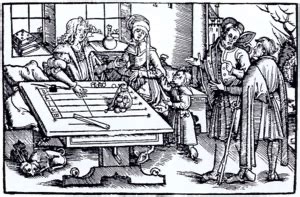

A. Jetons or jettons are tokens or coin-like medals produced across Europe from the 13th through the 18th centuries. They were produced as counters for use in calculation on a counting board, a lined board similar to an abacus. They also found use as a money substitute in games, similar to modern casino chips or poker chips.
Thousands of different jetons exist, mostly of religious and educational designs, as well as portraits, the last of which most resemble coinage, somewhat similar to modern, non-circulation commemorative coins. The spelling "jeton" is from the French; the English spell it "jetton".
From the late 13th century to the end of the 14th century, purpose-made jetons were produced in England, similar in design to contemporary Edwardian pennies. Although they were made of brass they were often pierced or indented at the centre to avoid them being plated with silver and passed off as real silver coins. By the middle of the 14th century, English jetons were being produced at a larger size, similar to the groat.
The mints and treasuries of the big estates in Central Europe used their own jetons and then had a number of them struck in gold and silver as New Year gifts for their employees who in turn commis- sioned jetons with their own mottoes and coats-of-arms. In the sixteenth century, the Czech Royal Treasury bought between two and three thousand pieces at the beginning of each year.
In the 21st century, jetons continue to be used in some countries to denominate the substitutes for coins in coin-operated public telephones or vending machines. They are usually made of metal or hard plastic, and are generally called tokens in English-speaking countries. In German, the
word Jeton refers specifically to casino tokens. In Polish, the word żeton, pronounced similarly to French jeton, refers both to tokens used in the vending machines, phones etc., as well to those used in the casinos. The word жетон has the same use in Russian, as does the word jeton in Romanian and žetoon in Estonian. Plastic jetons were also used as a form of fare payment for using the Star Ferry in Hong Kong.

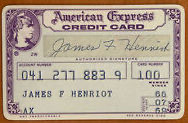
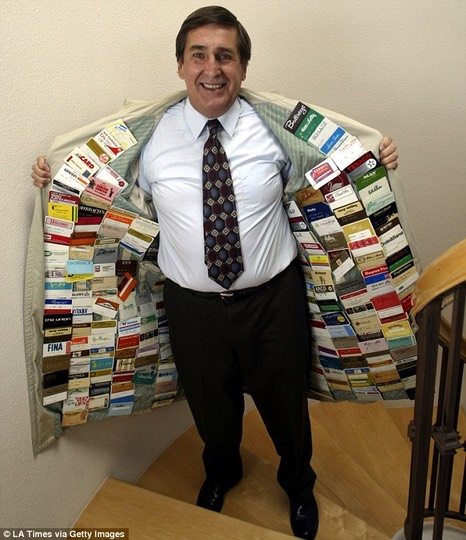
EDUCATIONAL FACT: With physical cash being overtaken by electronic forms of payment, collecting credit and debit cards is gradually becoming a new form of numismatic collecting. While still in its fledgling stages, Ebay currently has over 1700 listings for credit and debit cards, with over 500 of those listed with $25.00 or more opening bids. In particular, early American Express cards (expired) can bring upwards of $300!
Certainly collecting expired cards is an amusing off-shoot of numismatics, but there has also been a bit of competition in who holds the largest number of active cards...
In 2016, on a bet with a friend, Walter Cavanaugh was able to obtain 143 cards to his friends 138 and won a free dinner! But he decided to really go for the record and eventually amassed 1,497 active credit cards, earning him the name “Mr. Plastic Fantastic”! Despite having a credit line totaling over $1.7 million, he has managed to maintain a near perfect credit rating.
However, whenever there is a record there is competition to be on top!
In 2019 Mr. Cavanaughs record was overtaken by Zheng Xiangchen of Shenzhen, Guangdong, China. He had 1,562 active credit cards and was awarded a place in the Guinness Book of World Records on July 30, 2019.
Zheng Xiangchen was inspired to start and grow his collection of credit cards by the previous world record holder for many years, Walter Cavanagh, of the US.
Americans, on average, have four credit cards, and there are over 1.06 billion credit cards in use in the United States with an average balance of $6194 (2018). Worldwide, there are over 2.08 billion credit cards in use.
WEBSITE OF THE MONTH
www.americanhistory.si.edu
Our Mission
Empowering people to create a just and compassionate future by exploring, preserving, and sharing the complexity of our past.
The National Museum of American History is home to more than 1.8 million objects and more than three shelf-miles of archival collections. On behalf of the nation, we preserve and share this extraordinary national collection en- compassing everything from the original Star-Spangled Banner to Abraham Lincoln’s top hat; from the first computer bug to the first artificial heart; from Dizzy Gillespie’s angled trumpet to Dorothy’s ruby slippers from The Wizard of Oz. Our archival collections include a remarkable array of American history in documents, photographs, and other works, including major holdings on the histories of American business and music.
Editors note: The “Coins, Currency, and Medals” section comprises over 270,000 items available for viewing on-line!
Currency Note of the Month

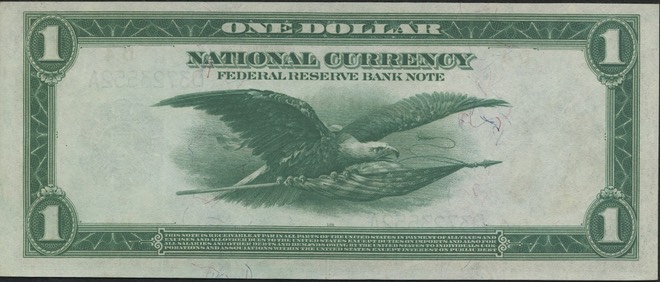
The $1 1918 Federal Reserve Bank Note (FRBN) is a large size note that is actually affordable! While FRBN notes were first authorized in 1913 and issued in 1915, the $1 denomination was not included until the second issue in 1918 when they were included as replacements for Silver certificates which were temporarily removed from circulation under the Pittman Act. These notes were issued by all 12 Federal Reserve Banks and the issuing bank is indicated on the face.
Additionally the face of the note carries Gilbert Stuarts’ portrait of Washington along with a large blue Treasury seal and serial numbers. The notes also carry the nickname “Flying Eagle” due to the reverse vignette of a large Bald Eagle in flight carrying an American Flag engraved by Lorenzo Hatch.
They were issued with only 2 printed government signatures but with a large variety of printed Bank Officer signatures. The $1 denomination notes are the least expensive of the FRBNs’ with notes in Fine and better readily available for under $150.
Coin of the Month
Collecting coins with transportation themes is very popular so I decided to feature this coin with a sailing ship design. This month’s coin was issued in 1993 by the Isle of Jersey, officially the Bailiwick of Jersey, an island and British Crown Dependency near the coast of Normandy, France. Officially, it was a circulating commemorative coin denominated as 1£ until it was demonetized in 2017. The obverse features the Second crowned portrait of HM Queen Elizabeth II facing right, wearing the “Girls of Great Britain” tiara engraved by A. Machin, and the reverse depicts the 1864 Barque Gemini engraved by R. Evans. The edge is also engraved with the Latin phrase “CAESARE INSULA” meaning Caesar Island. The coin is part of a seven coin ship set issued to commemorate Jerseys’ shipbuilding history. Issued in nickel-brass, it has the following specs: weight-9.5 g, diameter-22.5 mm, thickness-3.15 mm, and it has medal alignment vice coin alignment (As shown).
NUMISMATIC AND HISTORICAL QUESTIONS AND FACT (JANUARY)
Q. Where was U.S. gold stored prior to the opening of Ft. Knox?
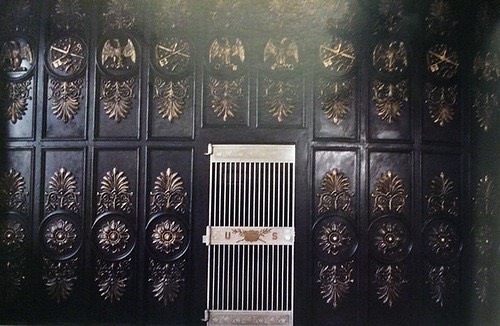
A. Prior to Ft. Knox opening, gold was generally held at one of the 7 US Assay Offices or one of the 3 US Minting facilities all run by the US Mint. They were usually located nearby where large gold or silver deposits had been discovered and then closed as the deposits played out. The New York Assay Office in Manhattan was the notable exception. Constructed in 1823 as the Branch Bank of the United States, by the Act of March 3, 1853, the United States Assay Office New York was formed and opened at No 30 Wall Street in 1854. It stayed in operation for almost 130 years, finally closing in 1982. However, with the open- ing of Ft. Knox in 1936, gold assets of 157 million oz. were transferred there in 1937 from the New York As- say Office. An additional 258 million oz. was trans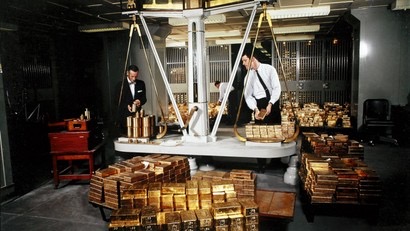 ferred from the New York Assay Office to Ft. Knox in 1941. The 2 shipments were carried out by the US Postal service and utilized 94 trains (with additional decoy trains) and the use of almost 550 railcars to complete. The Post Office Department then billed the Treasury Department for transporting the weight of the crates and gold using the fourth class postage rate with added insurance-fees!
ferred from the New York Assay Office to Ft. Knox in 1941. The 2 shipments were carried out by the US Postal service and utilized 94 trains (with additional decoy trains) and the use of almost 550 railcars to complete. The Post Office Department then billed the Treasury Department for transporting the weight of the crates and gold using the fourth class postage rate with added insurance-fees!
The New York Assay Office continued its operations as an Assay Office but was finally closed in 1982 and the building was sold to a private banking concern in 1983 for $27M.
Q. Who is Archibald Binny and what does he have to do with money?
A. Archibald Binny, of Scotland, emigrated to Philadelphia in 1795. Binny had been a printer and had some experience in type-founding in Edinburgh. Type founding is the creation of the movable type used in book and paper printing. Binny, in partnership with James Ronaldson, a baker who had lost his business in a fire, established a foundry in 1796 known as The Philadelphia Type Foundry. The foundry was quite successful and for a time the only typeface foundry in the United States.

Binny was the designer of the “Monticello” typeface still in use today and in 1812 the foundry issued the first typeface specimen book ever produced in the US.
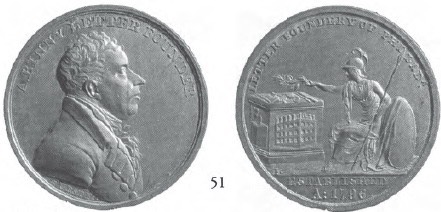
His link to money is that sometime in the late 1790’s, Binny was credited with creating the first printable type-set dollar ($) symbol. While the dollar symbol is seen with both single and double lines superimposed over the “S”, the specimen book shows a single line, as does a hand annotated 1792 Bond signed by George Washington predating the specimen book.
In 1816, he was recognized for his work with a medal by early American engraver, Moritz Furst. Only 3 examples of the medal are known, with one being sold by Stacks/Bowers in 2018 for $1320.
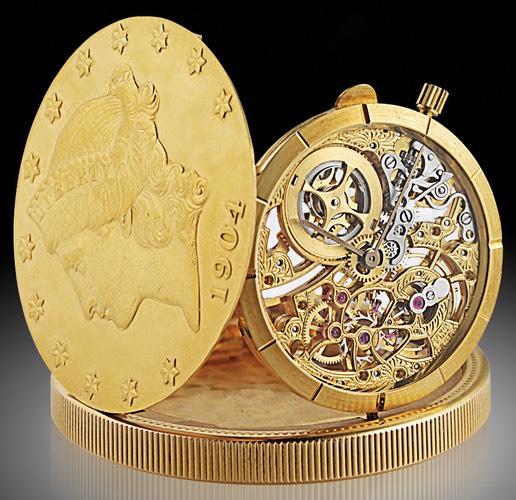
EDUCATIONAL FACT: While I know a number of you will be dismayed at the destruction of a desirable collectible coin, I thought I would make an exception and display a spectacular pocket watch created from a 1904 $20 Gold Eagle. The coin has been hollowed out to contain a skeletonized watch with a 14K gold mechanical movement, 17 jewels, skeletonized dial, engraved baton numerals on a bezel hinged and set within a 1904 US $20 gold coin. The front is opened by pressing a concealed catch in the edge reeding, revealing the recessed watch that also hinges out to allow the watch to be wound once the face is opened. The back and the edge are from the original coin and the face closes almost seamlessly.


A number of these rare coin watches were created by Audemars Piguet between 1915 and the late 1980s. They were produced in very limited quantities and in a number of different coins including U.S. dollars, Swiss Francs, French Francs, Mexican Pesos, and Japanese Yen.
This particular watch was sold by Christies Auction House in 2010 for almost $15,000 after auction commissions.
Currency Note of the Month

Compound Interest Treasury notes are an interesting type of circulating legal tender note. These notes bore interest at a rate of 6 percent over three years, compounded twice a year. These notes were authorized by Acts of Congress of March 3, 1863 and June 30, 1864 and were issued during the Civil War to help finance the Treasury and military operations at a time when the nation was on the verge of bankruptcy. These Compound Interest Treasury notes were issued to help the nation at a time when money was scarce.
Compound Interest Treasury notes were issued in denominations of $10, $20, $50, $100, $500, and $1,000 (the $10 note is shown) and were legal tender at their face value. The interest was payable in full three years after the date of issue printed on the obverse.
The face of the $10 note shown has a portrait of Salmon P. Chase, Secretary of the Treasury and a gold overprint reading “Compound Interest Treasury Note”. The reverse has a tabulation table showing interest amounts and redemption values. These notes not only are extremely rare across all denominations and issues, but they are also historic from the standpoint that they help illustrate the socioeconomic picture of the United States during one of its most difficult chapters.
Coin of the Month
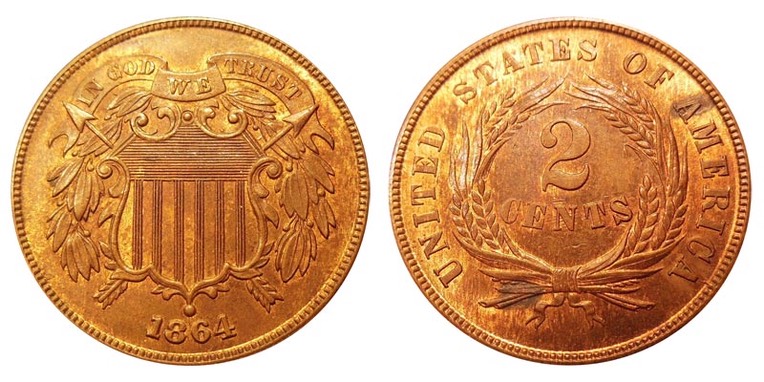
This month’s coin is the “Two Cent Piece”. I have featured this coin before but its been 8 years, and I wanted to feature a coin that would have been in circulation at the same time as the note above.
This is the first U.S. coin to have the motto “In God We Trust”. The obverse features a Shield, the motto on a banner, and the date below. The reverse features a wheat wreath, the legend “United States of America”, and the denomination “2 Cents” in the center.
Minted from 1864 to 1873 (1873 in Proof only) at the Philadelphia Mint with the follow- ing specs: Weight- 6.22 Grams, Composition: .950 Copper and .050 tin and zinc. Diameter 23mm. Plain Edge. Designer-James B. Longacre. There are 2 varieties of the 1864 issue and 2 varieties of 1873 proofs.
BOOK OF THE MONTH
Bank Notes and Shinplasters: The Rage for Paper Money in the Early Republic (American Business, Politics, and Society) by Joshua R. Greenberg

In Bank Notes and Shinplasters, Joshua R. Greenberg shows how ordinary Americans accumulated and wielded the financial knowledge required to navigate interpersonal bank note transactions. Locating evidence of Americans grappling with their money in fiction, correspondence, newspapers, printed ephemera, government documents, legal cases, and even on the money itself, Greenberg argues Americans, by necessity, developed the ability to analyze the value of paper financial instruments, assess the strength of banking institutions, and even track legislative changes that might alter the rules of currency circulation. In his examination of the doodles, calculations, political screeds, and commercial stamps that ended up on bank bills, he connects the material culture of cash to financial, political, and intellectual history.
The book demonstrates that the shift to federally authorized paper money in the Civil War era led to the erasure of the skill, knowledge, and lived experience with banking that informed debates over economic policy. The end result, Greenberg writes, has been a diminished public understanding of how currency and the financial sector operate in our contemporary era, from the 2008 recession to the rise of Bitcoin.
NUMISMATIC AND HISTORICAL QUESTIONS AND FACT (DECEMBER)
Q. Are there any U.S. Mint regular or commemorative issued coins with a Christmas theme?
A. Not on U.S. coins but from 1996 to 2001, the U.S. Mint issued an annual Christmas ornament (2 In 2000). Those issues each incorporated a different US coin.
For 2019 and 2020, the U.S. Mint issued 2 Christmas ornaments per year, one for adults and one for children. Both 2019 ornaments feature the reverse of the Kennedy half dollar, a modification of the Presidential Seal. The adult ornament has a colorful wreath, while the children’s version has Mighty Minters characters named Eli, Layla, Timothy, and Kendra. The 2020 ornaments have the reverse of the Jefferson 5 cent. The adult version is a rhodium finish snowflake design, while the children’s version has Mighty Minters Alex, Sophie, and Eli making a snowman. The back of all four have the U.S. Treasury Seal (the 2020 is in color) as shown in the first ornament. The ornaments cost between $25 and $28 each depending on the year. It is unknown whether the Mint will continue this as a tradition or not.
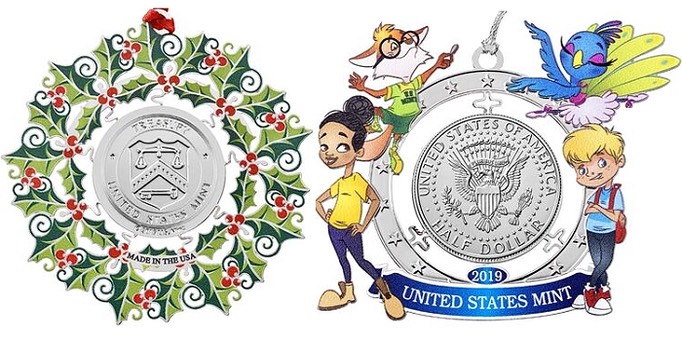

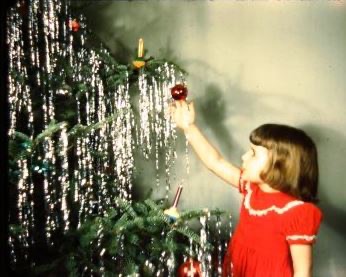
Q. I read once that tinsel was made from actual silver long ago. How true is that story?
A. Tinsel has an interesting history. There is a legendary story of a poor family with nothing to decorate their tree that awoke Christmas morning to find that the cobwebs in the tree they had put up had been magically transformed into gold and silver threads by God, leaving them well taken care of.

Modern tinsel was invented in Nuremberg around 1610. Tinsel was originally made from extruded strands of real silver!. Before the 19th century, tinsel was used mostly for adorning sculptures rather than Christmas trees and also to represent the starry sky over Nativity scenes. It was later used on Christmas trees to enhance the flickering of the candles on the tree. However, because of the candles, the silver tarnished quickly and other shiny metals were soon substituted, including tin, aluminum, and lead.
By the early 20th century, manufacturing advances allowed cheap aluminum-based tinsel, and until World War I, France was the world leader in its manufacture. During the 1950s, tinsel and tinsel garlands were so popular that they frequently were used more than Christmas lights, as tinsel was much less of a fire hazard than lights were for flammable real trees.
Lead foil was a popular material for tinsel
manufacture for several decades of the 20th century. Unlike silver, lead tinsel did not tarnish, so it retained its shine. However, use of lead tinsel was phased out after the 1960s due to concern that it exposed children to a risk of lead poisoning. Modern tinsel is typically made from polyvinyl chloride (PVC) film coated with a metallic finish. Coated mylar film also has been used.
EDUCATIONAL FACT: Since it’s Christmastime, rather than do a factoid this month, I have decided to promote a program that the ANA is offering to encourage youth interest in numismatics and membership in the ANA. All of the information that follows below is also presented on the ANA website at www.money.org along with the ANA youth specific section, www.money.org/young-numismatists. The ANA is currently offering a gift youth membership package that includes a Youth Numismatist, ages 5-17, a Gold membership ($16 per year) with a digital version of The Numismatist, or a Platinum membership ($26 per year) that includes print & digital versions of The Numismatist.
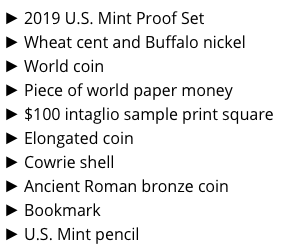
Also, if you use the special offer code YNM20
when purchasing, the ANA will include the be-
ginners collecting package shown at right, while supplies last, with their membership. For those of you that have lamented about how to interest youth in numismatics or have wanted to introduce relatives to the hobby, this is a good start!
For the details and to give the gift of member-
ship to a Youth member, Call 1-800-514-COIN
(2646) and mention the offer code YNM20 to include the collectibles listed above. *Gift recipients must be 5-17 years of age; birth date of young gift recipient required to receive this offer. Gift package will arrive in 2-4 weeks.
Currency Note of the Month
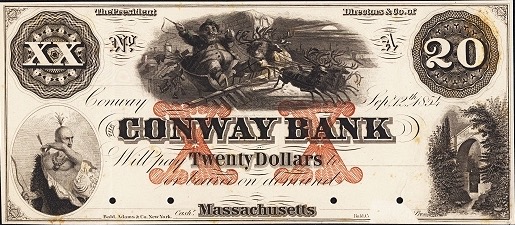
Last year for the Christmas edition, I wrote that I had discovered 4 banknotes with Christmas themes and that I had already used 3 of them for this section with the fourth one to be featured this year. I have since discovered a 5th note with a Christmas vignette so I now have next years note covered as well!
This years note is a Conway, MA Bank $20 Proof dated Sep. 12, 1854. This rare example features on the face, a Santa vignette, complete with sleigh and reindeer, and a Native American warrior imprint. Examples from this bank have only been reported in Proof form, with nine notes known. Printed by the American Banknote Co. this example is mounted on cardstock . This bank was in business from 1854 to 1864 and then became the Conway National Bank, National charter number 895. The note is from The Roger H. Durand Santa Claus Collection and was originally purchased for $17 in 1960 and sold for $6325 by Heritage Auctions in 2011.
Coin of the Month
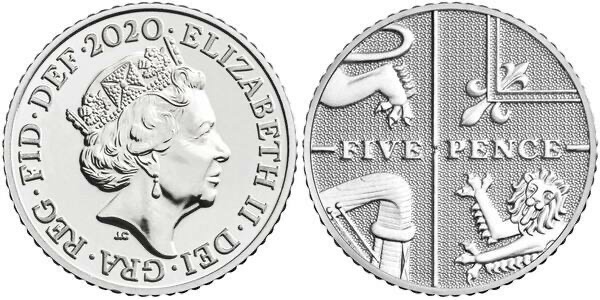
British 5 Pence The British decimal five pence (5p) coin, often pronounced five pee, is a unit of currency equalling five one-hundredths of a pound sterling. Its obverse has featured the profile of Queen Elizabeth II since the coin’s introduction on 23 April 1968, replacing the shilling in preparation for decimalisation in 1971. It remained the same size as the one shilling coin, which also remained legal tender, until a smaller version was introduced in June 1990 with the older coins being withdrawn on 31 December 1990. Four different portraits of the Queen have been used, with the latest design by Jody Clark being introduced in 2015. The second and current reverse, featuring a segment of the Royal Shield, was introduced in 2008.
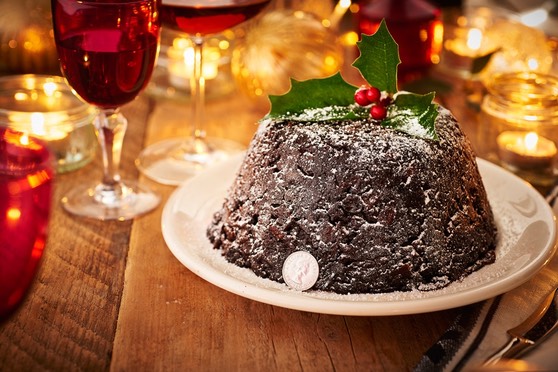
The five pence coin was originally minted from cupro-nickel (75% Cu, 25% Ni), but since 2011 it has been minted in nickel-plated steel due to the increasing price of metal. It is also the favorite coin currently used for the traditional Christmas pudding served at Christmas dinner in the UK, Ireland and many other countries influenced by British immigrants.
BOOK OF THE MONTH
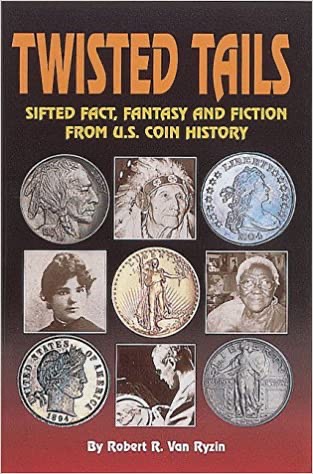
Twisted Tails: Sifted Fact Fantasy and Fiction from Us Coin History by Robert R. Van Ryzin
This months selection is on a less serious note and a little more on the entertaining side! Twisted Tails is a compilation of the more famous stories related to coins and coin collecting. It dispels some of the myths behind coin designs and their creators and provides some clarity to the mysteries and human differences of opinion and subterfuge that resulted in the creation of some of our most iconic coin images. It also sheds light on whether some of the rumors that persist even to this day, have any truth to them. An easy read and quite entertaining
NUMISMATIC AND HISTORICAL QUESTIONS AND FACT (NOVEMBER)
Q. Has the U.S. Mint or the Bureau of Engraving and Printing ever done a coin or currency note featuring Thanksgiving?
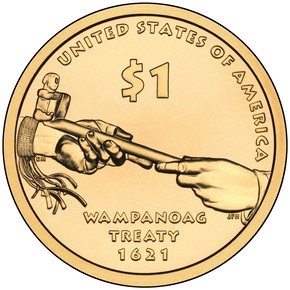
A. Not specifically, however, in 2011 it did release a Native American $1 featuring the Wampanoag Treaty of 1621. The obverse has an image of Sacagawea, the Shoshone who helped Lewis and Clark on their historic voyage of exploration. The reverse has two hands exchanging a peace pipe, a symbol of the 1621 peace agreement between the Wampanoag Indians and the settlers of Plymouth Colony.
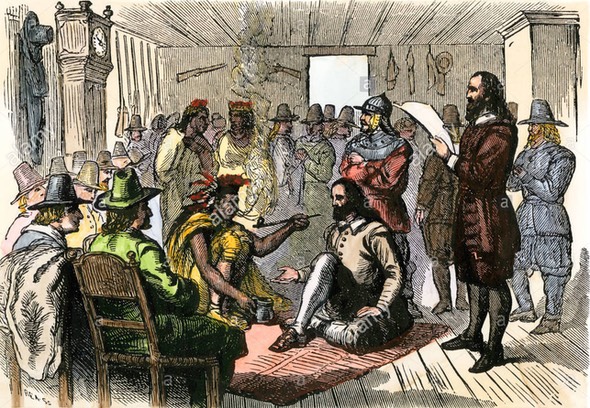
In the spring of 1621, Ousamequin, the Massasoit (a title meaning head chief) of the Wampanoag Indians, made a treaty with the English who settled at Patuxet (in what is now Plymouth, Massachusetts).
The main terms of the treaty: the Wampanoag promised to defend the Plymouth settlers against hostile tribes. The settlers promised to step in if the Wampanoag were attacked. The full terms are recorded in William Bradford’s “History of Plimoth Plantation”. Historians doubt that the settlers could have survived without the Plymouth/ Wampanoag alliance.
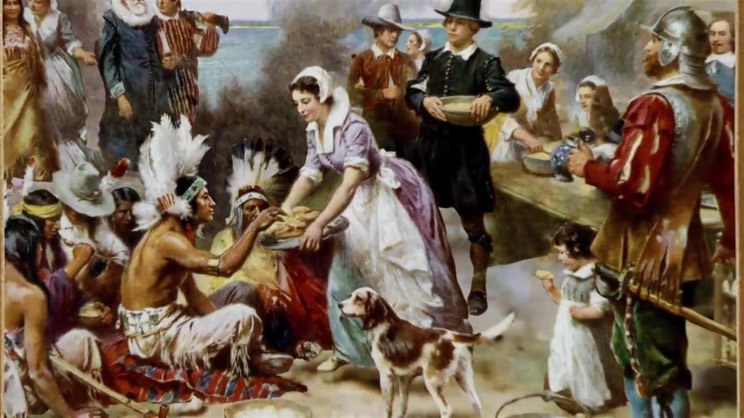
Three Wampanoag men, who represented Ousamequin, spent much time with the settlers. Tisquantum (also known as Squanto), Samoset, and Hobbamack gave the settlers invaluable tips on survival. The Plymouth settlers honored the treaty later that summer by coming to Ousamequin’s rescue when they thought he had been captured by enemies. The Wampanoag treaty lasted more than 50 years. In mid-October 1621, 90 of the Wampanoag took part in a harvest feast. The feast at Plymouth lasted for three days and, 220 years later, inspired the legend of the first Thanksgiving.
Q. I just discovered some of my fathers Military Payment Certificates that he saved from his time in the service. It has a $10 denomination and depicts an Army Sergeant with a rifle among other things. I was wondering about collecting a few representing each service branch bu are there any that could possibly relate to the new Space Force?
A. Not surprisingly the 681 Series of MPC notes issued August 11th 1969, was devoted primarily to military themes. There were 10 vignettes used for the series and, allowing for the vignette of Maj. Ed White making a space walk on Gemini 4 to represent the newly created Space Force, 9 of them would be military in nature. However, there no MPC issues that depict either the Coast Guard or, surprisingly, the Marines! This, despite the fact that the series was primarily issued for use in Vietnam which saw heavy Marine combat. The notes shown depict individual members of the 4 branches that are represented.
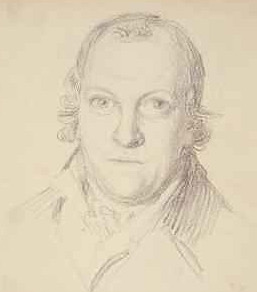
EDUCATIONAL FACT: John Bake White was born on September 2, 1781, near Eutaw Springs, SC. After studying painting in England for some years he returned to SC, applied to the bar, and was eventually admitted. This lead to a position with the U.S. Customs House in Charleston where he worked for 25 years doing portraits and historical paintings.
Since both of White’s parents served in the Revolutionary War, his father at Fort Moultrie, and his mother as a spy for Francis Marion, some of his paintings depict dramatic scenes from the conflict. Four of these, “General Marion Inviting a British Officer to Share His Meal”, “Sergeants Jasper and Newton Rescuing American Prisoners from the British”, “Mrs. Motte Directing Generals Marion and Lee to Burn Her Mansion to Dislodge the British”, and “The Defense of Fort Moultrie”, all painted between 1810 and 1815, hang in the U.S. Capitol. Among his portraits are those of South Carolina luminaries John C. Calhoun, Charles Cotesworth Pinckney, and Henry Middleton. White died on August 24, 1859, in Charleston and was buried in the family plot at St. Philip’s Church.
While his paintings and portraits all pre-date the Civil War, at least 3 pieces of his work were used on both Confederate and South Carolina banknotes. His portrait of John C. C. Calhoun (on left of the note), graces the large $1,000 CSA note. His paintings “General Marion Inviting a British Officer to Share His Meal” and “Sergeants Jasper and Newton Rescuing American Prisoners from the British” are the featured vignettes on the Bank of South Carolina notes $5 and $10 respectively. John Blake White works can be viewed on-line at www.senate.gov.
BOOK OF THE MONTH
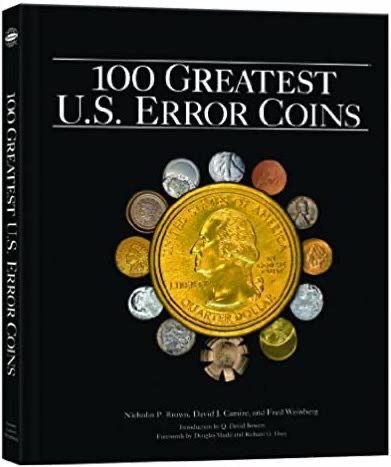
100 Greatest Error Coins by Nicholas Brown The latest entry in Whitmans 100 Greatest collection, 100 Greatest U.S. Error Coins is a beautifully illustrated coffee-table book that explores one of the hobbys hottest collectible fields. Ex- pert dealers, collectors, researchers, and historians have all weighed in on their opinions of the 100 all-time greatest examples of American coinage errors. The rarities, the classics, and the intriguing how d that happen? specimens are here---and some interesting surprises, too. Authors Nicholas Brown, David Camire, and Fred Weinberg are three of the nation’s most famous error-coin specialists, and they open the doors to the U.S. Mint to show you how and why error coins occur.
Coin of the Month
This months coin is the 2010 American Veterans Disabled for Life Silver Dollar.
Meant to honor those who were permanently disabled while serving in the United States Military, the coins have a face value of $1 and contain 90% silver.
The obverse bears an image of the legs and boots of three disabled veterans. A pair of crutches is visible along with the inscriptions ‘THEY STOOD UP FOR US,’ ‘IN GOD WE TRUST,’ ‘2010’ and ‘LIBERTY.’
On the reverse is a ribbon-wrapped wreath of oak branches with a forget-me-not flower at the base of it. The oak branches are a symbol of strength while the forget-me-not flower is there to remind all of the sacrifices many veteran’s have made while serving the country.
Inside the wreath is the inscription ‘TAKE THIS MOMENT TO HONOR OUR DIS- ABLED DEFENDERS OF FREEDOM.’ Around the outside of the wreath are the words ‘UNITED STATES OF AMERICA,’ E PLURIBUS UNUM’ and ‘ONE DOLLAR.’
A $10 surcharge was added to the price of each coin and was a given to the Disabled Veterans’ LIFE Memorial Foundation, which in turn used the money towards construction of the American Veterans Disabled for Life Memorial in Washington, D.C. The memorial opened on October 5th 2014.
Produced in both Proof and uncirculated versions at the US Mint facility in West Point the coins carry the ‘W’ mint mark. With a maximum mintage of 350,000 total authorized for both types, 78,301 Unc. and 202,770 Proofs were produced.
They have the following specs: Weight-26.73gr, Dia. 38.1mm, comp. 90% sil. and 10% copper, and have a reeded edge.
Currency Note of the Month
I tried my best but was unable to find a banknote with a depiction of Thanksgiving on it. So, I hope you’ll be satisfied with a “Turkey” note! 😂
This hyper-inflation note is a 20 Million! Lira issued in November 2001. After a long period of inflation, culminating in these large denomination notes, in 2005 the Turkish government replaced these notes with “new “ Turkish Lira notes essentially cutting 6 zero’s from all the nations currency.
The notes face features Kemal Atatürk who was a Turkish field marshal, revolutionary statesman, author, and the founding father of the Republic of Turkey, serving as its first president from 1923 until his death in 1938.
The back features the ruins of the ancient city of Ephesus on the coast of Ionia, three kilometres southwest of present-day Selçuk in İzmir Province, Turkey. It was built in the 10th century BC on the site of the former Arzawan capital by Attic and Ionian Greek colonists. During the Classical Greek era it was one of the twelve cities of the Ionian League. The city flourished after it came under the control of the Roman Republic in 129 BC. The city was famed for the nearby Temple of Artemis (completed around 550 BC), one of the Seven Wonders of the Ancient World. Among many other monumental buildings are the Library of Celsus, and a theatre capable of holding 25,000 spectators. Ephesus was also one of the seven churches of Asia that are cited in the Book of Revelation and the Gospel of John may have been written there.
Examples are very affordable, ranging from approx. $7-8 in VF condition to $75 in Uncirculated.
NUMISMATIC AND HISTORICAL QUESTIONS AND FACT (OCTOBER)
Q. I was recently shown a Canadian Halloween coin where the picture changes as it is tilted. I was told it was part of a series of issues?
A. The Royal Canadian Mint created 3 coins for its “Haunted” series starting in 2014. The 3 coins use a lenticular technology so that as the coin is tilted side to side the portrait changes in an eerie fashion.
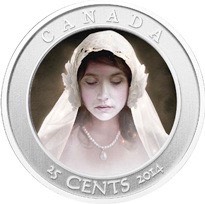
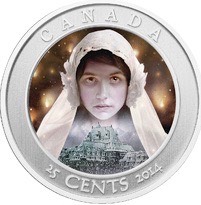
The first coin (2104) was the “Ghost Bride”. The coin is a tribute to the haunting story of a young woman from a wealthy family, whose wedding day was marked by tragedy. In 1926, in the Banff Springs Hotel which sits nestled in the Rocky Mountains of Alberta, it is said that a bride was descending a curving stone staircase when her dress caught fire from an open torch on the side of the stairs. In her panic, she tripped headfirst down the stairs and broke her neck. Since then, guests at the Fairmont Banff Hotel have reported seeing the ghost of this doomed bride waltzing in the ballroom of the hotel, or moving slowly down the staircase. Employees at the hotel have often felt a cold breeze on this staircase, or heard strange noises coming from the unoccupied bridal suite.
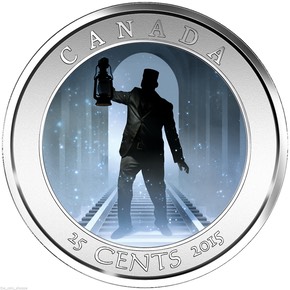

The second coin (2015) in the series is the “Headless Brakeman”. Outside the Waterfront Station, situated at the western end of Gastown, Vancouver, the ghost of a rail worker is sometimes seen on rainy nights. In 1928, the unfortunate brakeman, Hub Clark, was killed while he was making repairs in the rail yard. He slipped on the wet tracks and was knocked unconscious. Horrifically, a passenger train came along and ran him over, decapitating him. Since then, some have reported seeing the head-less brakeman roaming the tracks, his lantern glowing in his hand. Others say they’ve seen him in different parts of Gastown. Does he think he’s still on the job or, even worse, is the poor man looking for his lost head?
The third, and last, coin in the series (2016) is the Bell Island Hag. Dobbin’s Garden on Bell Island is home, supposedly, to the “Bell Island hag.” This legend dates back to the Second World War, when German U-boats attacked the island. The story goes that a group of German sailors had secretly landed on the island to resupply their U-boat with the help of local sympathizers.
An unfortunate woman came upon the scene and was dragged into the marsh and killed. Locals, fearing a fairy trick, ignored her cries for help, and her restless spirit is said to still plague the site. Witnesses have described what initially looks like a woman in white walking up from the marsh after sunset. Then, as the thing gets closer, the colour starts to go gray, and then the thing falls to its knees and starts to crawl on all fours like a dog, The creature’s “wormed-out face” and foul, sulfuric smell then knock out the unfortunate spectator.
Certainly an interesting and creepy set of coins!
Q. Any info about a Notgeld piece that depicts a pandemic impact on a small German town?
A. During the 1920's the German economy was in crisis and inflation was sky high. Many cities and towns started issuing their own local 'emergency money’, called ‘Not- geld' in German. These banknotes, were not backed by gold or deposits and they often lost their value shortly after they were issued. The sometimes cartoonish or simplistic design of these emergency banknotes often gives away that they were issued during times of economic and political crisis. However, they are interesting pieces of history, and combined with beautiful artwork portray a window into the stories of the time.
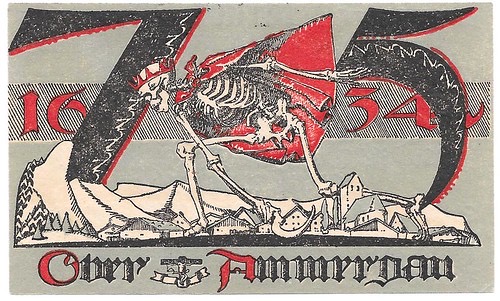
The particular note you are describing is a 75 pfennig (3/4 mark) banknote that was re- cently listed as the number two scariest banknote of all time. This note was issued by the town of Oberammergau in the Bavarian Alps and features the Bubonic Plague. A giant Grim Reaper is depicted mowing the town with a scythe. The year printed on the banknote, 1634, is when the bubonic plague death rate finally went down. The villagers vowed that if God spared them from the plague, they would produce a Passion Play every 10 years depicting the life and death of Jesus. Jesus on the cross is depicted on the note as well, below the Grim Reaper, referring to the Passion Play performed in the town since it was saved from the Bubonic Plague. The first Oberammergau Passion Play was performed in 1634 and it is still being per- formed in the present day, every 10 years, most recently in 2010. The 2020 perfor- mance of the Passion Play has been postponed until 2022 due to the corona pandem- ic.
EDUCATIONAL FACT: In years past it was common that the bodies of the executed would be used for medical experiments, most notably medical dissection. This was due to the fact that cemeteries were considered “hallowed” ground and the executed were considered “evil” and unfit for normal burial.

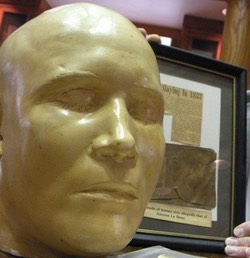
However, in 1833, after Antoine LeBlanc was convicted and hung for bludgeoning to death his employers and their daughter, electrical current was used in experiments at reviving the body. This was followed by having his skin removed and tanned! While at present only a wallet made from his skin is still known to exist, the papers reported that his skin was used for wallet(s), coin change purses, and individual strips that were sold, signed by the Sheriff who had arrested and executed him! The wallet, along with a plaster “death mask” of LeBlanc, is held at the North Jersey History and Genealogy Center in Morristown NJ.
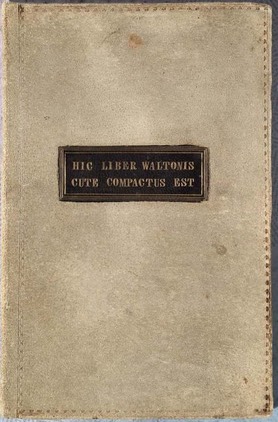

Human skin has also been used, on a number of occasions, as the binding for books! I researched a vague link from the Numismatic Bibliomania Society and discovered that ‘anthropodermic bibliopegy’ is the term for the practice of binding a book in human skin. As of May 2019, The Anthropodermic Book Project has examined 31 out of 50 books in public institutions supposed to have anthropodermic bindings, of which 18 have been confirmed as human and 13 have been demonstrated to be animal leather instead. Supposedly, the most famous of all anthropodermic bindings, is exhibited at the Boston Athenaeum, titled “The Highwayman: Narrative of the Life of James Allen alias George Walton”. It is by James Allen, who made his deathbed confession in prison in 1837 and asked for a copy to be bound in his own skin and presented to a man he once tried to rob and admired for his bravery, and another one for his doctor. Once he died, a piece of his back skin was taken to a tannery and utilized for the book.
The large majority of these books are medically related and/ or were commissioned by doctors. They are usually held by libraries or museums, although an 1892 French copy of Edgar Allen Poes’ book “The Gold Bug”, that has contemporary notations from a prominent author of the time, indicating that the binding is anthropodermic, sold in 2016 for $1020. (Note: The anthropodermic binding was not confirmed prior to sale!)
On that note, this topic is enough to give the most die-hard Halloween fan pause and it makes my skin crawl, no pun intended, so I will leave it here and let you return to Halloween festivity preparations!
BOOK OF THE MONTH
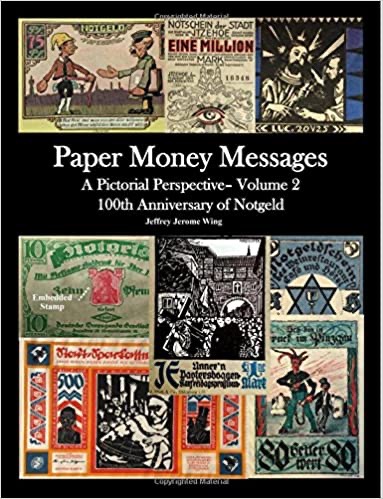
Paper Money Messages: A Pictorial Perspective - Volume 2 (Notgeld) 1st Edition by Jeffrey Jerome Wing This is Volume 2 of a 3 volume set and continues the author’s intriguing account of paper money, this volume focusing on the German notgeld used for emergency currency in the early 1900s. Notgeld is particularly interesting for the imagery and text used in its design, which will connect the reader to a broad range of historical subjects, such as the hyperinflationary period that struck Germany between 1914 and 1924 and the struggles of the Jewish people in that country and others. The author uses the notgeld to explain the devastation of the German economy when the price of goods increased by the hour and for instance a 1,000,000,000,000-mark note had the value of only 22 cents (U.S.)! Many of the notgeld seen in this book was used by the Nazis for propaganda against the Jews and expressed the anti-Semitism so prevalent in that day. Battles, witches, spirits, Chris- tianity, miracles, and the Catholic Church are some of the many themes expressed by the notgeld artwork and the associated text. The reader will find this abundantly-illustrated book to be rich in history and a rewarding study of paper money.
Currency Note of the Month
Swiss 1000 Franc Note This pick certainly fits in well with this months spooky and creepy Halloween theme!
This Swiss 1000 Franc note was released as part of the 5th Issue of Swiss Franc notes starting in 1957. Swiss notes are unusual in that, until this year, they were issued with 20 year validation dates and then recalled and replaced. The main color of the note is purple and the face features a portrait of an unknown woman staring at possibly a hooded figure along with the denomination and serial number.
The reverse however, features a vignette of The Danse Macabre. Also called the Dance of Death, it is an artistic genre of allegory of the Late Middle Ages on the universality of death: no matter one's station in life, the Danse Macabre unites all.
The Danse Macabre consists of the dead or a personification of death summoning representatives from all walks of life to dance along to the grave, typically with a pope, emperor, king, child, and laborer. It was produced as memento mori, to remind people of the fragility of their lives and how vain were the glories of earthly life. Its origins are postulated from illustrated sermon texts; the earliest recorded visual scheme was a now-lost mural at Holy Innocents' Cemetery in Paris dating from 1424 to 1425. This particular vignette features the Grim Reaper and three of his victims: An old man, a young woman and a child. In the left hand corner is an hourglass, making it clear that our days are numbered. When the sand runs out, our time is up.
The Swiss are known for their fondness for large size notes, with the 1,000 ($998 US) Franc note being the second largest world note in circulation. There are about 47 million of the new 2020 1,000 franc notes currently in circulation, amounting to 10.5 per- cent of the number and 62 percent of the value of all banknotes in Switzerland. That, of course, makes this particular note rare since it would it have been expensive to retain when it was recalled and replaced. Examples run between $1500 and $2500 depend- ing on condition.
Coin of the Month
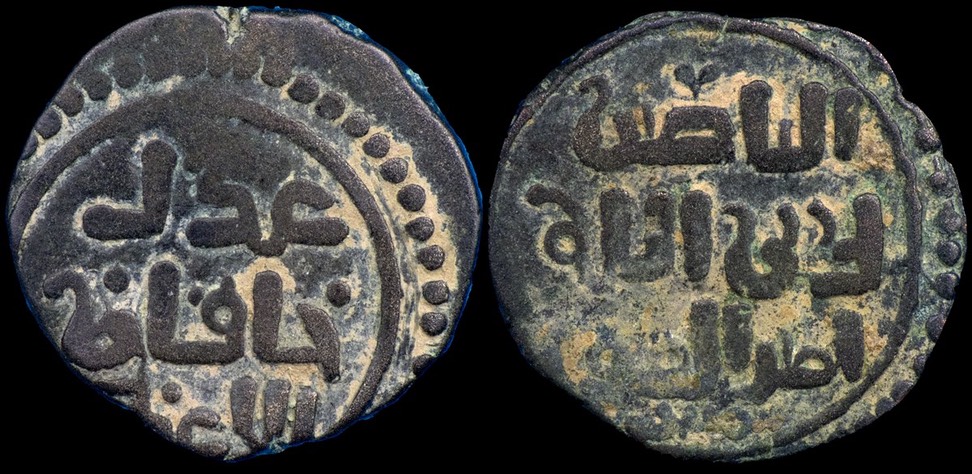
An ancient coin with an interesting, albeit, horrific story! While this coin doesn’t look like much, it is a very rare AE (bronze or brass) Jital dated Jumada I or approx. June 1221 AD. The obverse has the date and the name of the Malik or King. The reverse has the mint, the City of Kurzuwan of the Khwarezmid Empire, and the phrase, “There is no God but Allah; Muhammad is the apostle of Allah”.
In 1219, Genghis Khan, sent a trade caravan of 500 men to meet with the Shah of the Khwarezmid Empire in an attempt to establish trade negotiations. After they were all arrested and executed, Genghis sent a second group of 3 Ambassadors. 2 of them, Mongols, were humiliated by having their beards shaved off, and a third Ambassador, a Muslim, was beheaded. This was viewed by Ghengis Khan as a personal affront since he considered ambassadors "as sacred and inviolable”. The Mongols invaded the Khwarezmid Empire shortly after.
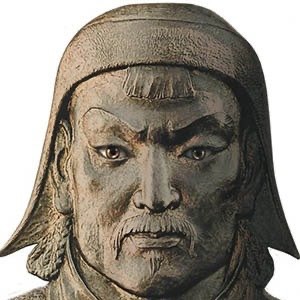
When the Mongols arrived at the City of Kurzuwan, the inhabitants refused to let them occupy the city and forced the Mongol army to besiege it. Shortly after the siege started, coins began to be minted inside the city but, only a month after the beginning of the production, the Mongols successfully took the city and slaughtered the entire population, women and children included.
Kurzuwan was lost forever and became known as a "ghost city", an "empty ruin inhabited only by wild dogs".
These siege coins survive to this day however, even though their makers were violently slaughtered and the coins used by their executioners!
NUMISMATIC AND HISTORICAL QUESTIONS AND FACT (SEPTEMBER)
Q. I recently was shown a George Washington Inaugural button. What are they and how many of them are there?
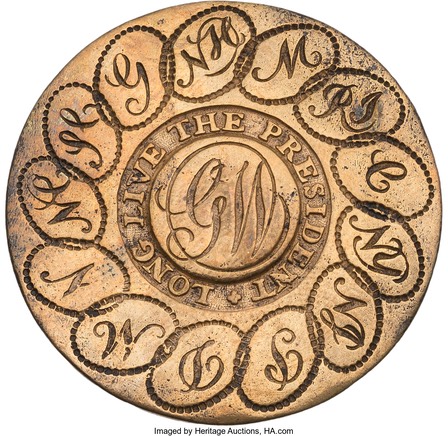
A. George Washington’s first inaugural was postponed for various reasons from March 4th to April 30th, 1789 when the inaugural ceremonies were observed in Federal Hall in the city of New York. When Washington was inaugurated in 1789 no inaugural commemorative medals were issued -- however a number of buttons commemorating the occasion were made and sold. Today, the known varieties of Washington Inaugural buttons are in great demand by collectors of political buttons and medals, Washington medals, and button collectors.
They exist in 3 sizes and while they are called buttons, only the small size ones, for breeches, would have actually have been sewed on. The 2 larger sizes would have likely been used with cloaks and coats. They were not sewed on the great coats but were worn by inserting the shank through a button-hole and a tape, knotted at the top and bottom, held them in place. Like our present day cuff-links, at the end of the day they were removed and carefully preserved for the next wearing. They were expensive and not easily replaced if lost.
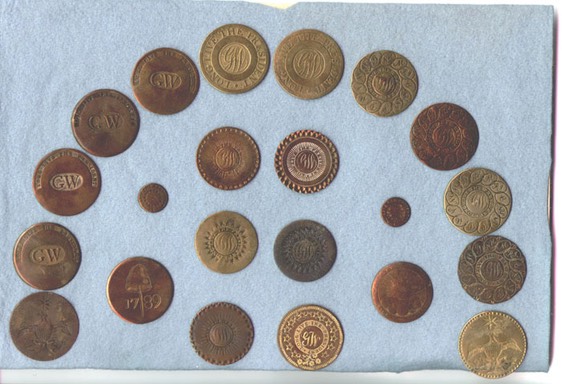

There is a great deal of speculation into the significance of the symbolism depicted on the buttons which even extends into just what constitutes a G.W. button! J. Harold Cobb was one of the original specialists in collecting these buttons and his personal collection sold at auction in 2003. He had 60 pieces in his personal collection but some of those pieces were not specifically G.W. buttons. The website www.georgewashingtoninauguralbuttons.com lists 26 types with an additional 13 subtypes. They also have excellent images of the buttons along with a great deal of research into the symbolism struck on the buttons and by who and where they were struck. The original symbolism and their origins is likely the basis for a number of U.S. patriotic symbols. Their tracking data also gives an estimate of the existence of possibly as many as 1600 known G.W. button specimens.
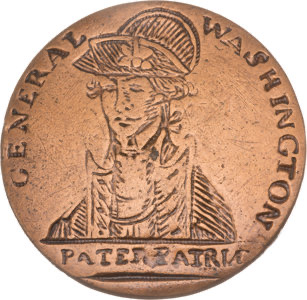
In 2018, a G.W. button set a world record when it sold for $225,000 at a Heritage auction. The rare Washington artifact is now the world's most valuable Washington button, created to celebrate the first president's 1789 Inauguration. It features a crisp, stamped bust of Washington and the words "Pater Patriæ," a Latin phrase meaning "Father of his Country”, the earliest artifact referring to George Washington in that manner and is believed to be the origin of that phrase still in use today..
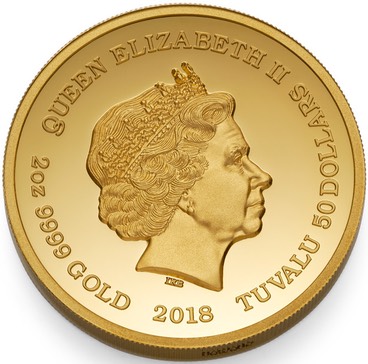
EDUCATIONAL FACT: Lux Coin, a manufacturer of the most iconic coins in the world has recently unveiled its new wonder- a gold coin that contains a drop of the very precious Old Vatted Glenlivet 1862 (the world’s oldest scotch) at its core. The exclusive Whiskey coin is a work of art like no other and happens to be the world’s first legal tender coin to hold the vintage whisky in it.
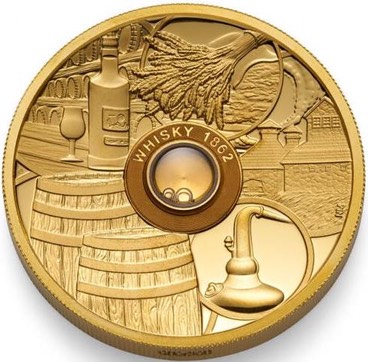
As part of the design, the golden goblet features a capsule containing the rare spirit in the middle, with adornments such as a bottle and glass, casks of spirit and sculpted representations of the whisky making process inscribed in its background. Made from 2oz of 99.99% pure gold, the whiskey coin happens to be the first ever to encapsulate such valuable aged liquor in a precious metal of the highest quality. The unique collectible forms part of a legal tender of the Government of Tuvalu and comes with a very limited mintage of only 300. It is also the first of three gold coins from the new Spirit Coins series created by Lux Coin in conjunction with top mints.
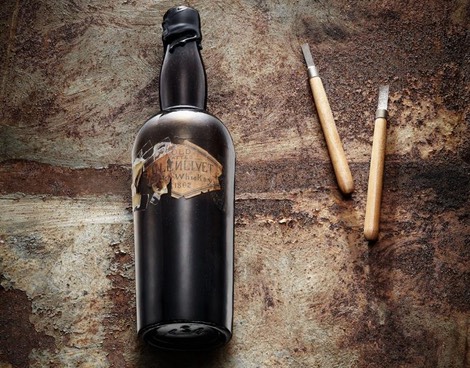
Commenting on its launch, Lux Coin Chief Executive Officer, Lukasz Baranowski said, “We are delighted that the Whisky Coin was created in cooperation with the precious metals experts from The Perth Mint. Our idea to enclose a drop of the world’s oldest whisky in a gold coin was unusual, but we stand by our motto of making the impossible possible, which worked beautifully for this project.” The exclusive Lux Whiskey Coin retails for a price of US$9,240.
Q.I recently saw a booklet containing a series of notes with very odd denominations. I believe they were from Burma? Any info?
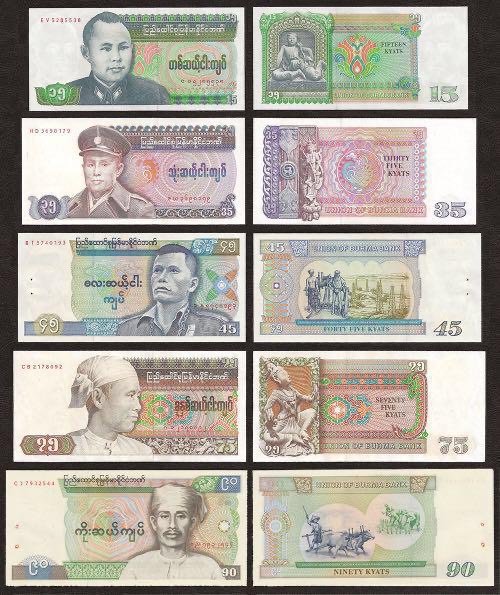
A. The banknotes you describe were issued in unusual denominations by megalomaniacal dictator Ne Win in 1985-1987 Burma. While most countries use a decimal system to denominate their money, Ne Win, as a practicing astrologist and numerologist, used numbers he believed to be lucky and he put more faith in those beliefs than he did in economics and finance.
In 1985, he forced the Union Bank of Burma to issue a 75-Kyat note. The 75-kyat note was intended to honor his 75th birthday. In 1986, 15- and 35-kyat notes were issued.
Extremely unpopular, all three were demonetized in 1988, along with larger issued notes, rendering 75% of the nation’s currency worthless, crippling an already crippled economy, wiping out the life savings of thousands of people, and triggering at least one insurgency. Instead of solving the problem, Win made it worse: 45- and 90-kyat notes were issued—these were multiples of 9, which Win’s numerologist assured him was a lucky number. At the age of “lucky number” 90, Ne Win was arrested. He died in prison in 2002.

While unpopular with the Burmese people, the odd notes are popular with collectors and are sometimes sold as sets in the type of booklets you mentioned. Most of them have 5 notes, the 15, 35, 45, 75, and 90 Kyat denominations and sell for around $30-40.
Currency Note of the Month

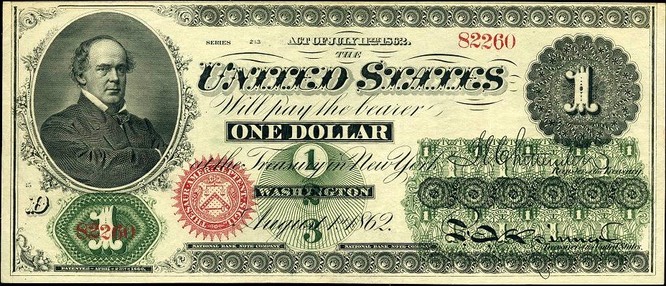
This Legal Tender note was the first $1 U.S. note released albeit it was part of the second issue of Legal tender notes since the first issue did not include $1 or $2 notes. It carries a date of August 1, 1862 and features the printed signatures of Chittenden (Register of the Treasury) and Spinner (Treasurer). The portrait is of Salmon P. Chase, then Secretary of the Treasury. These notes were not backed with, or exchangeable, for gold or silver coin but the decision was made to issue them to help finance the costs of the Civil War.
Printed by the American Banknote Co. the note has 4 variations relating to the presence, or absence, of the ABCO monogram and a green patent date.
Legal Tender bills depreciated from the very beginning. A double system of pricing quickly arose in the marketplace–a higher price if paid in Legal Tender bills, a lower one if gold or silver coins were tendered in payment. Indeed, at the outset, there were many merchants who would not accept Legal Tender Notes at all and demanded coins. The height of deprecation was in 1864 when it took $1,000 in Legal Tender Notes to buy $387 face value of gold coins. Fine examples are available for less than $500 but price increases quickly depending on grade and variety.
Coin of the Month
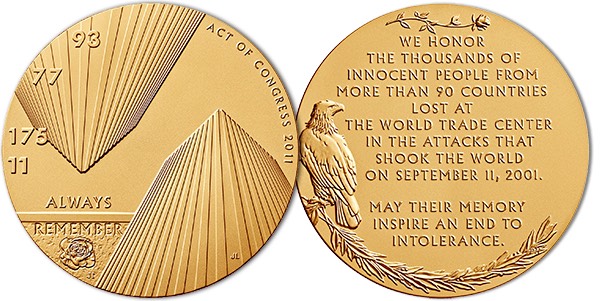
2011 Fallen Heroes of New York Medal While technically not a coin, I thought this an appropriate choice for this month in any case.
The medal’s obverse features an abstract representation of two towers. The abstract lines flowing downward symbolize loss while the lines moving upward represent rising above, hope, and deliverance from that loss. This configuration also suggests the World Trade Center’s Twin Towers. The numbers 93, 77, 175, and 11 represent the four planes involved in the tragic events of 9/11 and are positioned as if on a clock, representing the times of the crashes. The words “Always Remember” are set upon a stone wall similar to the wall that bears the names of the victims at the memorial.
The reverse (tails side) features a single rose protruding from an edge at the top, an echo of the memorial in New York where a white rose is placed through the name of each victim on his or her birthday. The inscription reads: WE HONOR THE THOUSANDS OF INNOCENT PEOPLE FROM MORE THAN 90 COUNTRIES LOST AT THE WORLD TRADE CENTER IN THE ATTACKS THAT SHOOK THE WORLD ON SEPTEMBER 11, 2001. MAY THEIR MEMORY INSPIRE AN END TO INTOLERANCE. The design also includes a bald eagle standing sentinel and clasping branches of laurel signifying an eternal honoring of those who perished in the tragedies.
The obverse of the World Trade Center Fallen Heroes’ medal was designed by Joel Iskowitz and executed by United States Mint Sculptor-Engraver Jim Licaretz. The reverse was designed and executed by United States Mint Sculptor-Engraver Phebe Hemphill. Originally sold in gold and bronze, the bronze version is still available from the Mint in 1.5” and 3” sizes for $7 and $40 respectively.
WEBSITE OF THE MONTH
tokencatalog.com While this website does not technically deal with coins, most of us have a few a tokens, wooden nickels, or things that look like coins but that we know they aren’t. Also, if you are a collector specializing in a specific type of token and are looking for similar types, or information about a specific token you’ve come across, then this is the site for you. The free site is run by a man named Richard Greever and contains information on over 600,000! tokens world- wide along with over 400,000 image of those tokens. The site is fully searchable by keyword making looking up a specific token an easy task. An excellent research source and fun to peruse as well!
NUMISMATIC AND HISTORICAL QUESTIONS AND FACT (AUGUST)
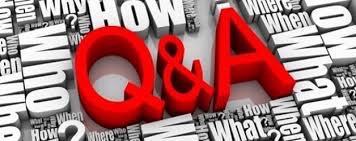
Q. Japanese Invasion Money or JIM, is a popular collecting niche especially for WWII aficionados. Did the Japaneseever strike any occupation coinage as well?
A. The book “World War II Remembered” has a small reference to the existence of 6 different pattern coins. There are two 1c coins listed, one with a pattern of a wooden head, the other as shown, with Japanese dates of 2603 (1943) and 2604 (1944) intended for use in Netherlands East Indies. One 5c coin and one 10c, with a pattern of a shadow puppet dated 2603 also intended for use in Netherlands East Indies., and a 10c coin as shown (rams head?), made of an alloy of zinc and nickel, dated 2604 for use in Inner Mongolia.
Also, the Central Bank of Malaysia Money Museum has on display a unique pattern coin showing that occupation coinage was considered. The pattern on display is a 20 cent aluminum pattern coin inscribed on the obverse with the name MALAYSIA, and the date 2602 (1942). Inscribed on the reverse is a typical Japanese design of a sun ray with sakura flowers, with 20 CENTS at the top.
The name MALAYSIA was used on the pattern coin of 1942. The name for this country was not officially changed from 'Malaya' to 'Malaysia' until 16 September 1963. However, the latter name had been in common use since the 19th Century, and the Osaka Finance Ministry in Japan has verified that this pattern coin had been minted at the Osaka Mint, and that the name MALAYSIA was the Japanese name for that region, at that time. Malaya was gradually occupied by the Japanese between 8 December 1941 and the Allied surrender at Singapore on 16 February 1942. The Japanese remained in occupation until their surrender to the Allies in 1945.
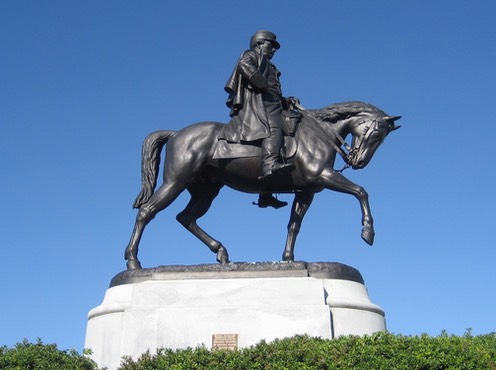
EDUCATIONAL FACT: While recently there have been numerous calls for the destruction or removal of memorials to American heroes, particularly Con- federate monuments, in some cases there may be more than just a statue involved. In August of 2018, as an equestrian statue of Confederate Gen. P.G.T. Beauregard, at the entrance to New Orleans' City Park, was being removed, the removal crew discovered a box inside the pedestal mount. The box and its contents were handed over to the State Museum, which is under the lieutenant governor’s office, for preservation.
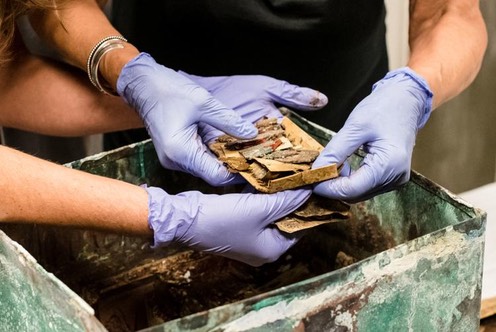
The contents first saw the light of day 105 years after they were placed in the time capsule buried in the pedestal. Confederate dollars, guides to New Orleans, newspapers and other artifacts were pulled one by one from the box in sur- prisingly good condition given that water had long ago gotten into the box. The contents appear to have been partially protected by a flag — or flags — that had been wrapped around them and which appeared heavily damaged by water and age. U.S. and Confederate flags had been among the items placed in the capsule.
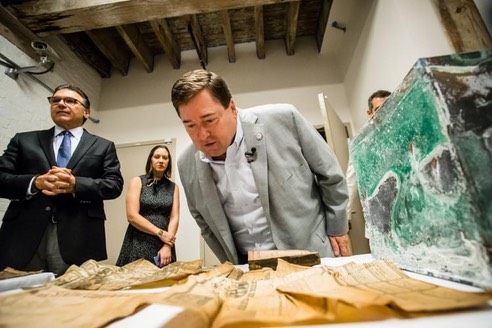
Stacks of Confederate currency — including an uncut sheet of five-dollar bills — and bonds issued in New Orleans during the war, with redemption coupons still attached, were spread out along the tables. "It’s hard to believe that’s 100 years old ... what they were thinking when they put that together," then Lt. Gov. Billy Nungesser said as conservators and museum officials began the first stages of a painstaking restoration process. "If we were doing this time capsule today, we'd need to do it in a little bit better box." Nungesser took a particular interest in the currency, saying his father had turned him on to the hobby of collecting historic coins. although few of those were included in the box. The box also included a guidebook to New Orleans published by the D.H. Holmes department store, a city directory, newspapers from the days leading up to the box’s original burial in November 1913 and a large number of tattered and faded medals and ribbons, many of which were stuck together in clumps.
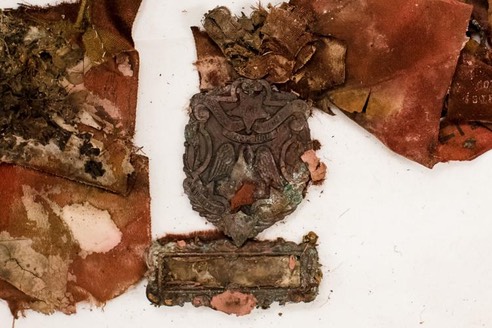
When found, the box had no lid. If that weren’t enough to allow water to seep in, a “slice” on the side had provided another avenue for intrusion. “It’s unusual for a time capsule to be buried so unguarded to the elements”, said the State Museum's interim director, Steven Maklansky. That, combined with the lack of information on when those who left the items hoped to see the box opened, suggests it was not buried with the typical intention of giving future generations an idea of what life was like at the time, he said.
The Beauregard statue was taken down after then-Mayor Mitch Landrieu called for the removal of four public monuments he said celebrated the Confederacy. Statues of Confederate President Jefferson Davis and Confederate Gen. Robert E. Lee and a monument to the New Orleans white supremacist militia known as the White League were also removed.
Q. As an avid bibliophile, I picked up a half-penny Condor token featuring “J. Lackington”. It is dated 1795 but seemed suspiciously cheap, $60, for a token that old?
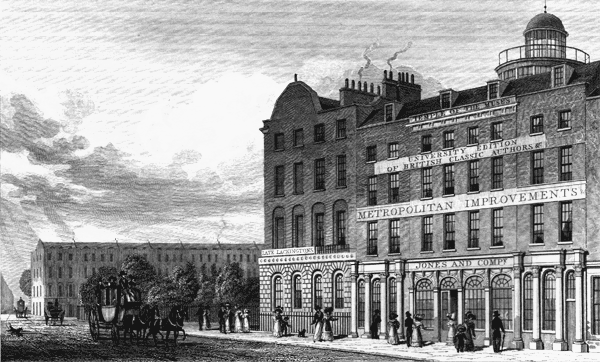
A. Today, few people are likely to recognize James Lackington (1746-1815) and his once-famous London bookshop, The Temple of the Muses. The Temple of the Muses, which was one of the first modern bookstores, was amammoth enterprise, by far the largest bookstore in England, boasting an inventory of over 500,000 volumes, annual sales of 100,000 books, and yearly revenues of £5,000 (roughly $700,000 today). And this made Lackington a very wealthy man!
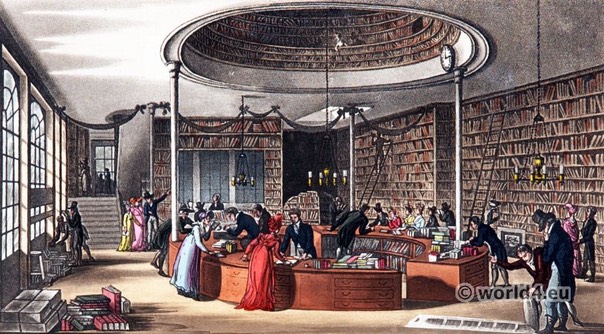
He incorporated a number of innovations which made the bookstore successful, including, running the business as “cash only” allowing him to buy and sell without need for business loans. This also permitted him to purchase entire libraries and use direct sales to have a high volume turnover. Lastly, all books were sold at a fixed price, unheard of at a time when haggling and barter were common.

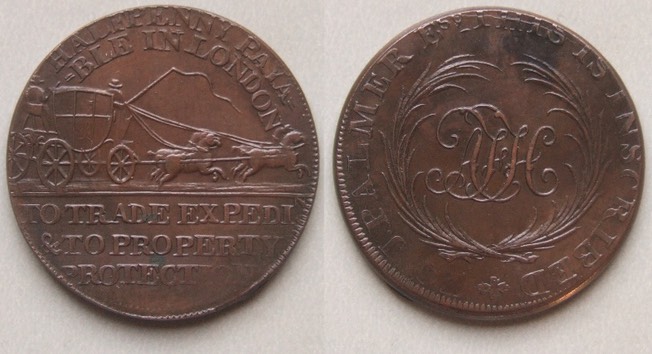
The bookstore was 4 stories tall and as one ascended the prices became cheaper, and the books more used, which greatly encouraged bargain hunters. There were even ‘lounging rooms” allowing patrons to just sit and read.
Lackington himself became something of a celebrity. A flag flew above The Temple of the Muses to let customers know when he was present in the shop, and he rode through the streets of London in a carriage inscribed with his motto: "Small profits do great things." He even minted tokens bearing his image and car- riage, which could be redeemed in the shop. Those tokens are readily available in a number of varieties and metals from token dealers and $60 is an average price.
Currency Note of the Month
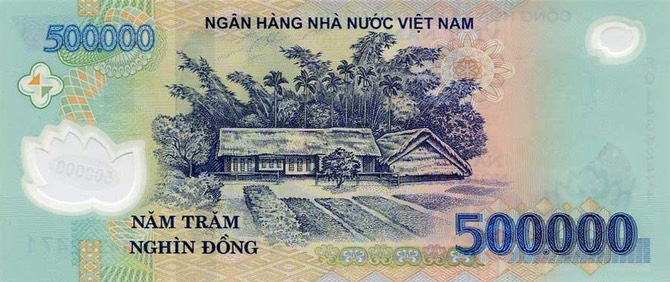
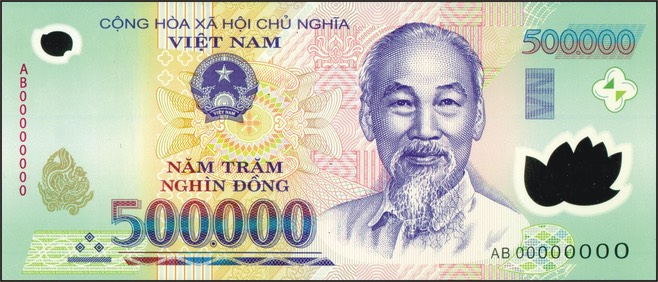
For those of you that have alwaywanted to be a millionaire, there are a few currencies that come to mind. Of course , with the Zimbabwe inflation notes a person can do it with one note. The note this month is its next closest competitor, the Vietnamese ₫500,000. The đồng has been the currency of Vietnam since May 3, 1978. and is issued by the State Bank of Vietnam. Since this is Vietnams largest denomination, it will require 2 of these notes to become a millionaire. However, since the đồng trades against the U.S. dollar at a rate of around 23,000 to one, 2 of these notes would set you back less than $60. The note shown above was released in 2003 and features a portrait of Ho Chi Minh on the face and the reverse has Ho Chi Minh's birthplace in Kim Liên.
There are numerous large denomination notes, including the U.S. $100,000 note, but very few that are actively used.
Coin of the Month

Vietnamese 5000 Đồng Since I selected a Vietnamese note for this months currency feature, I thought it appropriate to feature a coin from the same country. While this is the highest denomination coin of Vietnam, the Vietnamese have not used coins for dai- ly transactions since around 2014. Because they are still official coinage however, some local banks may still accept them in trade for larger denomination paper money. The obverse shows a coat of arms surrounded by text in Vietnamese, saying “Socialist Republic of Vietnam”. The reverse shows the denomination and the Chua Mot Cot temple in Hanoi, a one pillar pagoda. it also carries the legend “State Bank of Vietnam”. The coins were produced by the Finland Mint and are 25.5 mm, made of brass with a micro-scalloped edge, and oddly, have medal orientation for the obverse and reverse vice the usual coin orientation.
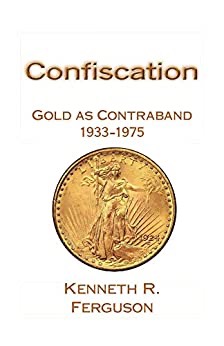
Book of the Month
Confiscation: Gold as Contraband
1933-1975 by Kenneth R. Ferguson (Author)
Some political misjudgments of the past are so notorious that today they are referenced by a single word: Prohibition, Appeasement, Internment, Escalation. The confiscation of gold from American residents in 1933 should be included in that category. In the late 1920s, the mere thought of gold confiscation would have been inconceivable to everyone, including those who later supported it. How and why it happened deserves proper examination; it is an essential part of American history.
NUMISMATIC AND HISTORICAL QUESTIONS AND FACT (JULY)

Q. Since this is now tax season, I was reading about some of the innovative taxes that have been instituted. Are there any that are truly exceptional?
A. There is an ancient Latin saying, “Pecunia non olet” or “Money doesn't stink!”. During his reign of 69-79 AD, Roman Emperor Vespasian (shown) placed a tax on urine. The urine from public urinals was sold as an essential ingredient for several chemical processes and the buyer(s) of the urine paid the tax. Urine was used in the tanning of animal hides. Soaking the skins in urine loosened the hair making it easier to remove. It was also used by launderers as a source of ammonia to clean and whiten woolen togas etc. Therefore, those who obtained valuable urine from collectors were charged a tax. So, the next time you see a movie set in Ancient Rome with their bright white togas, you’ll probably note that they are also drinking wine and working on providing tomorrows fabric whitener!
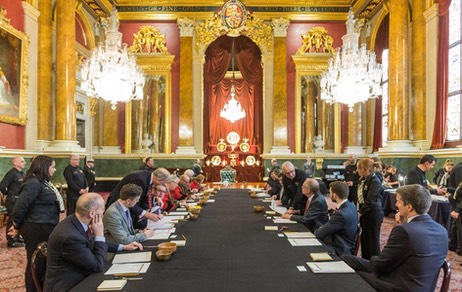
EDUCATIONAL FACT: The Trial of the Pyx is an annual trial to check that UK coins produced at The Royal Mint are within the statutory limits for metallic composition, weight and size
The testing dates back to the 12th century, making it one of the oldest judicial procedures in the country and has taken place at Goldsmiths' Hall since 1871.

The name Pyx refers to chests in which the coins are transported, and derives from the Latin word ‘pyxis’, meaning small box. For centuries they were stored in the Pyx Chamber in Westminster Abbey, along with other important items of state and church.
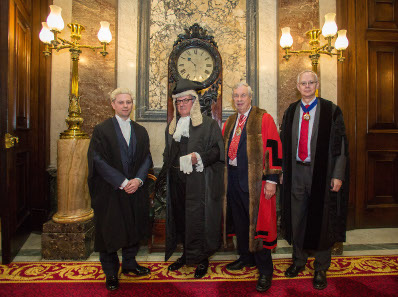
The Trial is held annually in accordance with the Coinage Act of 1971, and is presided over by the Queen’s Remembrancer of the Royal Courts of Justice, the oldest judicial office in the UK, dating back to the twelfth century.The trial is an actual trial in the judicial sense (with the coins being the accused) and is presided over by a Judge, (the Queen or King’s Remembrancer), with a jury of expert metallurgical assayers.
Little has changed in the procedure since thereign of Edward I. Throughout the year, coins are randomly selected from every batch of each denomination struck, sealed in bags containing 50 coins each, and locked away in the Pyx boxes for testing at the Trial.


The benchmark against which the coins are tested is called a Trial plate. These metal plates, made of gold, silver, platinum, nickel and zinc, are held at the National Measurement and Regulation Office along with the original coin Stan-dard Weights against which the weight of the trial coins are compared. The oldest surviving Trial plate, from 1477, is one of the treasures of The Royal Mint Musuem.
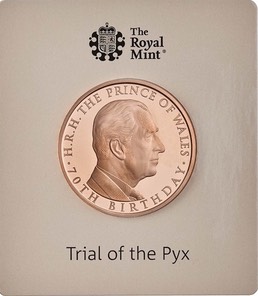
Coins subjected to the Trial are quite collectible and are sold in special packaging denoting their authenticity. However, they are usually not in uncirculated condition and once removed from the packaging are unable to be specifically identified as a Trial of the Pyx coin.
Q. What is a “Labor Exchange” note?
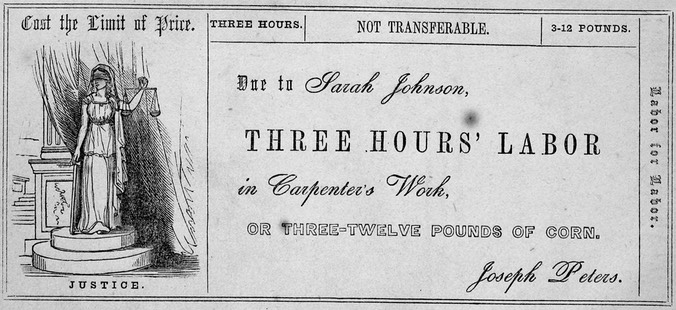
A. Labor notes are an alternative currency based on exchange of hours of labor. Two early attempts at implementing labor notes were made by social reformers Josiah Warren and Robert Owen following their experiences attempting to establish a utopian community at New Harmony, Indiana in which currency was prohibited.

In 1827, Warren established the Cincinnati Time Store where goods could be purchased with labor notes representing an agreement to perform labor. However, he folded the store in 1830 in order to devote his effort to establishing communities that implemented his principles of labor-based prices.
Beginning in 1832, Robert Owen and his followers attempted to implement labor notes in London and Glasgow by es- tablishing marketplaces and banks that accepted them. Their efforts failed in 1834. During the Great Depression, European communities implemented local currencies with varying success. More modern implementations as time-based currencies were implemented in the United States starting in the 1970s.
Website of the Month
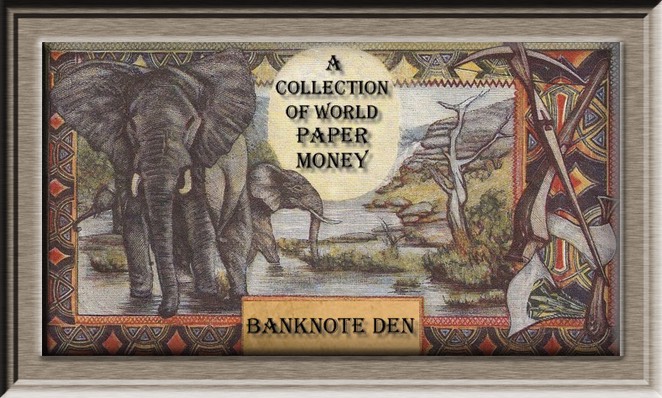
banknoteden.com The Banknote Den is information about banknote collecting, or notaphily, in general. This website is meant to be a simple and informative site which attempts to provide a glimpse into the fascinating world of banknote collecting. This site deviates from the normal "How to Collect Banknotes" genre of sites and attempts in its own way to deliver aspects of collecting that are often expressed by many collectors: Learning some of the his-tory and culture of the world that is often known only to those who have lived where these notes are from. In addition, I hope to provide some education on the older notes of the United States that may not be so well known to us today.
Currency Note of the Month
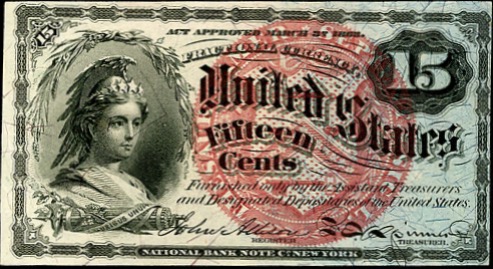
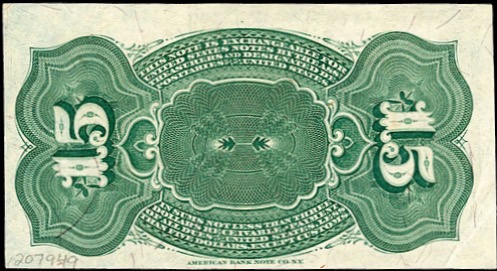
Fourth Issue 15 cent Fractional Currency note. It features the Bust of Columbia on the front and detailed lathe work with prominent “15” denomination numbers on the re- verse. These notes were printed from 1869 to 1875 by both the National Banknote Co. and the American Banknote Co. and were the first to feature printed Treasury seals. They were also the first, in 1870, to use a a new type of paper with “localized blue stain” ends. This was an attempt to prevent counterfeiting of the notes. There are 4 varieties of this note. 2 with different type paper and 2 with slightly different size Treasury seals. Over 34 million of these notes were printed with slightly over 2 million currently unredeemed.
Coin of the Month
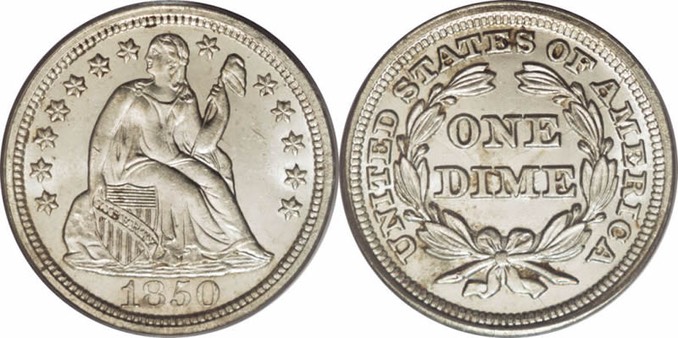
Seated Liberty Dime The basic obverse design of the Seated Liberty dime, was designed by Mint engraver Christian Gobrecht and drawn by Thomas Sully. It consisted of the figure of Liberty clad in a flowing dress and seated upon a rock. In her left hand, she holds a Liberty pole surmounted by a Phrygian cap, which was a pre-eminent symbol of freedom during the time. Liberty's right hand rests on the top corner of a striped shield with a diagonal banner inscribed with the word "Liberty". The shield represents preparedness in the defense of freedom. There are 5 major varieties of the design. The addition of stars to the original obverse, a change in weight on 2 occasions along with the addition of “arrows” at the date, and the replacement of the stars with the U.S. Legend, The date of the coin appears on the bottom below Liberty. The reverse features one of 2 types of wreaths with the mintmark either within the wreath or below it. The coins were minted at Philadelphia, New Orleans, San Francisco, and Carson City, from 1837 to 1891 with the following specs, weight: 2.67, 2.49, or 2.5 grams, composition: .900 silver and .100 copper, dia: 17.9mm, reeded edge.
NUMISMATIC AND HISTORICAL QUESTIONS AND FACT (JUNE)

Q. I recently saw a kit for doing a portrait of Lincoln in different shades of circulated cents. Whats the biggest one assembled?

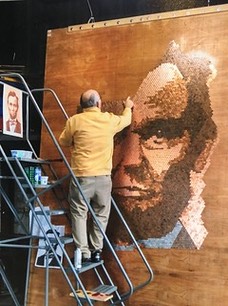
A. The kits are usually smaller versions of a portrait completed by Richard Schlatter, the founder of the SchlatterGroup, a full-service ad- vertising agency in Battle Creek. Early in 2017, he decided to create an entry to the 2017 ArtPrize, an international art competition held annually in Grand Rapids Michigan, creating a portrait of Abraham Lincoln realized almost exclusively with Lincoln cents.
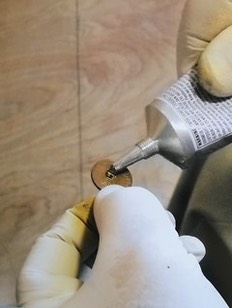
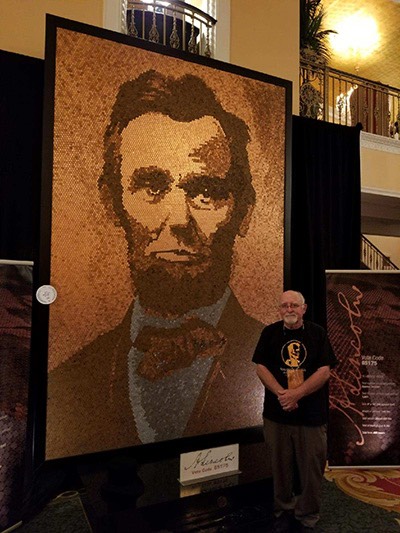
Taking as his model the striking face-forward portrait of Lincoln photographed by Alexander Gardner on November 8, 1863 (just eleven days before the President delivered the Gettysburg Address), Schlatter chose the imposing scale of eight by twelve feet, and began selecting Lincoln cents in hues from bright red to rich brown needed to realize his vision. This included 1,681 1943 steel cents to depict the lighter color of the President’s shirt.
Schlatter created a working grid of the Gardner photograph on his backing board, then began to painstakingly select cents by color, and to glue each one on individually. In all, approximately 24,500 cents were used, with no chemicals or paints used to alter the color of the copper cents (the steel cents were cleaned with a solution of lemon juice and water, then hand- polished with a soft cloth). At least one Lincoln cent of every date 1909-2017 can be found among the 24,500; along with two Indian cents, dated 1891 and 1901; and a solitary cent planchet. The 1909 Lincoln and the planchet, among other pieces, were donated to the project by Michigan State Numismatic Society past President Al Bobrofsky, also a resident of Battle Creek).All of the cents received a coat of UV-resistant clear acrylic to protect them from future oxidation.
Five pounds of glue were used to secure the cents, and it took at least 320 hours secure them to the board. Much of the work had be done on a ladder-like platform, and it was necessary to retreat to ground level from time to time to observe how the newly-added cents appeared from a distance. It is currently on free public display at the Battle Creek Community Foundation in Battle Creek Michigan.
Q. A dealer recently showed me an “Assay Commission medal”. Any background?

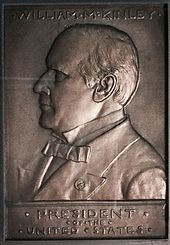
A. The United States Assay Commission was an agency of the U. S. government from 1792 to 1980. Its function was to supervise the annual testing of the gold, silver, and (in its final years) base metal coins produced by the U. S. Mint to ensure that they met specifications. Although some members were designated by statute, for the most part the commission, which was freshly appointed each year, consisted of prominent Americans, including numismatists. Appointment to the Assay Commission was eagerly sought after, because beginning in 1860, commissioners received a commemorative medal. These medals, different each year, are extremely rare, with the exception of the 1977 issue, which was sold to the general public.
In 1971, the commission met, but for the first time had no gold or silver to test, with the end of silver coinage. Beginning in 1977, President Jimmy Carter appointed no members of the public to the commission, and in 1980, he signed legislation abolishing it.

All Assay Commission medals are extremely rare. Except for the 1977 medal, none is believed to have been issued in a quantity of greater than 200, and in most years fewer than 50 were struck. Additional copies of several 19th-century issues are known to have been illicitly struck although the Mint ended such practices in the early 20th century. PCGS currently lists 290 graded medals of approx. 200 types known.
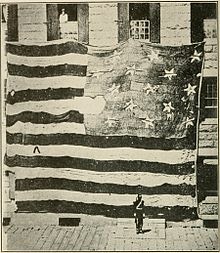
EDUCATIONAL FACT: The Star-Spangled Banner, or the Great Garrison Flag, was the garrison flag that flew over Fort McHenry in Baltimore Harbor during the naval portion of the Battle of Baltimore during the War of 1812. It is on exhibit at the National Museum of American History, Smithsonian Institution. Seeing the flag flying over Ft. McHenry on the morning of 14 September, 1814, after the battle ended, Francis Scott Key was inspired to write the poem "Defence of Fort M'Henry". These words were written by Key and set to the tune of "To Anacreon in Heaven" by John Stafford Smith, a popular song at the time. It was not until 1931 that the song became the national anthem of the United States.

With fifteen stripes, the Star-Spangled Banner remains the only official American flag to bear more than thirteen stripes. Mary Pickersgill stitched the flag from a combination of cotton and dyed English wool bunting, assisted by her daughter, two nieces, and an African American indentured servant, Grace Wisher, and it cost $405.90. The flag has fifteen horizontal red and white stripes, as well as fifteen white stars in the blue field. The two additional stars and stripes, approved by the United States Congress's Flag Act of 1794, represent Vermont and Kentucky's entrance into the Union. The stars are arranged in vertical rows, with five horizontal rows of stars, offset, each containing three stars. At the time, the practice of adding stripes (in addition to stars) with the induction of a new state had not yet been discontinued.

The flag that flew during that episode in history became a significant artifact. It remained in the possession of Major (later Colonel) Armistead, who served as the commander of Fort McHenry during the Battle of Baltimore, and his family for many years. Eben Appleton, Colonel Armistead's grandson, inherited the flag in 1878. In 1907, he lent it to the Smithsonian Institution, and in 1912 it was made a formal gift. Today it is permanently housed in the National Museum of American History, one of the Smithsonian Institution museums on the National Mall in Washington, D.C.
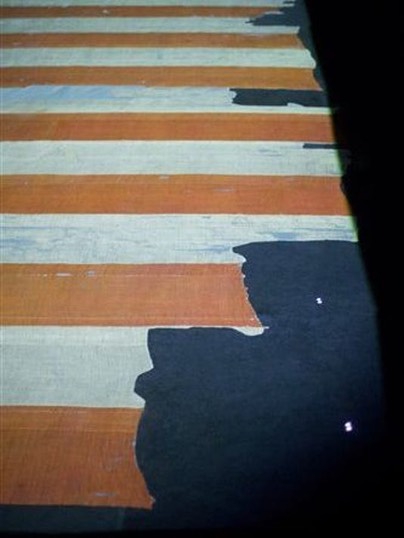
In the late 1800s, souvenirs, or relics, of important events and people in American history became highly prized and collectible objects. The Star-Spangled Banner, historic and celebrated, was subjected to this practice.
The Armistead family received frequent requests for pieces of their flag, but reserved the treasured fragments for veterans, government officials, and other honored citizens. As Georgiana Armistead Appleton noted, “had we given all that we have been importuned for little would be left to show.” Despite efforts to limit the practice, however, over two hundred square feet of the Star-Spangled Banner was eventually given away, including one of the stars.
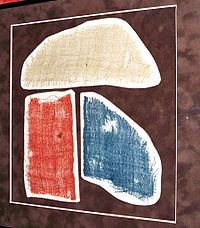
The citizens who received these mementos treated them with reverence and pride. Some framed and displayed these pieces of history in their homes; others donated them to museums. Today, the Smithsonian’s National Museum of Ameri- can History includes seventeen Star-Spangled Banner fragments in its collections. Since conservators and curators cannot be sure from which part of the flag these fragments were taken, the pieces cannot be integrated back into the flag. The fifteenth star has not been located. However, they can be ana- lyzed, allowing conservators to document changes in the condition of the flag’s fibers and better understand how time and exposure to light and dirt have affected the flag.
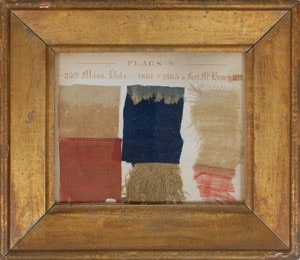
A 2-inch by 5-inch fragment of the flag—white and red, with a seam down the middle—was sold at auction in Dallas, TX on November 30, 2011, for $38,837: the snippet was, presumably, cut from the famous flag as a souvenir in the mid-19th century. The framed remnant came with a faded, hand-written note attesting it was "A piece of the Flag which floated over Fort McHenry at the time of the bombardment when Key's (sic) composed the Song of the Star Spangled Banner, presented by Sam Beth Cohen.” (Editors note: I would consider $38,000 for a piece of the original Star Spangled Banner to be an absolute bargain and I hope the piece was donated to a museum!)
Book of the Month
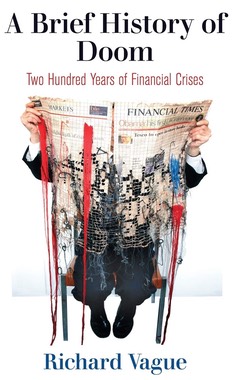
A Brief History of Doom: Two Hundred Years of Financial Crises (Haney Foundation Series) Hardcover – by Richard Vague
Financial crises happen time and again in post-industrial economies and they are extraordinarily damaging. Building on insights gleaned from many years of work in the banking industry and drawing on a vast trove of data, Richard Vague argues that such crises follow a pattern that makes them both predictable and avoidable.
A Brief History of Doom examines a series of major crises over the past 200 years in the United States, Great Britain, Germany, France, Japan, and China—including the Great Depression and the economic meltdown of 2008. Vague demonstrates that the over-accumulation of private debt does a better job than any other variable of explaining and predicting financial crises. In a series of clear and gripping chapters, he shows that in each case the rapid growth of loans produced widespread overcapacity, which then led to the spread of bad loans and bank failures. This cycle, according to Vague, is the essence of financial crises and the script they invariably follow.
The story of financial crisis is fundamentally the story of private debt and run- away lending. Convinced that we have it within our power to break the cycle, Vague provides the tools to enable politicians, bankers, and private citizens to recognize and respond to the danger signs before it begins again
Currency Note of the Month
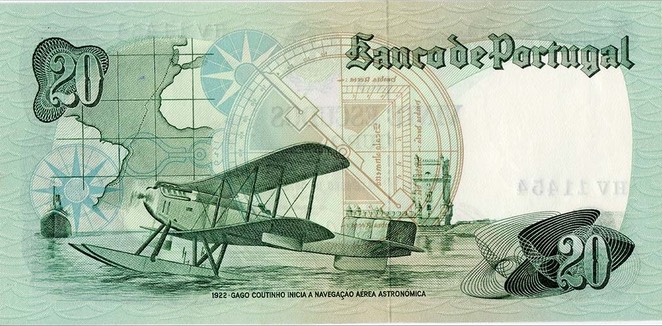
Collecting currency by vignette theme has always been popular and Aviation is one of the most prominent. The note shown is a Portuguese 20 Escudos 1979 issue. The face has the portrait of Adm. Gago Coutinho. Adm. Coutinho was a Portuguese aviation pioneer who, along with Sacadura Cabral, was the first to cross the south Atlantic Ocean by air, from March to June 1922. The trip from Lisbon to Rio de Janeiro covered a distance of over 4800 miles. The reverse depicts the Fairey IIIB seaplane used by Coutinho and Cabral for their transatlantic flight. The notes are readily available in unc. for $5-10.
Coin of the Month
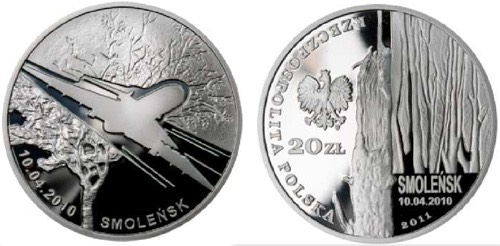
The National Bank of Poland issued a silver coin in 2011 to mark the tragic loss of then President of the Republic, Lech Kaczyński, and his wife Maria, the First Lady of Poland. They, along with 94 other members of the government, commerce, and notoriety were killed in a plane crash in Smolensk, Russia as they were on their way to attend a 70th anniversary memorial to the victims of the 1940 Katyn Massacre. The plane was reported lost in poor weather conditions and the tragic events unfolded resulting in the death of all 96 people on board.
The obverse of the coin shows the outline of the passenger jet plane along with the branches of a tree. Inscriptions indicate the date of the tragedy, “10.04.2010” and the name of the city, “SMOLENSK”.
The reverse of the coin depicts several trees without their tops, as the plane had sheared off the branches during the emergency landing. The denomination of “20 Zlotych” is seen just to the left of the main design along with the national emblem, the crowned eagle. The year of issue “2011” is positioned to the lower right side.
The coin is struck by the Mint of Poland to proof quality and in sterling silver with a weight of 28.2 grams and a diameter of 38.6 mm. An unusual commemorative coin memorializing a tragic event in Polish history.
NUMISMATIC AND HISTORICAL QUESTIONS AND FACT (MAY)

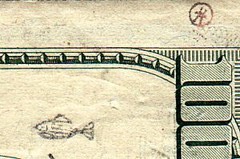
Q. I know that in the past U.S. coins used in Asian markets were verified and then counter-stamped, or chop-marked, to guarantee their value and authenticity. Is the same thing done with paper money?
A. Yes, although currently most of the time they are placed on larger denominations and may be expensive to actually collect. Chop marks are added by foreign banks, casinos, and other money changers to confirm the authenticity of the currency.
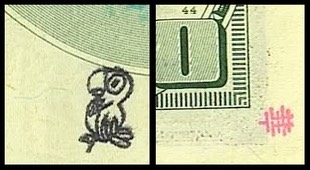

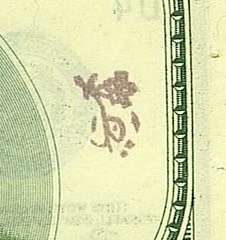
The practice is very popular in the Far East and there are also a number Middle Eastern countries that do this as well. Each institution has its own chop mark. They are usually very small and some are similar in color to the banknote printing colors, so it looks like something that could have been printed. There are literally thousands of different styles out there. A chop mark never adds any value to currency. If they were on $1 bills they might be fun to collect, however, they are usually found on denominations of $20 and higher. The high face value prevents them from being collected for the sake of curiosity and there currently isn’t any guide listing the marks and who they can be traced to.
Q. What is a Koban coin?
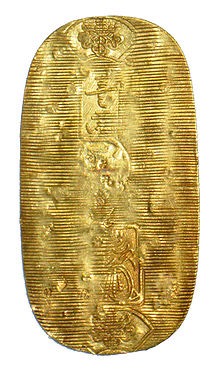
A. The koban was a Japanese oval gold coin in the Edo period of feudal Japan, equal to one ryō, another early Japanese monetary unit. It was a central part of Tokugawa coinage and 10 different types were produced between 1601 and 1867.
The Keichō era koban, a gold piece, contained about one ryō of gold, so that koban carried a face value of one ryō. However, successive mintings of the koban had varying (usually diminishing) amounts of gold. As a result, the ryō as a unit of weight of gold and the ryō as the face value of the koban were no longer synonymous.
The Japanese economy before the mid-19th century was based largely on rice. The standard unit of measure was the koku, the amount of rice needed to feed one person for one year. Farmers made their tax payments of rice which eventually made its way into the coffers of the central government; and similarly, vassals were annually paid a specified koku of rice.

The Portuguese who came to Japan in the 1550s, however,preferred gold to rice; and the koban, which was equal to threekoku of rice, became the coin of choice in foreign trade.
Some feudal lords began minting their own koban, but the value was debased with alloys of varying gold content. Edo authorities issued one currency reform after another and just about all of them debased the koban further. Additionally, counterfeit koban circulated after each reform, their value slightly less than that of the then current koban. By the time of Commodore Matthew C. Perry's visit in 1853, counterfeit koban from previous eras were preferred by merchants to the newer variants. The fraudulent older pieces were more valuable than newly minted koban.
With the Meiji Restoration in 1868 a new series of coins was ordered based on Eu- ropean currency systems and the koban was discontinued. Original kobans are readily available in the $3-5000 range depending on gold content.

EDUCATIONAL FACT: Ft. Knox may be the largest depository of U.S. gold but the largest single depository of International gold is actually held by the Federal Reserve Bank of New York.
Nearly $200 billion worth of gold rests on bedrock five stories underground, 30 feet below the city's subway system, inside the Fed- eral Reserve Bank of New York's vault.
There are roughly 497,000 gold bars belonging to 48 foreign central banks and 12 international organizations such as The International Monetary Fund or The Bank for International Settlement. No individuals or private sector entities are permitted to store gold in the vault.The United States has about 5 percent of its gold reserves stored there.
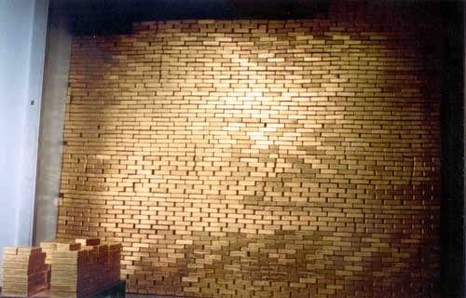
All bars brought into the vault for deposit are carefully weighed, and the refiner and fineness (purity) markings on the bars are inspected to ensure they agree with the depositor instructions and recorded in the New York Fed’s records. This step is vital because the New York Fed returns the exact bars deposited by the account holder upon withdrawal—gold deposits are not considered fungible.
While gold bars are mostly uniform, there are subtle differences that can signify, among other unique characteristics, when and where a bar was cast.
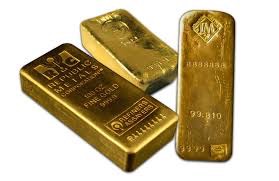
Before 1986, bars cast in the United States generally were rectangular bricks. Currently, however, bars cast in the United States conform to the long-standing in-ternational standard for most bars cast overseas, which are trapezoidal in shape. For bars cast in the United States under the pre-1986 standard, a bar’s shape can also indicate where it was cast. Bars from the Denver Assay Office have rounded sides; bars from the San Francisco Assay Office have rounded corners; and bars from the New York Assay Office have square edges. Markings on the bar also reveal information about its production. For example, a set of numbers on the bar often identifies its melt—the molten gold from which a bar is made—while another set indicates its fineness or purity. A stamped seal of a refiner often identifies where the gold was cast.
The market value of a gold bar depends on its weight, purity level, and the prevailing market price for gold. Rather than market pricing which fluctuates daily, the New York Fed uses the United States official book value of $42.2222 per troy ounce for gold holdings.
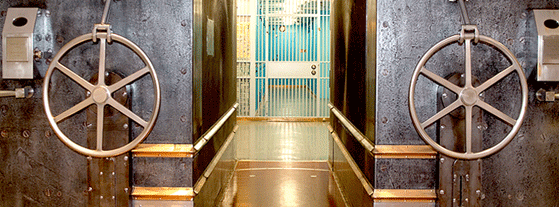
The vault is safeguarded by a comprehensive multilayered security system, highlighted by a 90-ton steel cylinder protecting the only entry into the vault. The nine-foot-tall cylinder is set within a 140-ton steel-and-concrete frame that, when closed, creates an airtight and watertight seal. Also, once closed, four steel rods are inserted into holes in the cylinder and time clocks are engaged, locking the vault unti the next business day.
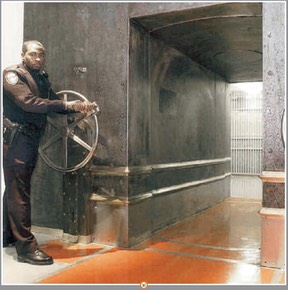
Security is further enhanced by the massive steel-reinforced concrete walls surrounding the vault and 24-hour monitoring of activity inside and outside the vault by security cameras, as well as the use of motion sensors when the vault is closed.
Additionally, the gold is protected by the New York Fed’s robust building security system and the armed Federal Reserve police force.
Website of the Month
loc.gov The Library of Congress
The Library of Congress is the largest library in the world, with millions of books, recordings, photographs, newspapers, maps and manuscripts in its collections.
The Library is the main research arm of the U.S. Congress and the home of the U.S. Copyright Office.
The Library preserves and provides access to a rich, diverse and enduring source of knowledge to inform, inspire and engage you in your intellectual and creative endeav- ors. Whether you are new to the Library of Congress or an experienced researcher, we have a world-class staff ready to assist you online and in person.
I encourage you to visit the Library of Congress in person in Washington, D.C., explore the Library online from wherever you are and connect with us on social media. Sincerely,
Carla Hayden
Librarian of Congress
While the above is good description of what is informationally available at the Library of Congress, it is still amazing the amount of information and photographs available for free, online, at this website. A “must see” for anyone doing research on anything nu- mismatically related, especially their photographic section.
Currency Note of the Month

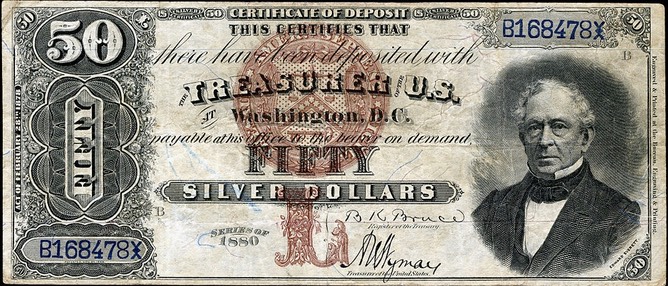
The Series 1880 $50 Silver Certificate These certificates have a portrait of Edward Everett, who was Secretary of State under President Fillmore in1852-1853, on the right-hand side of the bill. As seen above, these bills have blue serial number ink and a brown seal at the center of the note. The seal comes in 2 color variations and 3 style variations. There are also 5 combinations of signatures, and the varieties create a wide spread of valuation.
The back of all 1880 fifty dollar silver certificates have the word ‘silver” printed in large bold letters with ornate work surrounding it. Unusually, all of the Series 1880 notes were printed with black ink backs, as is the note shown.
These notes are very scarce with even the most common variety valued at $8,000+ in VG condition and at least a couple of these notes have reached the 6-figure mark!
Coin of the Month
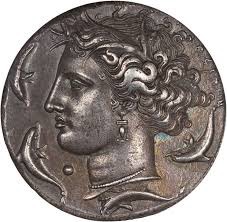
The Dekadrachm of Syracusa. Many people believe this is the most beautiful coin in the world. That might be a stretch, but the Syracuse Dekadrachm would certainly qualify as one of the more beautiful silver coins ever. The technical description runs like this:
SICILY, Syracuse. Dionysios I. Silver Dekadrachm (35 mm, 42 grams). Struck 405-390 BC. The obverse depicts the head of Arethousa, wearing a wreath of grain ears, a triple-pendant earring, and a pearl necklace; with four dolphins swimming around.
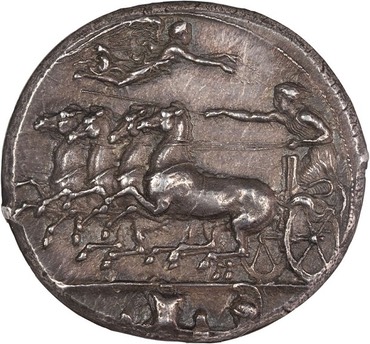
The reverse, depicts a charioteer, holding a kentron (a type of whip or crop) in his ex- tended right hand and reins in the left, driving a quadriga (a chariot with 4 horses abreast), with Nike flying above. Below the exergual line is a shield, greaves (a type of armor for the shin), a cuirass (chest and back armor), and a crested helmet, connected by a horizontal spear.
Genuine coins are very valuable with the finest known being sold in 2013 for $437,000. Nice genuine examples run from $7,000 down to $3,000 for worn examples.
Because of the beauty of the coin, various copies have been produced and are openly sold ,sometimes for large sums. Fakes can sell in excess of $1,000 for examples made prior to 1900, all the way down to base metal, modern fakes, worth $10-15! This is one coin to know exactly what you are buying and its approximate value.
NUMISMATIC AND HISTORICAL QUESTIONS AND FACT (APRIL)

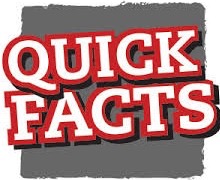
Q. I was looking over some old Cuban coins at a recent show and the dealer referred to them as “ABC” pesos and that they were called that due to their association with a Cuban revolutionary group?
A. The Cuban ABC Peso was struck by the US Mint in Philadelphia between 1934 and 1939 in .900 fine silver and .100 copper, weight 16.7295 grams, and 38.1mm in diameter, the same as a US silver dollar. The obverse shows a laureate bust along with the date and the reverse shows the Cuban national arms inside a wreath.

At the time of the coin's release, Dr. J. Martinez Saenz was the Cuban Secretary of the Treasury and he was responsible for the procurement of the new coin. He described the new coins as this: "Lady Liberty" is not an accurate description of the obverse design, the allegorical female figure is meant to symbolize the Cuban Republic, the Star is symbolic of a guiding light to lead the Republic "...in the great political and social renovation hoped for after the revolution”. He suggested the coins be called "ABC Pesos" - as a nod to the "secret" organization in which he was a leader.
This “ABC” group was a clandestine, revolutionary protest group with members from the University of Havana and young professionals who raised against the dictatorial rule of then President Gerardo Machado. The ABC got its simple name from the three alphabetical cells its members belonged to; A, B, and C. The ABC organization was not a group looking to form a national government or be a formal political party, it came together to oppose Machado and gradually dissolved after he was removed from office.
The new peso was initially meant to serve as backing for the paper money silver certificates issued by the Cuban Government in 1934 and most were deposited in the National Treasury, but some of the coins also circulated. Uncirculated examples sell for around $150.
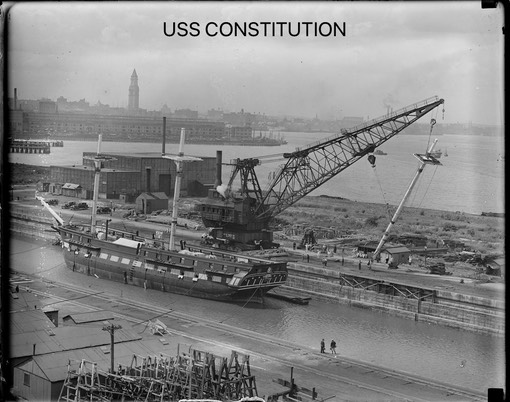
Q. I’ve heard there is a ceremony for ships which is similar to placing coins or a time capsule in the cornerstone of a new building?
A. The ceremony is called “Stepping of the Mast”. When a mast is about to be stepped – the process of raising a boat’s mast and setting it into a notch or step in the keel – all those on board the ship have the opportunity to contribute good luck coins or other memorabilia to be placed under it. The mast also may be stepped after a significant overhaul period when modifications have had to be made to the mast.
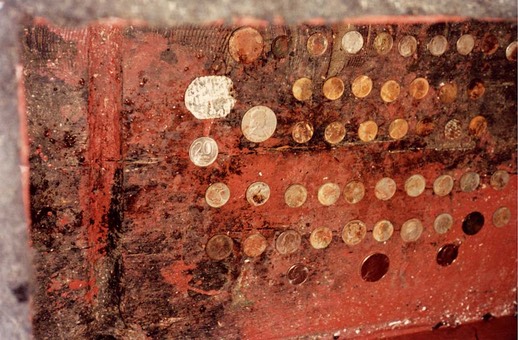
This maritime tradition is said to have its origins in the ancient Roman custom of placing coins in the mouths of men killed in battle. One theory is that, due to the dangers of early sea travel, the coins were placed under the mast so the crew would be able to cross to the afterlife if the ship were sunk. The coins were supposed to pay Charon, the mythical ferryman, for transporting the dead across the River Styx.
Many sea-faring nations regarded the placement of coins beneath the mast as good luck for the ship. In recent decades, the coins have been placed in corrosion-proof receptacles at the base of the mast and the mast is stepped immediately afterwards.

The USS Theodore Roosevelt, was fortunate enough to host the great-grandson of their namesake in 2011 for a mast stepping ceremony following an overhaul period, and a plaque and time capsule were welded to the ship’s new mast. Seventy-one cents went into the time capsule, signifying the ship’s hull number, along with “challenge” coins from the ship’s Mustangs and other organizations throughout the ship. In addition to the coins, the capsule also contained historical markers like newspapers and a summary of current events. A boatswain’s pipe, a surface warfare pin and the newest warfare pin for information dominance also were placed in the time capsule. The ship’s partnership with local elementary schools was represented in the time capsule by including signed photographs and essays from 54 students, predicting what the future would be like in 25 years.
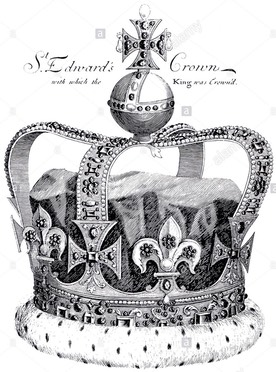
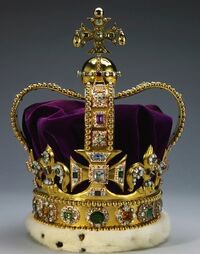
EDUCATIONAL FACT: St. Edward's Crown is the centerpiece of the Crown Jewels of the United Kingdom. Named after St. Edward the Confessor, it has been traditionally used to crown English and British monarchs at their coronations since the 13th century.
The original crown was a holy relic kept at Westminster Abbey, Edward's burial place, until it was either sold or melted down when Parliament abolished the monarchy in 1649, during the English Civil War.
The present version of St. Edward's Crown was made for Charles II in 1661, but after 1689, it was not used to crown a monarch for over 200 years. The crown has, however, been redesigned over the years. Prior to 1911, jewels were hired for the crown then removed after a coronation. In 1911 the current permanent version was introduced.
Todays St. Edward's Crown is 22-carat gold, with a circumference of 66 cm (26 in), measures 30 cm (12 in) tall, and weighs 2.23 kg (4.9 lb). It has four fleurs-de-lis and four crosses pattée, supporting two dipped arches topped by a monde and cross pattée, the arches and monde signifying an imperial crown. Its purple velvet cap is trimmed with ermine. It is set with 444 precious and semi-precious stones, including 345 rose-cut aquamarines, 37 white topazes, 27 tourmalines, 12 rubies, 7 amethysts, 6 sapphires, 2 jargoons, 1 garnet, 1 spinel and 1 carbuncle. Surprisingly, it has no diamonds. The crown is similar in weight and overall appearance to the original, but its arches are Baroque.
In 1911, the tradition of its use at coronations was revived and it has been used for three monarchs' coronations: George V, George VI and Elizabeth II.

St. Edward's Crown is worn once, by the sovereign at his or her coronation and the sovereign is one of only 3 people that may touch it. The other 2 are the Archbishop of Canterbury and the Crown Jeweler appointed by warrant issued by the sovereign.
A stylised image of this crown is used on coats of arms, badges, logos, coins, and various other insignia in the Commonwealth realms to symbolize the royal authority of Queen Elizabeth II. When not in use, St. Edward's Crown is on public display in the Jewel House at the Tower of London.
Book of the Month

Private gold coins and patterns of the United States by Donald H Kagin
The story of this hearty breed of pioneer coiner is told in these pages. Life on the frontier was an exciting experience, and Private Gold Coins and Patterns of the United States captures this excitement. The stories of the men---some of them rogues who took advantage of the chaotic situation, others, like the Mormons, strictly accounting for every grain of their gold dust--makes for fascinating reading.
Coin of the Month
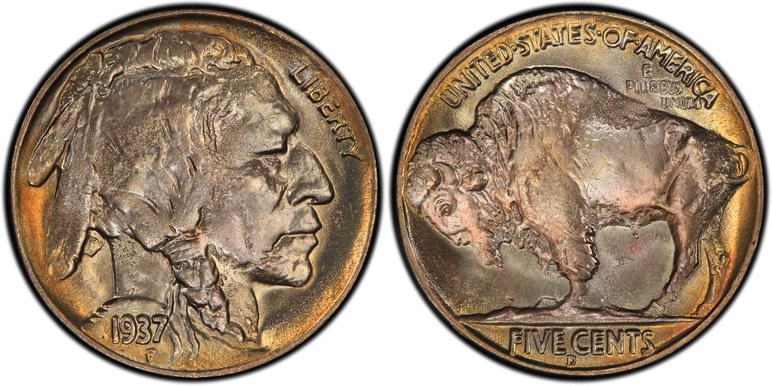
1937-D “3 Legged” The 1937-D “3 Legged” Buffalo Nickel is a unique type of error which remains very popular among collectors. The coin takes its name from the fact that the buffalo on the reverse of the coin appears to only have three legs.
The error was created when a newly hired Denver Mint employee attempted to remove clash marks from one of the reverse dies. Clash marks occur when there is no planchet in the press and the dies strike each other. His die polishing successfully removed the marks, but also inadvertently removed one of the buffalo’s legs. Note that only the leg is missing. The hoof portion mostly remained intact.The mistake was not realized until most of the coins had already reached circulation and for this reason mintage figures are unknown but the number 20,000 seems to be most experts best guess.
Since the error was originally created by a mint employee, it is also one of the most popular error coins for the unscrupulous to attempt to re-create by altering a regular 1937-D nickel. The ’37-D had a mintage of over 17,000,000 so there is no shortage of original coins to work with. Fortunately there are a few specific diagnostics for this error, plus the alteration requires removing metal from a coin that has toned which is difficult to disguise. In this case though, if you are thinking of purchasing one, stick with either certified examples or a trusted reputable dealer.
Prices range from approx. $400 in F to over $40,000 in MS65! The error was recognized early after their release so nice examples in mid grade aren’t hard to find.
Currency Note of the Month
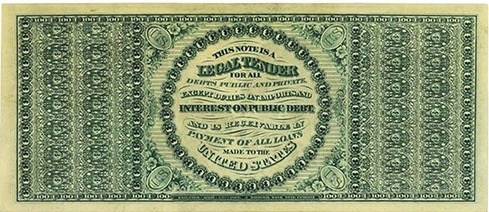

The Series 1862 $100 Legal Tender note is sometimes called the “Spread Eagle” and it's an iconic design. The large “Spread Eagle” which gives the note its nickname was the first featured use of the Bald Eagle on US currency. Engraved by Joseph P. Ourdan, the bald eagle perched on a rock with wings spread dominates the left side of the note. Green border prints frame the design which also has ornate black kaleidograph die counters at lower left and upper right and a slightly larger green kaleidograph die counter in the same style just right of center. Printed signatures of Chittenden and Spinner are along the bottom border while a red spiked Treasury Seal is near the upper right. The imprint of the National Bank Note Company is found on both the face and the back. There are less than 30 known to exist so they are very expensive in any grade. The note shown is graded PMG65EPQ and is the finest known. In March it was auctioned by Stacks/Bowers and hammered at a final asking price of $432,000!
NUMISMATIC AND HISTORICAL QUESTIONS AND FACT (MARCH)


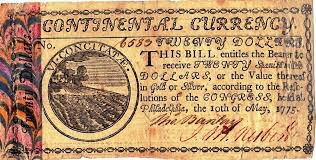
Q. At a recent coin show, a dealer had an interesting Continental currency note with what he called “marbling”. Any details?
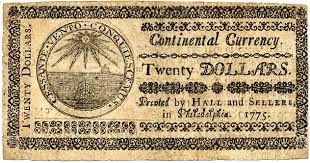
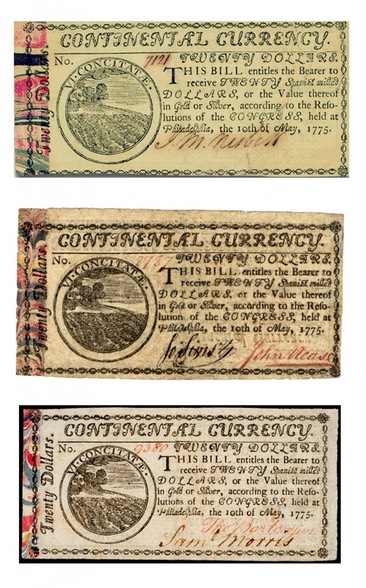
A. The note was likely a $20 Continental Currency piece. They are very collectible and one of America's most historic paper currency notes. Uniquely authorized by the May 10, 1775 Continental Congress Session, the $20 note uses marbled polychro- matic paper, which is visible at the left end. The marbled paper was obtained from France by Benjamin Franklin. He also hand sketched the emblems and was responsible for the mottos on the front and back of this piece. Hall and Sellers printed the notes. On the face, within the circular emblem, there is a personification of "Wind" ruffling the water with his strength. The motto VI CONCITATE, which means "Driven by Force" is engraved within the outer circle. The back emblem shows ships on a calm sea with a radiant sun shining above. Encircled within the emblem is the motto CESSANTE VENTO CONQUIESCEMUS, which translates to "When the storm dies down we will rest".
The special paper and designs were an attempt to counter British counterfeiting. The British were then engaged in active counterfeiting of Continental Currency with the intent of destabilizing the fledgling country. The notes are considered rare, and even notes in poor condition sell for hefty sums.
Q. I picked up an old “Popsicle” token recently. Any idea how many varieties of these tokens there are?
A. This is from the March 21st, 2018 edition of the E-sylum:
Dick Johnson writes:
Up til now researchers have not been able to document who engraved the dies for a series of Popsicle tokens issued as premiums in Popsicle packages. At least two were issued in 1933 featuring movie stars Clark Gable and Greta Garbo.
Later, in 1937, six were issued and we know for certain these were engraved by Ger- man-American engraver Franz Eue. These bore portraits of Claudette Colbert, Gary Cooper, Jean Harlow, Frederick March, Norma Shearer and Johnny Weissmueller. He misspelled Popsicle on the reverse of the Claudette Colbert medal as POPCICLE. Three of these are listed in the Red Book by Katie Jaeger and Dave Bowers, A Guide Book of U.S. Tokens and Medals, page 149.
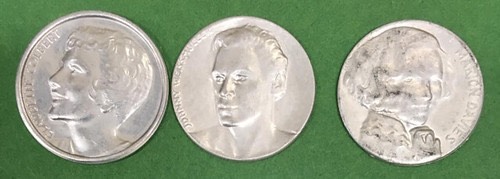
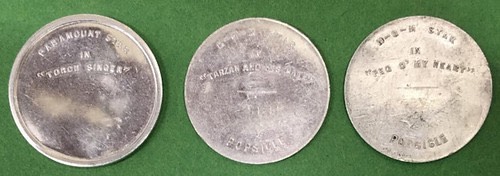
Franz F. Eue (1888-1937) was a hand engraver, medalist and sculptor. He engraved German portrait medals in 3 and 5 -mark size (gedenthalers) for at least four German medal firms prior to his immigration to America in 1926. It is said he could engrave a die in two hour's time, either carving intaglio or cameo. He engraved a number of dies for the Medallic Art Company. A contemporary of his told me once he loved to drive old cars until he wrecked and then abandoned them.
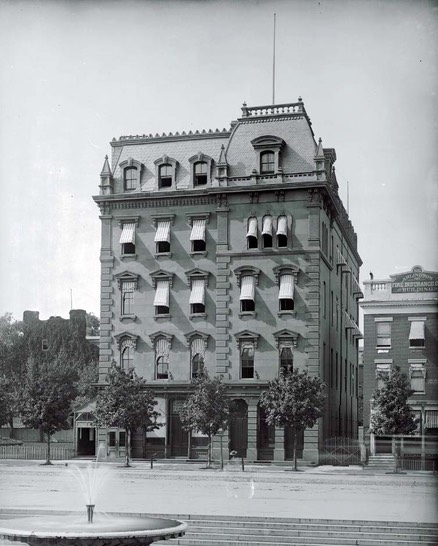
EDUCATIONAL FACT: The Freedman’s Bank was incorporated as The Freedman’s Savings and Trust Company by Act of Congress on March 3, 1865. President Lincoln signed it on the final day of his first term, along with a stack of other bills passed by the previous lame-duck session of Congress. Knowing that the days of the Civil War were numbered, preparations had begun for the reconstruction that would follow.
The Freedman’s Bank was the brainchild of private philanthropists from the Northern abolitionist community who sought to give those formerly enslaved, soldiers in particular, a safe place to deposit their wages and develop savings habits. The idea was hatched that U.S. Government backing, even a bank charter, would help the institution serve its functions better than a solely private bank ever could. Charles Sumner, the abolitionist leader from Massachusetts, introduced the bill on March 2, 1865. It passed as an afterthought, and Lincoln signed it into law the next day.
Deposits were received only “by or on behalf of persons heretofore held in slavery in the United States, or their descendants.” Up to 7% interest was allowed for de- posits, and any unclaimed accounts were to be pooleinto a charitable fund that was used to educate the children of ex-slaves.

In 1868 the bank headquarters was moved to Washington, District of Columbia (D.C.), where black staffers were trained to take over its operations. At its
peak, the bank operated 37 branches in seventeen states and the District of Columbia making it one of the first multi-state banks in the nation. By 1870 nearly all the local branches were run by African Americans.
By 1874, massive fraud among upper management and among the board of directors had taken its toll on the bank. Moreover, economic instability brought upon by the Panic of 1873 coupled with the bank’s rapid expansion proved disastrous. Hoping to revive the bank, Frederick Douglass, who was elected bank president in 1874, donated tens of thousands of dollars of his own money to shore up the declining institution.
Although Douglass pleaded for Congress to intervene, on June 29, 1874, the bank was officially closed. At the date of closing $2,993,790.68 was due to 61,144 depositors. By the summer of 1875, the commissioners had recovered just $300,000, about half what they needed to pay a 20% dividend to depositors. It took until November 1875 for the first repayment to depositors to be made. The number of open accounts at that point was over 61,000. About 5000 of them were owed less than $1. On November 1, 1875, the United States Treasury began issuing checks to depositors of 20% of their accounts’ value. This p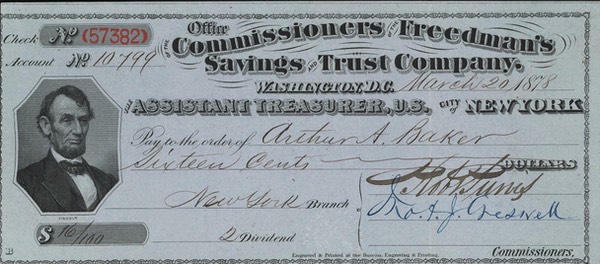 rocess produced the only numismatic collectible of the Freedman’s Bank. Engraved and printed by the Bureau of Engraving and Printing on pale green paper, with the left margin dominated by a bold portrait of Lincoln in an octagonal frame, the checks were emblazoned with the title Office of the Commissioners of the Freeman’s Savings and Trust Company, Washington D.C. Note that the check shown was for 16 cents, hardly worth cashing!
rocess produced the only numismatic collectible of the Freedman’s Bank. Engraved and printed by the Bureau of Engraving and Printing on pale green paper, with the left margin dominated by a bold portrait of Lincoln in an octagonal frame, the checks were emblazoned with the title Office of the Commissioners of the Freeman’s Savings and Trust Company, Washington D.C. Note that the check shown was for 16 cents, hardly worth cashing!
Website of the Month
www.ngccoin.com/resources/counterfeit-detection
This months chosen website is actually just one section of the NGC website, although a very useful and informative one. The site helps collectors and dealers identify coun- terfeits, and NGC has prepared lists of the most commonly counterfeited coins with diagnostic information and images from NGC’s extensive database, as well as commentary from the NGC grading team. It also identifies counterfeit types and provides a comprehensive understanding of the different methods used to make forgeries or alterations to help a numismatist identify these counterfeits. If you have doubts about a coin you are considering purchasing, or are interested in counterfeit detection, this is the site for you.
Coin of the Month
Wirtland is an internet-based sovereign state, an experiment into legitimacy and self-sustainability, of a country without its own soil. Wirtland was founded on August 14, 2008 as a public initiative. Its population is currently approximately 700 citizens from all five continents and citizenship is open to all applicants. It is represented through its official website (Wirtland.com), its social network, and “The Times of Wirtland”.
The Wirtland Crane is a new gold coin issued in July 2009 by Wirtland and is considered to be the world’s first gold coin produced by an internet-based (virtual) country.
The 1/10 oz. coins are minted in 24 carat gold, in cooperation with coin designer Daniel Carr and his company “Moonlight Mint”. Daniel Carr is creator of “Amero” coin, and designer of the New York and Rhode Island 2001 statehood quarters. Wirtland is not seeking to introduce a new internationally recognized currency. “Wirtland Crane” coins formally have status similar to that of commemorative or collectors’ coins and medals. Its competitive price allows the Wirtland Crane to also be used as an investment tool. Wirtland Cranes can be purchased online directly from the mint's online store. The total mintage of the Wirtland Crane will be limited, and the price will be reflecting the current price of gold.
Currency Note of the Month
I also picked an unusual (?) note to go with the odd coin this month. The Global Country of World Peace (GCWP) was inaugurated by Maharishi Mahesh Yogi, the founder of Transcendental Meditation, on October 7, 2000. It is a non-profit organization that claims to promote Transcendental Meditation, education, and the construction of "buildings for peace" in the world's major cities. The GCWP was originally conceived as "a country without borders for peace-loving people everywhere." It has issued a currency called the "Raam," and its leader is neurologist Tony Nader.
The Raam is a bearer bond (3% interest after five years) and local currency issued by the GCWP. As of 2003, it had limited acceptance in some European and U.S. cities. The currency has been used in Iowa and has been also given approval in The Netherlands where more than 100 Dutch shops and department store chains, in 30 villages and cities, are using the notes.
The Raam is issued in denominations of 1, 5 and 10 Raams, with one Raam equal to 10 Euros in Europe, or 10 dollars in the U.S. In 2002, Maharishi Vedic City Mayor Bob Wynne estimated that there was $40,000 worth of Raam in circulation.
NUMISMATIC AND HISTORICAL QUESTIONS AND FACT (FEBRUARY)


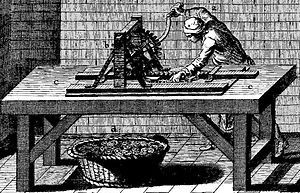
Q. What is a castaing machine?
A. A 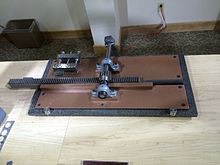 Castaing machine is an early device used to add lettering and decoration to the
edge of a coin. A Castaing machine marks the edges by means of two steel rulers,
which, when a coinage blank was forced between
Castaing machine is an early device used to add lettering and decoration to the
edge of a coin. A Castaing machine marks the edges by means of two steel rulers,
which, when a coinage blank was forced between
them, imprinted legends or designs on its edge.-
Such lettering was necessitated by counterfeiting
and edge clipping, which was a common problem
resulting from the uneven and irregular hammered
coinage. Production of hammered coinage ceased
in France in 1645, but at some point prior to 1679,
Jean Castaing, a French engineer, invented a ma-
chine to apply edge lettering to coins. In 1685, he approached the French government with a propos-
al to use his machine in that nation's mints and in
1686, the French Council of State entered a contract with Castaing wherein all of the nation's goldand silver coinage would include edge lettering
created by his machine.
In 1688, Castaing’s edge machine was used as he supervised a re-minting of previously issued coins, however, he was later imprisoned on charges of using inaccurate scales to weigh the re-minted coins.There is evidence that the charges were false, invented by opponents who lost money as a result of his machine's introduction to the French Mint andthe resulting monetary reforms.
Q. I recently picked up a couple of scalloped edged coins and was wondering how
many countries have issued these types of coins?
A. Scalloped edge coins are not as uncommon as you would think. At least 38 countries have issued scalloped edge coins. The name comes from the distinctive wavy shell of the scallop, a sea mollusk similar to a clam. This coin shape may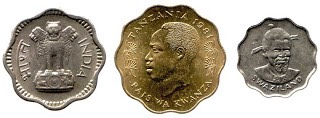 also be referred to as wavy-edged, flower shaped, or sun shaped. There are also different types with variations in
the number peaks or points, with 8, 10, and 12 peaks be-
ing most common. There is also 2 different alignments of
the peaks with either a peak at the top of the coin or a
trough between the peaks at the top.
also be referred to as wavy-edged, flower shaped, or sun shaped. There are also different types with variations in
the number peaks or points, with 8, 10, and 12 peaks be-
ing most common. There is also 2 different alignments of
the peaks with either a peak at the top of the coin or a
trough between the peaks at the top.
 The main reason behind using a scalloped edge on acoin is to make it more easily distinguishable from othercoins since you can easily feel the wavy edge and tell which coin is which. This is also helpful for people who have trouble seeing, and is one of a great many ways that countries have tried to make their coins identifiable by touch alone.
The main reason behind using a scalloped edge on acoin is to make it more easily distinguishable from othercoins since you can easily feel the wavy edge and tell which coin is which. This is also helpful for people who have trouble seeing, and is one of a great many ways that countries have tried to make their coins identifiable by touch alone.
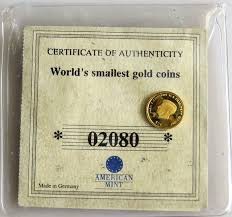
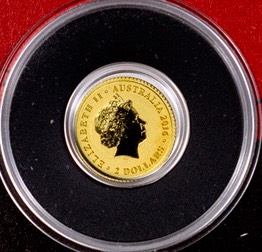
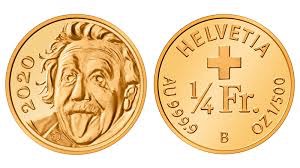
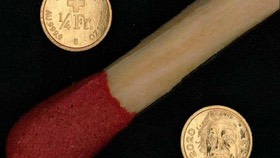

EDUCATIONAL FACT: The title of smallest gold coin has been a
subject of competition in the last few years. It was held by the Republic of Liberia for a number of years. The country issued 7 types
of its $25 (face value) gold coin. The coins, struck in Germany, contain 0.73 grams or .0234 oz. of .999 pure gold (approx. $37 at the
current gold value) and had been recognized for some time as the
smallest legitimate issue gold coin. Each type was produced in a
limited mintage of 20,000.
Then in 2005, the Perth Mint in Australia decided to start issuing an
annual 0.5 gram gold coin which took the record from Liberia.
However, the Swiss Mint has recently released an even smaller gold
coin. The coin is a machine-minted gold coin with a diam-eter of 2.96 millimeters (.12 in.) and a weight of only0.063 grams (1/500 ounce). The smallest gold coin shows
the famous picture of Albert Einstein sticking his tongue out, supplemented with the year 2020. On the other side is the nominal value of a 1⁄4 Franc (0.26 cents), together with “Helvetia” and the Swiss cross.
In addition, the gold alloy “AU 999.9” and the weight of 1/500 ounces are inscribed. Because both sides of the coin
cannot be seen by the naked eye, the Swiss Mint has had
special packaging developed that includes magnifying lenses
and a light source. The smallest gold coin can therefore be
well-viewed and kept safe at the same time. There is a
mintage limit of only 999 pieces and it has an issue price of
199 Francs ($204).
Book of the Month
Chasing Gold: The Incredible Story of How the Nazis Stole Europe's Bullion by George Taber

For the entire history of human civilization, gold has enraptured people around the globe. The Nazis was no less enthralled by it, and felt that gold was the solution to funding Hitler's war machine. Gold was also on the mind of FDR across the Atlantic, as he worked with Europe's other leaders to bring the United States and the rest of the world out of a severe depression. FDR was hardly the first head of state to turn to gold in difficult times. Throughout history, it has been the refuge of both nations and people in trouble, working at times when nothing else does. Desperate people can buy a loaf of bread or bribe a border guard. Gold can get desperate nations oil to keep tanks running or munitions to fight a war. If the price is right, there is always someone somewhere willing to buy or sell gold. And it was to become the Nazi's most important medium of exchange during the war.
Chasing Gold is the story of how the Nazis attempted to grab Europe’s gold to finance history’s bloodiest war. It is filled with high drama and close escapes, laying bare the palate of human emotions. Walking through the tale are giants of world history, as well as ordinary people called upon to undertake heroic action in an extraordinary time.
Coin of the Month
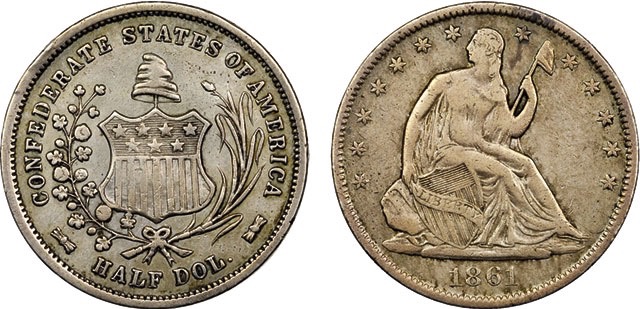
This is an example of one of the 4 known Confederate half dollars. In late April 1861, four Confederate half dollars were struck on a hand press by certain employees of the New Orleans Mint. Because of the high relief of the coin die, a test striking was made to see if coins would release from the Confederate die. The die was made by a printing plate engraver (A.H.M. Peterson) in New Orleans who was unfamiliar with techniques required to engrave coining dies. These coins were struck using a U.S. obverse die (Seated Liberty) and the Confederate die made by Peterson. These coins are known as originals, and the location of all four of the coins is known today.
As the result of an 1879 article about the Confederate cent printed in a New York City newspaper, Benjamin F. Taylor, M.D. who had been Chief Coiner of the New Orleans Mint CSA, contacted coin dealer Ebenezer Mason. Taylor informed Mason of the exis- tence of the Confederate half dollar and the original die. Mason bought the die and coin from Taylor and sold them to J.W. Scott Co. of New York City, a coin and stamp dealer. Scott bought 500 1861 United States half dollars from a New York bank that were supposedly struck at the New Orleans Mint. Scott had the reverse of the half dollars planed down and performed a one-sided strike using the Confederate half dollar die. The Seated Liberty obverse of the coins were flattened some because of the one-sided strike. In addition, Scott struck 500 half dollar sized tokens in white metal using the Confederate die and a newly made die to commemorate the restrikes of the Con- federate half dollars. The Confederate half dollar die went missing during the 1920s and has not been seen since.
Currency Note of the Month
This month, to match the Confederate half dollar above, I picked an exceptionally detailed Confederate State note from North Carolina. Individual Confederate States issued paper money as well as the Confederacy. North Carolina was prolific issuer of a number of type notes, although this particular note is a single type note with only 2 known varieties. The variety missing the red “FIVE” overprint is considered a rare note. The Port of Wilmington NC is depicted in the center with 4 ships, an allegory of “Liberty” at left, and a portrait of D.W.Courts at right. Courts was the State Treasurer. North Carolina led the South in blockade running, and it was largely through the supplies brought in through Wilmington that the South remained afield for as long as they did. Wilmington was also the last important port to fall in February 1865. Values for this note run from $40 in VG to $170 in UNC.
NUMISMATIC AND HISTORICAL QUESTIONS AND FACT (JANUARY)


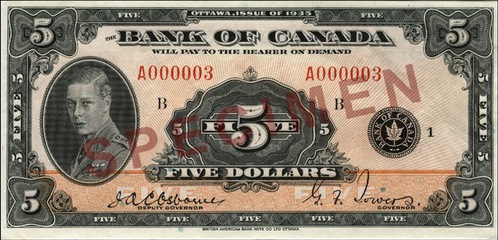
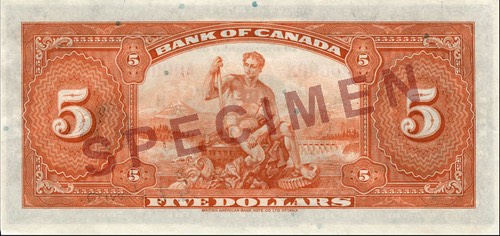
Q. I was told that Canada once issued dual language
currency notes. Any information?
A. The 1935 Canadian banknote series is the first series of banknotes of the
Canadian dollar issued by the
Bank of Canada. They were first circulated on 11 March
1935, the same day that the Bank of Canada officially
started operating. Two sets of banknotes were printed
for each denomination, one in French for Quebec, and
one in English for the rest of Canada. This is the only
series issued by the Bank of Canada with dual unilingual banknotes.
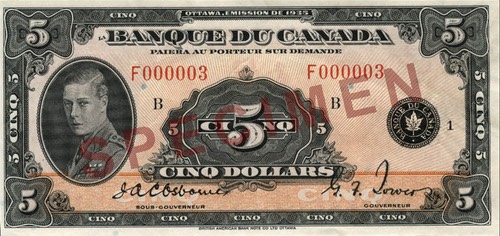
They were issued in 10 denominations, $1 to $1000,
(the $25 note was issued as commemorative), each in
a different color or shade. The portraits are mostly
British Royalty, with the exceptions being the $500 and
the $1,000 notes each featuring a Canadian Prime Minister. 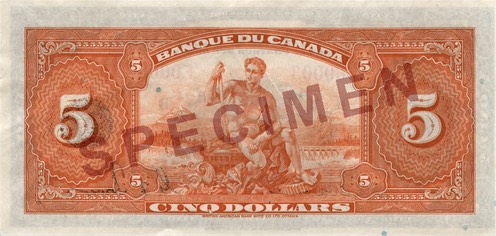 Each denomination has a reverse depicting an allegorical figure, the framing of which is different for
each denomination. The notes were replaced by the
1937 issue which featured bilingual (dual) language
eliminating the need for separate issues.
Each denomination has a reverse depicting an allegorical figure, the framing of which is different for
each denomination. The notes were replaced by the
1937 issue which featured bilingual (dual) language
eliminating the need for separate issues.
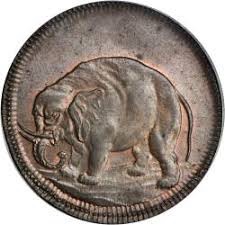
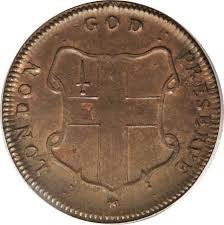
Q. What is an “Elephant token”?
A. The 1694 Elephant tokens are a bit of a mystery. All Elephant tokens have an obverse depicting a large tusked elephant. There are 3 main types with 7 varieties among them
differentiated by the reverses.
It has been conjectured they were first minted soon after the
great London fire of 1666 because the motto on the London
type (4 varieties) reverse reads, “GOD PRESERVE LONDON” and surrounds a shield design. However, there is no
evidence to substantiate this claim. More likely the motto is
simply a general petition for divine grace.
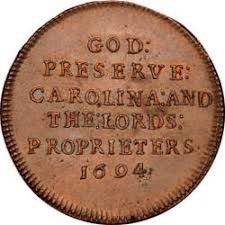
The second type has the motto “GOD PRESERVE CAROLINA AND
THE LORDS PROPRIETERS 1694 (sic)” and there are 2 varieties of
this type.
The third type has the motto, “GOD PRESERVE NEW ENGLAND 1694”. Only 3 examples are known.
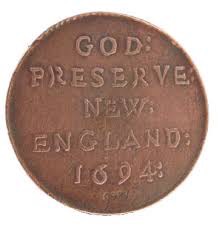
The Elephant tokens were designed at the Tower mint in London for use in England, with the Carolina and New England tokens evidently serving as promotional pieces to increase interest in the colonies. It appears the tokens were neither made for nor intended for circulation in the American colonies. Indeed, the exact use of these pieces is unknown. They may not have been used as coins at all because of the great weight differentials between thick and thin planchets; some are over 200 grains, far in excess of the 152 grain halfpenny, while others much below the standard at 110 grains or less. Some numismatists have suggested that they may have served as lottery tickets.
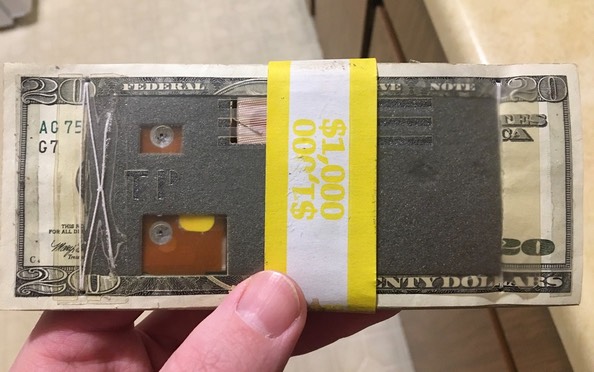
EDUCATIONAL FACT: An explosive dye pack is a radio-controlled incendiary device used by banks to foil a bank robbery by causing stolen cash, and the robber, to be permanently marked with dye shortly after a robbery. They were invented in Georgia in 1965.
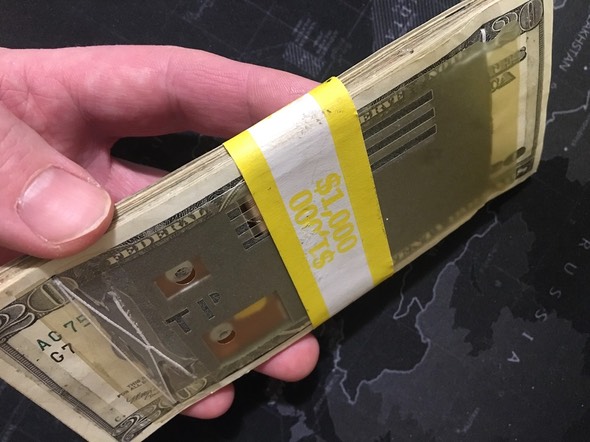

The biggest dye pack manufacturer is I.C.I. Americas, based in Valley Forge, Pa. I.C.I Americas controls 80 percent of the world market for exploding packs. In most cases, a dye pack is placed in a hollowed-out space within a stack of banknotes, usually $10 or $20 bills. This stack of bills looks and feels similar to a real one, with new technology allowing for the manufacturing of flexible dye packs which are difficult to detect by handling the stack. When the marked stack of bills is not used, it is stored next to a magnetic plate near a bank cashier, in standby or safe mode, ready to be handed over to a bank robber by a bank employee. When it is removed from the magnetic plate, the pack is armed, and once it leaves the building and passes through the door frame, a radio transmitter located at the door triggers a timer (typically at least 10 seconds), after which the dye pack explosively releases a marking aerosol, and sometimes tear gas, intended to destroy the stolen money and mark the robber's body with a bright stain and repelling scent. The chemical reaction causing the explosion of the pack and the release of the dye also creates high temperatures of about 200 °C (392 °F) which further discourages a criminal from touching the pack or removing it from the bag or getaway vehicle. Some newer packs also have GPS trackers. Dye packs are used as a deterrent to robberies in over 75% of banks in the U.S. They have been used to prevent thousands of robberies in the past 20 years. I.C.I. Americus claims to have been directly responsible for apprehending 2,400 bank robbers.
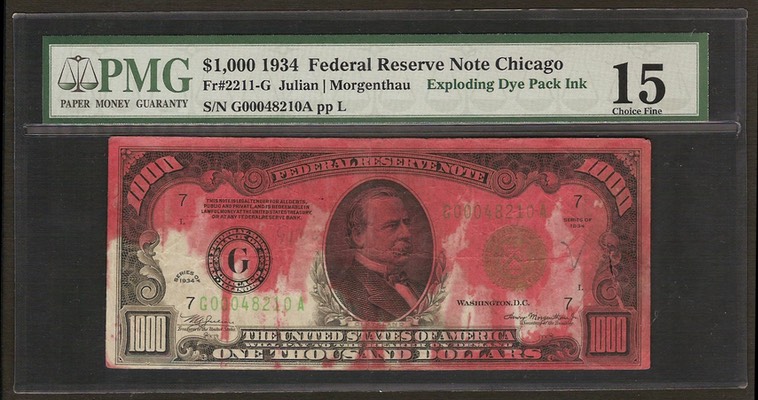
Surprisingly, disarmed dye packs can occasionally be found for sale, although they can be expensive since they are made from cut out currency. Some of the photos used are from a member of the “Coin Community Forum” who has purchased one. For those of you wishing a laugh, Google “exploding dye pack” and there are numerous YouTube videos of dye packs in action! :)
Currency Note of the Month
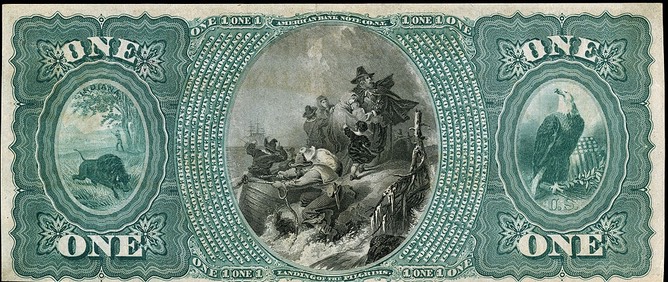
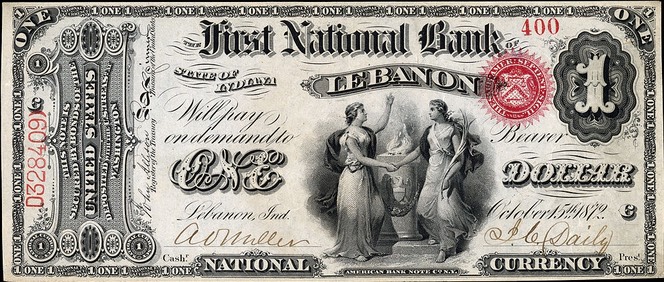
This months note is the first National note that I have written about in the newsletter. Large size Nationals were issued in 3 Charters from 1863 to 1929 when the switch was made to small size notes for economy. Qualifying banks were issued charter numbers by the Federal Government and allowed to issue banknotes provided by the Bureau of Engraving and Printing (BEP) based upon the amount of U.S. government bonds purchased by the bank as security under the First Charter.
This is a 1st Charter “Original” series $1 note issued by the First National Bank of Lebanon, IN. National notes were designed so that each Charter banks name and the State Coat of Arms could be added to the basic note with the main design remaining essentially the same.
The front of this “Original” $1 note features a red Treasury serial#, the bank name, 2 signature blocks, and a Security legend on the left. Since it is an Original issue, the charter number does not appear on the note. That occurred later with the 1875 series issue. The vignette is titled “Concordia” and show 2 maidens standing before an alter, designed by T.A. Leibler and engraved by Charles Burt.
The reverse shows the state Coat of Arms left, a U.S. Coat of Arms on the right, and the center vignette, titled “Landing of the Pilgrims”, designer unknown, but engraved by Charles Burt. This note was printed by the American Banknote Company, one of three printing companies used for the printing of National banknotes until 1877.
Coin of the Month
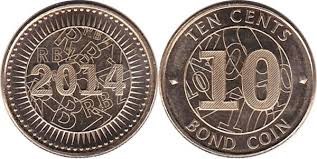
Zimbabwe Bond Coin The Reserve Bank of Zimbabwe began to release Zimbabwean bond coins on 18 December 2014. The coins are supported by a US$50 million surety extended to the Reserve Bank of Zimbabwe by Afreximbank (the African Export–Import Bank). To date coins worth US$15 million have been struck out of the total $50 million available. The coins were first issued in denominations of 1, 5, 10, and 25 cents and are pegged to the corresponding values in U.S. dollars. A 50 cents bond coin was re-leased in March 2015.
The coins are being issued to remedy a lack of small change resulting from the ab- sence of a solid seigniorage contract with the U.S., South Africa or any of several other countries whose currencies, including the U.S. dollar and the Euro, are being used in the multi-currency system that arose in 2009, when Zimbabwe abandoned the Zimbabwean dollar in response to several cycles of hyperinflation. The Zimbabwean economy being too frail and small to pay the interest which would come with a seigniorage contract, the country chose instead to implement a multi-currency environment based on the U.S. dollar. However, this arrangement has meant a shortage of small change in coins. Public reaction to the bond coins has been extremely skeptical, with widespread fear that they are the government's first step to reintroducing an unreliable Zimbabwean dollar. The bond coins, struck at the South African Mint in Pretoria, are the first Zimbabwean coins since 2003.
Website of the Month
Collectible Stocks and Bonds from North Ameri-
can Railroads by Terry Cox A guidebook and catalog of prices
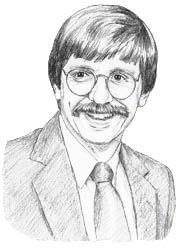
(http://www.coxrail.com/index.asp)
My primary purpose in building this website is to make a community where you and I can share information about RAILROAD STOCKS AND BONDS.
The collecting of North American railroad stocks and bonds is very popular in the United
States, Canada, Germany, and Great Britain. Nonetheless, by comparison to the stamp
and coin hobbies, we are spread very thin indeed.
We need someplace where we can communicate on an on-going basis. Here on the web,
we have a perfect place; distances do not exist.
NUMISMATIC AND HISTORICAL QUESTIONS AND FACT (December)


Q. I have heard of baking a silver sixpence into a Christmas pudding as luck for the finder, but can there be other things baked in as well?
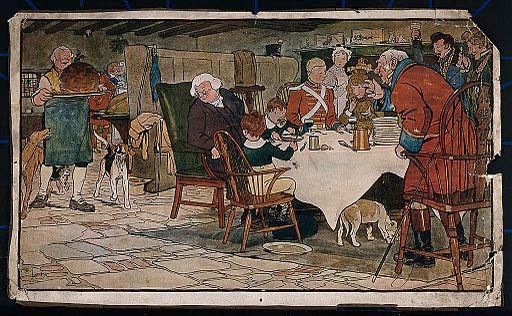

A. Not only things, but also the pudding. According to old tradition, there should be 13 ingredients in a Christmas pudding: raisins, currants, suet, brown sugar, bread crumbs, citron, lemon peel, orange peel, flour, mixed spices, eggs, milk, and brandy. The 13 ingredients represents Jesus and his Disciples. Also, the pudding should be stirred with a wooden spoon by each family member from east to west in honor of the Wise Men. As a lucky favor, traditionally, a silver sixpence was used, but the closest coin to that nowadays is a five pence piece. For foretelling the future, a number of items, also known as tokens or favors, can be placed in a Christmas pudding. They include: a Bachelor’s Button – if found by a single man, he will be single for the next year, an Old Maid’s Thimble – if found by a single woman, she will be single for the next year, a ring – the finder will get married or become rich in the next year, a wishbone – the finder will have good luck, and an anchor charm – the finder will have a safe year, with the charm protecting them from danger.
Q. How much could a Pony Express rider carry? And what did it cost?
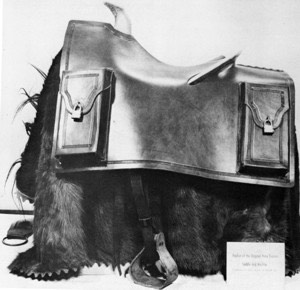
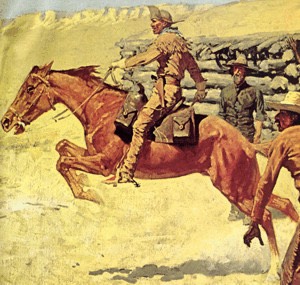
A. A Pony express rider could carry up to 20 pounds using a special bag called a mochilla. It had 4 locked pockets and was fitted over the saddle and held on by the riders weight. 3 pockets were used for mail and the fourth for the riders timecard. When a rider reached a relief station he just took the mochilla off the saddle and put it on the next, enabling him to change horses in under 2 minutes. The Pony Express didn’t come cheap. In its early days the service cost $5 for every half-ounce of mail—the equivalent of some $130 today. Prices were later reduced to just $1, but they still remained too high for everyday mail. Instead, the service was mainly used to deliver newspaper reports, government dispatches and business documents, most of which were printed on tissue-thin paper to keep costs (and weight) down. The company lasted for 19 months until Western Union completed the transcontinental telegraph line at Salt Lake City. The Pony Express ceased operations 2 days later but in that amount of time had delivered 35,000 pieces of mail.

EDUCATIONAL FACT: The Yule goat is a Scandinavian and Northern European Yule and Christmas symbol and tradition. Its origin may be Germanic pagan and has existed in many variants during Scandinavian history. Modern representations of the Yule goat are typically made of straw.

The peculiar story about the Gävle Goat started in 1966, when someone came up with the idea to design a giant version of the traditional Swedish Christmas straw goat. The objective was to attract customers to the shops and restaurants in the southern part of the city. On the first Sunday of Advent 1966, the huge goat was placed at the Castle Square. Since then, the Gävle Goat has been a Christmas symbol placed in the same spot every year. Today he is world famous. The goat is the world’s largest straw goat and made it into the Guinness Book of Records for the first time in 1985.

However, the display has become notable for being a recurring target for vandalism by arson, and has been destroyed many times since the first goat was erected in 1966. Because the fire station is close to the location of the goat, most of the time the fire can be extinguished before the wooden skeleton is severely damaged. If the goat is burned down before December 13th, the feast day of Saint Lucia, the goat is rebuilt. The skeleton is then treated and repaired, and the goat reconstructed over it, using straw which the Goat Committee has pre-ordered. Since 1966, the goat has been destroyed by arson fire 30 times, destroyed by vandals 7 times, and in 1976 was hit by a car!
In 2001, the goat was burned down by a 51-year-old visitor from Cleveland, Ohio who spent 18 days in jail and was subsequently convicted and ordered to pay 100,000 Swedish kronor in damages. In 2005 it was burnt by unknown vandals reportedly dressed as Santa and the Gingerbread Man, by shooting a flaming arrow at the goat. It has been pushed into the nearby river, and also been stolen by truck!

Security measures include security guards (with various bribery attempts), video monitoring (hacked on more than one occasion), spraying the goat with water so it freezes, fire retardant, and placing a taxi stand nearby to increase pedestrian observation. The goat has survived the last 3 years with double fencing, 24/7 live webcam, and 2 armed police guards with a K9 unit! This years goat was inaugurated on Dec. 2 and is currently still intact.
Currency Note of the Month
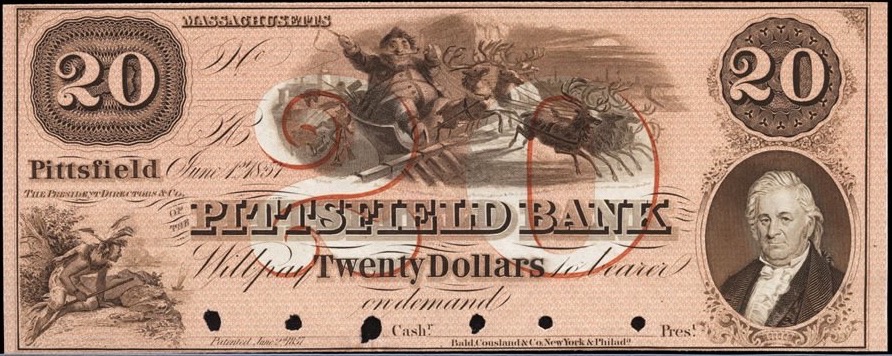
$20 Pittsfield Bank (Massachusetts) This is one of the few obsolete banknotes which actually has an image of Santa Claus on the note. I have discovered a total of 4 (so far!) so I will save the fourth for next year. This particular banknote is an unissued proof printed by the American Banknote Co. and since I have not seen an issued note it is possible this particular note was never issued by the bank. This $20 bill features Santa Claus wearing a tricorne hat and riding his sled along a roof, led by a herd of reindeer. it carries a printed date of June 1st, 1857 and also has Indian vignette in the lower left corner. The portrait identity is unknown and the reverse is blank.
Coin of the Month

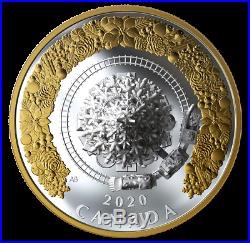
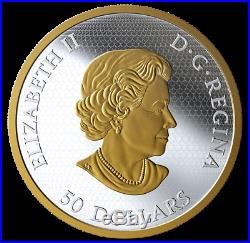
Canadian Christmas Coin (2020). While this Canadian coin is obviously a non-circulating issue, it is certainly an interesting coin! 65mm in diameter, this large format 5 oz. silver coin features a sterling silver Christmas tree, complete with presents. It also features a sterling silver train on a track that actually travels around the base of the tree as the coin is tilted! It has selective gold plating on the wreath and on the portrait of Queen Elizabeth II on the reverse. The coin carries a denomination of $50 and had a limited mintage of 1,000 pieces which sold out quickly, so it is only available on the secondary market. As of this writing, prices average $6-700 US.
Book of the Month
National Geographic Kids Everything Money: A wealth of facts, photos, and fun! by Kathy Furgang
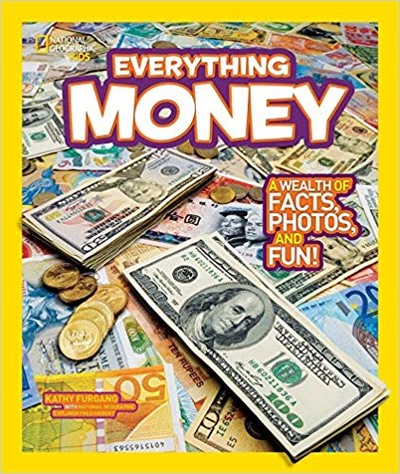
Christmas time seems like a good time to feature a children’s book and this one appears to be very good! All you need to know about money can be found in the pages of this colorful, energetic, and accessible book. Kids will also learn about money around the world from a National Geographic expert, featured in "Explorer's Corners" throughout the book. Packed with fun facts and amazing photographs, this book gives kids an in-depth look at this fascinating and important topic. It also includes a specific section about coin collecting. National Geographic supports K-12 educators with ELA Common Core Resources.
NUMISMATIC AND HISTORICAL QUESTIONS AND FACT (November)
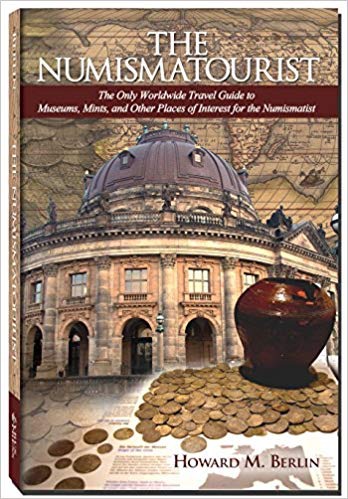
The Numismatourist: The Only Worldwide Travel Guide to Museums, Mints, and Other Places of Interest for the Numismatist by Dr. Howard M. Berlin
The Numismatourist is the first book of its kind as a worldwide travel guide for the numismatist. It is also for the numismatist who is traveling, either on vacation or business, and wishes to visit those places that are of interest to the hobby or profession. Inside you will find a numismatic travel guide, listing over 175 places in 75 countries open to the public, with almost 100 of these de- scribed in detail with pictures that are spread over North, Central, and South America, the Caribbean, Europe, Asia, the Middle East, Africa, and Oceania-Pacific. The book's foreword is written by Karen M. Lee, Curator, National Numismatic Collection, National Museum of American History at the Smithsonian Institution.


Q. I was looking at a couple of banknotes and the dealer described them as having nice “lathe” work? What did he mean?
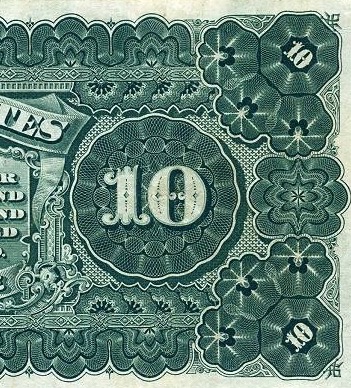
A. Lathe work is the fine line patterns on currency used to deter counterfeiting. The patterns themselves are technically called “guilloché” patterns. They have been in use on currency since before the Civil War, although with much less definition. A guilloché machine is a geometric lathe which is very similar in function to the spirograph toys we played with as kids. In technical terms, the pattern used in this in- stance is called a spirograph in mathematics, that is, a hypotrochoid generated by a fixed point on a circle rolling inside a fixed circle.
In 1877, all US currency design was handed over to the Bureau of Printing and Engraving. The guilloch machine they used, which they called a geometric lathe, is rumored to have a ten wheel system. The lines printed on this notes were made by this lathe. The machine had various settings for each wheel. The pattern generated for US currency used a series of wheel settings known only to the Sculptural Engineer that operated the lathe. For many years, that lathe was the source of all the lathe and cycloid work on US paper currency.
Today, US banknotes production is computer-assisted. Many of the design "parts"of the redesigned Series 1996 currency (the series of currency where the portraits were enlarged and moved off center) came from the lathe images in the Bureau files, assembled together on a computer. The lathe itself is in semi-re- tirement.

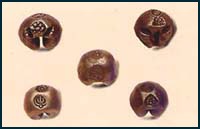
Q. A primitive money dealer recently showed me some “bullet money”? Any details as to what it is
A. “Bullet Money” or "Pod Duang Money" is an ancient Thai money that was made from bars of silver bent or folded and hammered into shape and then stamped with the mark of the ruler. Pod Duang was made from a piece of a small silver ingot with weights varying considerably according to size. This type of money was unique, using silver manually formed into elliptical bars with both ends pressed inwards and hammered into shape resembling a Duang or a worm called "Ngoen Klom" or "Ngoen Pod Duang" or "Bullet Money”. Their value is dependent on size, ranging from 1/128 of a baht to 80 baht in silver and from 1/32 to 4 baht in gold.
It was produced over 4 different periods from the 13th century to approx. 1860. Around that time, while King Mongkut (King Rama IV) was ruler, the country was opened for commerce and trade with the west. Foreign trade and commerce expanded rapidly, and the currency supply did not meet the demand of foreign merchants. So King Mongkut ordered flat coins to be minted with modern machines, thereby establishing the Royal Mint or Rong Kasap Sitthikarn in 1860 A.D. While most pieces are not particularly valuable, this piece, made in 1880, commemorates the death of the mother of Rama V (1853-1910), known as the Royal Buddha, who was considered one of the greatest kings of Siam. This ceremonial piece of 20 Baht denomination recently sold for $22,000!
A.D. While most pieces are not particularly valuable, this piece, made in 1880, commemorates the death of the mother of Rama V (1853-1910), known as the Royal Buddha, who was considered one of the greatest kings of Siam. This ceremonial piece of 20 Baht denomination recently sold for $22,000!
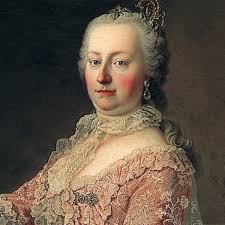
EDUCATIONAL FACT: The Maria Theresa Thaler is a world known silver bullion coin and a type of Conventionsthaler that has been used in world trade continuously since it was first minted in 1741. It is named after Empress Maria Theresa, who ruled Austria, Hungary, and Bohemia from 1740 to 1780 and she is depicted on the coin.

Since the death of Maria Theresa in 1780, the
coin has always been dated 1780. On 19 Sep-
tember 1857, Emperor Francis Joseph of Austria declared the Maria Theresa thaler to be an official trade coinage. A little over a year later, on 31 October 1858, it lost its status as currency in Austria.
The MTT could also be found throughout the Arab world, especially in Saudi Arabia, Yemen, Muscat and Oman, in Africa, especially in Ethiopia, and in India. During the Japanese occupation of Indonesia in World War II, enough people preferred it to the money issued by the occupying forces that the American Office of Strategic Services creat-
ed counterfeit MTTs for use by resistance forces. In German-speaking countries, following a spelling reform dated 1901 that took effect two years later, "Thaler" is written
"Taler" (the spelling of given names like "Theresia"was not affected).
The MTT quickly became a standard trade coin and several nations began striking Maria Theresa thalers. The following mints have struck MTTs: Birmingham, Bombay, Brussels, London, Paris, Rome and Utrecht, in addition to the Habsburg mints in Günzburg, Hall, Karlsburg, Kremnica, Milan, Prague, and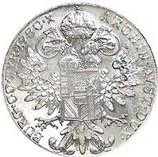 Vienna. Between 1751 and 2000, some 389 million were minted. These various mints distinguished their issues by slight differences in the design, with some of these evolving over time. In 1935 Mussolini gained a 25-year concession over production of the MTT. The Italians blocked non-Italian banks and bullion traders from obtaining the coin and so France, Belgium, and the UK started producing the coin so as to support their economic interests in the Red Sea, Persian Gulf and East Coast of Africa. In 1961 the 25-year concession ended and Austria made diplomatic approaches to the relevant governments requesting they cease production of the coin. The UK was the last government to formally agree to the request in February 1962.
Vienna. Between 1751 and 2000, some 389 million were minted. These various mints distinguished their issues by slight differences in the design, with some of these evolving over time. In 1935 Mussolini gained a 25-year concession over production of the MTT. The Italians blocked non-Italian banks and bullion traders from obtaining the coin and so France, Belgium, and the UK started producing the coin so as to support their economic interests in the Red Sea, Persian Gulf and East Coast of Africa. In 1961 the 25-year concession ended and Austria made diplomatic approaches to the relevant governments requesting they cease production of the coin. The UK was the last government to formally agree to the request in February 1962.
The coin remains popular in North Africa and the Middle East to this day in its original form: a silver coin with a portrait of the buxom empress on the front and the Habsburg Double Eagle on the back. The MTT continues to be produced by the Austrian Mint, and is available in both proof and uncirculated conditions.
Currency Note of the Month
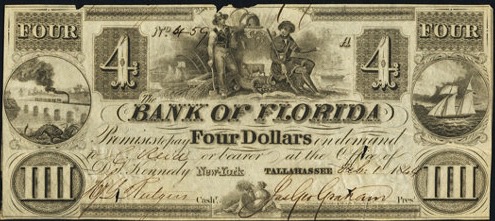
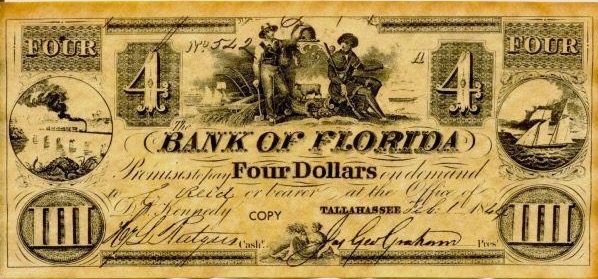
Since I am also featuring a $4 coin this month I thought I would also display an unusual $4 obsolete banknote to go with it. This is a popular Tallahasee, Florida $4 type note which was payable at the "office of D.S. Kennedy New-York." A well designed note, this was printed by Rawdon, Wright & Hatch and dated Feb.1, 1844. Oddly at the top center is the seal of Delaware Arms, used for convenience by the engravers who likely did not have a Florida seal at their disposal. At the left end is an early train passing over a bridge, and at the right is a sailboat. The back is blank. The reason 2 images are shown is that this note is commonly sold, and seen, as a replica. The note on top is authentic and the one on the bottom is a replica sold for educational purposes.
Coin of the Month
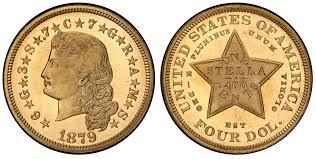
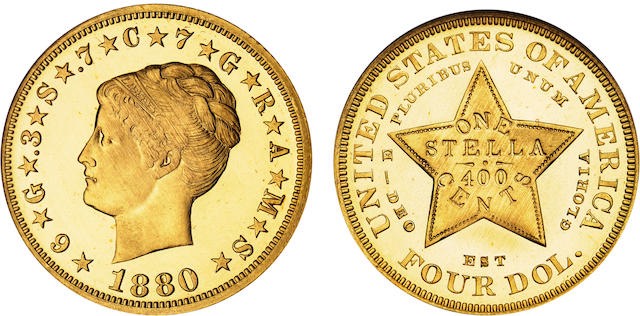 $4 Stella Four-dollar gold pieces, or stellas, so-called from the five-pointed star on the reverse, are patterns, not regular coins. Stellas were produced in 1879 and 1880 at the suggestion of Hon. John A. Kasson, U.S. minister to Austria, who felt that a coin of this value would have been used by foreign travelers, as it could be readily exchanged for gold coins of approximate equivalent value in European countries. Indicative of its in- tended international nature, the obverse legend of the $4 piece expressed its metallic content in the metric system as follows: 6G, .3S, .7C, 7 GRAMS.
$4 Stella Four-dollar gold pieces, or stellas, so-called from the five-pointed star on the reverse, are patterns, not regular coins. Stellas were produced in 1879 and 1880 at the suggestion of Hon. John A. Kasson, U.S. minister to Austria, who felt that a coin of this value would have been used by foreign travelers, as it could be readily exchanged for gold coins of approximate equivalent value in European countries. Indicative of its in- tended international nature, the obverse legend of the $4 piece expressed its metallic content in the metric system as follows: 6G, .3S, .7C, 7 GRAMS.
Two obverse designs were produced, the Flowing Hair type by Charles E. Barber (who was chief engraver of the Mint at the time) and the Coiled Hair type by George T. Morgan. On the reverse, instead of IN GOD WE TRUST, the motto appears as DEO EST GLORIA, or "God is Glorious." Mintages of the various issues are not known with certainty, but estimates are 425 for the 1879 Flowing Hair, the issue most often encountered, just 10 for the 1879 Coiled Hair, 15 for the 1880 Flowing Hair, and 10 for the 1880 Coiled Hair. Actual mintages were probably slightly higher than those figures.
NUMISMATIC AND HISTORICAL QUESTIONS AND FACT (October)
Q. I’ve been seeing silver bullets? for sale at a number of the local coin shows. Are they a true collectible or are they just a gimmick to sell bullion silver?
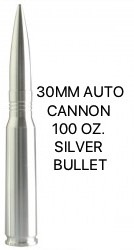
A. I saved this one for the October newsletter. While silver bullets are supposedly effective against a number of Halloween monsters including vampires, witches, and werewolves, the bullets sold at coin shows are solid silver and are inert.
They are however, actively collected in both different calibers and as shotgun shells. While their true value is as bullion, there were over a dozen calibers of bullets and 2 different shotgun shell sizes listed on Ebay when this was written. These range in sizes varying from .22 Rimfire (1/4 oz.) all they way up to 30MM Cannon shells weighing in at 100 oz.’s of silver! They trade at a substantial markup over bullion value, generally around 10-15% so they are probably not a good investment vehicle but they are interesting and unusual.
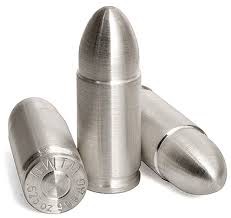
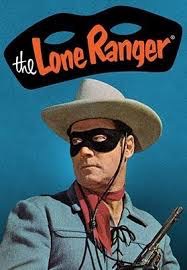
For those that are interested in actual shootable silver bullets, I can only say that they do exist as custom reloads. There are a number of YouTube videos of silver reloads being actually fired at targets but the casting quality and accuracy ballistics of silver appears to be extremely poor and the price exorbitant. But, then again, the Lone Ranger used silver bullets and he was able to shoot guns out of the bad guys hands!
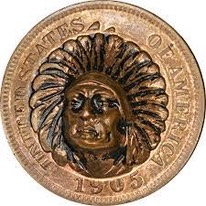
Q. What is a pop out coin?
A. Pop out coins have the formal name “repousse” and are also called push-out coins.
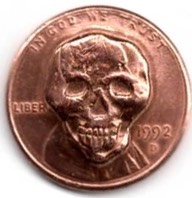
According to Encyclopedia Britannica.com, repoussé is “a method of decorating metals in which parts of the design are raised in relief from the back or the inside of the article by means of hammers and punches; definition and detail can then be added from the front by chasing or engraving. “The name repoussé is derived from the French pousser, ‘to push forward.’ This ancient technique, which has been used extensively throughout the history of metalworking, achieved widespread popularity in Europe during the 16th, 17th, and 18th centuries.”
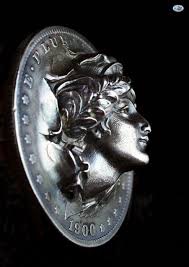
They are very popular with collectors, although prices have been steadily rising for these pieces over the years. This information was written by Charmy Harker on a coin talk forum a few years ago on the subject: “These interesting pieces of exonumia are also known as “Pushed Up,” “3-D,” or “Repousse” coins. Many varieties exist, including Miss Liberty, Presidents, with Lincoln being the most common, as well as animals, Indians, political, religious, fraternal clubs, foreign themes, etc.
Many pop-outs were made into jewelry, such as fobs, rings, pins, brooches, pendants, cuff links, etc. A book on pop out coins called “Pop Out Repousse Coins – a Numismatic Mystery” was published in 2011 by Robert (Stumpy) Stump, who passed away a few days after the book was sent to print.”
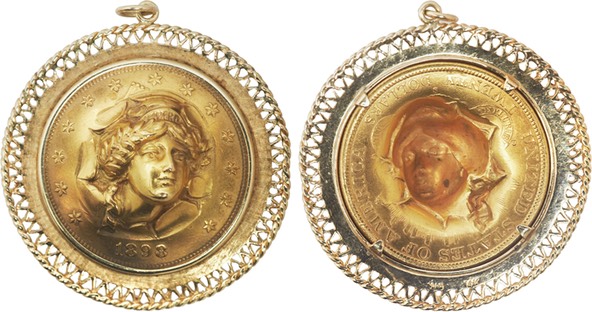
They also can command some hefty sums. Whether you call it a pop-out, pushed-out or repoussé coin, the embossed appearance on this 1898-S Coronet double eagle is eye-catching. The result is executed using two dies and extreme force. This piece realized $3,220 at auction in January 2014.

EDUCATIONAL FACT: Thomas Paine (born Thomas Pain) was an English-born American political activist, philosopher, political theorist, and revolutionary. He authored the two most influential pamphlets of the time, “Common Sense” and “The American Crisis” at the start of the American Revolution and inspired the patriots in 1776 to declare independence from Great Britain. “Common Sense” was so influential that John Adams said: "Without the pen of the author of “Common Sense”, the sword of Washington would have been raised in vain”
Paine lived in France for most of the 1790s, becoming deeply involved in the French Revolution. He wrote “Rights of Man” (1791), in part a defense of the French Revolution against its critics. His attacks on Anglo-Irish conservative writer Edmund Burke led to a trial and conviction in absentia in England in 1792 for the crime of seditious libel.
Part II of The Rights of Man was a continuation of the attack on monarchy and aristocracy, and was dedicated to Lafayette. Its publication early in 1792 evoked a veritable lynch campaign against Paine in England. Burke's supporters instigated public protest meetings, book-burnings of The Rights of Man, and the distribution of medallions bearing slogans like "The End of Pain," "The Wrongs of Man," and "We dance; Paine swings.”
The Condor token shown is one example.
Paine's publisher was arrested for printing seditious literature, and the legal sale of the book was stopped by royal proclamation. Black market sales continued however. . Paine fought the attack on his writings, distributing free copies of The Rights of Man and encouraging his supporters to stand up for his ideas at meetings called to incite feeling against them.
Paine fled to France where he continued to write but was soon arrested. James Monroe was able to secure his release after a year. Paine became notorious because of his pamphlets. The “Age of Reason”, in which he advocated deism, promoted reason and free thought and argued against institutionalized religion in general and Christian doctrine in particular. He published the pamphlet “Agrarian Justice” (1797), discussing the origins of property and introduced the concept of a guaranteed minimum income through a one-time inheritance tax on landowners.(Sound familiar?) In 1802, he returned to the U.S. where he died on June 8, 1809. Only six people attended his funeral as he had been ostracized for his ridicule of Christianity.
Currency Note of the Month
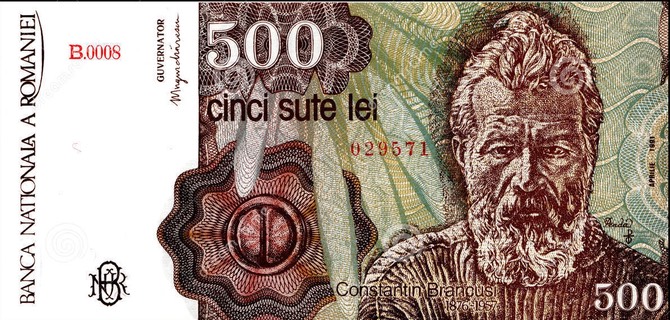
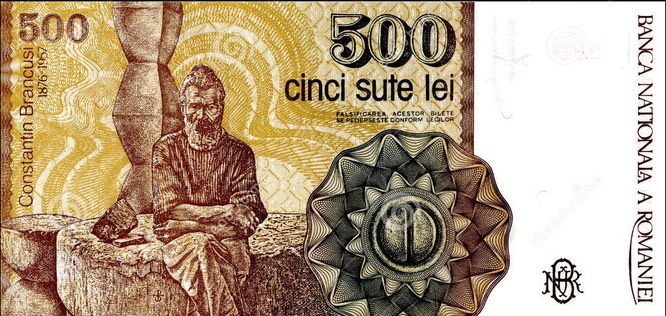
In January 1991, the National Bank of Romania (NBR) launched its first banknote is- sue after the December 1989 Revolution, with a face value of 500 lei. It is a relatively scarce note since it was only issued for one year and then replaced with a new issue of currency in early 1992. The note depicts Constantin Brancusi, considered a pioneer of modernism, one of the most influential sculptors of the 20th-century, Brâncuși is called the patriarch of modern sculpture.
In the 1990s, after the downfall of communism, inflation ran high due to reform failures and the legalization of owning foreign currency in 1990, reaching rates as high as 300% per year in 1993. By September 2003, one euro was exchanged for more than 40,000 lei, this being its peak value. Following a number of successful monetary policies in the late 1990s and early 2000s, the situation became gradually more stable, with one-digit inflation in 2005.
The Romanian lei was briefly the world's least valued currency unit, from January (when the Turkish lira dropped six zeros) to July 2005. However, the 1,000,000-lei banknote was not the highest Romanian denomination ever; a 5,000,000-lei note had been issued in 1947.
Coin of the Month
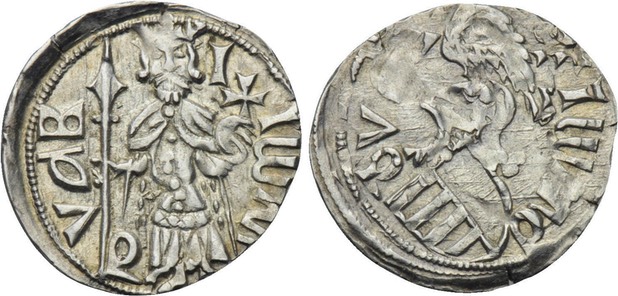
This coin was minted by Mircea the Elder (r. 1386-1395 and 1397-1418 AD) who was the ruler of the Principality of Wallachia north of the Danube, today’s Romania. He was closely allied with the last rulers of the Second Bulgarian Empire in their efforts to repulse the invading Ottoman Turks at the end of the 14th and the beginning of the 15th century.
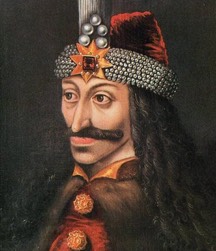
While Mircea the Elder is an important figure in Romanian history, he is probably better remembered as the father of Vlad II who was knighted into the Dragon Order and received the name, Dracul, or Dragon. His son was thus Vlad III.
Vlad III of the House of Basarab was a prince. He ruled Wallachia in Romania from 1456 to 1462 AD. The name Dracul(a), meaning little dragon, was inherited from his famous father, Vlad (II) Dracul, who fought alongside Sigismund of Hungary in war against the Turks.
Sigismund bestowed his thanks upon Dracul by knighting himinto the Dragon Order, which was created to fight for both Christianity and the Hungari- an king. His son Dracula (+a meaning "son of" Dracul) swore his life to bloody warfare against the Islamic Turkish invaders of his Christian homeland. Refusing to submit to his bitter enemies, he put 80,000 of them to death in his six year reign. One gruesome story recounts that when the Turkish Sultan's emissaries refused to remove their helmets in his presence, Vlad Dracula sent all of their heads back to the Sultan with their helmets nailed on with iron spikes. His brutal ways brought upon him the nickname
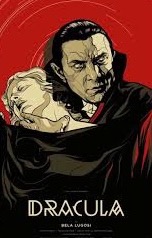
"The Impaler" and his bloodlust was known throughout Europe in the 14th century.
While Vlad III, or Dracula, has long been credited as the inspiration for Bram Stokers book “Dracula”, the evidence for that conjecture, beyond the name, is tenuous at best.
The silver coin features the image of Voivode Mircea the Elder on one side, and the image of what is possibly a Christian saint or a horseman on the other side.
Website of the Month
Ephemerasociety.org In a nutshell, to collectors “ephemera” are vintage printed or writ- ten items which originally served some specific purpose and were not expected to be retained or preserved, but which are now cherished. A few decades ago much of it was called “Paper Americana”, though ephemera is not necessarily American. Or even paper: these days the field has been expanded to include such things as tobacco tins, photographs, radio premiums, textile swatches, vinyl record albums, items made of celluloid or wood. Also included are various items which were indeed likely to be saved, such as wedding invitations, marriage certificates, passports, birth certificates, wills, deeds, divorce papers, stock certificates, promissory notes, and many other vintage documents.
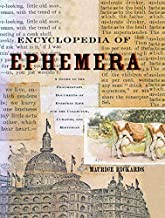
Maurice Rickards, author of the definitive Encyclopedia of Ephemera and a founder of The Ephemera Society in England, dubbed such items “the minor transient documents of everyday life.” That organization says that—produced to meet the needs of the day—“such items reflect the moods and mores of past times in a way that more formal records cannot.” Besides being enjoyable to find and collect, vintage ephemera is valuable primary source information which offers unique windows into cultures past.
NUMISMATIC AND HISTORICAL QUESTIONS AND FACT (September)
Q. For the purposes of collecting world banknotes, how many different currency symbols are there?
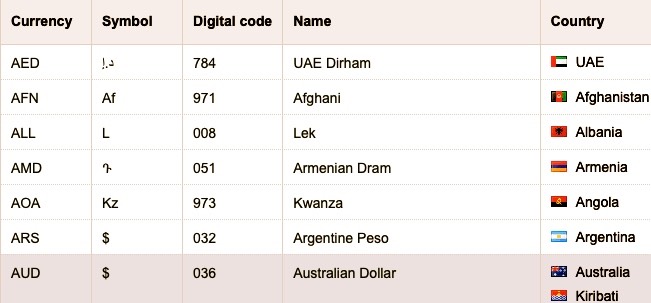
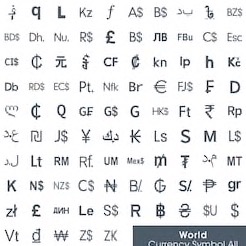
A. The number regularly changes based on global politics. Governments and territorial control are constantly changing so a definitive answer isn’t possible. However, to give a general answer, Forex, a leading currency trading company, lists 180 different currencies circulating in 197 countries. For the purposes of currency trading, each of those countries is identified with both a 3 letter alphabetic code and a 3 digit numeric code. Each countries currency will also have a symbol based on the basic unit of currency it circulates. For instance, the U.S dollar would have different codes from the Australian dollar, but the $ symbol would be the same for both currencies. This can be difficult to manage on occasion, since variations in the symbols also exist. (I.E. a $ symbol with one vertical line, or 2 vertical lines). There are a number of companies which provides those symbols in computer format for various uses. The majority of them list approx. 95 different types of currency symbols recognized in current use.
Q. Have you ever heard of an issued coin that was made from spent rifle shells?
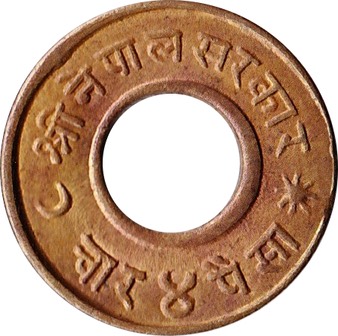
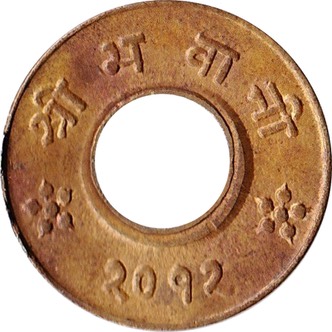
A. The 1955 Nepal 4 Paisa coin was struck from spent brass rifle cartridges used by Gurkha troops that fought against the Japanese in Burma and Assam in World War II. Gurkha soldiers from Nepal have long been noted for their fearless military prowess and have been part of the British Army for almost 200 years. The cartridges had been collected from the battlefields and stored in a government warehouse in Khathmandu. They were rediscovered by a General who had them turned over to the Mint to issue as coins to honor the Gurkha's service in the war. Because they are struck from used cartridges, the coins are a bit crude. The center hole was created by the removal of the primer. They were struck only a single year, and are the only 4 Paisa coins ever issued, due to the limited supply of the cartridges available. They are also believed to be the only issued coins created directly from spent ammunition. Despite being a one year issue, the coins are not particularly rare and can be purchased on-line for less than $20
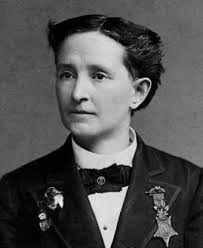
EDUCATIONAL FACT: Mary Edwards Walker, M.D. (November 26, 1832 – February 21, 1919), was an American abolitionist, prohibitionist, prisoner of war and surgeon. She is the only woman to ever receive the Medal of Honor.
Encouraged by her parents, upon receiving her medical degree in 1855 Walker went into private practice until the Civil War broke out in 1861.
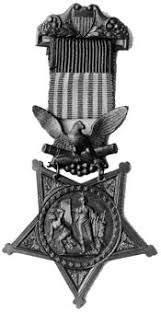
She wanted to join the Army as a surgeon but wasn't allowed because she was a woman. Because of her credentials, she didn't want to be a nurse, either, so she chose to volunteer for the Union Army.
During this period, she served at the First Battle of Bull Run (Manassas), July 21, 1861, and at the Patent Office Hospital in Washington, D.C. She worked as an unpaid field surgeon near the Union front lines, including at the Battle of Fredericksburg and in Chattanooga after the Battle of Chickamauga. She also organized the Women's Relief Organization to help the families of the wounded who came to visit them at local hospitals.
In 1862, Walker moved on to Virginia, this time treating the wounded at field hospitals throughout the state. In 1863, her medical credentials were finally accepted, so she moved to Tennessee, where she was appointed as a War Department surgeon. Her position was paid, and it was the equivalent of a lieutenant or captain.
Walker was captured in April 1864 by the South and held as a prisoner of war for about four months. She and other Union doctors were eventually exchanged in a prisoner of war swap for Confederate medical officers.
In November 1865, having left government service for good, Walker was awarded the Medal of Honor by President Andrew Johnson, even though she was a civilian who had never been a commissioned officer in military service.
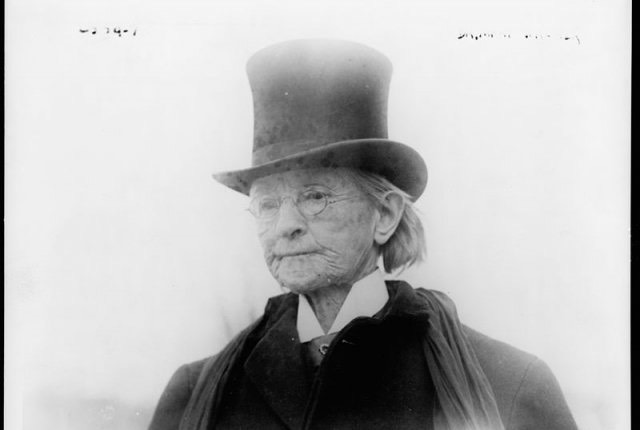
That civilian status is why Walker's medal was rescinded in 1917, two years before she died -- along with 910 others. Walker refused to return the medal, though, and continued to wear it until she died two years later.
Sixty years after that, in 1977, President Jimmy Carter restored the honor in her name, thanks to efforts made by her family and the U.S. Army and is the sole female recipient of the Medal of Honor.
Coin of the Month
The first gold commemorative coins issued by the United States Mint were the 1903 Louisiana Purchase Exposition Gold Dollars. The coins were available with two different obverse designs featuring Thomas Jefferson or William McKinley and carried a rather high authorized mintage of 250,000 coins across both designs. The coin shown is the Jefferson version.

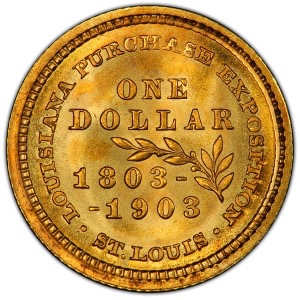
The Louisiana Purchase Exposition Thomas Jefferson Gold Dollar features a portrait of the president on the obverse with the design credited to Charles E. Barber. A left facing portrait of Jefferson appears with surrounding inscription “United States of America”. This represented the first time he was depicted on a legal tender U.S. coin.
The reverse design, also by Barber, features a single olive branch with an arrangement of inscriptions. The words “Louisiana Purchase Exposition” and “St. Louis” appear around the outer edge, with the denomination “One Dollar” and dual date “1803-1903” in the center.
There were 125,000 of the Louisiana Purchase Exposition Gold Dollars minted bearing the Jefferson obverse. These coins were promoted to collectors and others as a sou- venir for the exposition and distributed exclusively by Farran Zerbe. The offering price for the $1 face value coins was a lofty $3 each, which turned off many collectors. The massive quantity of unsold coins were returned to the Mint for melting, leaving a net distribution of only 17,500. They have the following specs: weight 1.672 grams, diameter: 15 mm, composition: 90% gold 10% copper, Reeded edge.
Currency Note of the Month

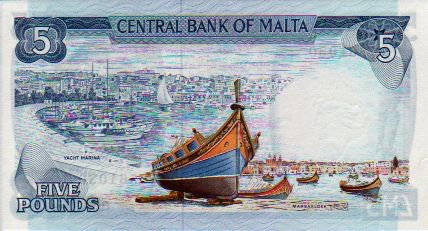
For those of you that collect world currency by theme here is an interesting ship note, (actually a number of ships), from the island country, the Republic of Malta. This particular note was issued in 1967 and is one of a number of colorful notes issued. Malta (located just south of Sicily) obtained autonomous rule in 1964 when the British granted it independence while the residents elected to remain a British Commonwealth with Queen Elizabeth II as as its head of state. Beginning 1964 there were 8 issues (1 commemorative) of Malta notes that ended in 2004 when it joined the European Union and then began use of the Euro currency in 2008. The issues are all brightly colored with Malta island themes on the reverses. As a side note, a number of films have been shot on the islands comprising Malta, including parts of “Guns of Navarone” and backdrop scenes from “Game of Thrones”.
Book of the Month
Digital Cash: The Unknown History of the Anarchists, Utopians, and Technologists Who Created Cryptocurrency by Finn Brunton

The fascinating untold story of digital cash and its creators―from experiments in the 1970s to the mania over Bitcoin and other cryptocurrencies Bitcoin may appear to be a revolutionary form of digital cash without precedent or prehistory. In fact, it is only the best-known recent experiment in a long line of similar efforts going back to the 1970s. But the story behind cryptocurrencies like Bitcoin and its blockchain technology has largely been untold―until now. In Digital Cash, Finn Brunton reveals how technological utopians and political radicals created experimental money to bring about their visions of the future: protecting privacy or bringing down governments, preparing for apocalypse or launching a civilization of innovation and abundance that would make its creators immortal.
Filled with marvelous characters, stories, and ideas, Digital Cash is an engaging and accessible account of the strange origins and remarkable technologies behind today’s cryptocurrency explosion.
NUMISMATIC AND HISTORICAL QUESTIONS AND FACT (August)
Q. While shopping at a coin show, I noticed that some dealers have 2-3 letter codes on their coin labels or holders. I assume that they indicate the price?

A. Most likely it is, indeed, the price. A common system is for a dealer to assign a specific 0-9 digit to an arbitrary letter allowing them to easily identify the asking price of an item without the buyer knowing what that price is. If you were to look at a number of items with an idea of what the price for a specific item might be you would probably be able to decode the prices.
An easier method is to use price guides or Ebay listings to determine an approximate value and to ask the dealer his price. If the price quoted is close, then haggling may result in a purchase price acceptable to both parties. As with any purchase that has a number of variables, the more knowledge you have, especially in advance, the better off you will be in making purchasing decisions. Fortunately, as buyers become better price informed this practice is going away.
Q. On a trip to Machu Pichu there was a local museum that displayed a group of knotted strings that was used for counting? What were they?

A. Quipu (also khipu), or talking knots, are recording devices fashioned from strings historically used by a number of cultures in the region of Andean South America.
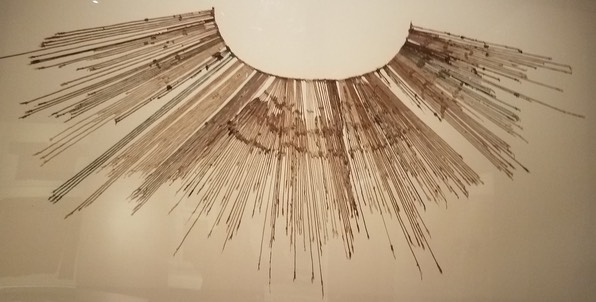
A quipu usually consisted of cotton or camelid fiber strings. The Inca people used them for collecting data and keeping records, monitoring tax obligations, properly collecting census records, calendrical information, and for military organization. The cords stored numeric and other values encoded as knots, often in a base ten positional system. A quipu could have only a few or thousands of cords. Objects that can be identified unambiguously as quipus first appear in the archaeological record in the first millennium AD. They subsequently played a key part in the administration of the Kingdom of Cusco and later Tawantinsuyu, the empire controlled by the Inca ethnic group, flourishing across the Andes from c. 1100 to 1532 AD. Quipucamayocs were the accountants of the time and created and deciphered the quipu knots. Quipucamayocs could carry out basic arithmetic operations, such as addition, subtraction, multiplication, and division. They kept track of mita, a form of taxation, and also tracked the type of labor being performed, maintained a record of economic output, and ran a census that counted everyone from infants to "old blind men over 80”. Some members of the ruling class were additionally taught to read quipus in the Inca equivalent of a university, the yachay wasi (literally, "house of teaching"),
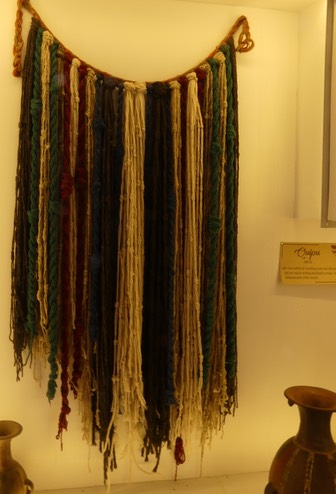
In 1532, the Spanish Empire's conquest of the Andean region began, with several Spanish conquerors making note of the existence of quipus in their written records about the invasion, however, the Spanish authorities quickly suppressed the use of quipus and large numbers were destroyed. According to the Khipu Database Project, 751 quipus have been reported to exist across the globe. Most are housed in museums outside of their native countries, however, some reside in their native locations under the care of the descendants of those who made the knot records. (Photos courtesy Marie Winther)
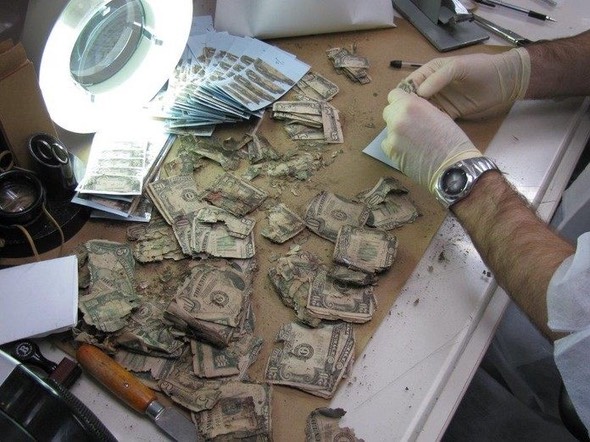
EDUCATIONAL FACT: Established by Congress in 1866—less than five years after the government started issuing paper money—the Mutilated Currency Division handles about 30,000 cases a year, returning currency valued at over $30 million. As long as more than half of the note remains, or the Treasury can be satisfied that the missing portions have been destroyed, the Mutilated Currency Division will redeem the amount of money that has been damaged by fire, water, chemicals, and acts of god.
For understandable reasons, the caseload (and wait time) tends to spike around natural disasters. But there are the rare cases with more bizarre origins. Legend has it among BEP tour guides that sometime during the 1970s, a farmer mailed in a rotting cow stomach, desperate for assistance. The man had lost his wallet in the field, and convinced it was eaten by the unfortunate cow, he had promptly slaughtered the beast. The farmer’s hunch proved correct and the BEP cut him a check for $600.
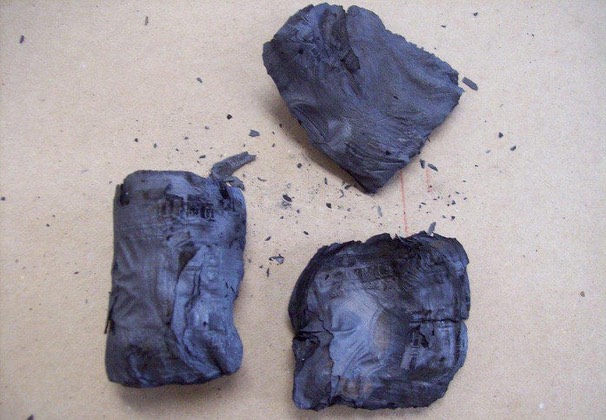
The forensic examiners can identify a fleck of printing, and they use advanced scientific methods to determine how much currency was mutilated. Cases usually take between 6 and 36 months, and when payment has been made, the mutilated currency is held securely for 45 days until it is incinerated in a boiler that helps heat and cool the building. The mutilated currency division only handles paper money, but the US Mint has a similar service for melted coins. (www.atlasobscura.com)
Coin of the Month
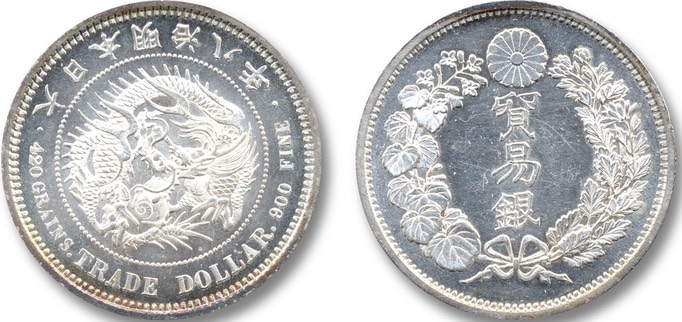
While the U.S. Trade dollar is the coin most commonly talked about amongst U.S. collectors, a number of countries also minted their own Trade dollars including Japan, France, and the United Kingdom. This is the the Japanese Trade Dollar. It was a dollar sized coin that was issued from 1875 to 1877 and was minted of 27.22 grams of .900 silver. The Yen coin of the time had 26.96 grams of silver and was otherwise nearly identical in design to the trade dollar. Nearly three million coins of this type were minted. When Japan introduced the gold standard in 1897, the silver one yen coins, including the trade dollars, were demonetized. The coins were then released for use in Taiwan, Korea and Southern Manchuria. These coins are very collectible, but like most Trade dollars of the era, nice quality examples are rare. Chopmarks, or merchant stamps certifying authenticity and value are common and heavily detract from the value. Also, counterfeits are common so due diligence is advised when purchasing one.
Currency Note of the Month
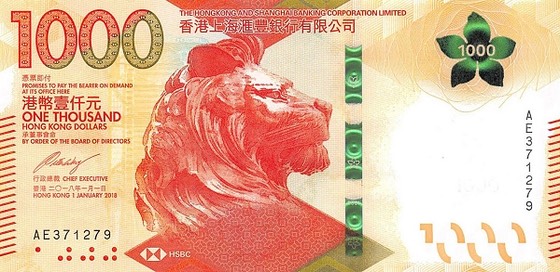
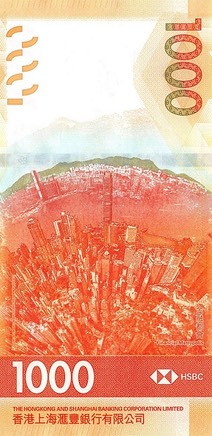
The Hong Kong dollar is controlled by the Hong Kong Monetary Authority (HKMA), the issuance of banknotes is done by three commercial banks under license from the HKMA. Shown here is the $1,000 note issued by the Hong Kong and Shanghai Banking Corporation. The $1,000 note is the largest denomination note issued with each bank having a different design. The note front has a lion that is one of a pair of famous lion sculptures at 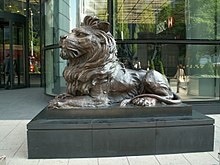 the HSBC Main Building that have been nicknamed “Stephen” and “Stitt” after 2 of the banks founding man- agers. “Stitt” is the one shown on the note. The reverse features a skyline view of the Hong Kong. The note has a number of security features including, watermarks, a visible security thread, and and a see-through alignment color pattern to prevent counterfeiting.
the HSBC Main Building that have been nicknamed “Stephen” and “Stitt” after 2 of the banks founding man- agers. “Stitt” is the one shown on the note. The reverse features a skyline view of the Hong Kong. The note has a number of security features including, watermarks, a visible security thread, and and a see-through alignment color pattern to prevent counterfeiting.
Website of the Month
www. forumancientcoins.com Ancient coins Athens, are often neglected by coin collectors because they believe they must be very rare, too expensive to collect, and too difficult to understand. While some ancient coins are rare, many are very common. The most famous cities and rulers of the ancient world struck coins in great quantities. Coins of Athens, Corinth, and Rome and of Alexander the Great, Julius Caesar, Marc Antony, and Hadrian, for example, are common. Many are less expensive than collectible modern coins. Some late Roman bronze coins can be purchased for as little as a few 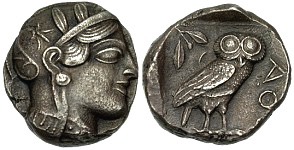 dollars each. Anyone can appreciate ancient coins and quickly learn the basics of collecting them. Ancient coins are historically interesting, artistic and obtainable at reasonable prices.
dollars each. Anyone can appreciate ancient coins and quickly learn the basics of collecting them. Ancient coins are historically interesting, artistic and obtainable at reasonable prices.
If you've made it here, you probably have some interest in the collection of ancient coins, and this is provided as a general guide to getting started. The collection of ancient coins, like many areas, involves its own terminology which is very specialized. It may take the new collector some time to become familiar with the language of ancient coins. Fortunately for you, here at Forum Ancient Coins, many terms are defined in NumisWiki, Forum Ancient Coins' online numismatic and historical reference. With that preliminary explanation out of the way, let's get started with the wonderful world of ancient coin collecting.
NUMISMATIC AND HISTORICAL QUESTIONS AND FACT (July)
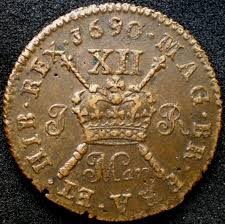

Q. What is “gun money”?
A. Gun money was an issue of coins made by the forces of James II during the Williamite War in Ireland between 1689 and 1691. They were minted in base metal (copper, brass or pewter), and were designed to be redeemed for silver coins following a victory by James II and consequently bore the date in months to allow a gradual replacement. This was also done so that after the war (in the event of James' victory), soldiers would be able to claim interest on their wages, which had been withheld from proper payment for so long. As James lost the war, that replacement never took place, although the coins were allowed to circulate at much reduced values before the copper coinage was resumed. They were mostly withdrawn from circulation in the early 18th century.
The name "gun money" stems from the idea that they were minted from melted down guns. However, many other brass objects, such as church bells, were also used.
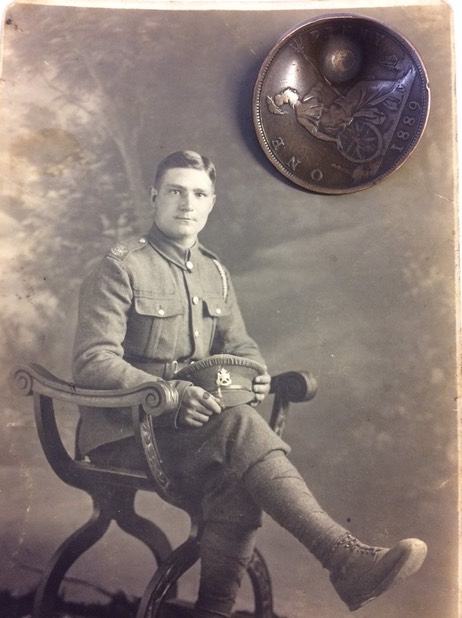
Q. I recently saw an auction listing for a soldiers coin that had deflected a bullet and the soldier surviving. Any more to the story?
A. In 1917, 19 year old British soldier, Private John Trickett, was shot at by a German soldier on a French battlefield. The bullet was deflected by a 1889 British penny carried in his breast pocket. The bullet, deflected away from his heart, traveled through his nose and out through the back of his left ear leaving him permanently deaf in the ear. Two of his brothers were not as fortunate and were killed during the war.
Trickett was discharged in 1918 and saved the coin as a “good luck” war souvenir. He married, had children, and worked as a Postmaster. His family kept the coin and supporting documentation after his death and recently put the coin up for auction.
The coin and other related materials were sold on 22 March, for approx. $5600 despite a pre-sale estimate of $150 to $300. It was purchased by his grandson.
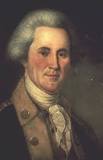
EDUCATIONAL FACT: After the American Revolutionary War, large areas of settled land initiated statehood movements expecting to be quickly admitted as new states. While most of those movements were short lived, one, the State of Franklin (also the Free Republic of Franklin or the State of Frankland), was founded with the intent of becoming the fourteenth state of the new United States. Franklin was created in 1784 from part of the territory west of the Appalachian Mountains that had been offered by North Carolina as a cession to Congress to help pay off debts related to the American War for Independence. Eight counties were eventually part of Franklin with charismatic John Sevier appointed Governor. Franklin’s first capital was Jonesborough. After the summer of 1785, the government of Franklin (which was by then based in Greeneville), ruled as a "parallel government" running alongside (but not harmoniously with) a re-established North Carolina bureaucracy. Franklin was never admitted into the union. The extra-legal state existed for only about four and a half years, ostensibly as a republic, after which North Carolina re-assumed full control of the area. After resuming control, North Carolina ceded the territory to the Federal government. John Sevier was instrumental in the administration of the territorial government and the counties that were originally the state of Franklin became part of the nucleus for the state of Tennessee, admitted in 1796.
Coin of the Month
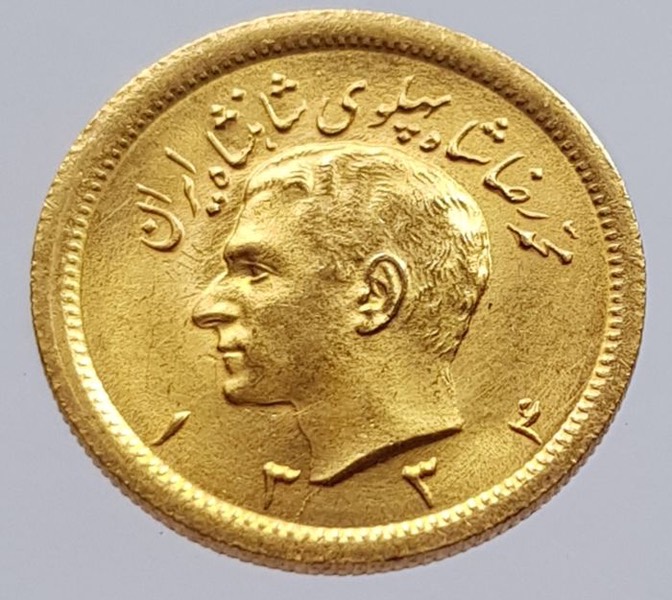
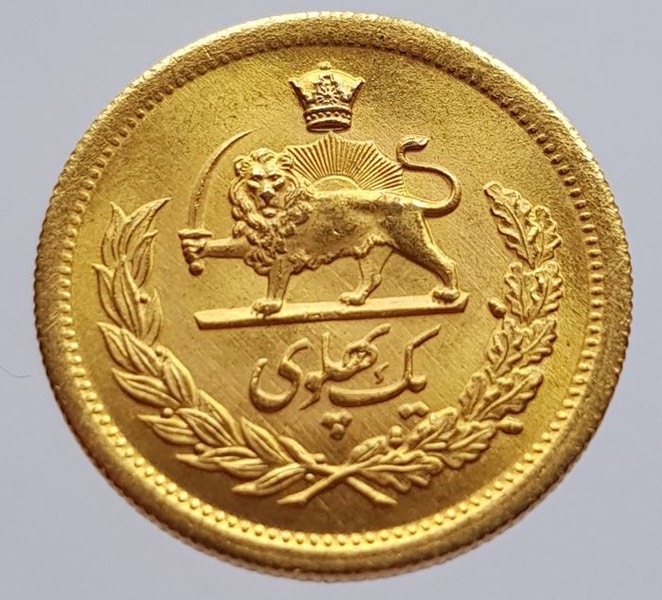
Iranian gold 1/4 Pahlavi. When I saw this listed as one of the gold coins being given away at the Golden State Coin Show, I was unfamiliar with it so I thought I would feature it this month. Mohammad Reza Shah Pahlavi was the last Shah (King) of Iran. The Pahlavi dynasty was the ruling house of Iran from 1925 until 1979, when the monarchy was overthrown by the Islamist Revolution. The Shah minted several coins in gold that bear his likeness and this is a 1/4 PAHLAVI minted from SH1332 to SH1358. The 'SH' dates cited above are in the 'Solar Hijri' calendar, an Islamic calendar based on solar years instead of the normal lunar years. Dates are read in Eastern Arabic numerals and SH1332 corresponds to 1954AD (Gregorian calendar), and SH1358 corresponds to 1979AD. This coin was produced in 1934 and has the following specs: Minted from SH1332 to SH1358, 13 mm diameter, 0.0589 troy ounces gold.
Currency Note of the Month
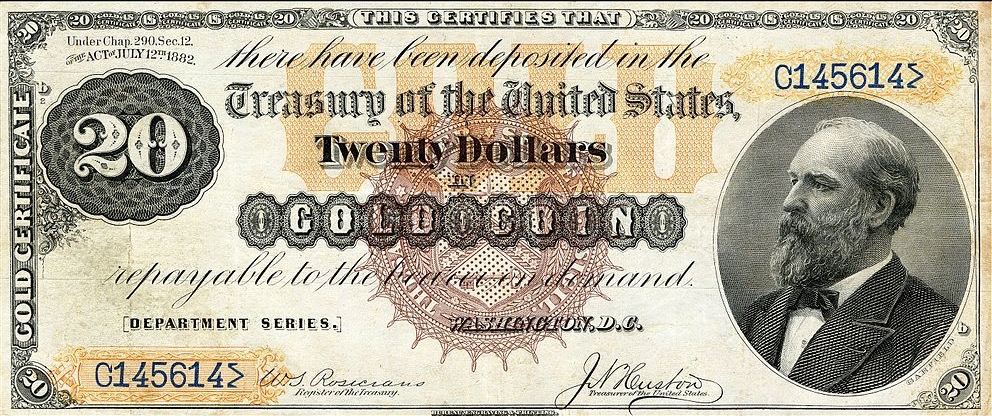
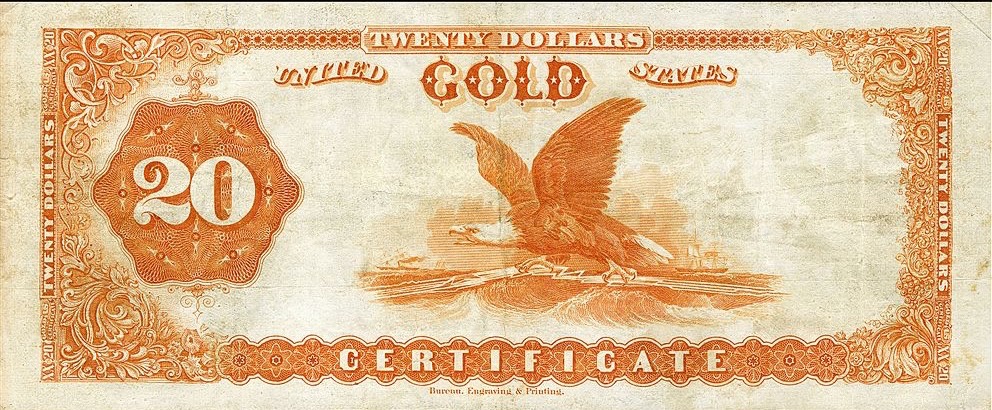
It’s been a couple of months since I featured a U.S. note. This large size note is cataloged in Friedberg as an FR-1177 which is one of 6 varieties (although one of those varieties is very rare with only 2 known) of this note. It is a Series 1882 $20 Gold Certificate redeemable for gold coin at the Treasury. The face of the note features a bust of President Garfield, engraved by Charles Burt, and one of three types of Treasury seal. The reverse displays a large eagle carrying a lightning bolt. This vignette is named “Ocean Telegraph” and commemorates the completion of the Trans-Atlantic telegraph cable in 1858. The vignette was engraved by George D. Baldwin. Prices for this note are steep, with most varieties starting at $4-5000 in VG and up to 5 figures in UNC, although the small red seal variety is much more affordable at $500 (VG) to $5,000 in UNC.
Book of the Month

Trench Art by Nicholas Saunders
Engraved shell-cases, bullet-crucifixes, letter openers and cigarette lighters made of shrapnel and cartridges, miniature airplanes and tanks, talismanic jewelry, embroidery, objects carved from stone, bone and wood – all of these things are trench art, the misleading name given to the dazzling array of objects made from the waste of war, in particular the Great War of 1914-1918 and the inter-war years. And they are the subject of Nicholas Saunders’s pioneering study which is now republished in a revised edition in paperback.
He reveals the lost world of trench art, for every piece relates to the story of the momentous experience of its maker – whether front-line soldier, prisoner of war, or civilian refugee. The objects resonate with the alternating terror and boredom of war, and those created by the prisoners symbolize their struggle for survival in the camps. Many of these items were poignant souvenirs bought by battlefield pilgrims between 1919 and 1939 and kept brightly polished on mantelpieces, often for a lifetime.
Nicholas Saunders investigates their origins and how they were made, exploring their personal meaning and cultural significance. He also offers an important categorization of types which will be a useful guide for collectors.
NUMISMATIC AND HISTORICAL QUESTIONS AND FACT (June)
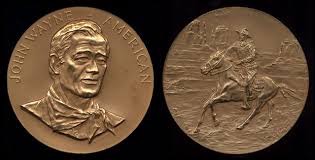
Q. I saw a gold plated John Wayne Congressional medal at a recent coin show. Has the U.S. Mint ever issued any plated coins or medals?
A. No, the U.S. Mint has never issued any plated coins or medals. The 1979 John Wayne medals were a favorite for post production plating though. A notable Connecticut company purchased thousands of the 3” bronze medals and gold plated them. The original medals were purchased from the Mint for $3 and after plating them retailed them for $10 netting a nice profit. The Wayne medal was one of the top selling medals ever produced by the Mint and is still readily available on the secondary market. A single gold specimen was presented to the Wayne family in 1980 and contained 15 oz. of gold.
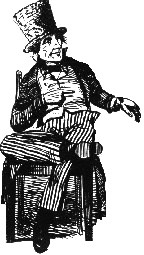

Q. Who or what is “Brother Jonathan”?
A. When the Revolutionary War began, Brother Jonathan preceded Uncle Sam as the first male personification. In fact, Jonathan’s clothing would be emulated by Uncle Sam. The two were used interchangeably by the 1850s. One difference is that Uncle Sam specifically represents the U.S. government; Brother Jonathan represents the U.S. as a nation.
The term likely comes from the words spoken by David in the Bible’s Book of Samuel, who uttered the phrase after his friend Jonathan died: “I am distressed for thee, my brother Jonathan.” It was first put into use by British officers, who used it as a derogatory term for rebellious colonists who opposed the crown. One folk tale attributes it to the Governor of Connecticut, Jonathan Trumbull – the only governor to side with the patriots and who helped supply the Northern and Middle Departments during the Revolutionary War. Some contend George Washington uttered the phrase, “We must consult Brother Jonathan,” when asked how America might win the war.
At times, Brother Jonathan was depicted in specific roles, such as a seaman, trader, peddler, or sometimes as a sly and tough trickster. He eventually morphed into that of a person with great patriotic pride.
The character became popularized in 1842 when the weekly newspaper “Brother Jonathan” appeared in New York. Brother Jonathan also became a nickname for any Yankee sailor – not unlike how G.I. describes a U.S. Army member. Another humor magazine used the Brother Jonathan character to parody Yankee materialism, and most New Englanders saw it as good-natured.
Though Brother Jonathan was supplanted by Uncle Sam, some saw them as the same personification. They took on and displayed many of the same characteristics and notions, and both were ultimately symbols of triumph.
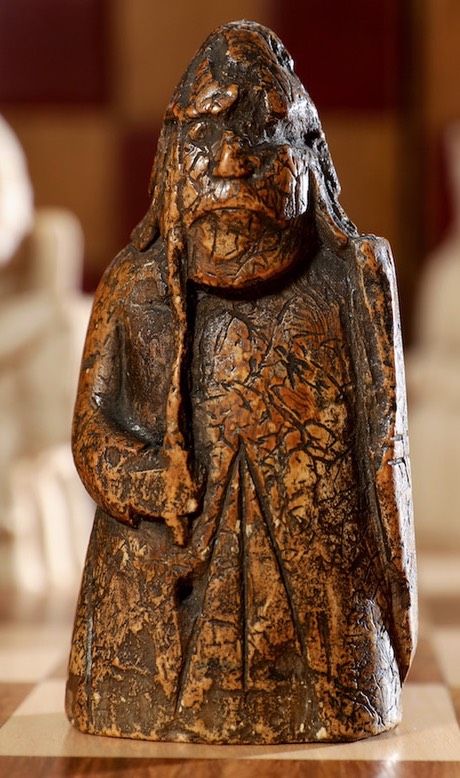
EDUCATIONAL FACT: Currently in the news there is a buzz about a recently discovered ancient chess piece. While the piece has been referred to as “recently discovered” a better description would probably be “recently identified”. In 1964, an antiques dealer from Edinburgh, Scotland, spent £5—roughly £100, or $125 USD, in today’s money—on an ivory figurine he later catalogued in his purchase ledger as an “Antique Walrus Tusk Warrior Chessman.” Following the anonymous dealer’s death, the 3.5-inch standing soldier passed down to his daughter, who stored it in a drawer for the next several decades, unaware that she was in possession of a rare piece from arguably the most famous chess set in history. Recovered from a sand dune on Scotland’s Isle of Lewis in 1831, the Lewis Chessmen, were part of a hoard of 93 artifacts, including 78 seated kings and queens, bishops, knights, standing warders (the equivalent to a modern-day rook or castle), and pawns; 14 “tablemen” pieces similar to those used in backgammon; and one buckle. The pieces were likely crafted, most of them from walrus ivory, sometime between the 12th and 13th centuries in Trondheim, Norway and represent one of the most well-preserved examples of medieval European chess sets. 82 pieces from the hoard are now displayed at the British Museum, and 11 pieces in the National Museum of Scotland. Although the chess pieces form almost four complete sets, the group is missing one knight and four warders. The Edinburgh piece, which represents one of the warders, was carved out of walrus tusk ivory to depict a fierce bearded warrior wielding both sword and shield. It is the first of these five missing pieces to materialize. On a side note, the magical chess pieces in J.K. Rowling’s film version of “Harry Potter and the Sorcerer's Stone,” are modeled after the Lewis Chessmen. The Lewis Warder is set to be sold by Sotheby’s on July 2, with the lot’s current estimate at £600,000 to £1 million, or $760,000 to $1.2 million.

Coin of the Month

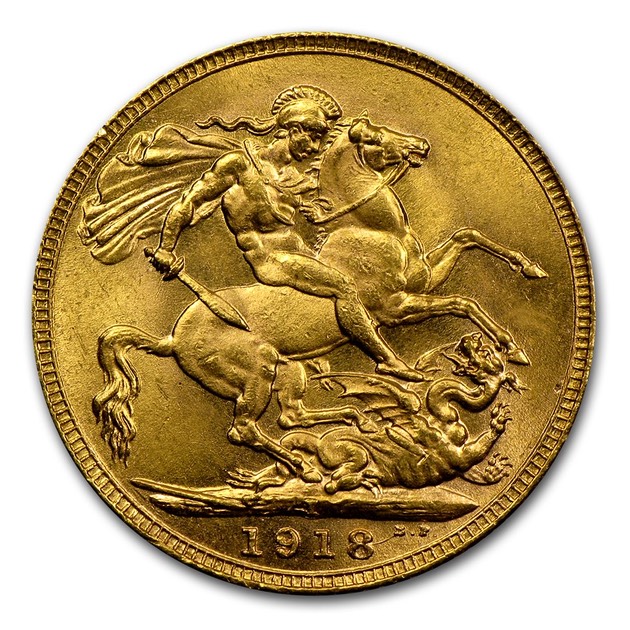
While not unusual as a design, this 1918 British Sovereign was produced at the Bombay Mint. The fifth branch of the Royal Mint was established in a section of the Bombay Mint in 1917 as a war-time measure. Its purpose was to strike into sovereigns the gold that was being produced by the Bombay and other Indian mines. The sovereigns bear an “I” mintmark and were only struck from August 151918 to April 22 1919. The branch mint was closed a month later , in May 1919. The obverse bears the portrait of George V, King of the United Kingdom and Emperor of India. The reverse features the classic design of St. George slaying the dragon by Benedetto Pistrucci. While almost 1.3 million were produced at the Bombay Mint, a large number have been melted down over the years. They have the following specs, weight: 7.9881 grams, diameter: 22.05 mm, composition: .7.315 gold and .665 Copper. Reeded edge.
Book of the Month
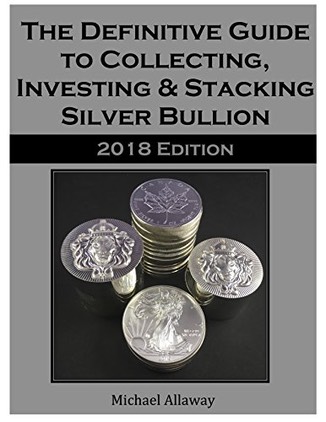
The Definitive Guide to Collecting, Investing & Stacking Silver Bullion: by Michael Allaway
Silver has been called both the “investment of the decade” by billionaire Eric Sprott and the “Devil’s Metal” by John Levin in the recent past. Those who have been brave enough to collect, invest, or stack silver can certainly attest to both perspectives. The precious metal skyrocketed in price to a high of $49.80 per ounce on the 25th of April 2011, before plummeting back down to the narrow trading range where it has languished for the better part of seven years. This has provided collectors, investors and stackers with an ideal opportunity to accumulate the metal, or equivalent investments, at historically low prices. In stark contrast to the price of the metal has been investment demand, which has been relentless. This investment demand has spurred a plethora of new silver bullion coin releases that have been a boon to collectors. The intent of this book is to provide a comprehensive guide for silver enthusiasts of all types and all levels of expertise, from those looking at joining the ranks of silver enthusiasts to silver veterans. The guide is comprehensive in terms of both breadth and depth. Specifically, it contains well over two hundred pages of silver content specifically targeted at collectors, investors and stackers, including in excess of 400 original photos of silver coins from over forty countries. Rather than dealing in generalities, the guide details specific accumulation strategies for all three types of silver enthusiasts. The 2018 edition is the first edition of what will be an annual release, expanded and updated based on feedback from the silver community.
Currency Note of the Month

Since it is now officially Summer, I thought I would feature something a bit whimsical! Antarctican currency was first introduced in 1996 by the Antarctica Overseas Exchange Office (AOEO). These notes are denominated in Antarctican dollars, and are issued by a private company and so are not legal tender anywhere. However, the Antarctic banknotes have many fans in the banknote collecting world due to their cutting-edge technology and colorful designs.
Antarctican dollar banknotes are “issued” and sold by the AOEO, located in the American state of Washington. The AOEO was established with the aim of issuing banknotes as a fund-raising exercise for projects in Antarctica. Founded by D. J. Hamilton, 20% of all revenue from the sale of the notes will be used to defray the costs of the Exchange, while the remaining 80% will be available to organizations seeking to undertake research and humanitarian projects in the Antarctic region.
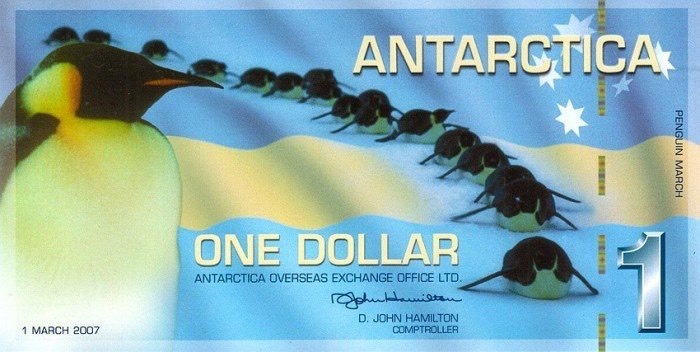 The notes are printed by the British American Banknote Company and there has been 32 issues produced with denominations of $1 to $100. Since 2007, Antarctican have been produced in polymer with a number of anti-counterfeiting features. Banknotes printed include both Antarctica-related designs and those honoring nearby lands: New Jason Islands, Easter Island, et cetera.
The notes are printed by the British American Banknote Company and there has been 32 issues produced with denominations of $1 to $100. Since 2007, Antarctican have been produced in polymer with a number of anti-counterfeiting features. Banknotes printed include both Antarctica-related designs and those honoring nearby lands: New Jason Islands, Easter Island, et cetera.
NUMISMATIC AND HISTORICAL QUESTIONS AND FACT (May)
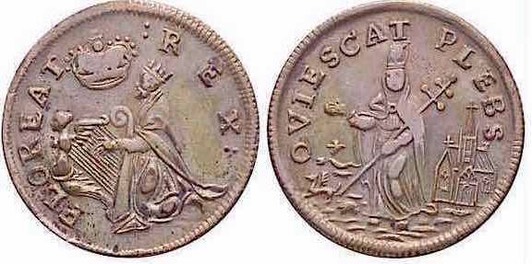
Q. What is a “St. Patricks” copper?
A. A The St. Patrick halfpenny (there are 2 sizes) was a milled coin minted in the 17th
century in England, Ireland and Wales. The ma-
jority of these St. Patrick halfpennies are copper
coins with a splash of brass minted in two sizes,
large and small. The reverse design shows King
David kneeling playing a harp while gazing up at the royal crown of England. The legend on the obverse reads FLOREAT REX (May the King Flourish).
The obverse of the smaller copper halfpenny
shows St. Patrick dressed in bishop's garments wearing a mitre and holding a double-
cross crozier. He is depicted dispelling the serpents from Ireland that are portrayed as
various aquatic beasts, some are fabulous. In the background is purportedly St.
Patrick's Cathedral, Dublin. The legend reads QUIESCAT PLEBS (May the People Be
at Peace).
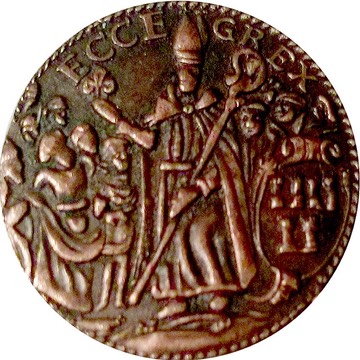 On the larger copper specimens St. Patrick is seen preaching to a crowd gathered round him. To his right is a shield with devices of several towers usually interpreted as three, suggesting the city shield of Dublin. The legend reads ECCE GREX (Behold the Flock).
On the larger copper specimens St. Patrick is seen preaching to a crowd gathered round him. To his right is a shield with devices of several towers usually interpreted as three, suggesting the city shield of Dublin. The legend reads ECCE GREX (Behold the Flock).
Originally minted for use in Ireland, St. Patrick coppers had a long and varied history. An English Quaker merchant in Dublin named Mark Newby (or Newbie) acquired a large supply of these coins which he took with him in 1681 when he emigrated to West New Jersey (New Jersey was divided into separate Eastern and Western colonies from
1676-1702). On May 18, 1682 the General Free Assembly of West New Jersey granted
Newby's coppers legal tender status and allowed them to circulate as small change at
the rate of a halfpenny, replacing local wampum.
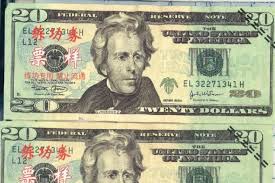
Q. Which countries have the highest rates of counterfeiting?
A. The top seven, are the British Pound, Chinese Yuan, U.S.
Dollar, Russian Ruble, the Euro, Indian Rupee, and the
Mexican Peso. According to the central banks, the ratio of
counterfeited bank notes is about 1 in 20,000 for the Euro,
of 1 in 10,000 for the United States dollar and of 1 in 3,333
for the Pound sterling.
On the other side of the coin, the Kiwi dollar is one of theworld’s least counterfeited currencies. It only has one counterfeited note or coin per 1,000,000 in circulation. Another currency low down on the world’s forgery list, is the Norwegian Krone. The fact that police discovered just 20 fake 50 krone notes ($6.40/£4.55) last summer was reported as
headline news! Perhaps a polymer note may be in the future for countries with high
counterfeit problems. The Canadian government saw a 74% decrease in counterfeit
notes after switching to polymer notes.
EDUCATIONAL FACT:
The National Park Service has a project called the Witness
Tree Protection Program that documents and protects living trees at historical locations
or trees with significant biological characteristics. These trees stand as the last living
witnesses at some of the most violent episodesin U.S. history and what are now some of themost peaceful and beautiful locations.
Probably the most famous group of these trees is located at the Gettysburg Battlefield in Pennsylvania where rangers have documented at least a dozen "witness trees" that were alive during the battle - living links that help tell
the story of the battle.

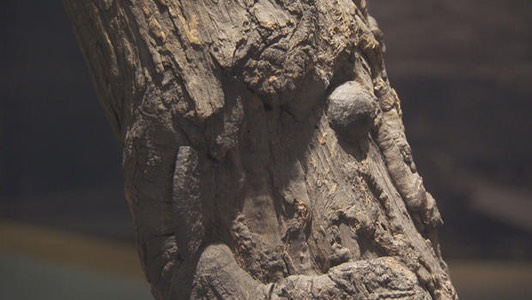
For one of the trees, in 1863, a Massachusetts bugler sketched a swamp oak growing next to Union General Daniel Sickles' headquarters. Today, this massive landmark is known as the Sickles Tree.
No one knows the exact number of witness
trees at Gettysburg. They're often identified by photos, sketches, and burial maps. Some reveal themselves after they fall. In 2011, a
maintenance crew clearing a downed tree with a chainsaw struck metal. Bullets were lodged inside the trunk that's now part of the museum collection. Historians estimate seven million bullets and artillery shells were fired during the battle.
Another famous Witness Tree is the Burnside
Bridge Sycamore Tree at Antietam. This tree was
standing witness to the bloodiest single day in all of
American history: 23,000 combined casualties.
During the battle there was a three hour siege at
the bridge where 400 Confederate soldiers man-
aged to hold the line for several hours against
12,000 Union soldiers. Repeated Union charges
were beaten back and the dead fell in piles near
the tree. Horses, heavy equipment, and thousands
of soldiers swarmed around it and the storm of ar-
tillery and rifle fire went on for hours. Photographs
the following day show the sapling— still standing
somehow—amid the wrecked landscape.
I have only mentioned a couple of the notable examples of this program. The initial group of protected trees was twenty-four trees and they were chosen for either having witnessed a major event or possess a remarkable biological
characteristic such as advanced age, exceptional size, or resistance to disease. For
more info: https://home1.nps.gov/commonground/Spring2007/newscloseup.pdf
Coin of the Month
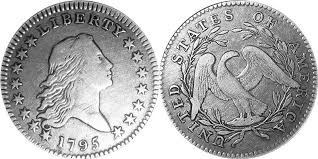
I noticed that while I have covered most of the popular types of half dollars, I have neglected some of the early ones. So, this month I am presenting the earliest of them, the
Flowing Hair Half Dollar. Half dollars of 1794-1795 bear the same design as contemporary half dimes and silver dollars. The obverse features a small head of Miss Liberty
facing right, with flowing hair behind, LIBERTY above, and the date below. Eight stars
are to the left and seven to the right. The reverse illustrates an open wreath enclosing
a “small” eagle, with UNITED STATES OF AMERICA surrounding. The borders of this
and other half dollars (until 1916) have denticles. The edge features the lettering
“FIFTY CENTS OR HALF A DOLLAR.” Pieces dated 1795 are by far the most often
encountered of this type being some ten times more plentiful than the 1794s. Prices reflect the scarcity of both types with AG examples starting around $600 and increasing
to $20,000 or more for AU pieces.
323,144 of both types were produced at the Philadelphia mint and they have the following specs, weight: 13.48 grams, diameter: 32.5 mm, composition: .8924 silver and .
1076 Copper. Edge lettering: “Fifty cents or Half Dollar”.
Currency Note of the Month
This is a 10 franc (Seventh series) note from Switzerland. This particular note fea- tures Leonard Euler, a famous Swiss mathematician, along with the mathematical development of the polyhedron on the front, while the reverse has a design featuring Gamma function, a table for the calculation of numbers, and a diagram of the solar system. Quite the design!
What’s unusual is, this note was never issued. The Swiss created this series of notes (6 denominations, 10 to 1000 francs) to be used only in the event of an emergency such as rampant counterfeiting or any event that debased the sixth series of notes that were released. When the eighth series was released to replace the sixth series, the reserve seventh series notes were destroyed.
The Swiss also set expiration dates (20 years) on their issues of notes. The sixth series was started to be withdrawn from circulation in 2000 and will no longer be legal tender after 2020. When a recalled series become valueless, the National Bank transfers an amount of money equal to the sum of the now-worthless notes that weren’t redeemed to a state-run last-resort disaster insurance fund, the Swiss Fund for Aid in Cases of Uninsurable Damage by Natural Forces.
Website of the Month
coinauctionshelp.com
This month I picked a website which could be very useful, especially for novices. It is a one stop site for grading, values, counterfeit information, and has an excellent social forum for asking questions about things that you can’t find on the site. All of the individ- ual sections are complete with photo illustrations so determining the type and grade of any U.S. coin becomes an easy task and it also has a values section for all U.S. coins. An invaluable site especially for the complete photograding section.
NUMISMATIC AND HISTORICAL QUESTIONS AND FACT (APRIL)
Q. I was told by a gold dealer that the price of gold can be affected by rainfall and seasons? How does that happen?

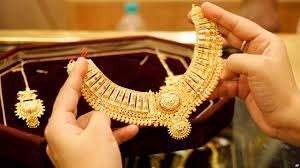
A. India consumes 849 metric tons of gold per year representing the second largest demand in the world. Only China consumes more and only by a small margin.
So, where does rainfall factor into this picture? The rural population within India accounts for an estimated 60-70 percent of gold consumption within the country. Since the country is the second-largest producer of rice, wheat, sugar, and cotton in the world, rainfall is critical to their way of life. With the right amount of rain those living in rural regions can ensure strong crop yields and, as a result, increase their income and influence their ability to buy gold.
Additionally, the festival and wedding season (roughly October to December), will influence gold purchases given that many people in the country buy gold for these occasions. Gold has a major place in the country’s cultural legacy and is a common wedding gift and carries far more religious import in India than any other country.
Q.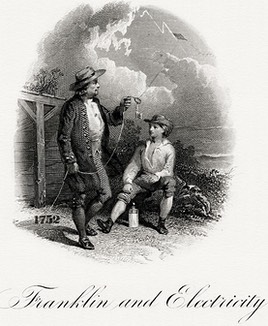 Is Benjamin Franklin portrayed on any other U.S. currency beside the $100 note?
Is Benjamin Franklin portrayed on any other U.S. currency beside the $100 note?
A. Yes, he is also portrayed on the obverse of the 1875 Series, First Charter, $10 National Bank notes in a vignette engraved by Alfred 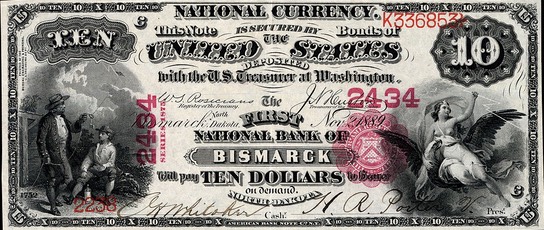 Jones. While not technically a portrait, the vignette portrays Franklin, along with his son, performing his famous kite experiment demonstrating the electrical nature of lightning. He used the information obtained to invent the lightning rod.
Jones. While not technically a portrait, the vignette portrays Franklin, along with his son, performing his famous kite experiment demonstrating the electrical nature of lightning. He used the information obtained to invent the lightning rod.
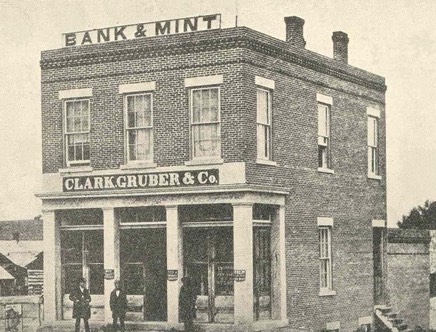

EDUCATIONAL FACT: While the history of the Denver Mint is well known, the predecessors of the Mint were the men of Clark, Gruber and Company. During the Pikes Peak Gold Rush, they coined gold dust brought from the gold fields by the miners.
In 1858, Austin M. Clark, Milton E. Clark and Emanuel Henry Gruber founded a brokerage firm in Leavenworth, Kansas, and then established an office in Denver at the beginning of the Colorado Gold Rush. Desiring to save on shipping and insurance costs associated with shipping gold back east, the firm opened a private mint. On 25 July 1860, the mint opened in a two-story brick building on the corner of Market and 16th Streets, minting $10 gold pieces at the rate of "fifteen or twenty coins a minute". On the face is a representation of the peak, its base surrounded by a forest of timber and 'Pikes Peak Gold' encircling the summit. Immediately under its base is the word 'Denver', and beneath it 'Ten D.'. On the reverse is the American Eagle encircled by the name of the firm 'Clark, Gruber & Co.', and beneath the date, '1860'.
A $20 gold coin was added, "the weight will be greater, but the value the same as the United States coin of like denomination". A $5 and a $2.5 gold coin were also added, with production reaching $18,000 per week. On the front was the "head of the Goddess of Liberty surrounded by thirteen stars, with "Clark & Company" in the tiara. "Pikes's Peak Gold, Denver" was on the other side, with "5D." or "2 1/2 D."
In the almost three years of operation, they minted $594,305 worth of Pike's Peak Gold in the form of gold coins. Additionally, they purchased 77,000 troy ounces 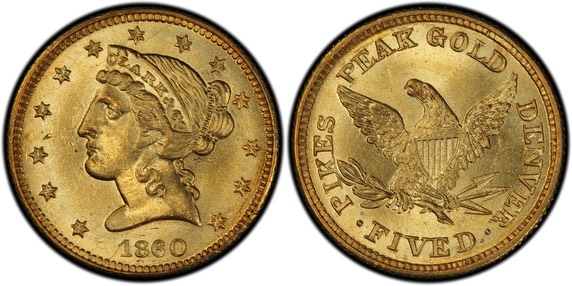 of raw gold, and shipped "large amounts of dust" to the Philadelphia Mint. The building, assaying and minting equipment was formally bought by the US Treasury in April 1863. Clark, Gruber & Co. thereafter remained a bank until bought by the First National Bank of Denver in 1865.
of raw gold, and shipped "large amounts of dust" to the Philadelphia Mint. The building, assaying and minting equipment was formally bought by the US Treasury in April 1863. Clark, Gruber & Co. thereafter remained a bank until bought by the First National Bank of Denver in 1865.
Coin of the Month

Spanish Doubloon. Made famous by pirate movies, the doubloon (from Spanish doblón, meaning "double") was a two-escudo or 32-real gold coin, weighing 6.867 grams in 1537 and 6.766 grams after 1728, of 22-carat gold. Doubloons were minted in Spain and the Viceroyalties of New Spain, Peru, and Nueva Granada. In the New World, Spanish gold coins were minted in one, two, four, and eight escudo denominations. The two escudo piece was called a "pistole"; the large eight escudo coin was called a "quadruple pistole" or, at first, a double doubloon. English colonists would come to call it the Spanish doubloon.
Doubloons marked "2 S" were equivalent to four dollars in US gold coins and were traded in that manner. The last Spanish doubloons (showing the denomination as 80 reales) were minted in 1849. In Spain, doubloons were current up to the middle of the 19th century when Isabella II of Spain replaced escudo-based coinage with decimal reales in1859. After their independence, the former Spanish colonies of Mexico, Peru and Nueva Granada continued to mint doubloons.
In Europe, the doubloon became the model for several other gold coins, including the French Louis d'or, the Italian doppia, the Swiss duplone, the Northern German pistole, and the Prussian Friedrich d’or.
Book of the Month
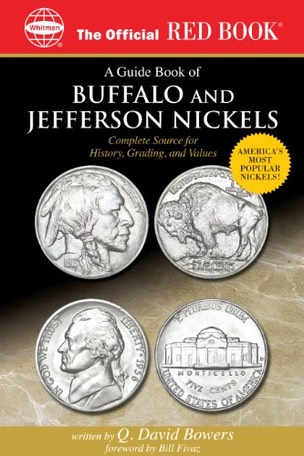
A Guide Book of Buffalo and Jefferson Nickels (Official Red Books) by Q. David Bowers (Author), Lawrence Stack (Editor), Bill Fivaz (Foreword, Contributor)
This is the eighth entry in Whitman's Bower Series of numismatic titles. Lavishly illustrated in full color, the Guide Book of Buffalo and Jefferson Nickels features high-resolution enlargements for important overdates and other varieties. These popular coins are given the famous Bowers treatment: insightful study, plenty of fascinating historical background, and good storytelling. Certified and surviving field populations, and historical and current market prices add to the book's reference value. Appendices cover error coins, pattern Buffalo nickels, and the chronology of the nickel five-cent piece. Full color throughout; illustrated; indexed.
Currency Note of the Month
1862 $1,000 Legal Tender Note. Let me first say that I have a personal interest in the note I am featuring this month. There are only 5 known of 3 types of this note currently known to exist which makes this an unbelievably rare type note. The last one publicly sold was in 2006 for $1,150,000! However, this would be appropriate since the portrait is of Robert Morris known as the “Financier of the Revolution”. At that time , he was considered the richest man in the colonies. He was also one of only 2 signers of the Ar- ticles of Confederation, Declaration of Independence, and the Constitution. He was George Washington’s first choice for Treasury Secretary but declined the position suggesting Alexander Hamilton instead. Unfortunately, he speculated heavily in land and went bankrupt in 1798. After 3 years in debtors prison he was released and lived out a quiet life until his death in 1806. His autograph is also highly collectible.
And my interest? My siblings genealogy researched has revealed that we are 6th gen- eration descendants of his. Too bad he went bankrupt!
NUMISMATIC AND HISTORICAL QUESTIONS AND FACT (MARCH)
Q. At a coin show, I met a currency dealer selling an unusual note called a “Postal
Note”. What are they?
A. Postal notes were the specialized money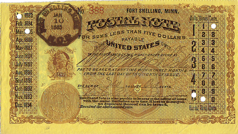
order successors to the United States Department of the Treasury's postage and fractional currency and were used from 1883 to
1894. They were created so Americans could
safely and inexpensively (for a three cent fee)
send sums of money under $5 to distant
places.
Postal Notes were privately produced by three different firms in six design types during three four-year contracts. Developed under Postmaster General Walter Q. Gresham, they were first issued at the nation's post offices on Monday, September 3, 1883. Numerous "first day" souvenir notes have survived.
While all six types are valuable, the earliest notes are the most valuable with denomination, serial number, town of issue, and condition being important factors when valuing a postal note.

Q. I heard there is a Canadian coin that has Morse code as part of its design?
A. From 1943-1945 the Canadian “Victory Nickel” design 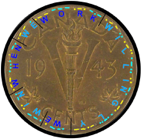 featured the phrase “We win when we work willingly” in Morse code around the edge on the reverse. The coins were made in two different
compositions. The 1943 version in a composition called “tombac” consisting of 88% copper and 12% zinc and the 1944 thru 1945
version chrome-plated steel. It also featured
a large “V” that stood for both Victory and the coins denomination. The basic design was reused in 2005 to commemorate the
60th anniversary of V-E Day but lacks the Morse code.
featured the phrase “We win when we work willingly” in Morse code around the edge on the reverse. The coins were made in two different
compositions. The 1943 version in a composition called “tombac” consisting of 88% copper and 12% zinc and the 1944 thru 1945
version chrome-plated steel. It also featured
a large “V” that stood for both Victory and the coins denomination. The basic design was reused in 2005 to commemorate the
60th anniversary of V-E Day but lacks the Morse code.
EDUCATIONAL FACT: The Queen's Beasts are ten heraldic statues representing the
genealogy of Queen Elizabeth II, depicted as the Royal supporters of England. They
stood in front of the temporary western annex to Westminster Abbey for the Queen's
coronation in 1953. Each of The Queen's Beasts consists of a heraldic beast support-
ing a shield bearing a badge or arms of a family associated with the ancestry of Queen
Elizabeth II. They were commissioned by the British Ministry of Works from sculptor
James Woodford (who was paid the sum of £2,750 for the work).
The beasts are listed as follows: The Lion of England, The White Greyhound of Rich-
mond, The Yale of Beaufort, The Red Dragon of Wales, The White Horse of Hanover,
The White Lion of Mortimer, The Unicorn of Scotland, The Griffin of Edward III, The Black Bull of Clarence, and The Falcon of the Plantagenets. The beasts are some six
feet high and weigh about 700 pounds each. They are works in plaster, and so cannot
be left exposed to the elements. 
In June 1959, the Canadian government accepted custody of the beasts and they were shipped there in July. Originally, the only colored parts of the statues were their heraldic shields; but, for the celebrations of the Centennial of Canadian Confederation in 1967, the statues were painted in their full heraldic colors. They are now in the care of the Canadian Museum of History in Gatineau.
 In 2016 the Royal Mint began to issue The Queen's
Beasts coins in platinum, gold and silver. Each of the
10 planned coins in the series features a stylized ver-
sion of one of the heraldic Queen's Beasts statues
present at the coronation of Queen Elizabeth II. The
silver coin is notable as the first two-ounce United
Kingdom silver bullion coin.
In 2016 the Royal Mint began to issue The Queen's
Beasts coins in platinum, gold and silver. Each of the
10 planned coins in the series features a stylized ver-
sion of one of the heraldic Queen's Beasts statues
present at the coronation of Queen Elizabeth II. The
silver coin is notable as the first two-ounce United
Kingdom silver bullion coin.
Coin of the Month

New Zealand $1 In 1991 the $1 and $2 New Zealand coins were introduced to replace the $1 and $2 currency notes then in circulation. This is the New Zealand $1coin currently in circulation.
The obverse features a portrait of Queen Elizabeth II and the reverse features the Kiwi bird and the silver fern.
They have the following specs, weight 8 grams, diameter: 23 mm, composition: Aluminum
Bronze, Intermittent milled edge. The coins are minted by the Royal Canadian Mint for the
New Zealand Reserve Bank.
Website of the Month
 The World Coin Price Guide is a complete catalog of values for World coins from 1600 to date. Created by NGC and Krause Publications’ NumisMaster, the price guide pages
are arranged by Krause catalog numbers and include values, images and specifications such as weight, composition, engraver and current bullion values. Found at
NGCcoin.com, it is the most comprehensive online valuation guide available, and is
free to all users. (ngccoin.com) This site makes identifying specific coins a simple
process and is invaluable for the collector of foreign coins. The specific world coin site
is at https://www.ngccoin.com/price-guide/world/.
The World Coin Price Guide is a complete catalog of values for World coins from 1600 to date. Created by NGC and Krause Publications’ NumisMaster, the price guide pages
are arranged by Krause catalog numbers and include values, images and specifications such as weight, composition, engraver and current bullion values. Found at
NGCcoin.com, it is the most comprehensive online valuation guide available, and is
free to all users. (ngccoin.com) This site makes identifying specific coins a simple
process and is invaluable for the collector of foreign coins. The specific world coin site
is at https://www.ngccoin.com/price-guide/world/.
Currency Note of the Month
 New Zealand $5 (Series 7). The New Zealand $5 Series 7 was introduced in 2015 and
is the latest issue of the $5. It is a polymer note with a number of security features including transparent windows with an embossed denomination and fern leaf, a watermark image of Queen Elizabeth II, raised printing, micro-printed letters, and the denomination glows under black light.
New Zealand $5 (Series 7). The New Zealand $5 Series 7 was introduced in 2015 and
is the latest issue of the $5. It is a polymer note with a number of security features including transparent windows with an embossed denomination and fern leaf, a watermark image of Queen Elizabeth II, raised printing, micro-printed letters, and the denomination glows under black light.
The obverse features Sir Edmund Hillary with the New Zealand mountain Aoraki/Mount
Cook in the background. The reverse has a Campbell Island scene featuring a yelloweyed penguin, the Campbell Island daisy, and the Ross lily.
The New Zealand dollar is the official currency and legal tender of New Zealand, the
Cook Islands, Niue, the Ross Dependency, Tokelau, and a British territory, the Pitcairn
Islands.
In 2015, this note was awarded “Best Banknote of the Year” by the International Banknote Society.
NUMISMATIC AND HISTORICAL QUESTIONS AND FACT (FEBRUARY)
Q. Are ”Binion” attributed coins worth more than similarly graded coins? 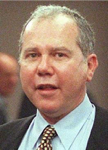
A. The story of Ted Binions’ murder and his hoard of silver has been told across every type of medium known, including movies, TV, books, and magazine articles. After his murder, over $7 million in bulk silver and coins was recovered from an underground vault owned by him in Nevada.

Spectrum Numismatic International (SNI) purchased the coins in November 2001 for $3 million. Marketing of the coins was as- signed to Goldline International, Inc. There were over 100,000 Morgan and Peace silver dollars, and an unspecified number of lesser value silver coins. The coins were authenticated and graded by Numismatic Guaranty Corporation (NGC), and a unique white and green label was designed for the pedigree. While Binion pedigreed coins are a niche collectible due to their story, the coins are not known for their collector quality. There have been a number of “sets”, date and mintmark, or by de- nomination put together for collectors. There are also 3 grading types, a “hard’ grade with a grading number, a “soft’ grade with descriptive grades like “Uncirculated” or “BU”, and others with just the Binion attribute.
To answer the initial question however, there is a minimum of a premium for just the attribution label although the coins have an interesting story.
Q. What is a charge coin?
A. Charge coins were the forerunners of our current credit cards used as an easy way to extend credit to pre-approved customers. They were issued by department stores and other retail and service businesses beginning in the late 19th century. The typical example will have the customer's credit account number on one side and a business logo on the other.
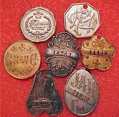

Frequently they were issued holed to facilitate attachment to a key ring, fob or necklace. A wide range of businesses issued these tokens, aside from department stores, many were also used by clothing, shoe and jewelry stores. Still others were issued by taxicab, hotel, restaurant, nightclub and car rental concerns.
Odd shapes are almost the norm and while many are oval others have fancy flourishes added to a basic shape and still others are figural in nature in forms such as shirts, coats, hats, keys, shoes, etc. Pennsylvania charge coins are the most numerous, followed distantly by New York, with over 700 types of the coins from many states and geographical areas known.
EDUCATIONAL FACT: While the Dead Seascrolls are exceptional for their historical and religious significance, there was also discovered a unique scroll with a much different message.
The Copper Scroll is one of the Dead Sea Scrolls found near Khirbet Qumran, but differs significantly from the others. Whereas the other scrolls are written on parchment or papyrus, this scroll is written on metal: copper mixed with about 1percent tin. Unlike the others, it is not a literary work, but a list of places where various items of gold and silver are buried or hidden. It differs from the other scrolls in its Hebrew, its orthography, palaeography (forms of letters), and date.
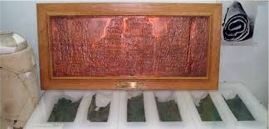
While most of the Dead Sea Scrolls were found by Bedouins, the Copper Scroll was discovered by an archaeologist. The scroll, on two rolls of copper, was found on March 14, 1952 at the back of Cave 3 at Qumran. The corroded metal could not be unrolled by conventional means and so the Jordanian government sent it to Manchester University's College of Technology on the recommendation of English archaeologist and Dead Sea Scrolls scholar John Allegro for it to be cut into sections, allowing the text to be read. He arranged for the university's  Professor H. Wright Baker to cut the sheets into 23 strips in 1955 and 1956. It then became clear that the rolls were part of the same document. Allegro, who had supervised the opening of the scroll, transcribed its contents immediately, however due to a number of factors, including not having a vocabulary reference, an unusual script style from having been chiseled into the copper sheet, and possibly the illiteracy of the original scribe, a definitive translation is not possible.
Professor H. Wright Baker to cut the sheets into 23 strips in 1955 and 1956. It then became clear that the rolls were part of the same document. Allegro, who had supervised the opening of the scroll, transcribed its contents immediately, however due to a number of factors, including not having a vocabulary reference, an unusual script style from having been chiseled into the copper sheet, and possibly the illiteracy of the original scribe, a definitive translation is not possible.
 With those translation problems aside, it appears the text is an inventory of 64 locations; 63 of which are treasures of gold and silver, which have been estimated in the tons. For example, one single location described on the copper scroll describes 900 talents (868,000 troy ounces) of buried gold. Tithing vessels are also listed among the entries, along with other vessels, and three locations featured scrolls. One entry apparently mentions priestly vestments. The final listing points to a duplicate document with additional details. That other document has not been found.
With those translation problems aside, it appears the text is an inventory of 64 locations; 63 of which are treasures of gold and silver, which have been estimated in the tons. For example, one single location described on the copper scroll describes 900 talents (868,000 troy ounces) of buried gold. Tithing vessels are also listed among the entries, along with other vessels, and three locations featured scrolls. One entry apparently mentions priestly vestments. The final listing points to a duplicate document with additional details. That other document has not been found.
An English translation of the opening lines of the first column of the Copper Scroll shows the basic structure of each of the entries in the scroll. The structure is 1) general location, 2) specific location, often with distance to dig, and 3) what to find.
In 1962 Allegro led an expedition to search for some of the treasure. By following some of the places listed in the scroll, the team excavated some potential burial places for the treasure. However, the treasure hunters turned up empty handed. Thus, a treasure has yet to be found.
Book of the Month
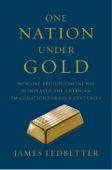 One Nation Under Gold: How One Precious Metal Has Dominated the American Imagination for Four Centuries
One Nation Under Gold: How One Precious Metal Has Dominated the American Imagination for Four Centuries
by James Ledbetter
One Nation Under Gold examines the countervailing forces that have long since divided America―whether gold should be a repos- itory of hope, or a damaging delusion that has long since derailed the rational investor.
Worshipped by Tea Party politicians but loathed by sane economists, gold has historically influenced American monetary policy and has exerted an often outsized influence on the national psyche for centuries. Now, acclaimed business writer James Ledbetter explores the tumultuous history and larger-than-life personali- ties―from George Washington to Richard Nixon―behind America’s volatile relation- ship to this hallowed metal and investigates what this enduring obsession reveals about the American identity.
One Nation Under Gold reveals as much about American economic history as it does about the sectional divisions that continue to cleave our nation, ultimately becoming a unique history about economic irrationality and its influence on the American psyche.
Coin of the Month
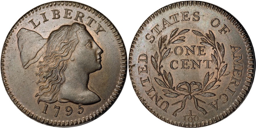
Liberty Cap Large Cent The Liberty Cap large cent was a type of large cent struck by the United States Mint from 1793 until 1796, when it was replaced by the Draped Bust large cent. The coin features an image of the goddess of Liberty and her accompanying Phrygian cap. The reverse features a Wreath tied with a “Double bow” ribbon and the denomination of One Cent.
The Liberty Cap large cent was created in an attempt to satisfy the public objections to the Chain cent and Wreath cent. It appears to have been a little more successful than its prece- dents, as it was continued into 1797, unlike the previous two issues, which were issued for one year only. Originally having a “vine and bars” or a “lettered” edge, in late 1795, the planchets became too thin to allow for the use of the edging used on the earlier coins, so coins from late 1795 onward have a plain edge. There are over 100 varieties of this coin, mostly variations produced by the differences in individual dies. Approx. 1.5 million of all varieties were produced from 1793-1796 at the Philadelphia mint. They have the following specs, thick planchet weight: 13.48 grams, thin planchet weight 10.89 grams, diameter: 29 mm, composition: Copper. Lettered, reeded, and plain edges. Designer: Joseph Wright (thick planchet) and John Smith (thin planchet).
Currency Note of the Month
 1890 $2 Treasury Note. The $2 Treasury Note (also known as a Coin Note) was a type of representative money issued by the United States government from 1890 until 1893 under authority of the Sherman Silver Purchase Act. It was issued in two series: an 1890 series and an 1891 series with the distinguishing feature of the Series 1890 note being the extremely ornate design on the reverse side of the note. The intent of this was to make counterfeiting much more difficult, but opponents of the design argued that the extensive detail would make it more difficult to distinguish between genuine and counterfeit notes. Consequently, the reverse design was simplified on the Series 1891 Treasury Note issued the following year.
1890 $2 Treasury Note. The $2 Treasury Note (also known as a Coin Note) was a type of representative money issued by the United States government from 1890 until 1893 under authority of the Sherman Silver Purchase Act. It was issued in two series: an 1890 series and an 1891 series with the distinguishing feature of the Series 1890 note being the extremely ornate design on the reverse side of the note. The intent of this was to make counterfeiting much more difficult, but opponents of the design argued that the extensive detail would make it more difficult to distinguish between genuine and counterfeit notes. Consequently, the reverse design was simplified on the Series 1891 Treasury Note issued the following year.
The Treasury Notes were issued by the government to individuals selling silver bullion to the Treasury. Unlike other redemption notes like silver and gold certificates (which stipulated whether the note was backed by and redeemable for silver or gold coin, respectively), Treasury Notes stipulated only that they were redeemable in coin. This allowed the Treasury to fulfill the note's obligation in silver coin, gold coin, or both, at its discretion when the note was redeemed. This flexibility allowed the Treasury some control over releasing gold or silver when the relative value of the two metals fluctuat- ed.
The portrait on the face is of noted Union General James McPherson, who was killed on the first day of the Battle of Atlanta. He was the second highest ranking Union Officer killed in the Civil War.
NUMISMATIC AND HISTORICAL QUESTIONS AND FACT (JANUARY)
Q. What is an “Omega” coin?
A. In the early 1970’s counterfeit U.S. gold coins started being discovered in the marketplace. The coins were primarily 1907 High Relief $20, and 1882 Indian Head $3 gold pieces although there were other gold coins also. They were expertly counterfeited and since the only grading/authentication service in those days was ANACS they had been, and were being, extensively traded and sold.
The coins got their moniker “Omega” because the counterfeiter had the temerity to engrave a very faint and small Greek letter “Omega” as his signature on each coin. Once ANACS was able to identify the coins, through both the symbol and a number of diagnostic characteristics, the damage to the collecting community was assessed. Then, after confirmation of the diagnostics by the Secret Service they were released to the public to help r id the collecting community of them.
The counterfeiter was never identified. It is estimated that he/she produced approximately 20,000 counterfeits that, if genuine, would be worth $300 million today. The quality is so high that a number of collectors of counterfeits actively seek them out.
Q. I recently saw a colonial note from the “Virginia James River Bank”. I had thought that colonial currency had only been issued by individual colonies or the Continental Congress?
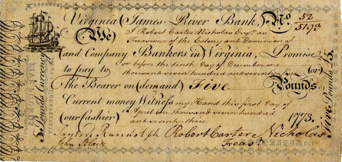
A. In both 1769 and 1771, Virginia issued Treasury notes. However, they were so rampantly counterfeited that they decided to recall the notes and issue replacements. Printing paper was in extremely short supply but there was a quantity of good grade paper notes that had been brought from England for the creation of the Virginia James River Bank. However, the British Crown had refused to approve the bank so the notes were not used. After approval by the Virginia Assembly, the notes were printed on the back with the denomination, the warning “Death to Counterfeit”, and a typeset border. The faces were then filled in by hand with the inapplicable portions marked by parentheses and then hand signed with 3 signatures. The original notes were then immediately recalled and exchanged. Properly engraved and printed blank notes, arrived later in the year from England but those too were soon used up and the remaining Virginia James Bank notes were issued in 1775 to complete the issuance of notes authorized by the Virginia Assembly.
EDUCATIONAL FACT: The term “Snake Oil” originates from 19th-century Chinese railroad workers who used a medicine made from the Chinese water snake. This concoction actually worked! It was rich in Omega-3 fatty acids and it effectively treated conditions such as arthritis and bursitis and Americans were impressed by its healing powers. 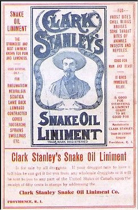
However, the term took on a new meaning when phony patent medicines, and the hucksters that sold them, promised to cure every disease known to man. Made up of mostly alcohol, this type of “snake oil” convinced people that they felt better without actually treating the ailment. Also, since America did not have Chinese water snakes, some entrepreneurs used rattlesnakes. One of the best known was Clarke Stanley, the self proclaimed “Rattlesnake King”, who claimed to have been tutored by Hopi medicine men in Arizona. He decep- tively used mineral oil to make his “snake oil” liniment more effective. Part of his sales pitch consisted of pulling a rattlesnake out of a sack, cutting it open, and then adding it to a pot of boiling water that was supposedly being brewed into his patent medicine!
Book of the Month
A Nation of Counterfeiters: Capitalists, Con Men and the Making of the United States by Stephen Mihm (Author)
and the Making of the United States by Stephen Mihm (Author)
Few of us question the slips of green paper that come and go in our purses, pockets, and wallets. Yet confidence in the money supply is a recent phenomenon: prior to the Civil War, the United States did not have a single, national currency. Instead, countless banks issued paper money in a bewildering variety of denominations and designs- more than ten thousand different kinds by 1860. Counterfeiters flourished amid this anarchy, putting vast quantities of bogus bills into circulation. Their success, Stephen Mihm reveals, is more than an entertaining tale of criminal enterprise: it is the story of the rise of a country defined by a freewheeling brand of capitalism over which the federal government exercised little control. It was an era when responsibility for the country's currency remained in the hands of capitalists for whom "making money" was as much a literal as a figurative undertaking.
Mihm's witty tale brims with colorful characters: shady bankers, corrupt cops, charismatic criminals, and brilliant engravers. Based on prodigious research, it ranges far and wide, from New York City's criminal underworld to the gold fields of California and the battlefields of the Civil War. We learn how the federal government issued green-backs for the first time and began dismantling the older monetary system and the counterfeit economy it sustained.
A Nation of Counterfeiters is a trailblazing work of history, one that casts the country's capitalist roots in a startling new light. Readers will recognize the same get-rich-quick spirit that lives on in the speculative bubbles and confidence games of the twenty-first century.
Coin of the Month

1944 50 Centavo PhilippineCoin Philippine coinage is avidly collected in the United States and this is a 1944 50 Centavo Philippine coin minted by the United States Mint in 1944. On the obverse the standing figure of Liberty was utilized. She is clad in a long, flowing gown and holds in her right hand a hammer, resting atop an anvil. Behind her is Mt. Mayon, a volcanic mountain southeast of the capital city of Manila. The denomination appears above her, Fifty Centavos, in English, while the name of the archipelago is written below in Spanish as FILIPINAS. The reverse is the coat of arms of the Commonwealth of the Philippines. Around this appears the legend UNITED STATES OF AMERICA, the S mint mark, and the date of coinage. Almost 40 million were produced in 1944-1945 at the San Francisco mint, they have the following specs, weight: 10 grams, diameter: 27.5 mm, composition: .750 silver and .250 Copper. Reeded edge.
Currency Note of the Month

One Peso Philippine “Victory” note. The 'Victory' note series was printed for use in the Philippines in 1944, to be used upon the return of General MacArthur. When he came ashore in Leyte on Oct. 20th, 1944, he was purportedly carrying some of these in his pocket. They definitely brought many crates full of these notes with them during this landing. They were printed in 8 denominations up to 500 Peso’s, the base 1 Peso is shown.
VICTORY notes were printed at the U.S. Bureau of Engraving and Printing and were the last Philippine currency printed by the US. There are replacement notes and they are indicated by a star prefix to the serial number.
The notes carry the Series #66 and according to a BEP report the number was chosen because that was President Quezons age when he died just prior to the liberation of the Philippines.
These currency notes were for use only in the Philippines, and were obligations of the Philippine Treasury. The 500 Peso Philippine Victory Notes were demonetized by the Philippine government on December 31, 1957, and were withdrawn from circulation. At that point, other denominations of the Philippine Victory Notes, Victory Series 66, were no longer regarded as legal tender but could be exchanged or replaced at par, without charge, for legal currency until July 30, 1967. After that date, the Series 66 notes were considered demonetized.
NUMISMATIC AND HISTORICAL QUESTIONS AND FACT (DECEMBER)
Q. Is there any traditions associated with chocolate coins or are they just childrens’ treats? 
A. According to Wikipedia, Chocolate coins, or chocolate money, are foil covered chocolates in the shape of coins. The gifting of chocolate coins to children is a Christmas tradition in parts of Europe, and may also occur on Saint Nicholas' Day. Chocolate coins have also been incorporated into Jewish celebrations, as Hanukkah gelt and St. Patrick's Day as gifts left behind from Leprechauns the night before.
As a Christmas tradition, the chocolate coin giving was thought to be started by the deeds of Saint Nicholas. He was the bishop of Myra in Lycia, which is now considered Turkey. Although there isn't any written documentation, many legends speak of his kindness to children. He was said to be an incredibly shy person and wanted to give money to the poor children of Myra without them knowing about it. One night he climbed on a roof and threw a purse of money down a chimney, which landed in a pair of stockings that a little girl had hung up to dry. Every year Saint Nicholas would keep giving coins or money to the children of Myra.
In the United Kingdom chocolate coins mimic the design of real money; they are 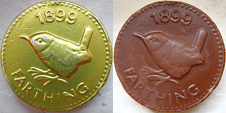 traditionally bought around Christmas and are used to decorate the Christmas tree and to fill the stockings of children. When children visit a friend or relative they are allowed to find and take chocolates from the tree as a treat. A variant of this is that chocolate coins are hidden somewhere in the house for children to find, often in the form of a treasure trail.
traditionally bought around Christmas and are used to decorate the Christmas tree and to fill the stockings of children. When children visit a friend or relative they are allowed to find and take chocolates from the tree as a treat. A variant of this is that chocolate coins are hidden somewhere in the house for children to find, often in the form of a treasure trail.
Q. I’ve heard that the Czech people have some interesting Christmas traditions relating to money?
A. Carp is the traditional Christmas fish that is served usually either fried and/or  as the basis for fish soup. Before serving, fish scales are placed under the plate or the tablecloth to bring prosperity to the person and the house. Fish scales are believed to symbolize wealth and money because of their resemblance to silver coins. Some Czechs also carry fish scales in their wallets to make sure
as the basis for fish soup. Before serving, fish scales are placed under the plate or the tablecloth to bring prosperity to the person and the house. Fish scales are believed to symbolize wealth and money because of their resemblance to silver coins. Some Czechs also carry fish scales in their wallets to make sure that they never run out of money. However, this tradition may also be related to how well attached fish scales are to the original host and the hope that the person will also be as well attached to their money! The carp are also traditionally purchased live and are usually kept in the bathtub prior to their being prepared!
that they never run out of money. However, this tradition may also be related to how well attached fish scales are to the original host and the hope that the person will also be as well attached to their money! The carp are also traditionally purchased live and are usually kept in the bathtub prior to their being prepared!
EDUCATIONAL FACT: With winter holidays just around the corner, Christmas tree competition is heating up and Germany is taking the lead as it unveils its own solid- gold version worth $2.6 million.
Dubbed by its creators as “the most expensive” Christmas tree in Europe, the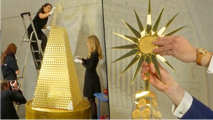 festive gold creation is made up of 2,018 solid gold one-ounce Vienna Philharmonic coins, topped by a massive 20-ounce coin, which is placed into a golden star.
festive gold creation is made up of 2,018 solid gold one-ounce Vienna Philharmonic coins, topped by a massive 20-ounce coin, which is placed into a golden star.
It took more than one hour to assemble the tree as all the gold coins had to be placed on an acrylic Christmas tree shape. Once completed, the tree weighed around 63 kilo- grams (138.6 lbs.) in pure gold.
Munich-based gold dealer Pro Aurum is the genius behind the creation of the three- meter-high tree, which will be left up at the dealer’s gold-house until December 15. Pro Aurum cooperated with the Australian Mint to get the tree up and ready to go.“The Christmas tree is special because of its value,” Pro Aurum spokesman Benjamin Summa told Reuters. “At the current rate that has a value of about 2.3 million euros [USD $2.6 million].” (Kitco News)
Ed. Note: While this is the most valuable Christmas tree in Europe, the $11.4 million tree at the Emirates Palace Hotel in Abu Dhabi and the $4.2 million Ginza Tanaka Disney Gold Christmas Tree in Tokyo lead the way in “Most Valuable Christmas trees”. See www.financesonline.com for a list and photos of the top ten.
Website of the Month
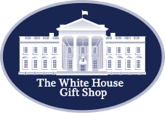 While not specifically numismatic related, the White house Gift Shop, www.whitehousegiftshop.com, carries a wide variety of collectibles and a number of tokens, coins, and medals. The White House Gift Shop is the only entity of its kind in White House history and originates from a permanent memorandum by President Harry S. Truman to mem- bers of the U.S. Secret Service. The White House Gift Shop® has been granted trademark registration protections by the United States Patent and Trademark Office. In November of 1950, by order of President Harry S. Truman with operational oversight by then Chief of Secret Service, James J. Rowley and U.S. Army General Harry Vaughan, Aide to President Truman, and Secret Service members, the White House Flower Fund became the White House Security Fund then the U.S. Secret Service Uniformed Division Fund which soon, thereafter, became the White House Gift Shop. Back then, the White House Gift Shop was located in the basement of the White House and later relocated to the Executive Office Building in an area known as the old War Department. On January 1, 1998, the White House Gift Shop opened an online store for your accessibility and convenience.
While not specifically numismatic related, the White house Gift Shop, www.whitehousegiftshop.com, carries a wide variety of collectibles and a number of tokens, coins, and medals. The White House Gift Shop is the only entity of its kind in White House history and originates from a permanent memorandum by President Harry S. Truman to mem- bers of the U.S. Secret Service. The White House Gift Shop® has been granted trademark registration protections by the United States Patent and Trademark Office. In November of 1950, by order of President Harry S. Truman with operational oversight by then Chief of Secret Service, James J. Rowley and U.S. Army General Harry Vaughan, Aide to President Truman, and Secret Service members, the White House Flower Fund became the White House Security Fund then the U.S. Secret Service Uniformed Division Fund which soon, thereafter, became the White House Gift Shop. Back then, the White House Gift Shop was located in the basement of the White House and later relocated to the Executive Office Building in an area known as the old War Department. On January 1, 1998, the White House Gift Shop opened an online store for your accessibility and convenience.
Coin of the Month
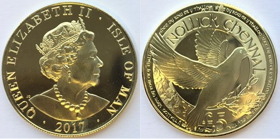
Isle of Man 2107 Christmas Peace coin. The Christmas £5 coin features a Dove (the universal symbol of peace) with outstretched wings, carrying an olive branch. This is surrounded by a Christmas wreath; the coin bears the inscription “Nollick Ghennal” which is Manx for Merry Christmas. The engraving around the edge of the coin is “Shee dy row er y thalloo” which translates as Peace on Earth. 32 mm in diameter with a milled edge, they are made of what is called Alpaca metal which is a metal alloy of copper, nickel and sometimes zinc or iron. The metal is a shiny silver color that looks similar to stainless steel. It does not contain any Alpaca (the animal). :) There are both proof and BU versions.
Currency Note of the Month
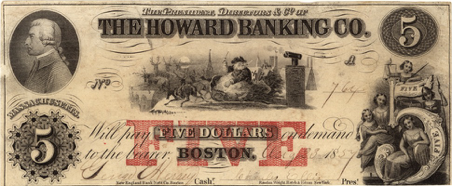
Santa Claus Bank Note. Issued in the 1850s by the Howard Banking Company of Boston Mass. this five dollar bill featuring Santa Claus actually functioned as legal tender. Now called "obsolete bank notes," the bills varied in design from bank to bank and were often quite colorful. The issuing institutions typically used stock images provided by the companies that en- graved and printed the currency.
A number of banks made use of Santa Claus illustrations in the 1850s—the most logical being the St. Nicholas Bank of New York City. This note was printed by the New England Bank Note Co. of Boston and engraved by Rawdon, Wright, Hatch & Edson of New York. The Santa who graces this Howard Banking Company bill is descended from Sinter Klaas, a traditional figure brought by Dutch settlers to New York in the 17th century.
NUMISMATIC AND HISTORICAL QUESTIONS AND FACT (NOVEMBER)

Q. I’ve noticed that a number of currency vignettes are actually engravings of sculptures. Have any coin designers had their non-coin sculptures used on currency?
A. None that were specifically selected and engraved a a vignette. It
would seem that, as artists, sculptors’ tend to submit coin designs
and engravers work on currency. However, James Earle Fraser, the designer of the Indian Head 5 cent piece, was also the sculptor of a statue of
Alexander Hamilton that stands in front of the U.S. Treasury building. The reverse of the current $10 bill has an engraving of the
Treasury building that includes the Hamilton statue out front. So,
technically, James Earle Fraser is the is the only coin designer to
have sculpture work in both coin and currency formats!
However, James Earle Fraser, the designer of the Indian Head 5 cent piece, was also the sculptor of a statue of
Alexander Hamilton that stands in front of the U.S. Treasury building. The reverse of the current $10 bill has an engraving of the
Treasury building that includes the Hamilton statue out front. So,
technically, James Earle Fraser is the is the only coin designer to
have sculpture work in both coin and currency formats!
Q. I went to sell my scrap gold and they used what they called a “touchstone” to determine the purity. What is a touchstone?
A. Assaying by “touch” was one of the earliest methods employed to assess the quality of precious metals. The touchstone was used by the Indus Valley civilization about
3500 BC for testing the purity of soft metals. It was also used in Ancient Greece. A
touchstone is a small tablet of dark stone such as fieldstone, slate, or lydite, used for
assaying precious metal alloys. It has a finely grained surface on which soft metals
leave a visible trace.The metal to be assayed is rubbed on the touchstone, adjacent to
the rubbing on the touchstone of a sample
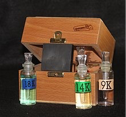 of a metal of known purity. The streaks of
metal left behind on the touchstone are then treated with nitric acid of various concentrations, which dissolves impurities, and
thus, when the streaks are compared, the contrast between
pure and impure metal is heightened. Because other metals,
such as copper, can be alloyed to silver without significantly
changing its colour, the touchstone method is not usually em-
ployed now to assay silver. It is still used, however, to assay
gold and provides a reasonably accurate guide to quality.
of a metal of known purity. The streaks of
metal left behind on the touchstone are then treated with nitric acid of various concentrations, which dissolves impurities, and
thus, when the streaks are compared, the contrast between
pure and impure metal is heightened. Because other metals,
such as copper, can be alloyed to silver without significantly
changing its colour, the touchstone method is not usually em-
ployed now to assay silver. It is still used, however, to assay
gold and provides a reasonably accurate guide to quality.
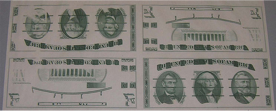 EDUCATIONAL FACT: Giori Test Notes were printed on a press designed in the
EDUCATIONAL FACT: Giori Test Notes were printed on a press designed in the
1970s in Geneva, New York, by an en- gineer working for the American Bank
Note Company. Some of these notes were saved by the designer of the press
and were sold from his estate to the numismatic market by a family member,
and are one of the largest groups of these famous “test notes” to ever become available to the collecting community.
The engineer who designed the press for the American Bank Note company, Edgar L.
Pigman, was an engineer with the American Can Company's Geneva, NY location. He
was contracted by the American Bank Note Company, who had subcontracted the work
from the Bureau of Engraving and Printing, to design the press. They were originally
designed to help improve the BEP’s printing process and modernize the machinery, although the project was eventually scrapped.
The machines, shipped to Washington DC after they were built in Geneva, used plates
from the Bureau to create a number of “test sheets” of notes using "nonsense plates".
These plates displayed approximately 32 different vignettes, including portraits of Presidents Washington, Lincoln, and Grant that are identical to those on the $1, $5 and $50
Federal Reserve Notes that were then in current circulation. Originally they were considered by the BEP as illegal for collectors to own, since they somewhat resembled authentic circulating currency, but the restriction on private ownership has since been lifted. A number of currency dealers have individual notes for sale with a large number
coming from the horde saved by the original engineer.
Book of the Month

The Definitive Guide to Collecting, Investing & Stacking Silver Bullion: 2018 Edition by Michael Allawah
Silver has been called both the “investment of the decade” by billionaire Eric Sprott and the “Devil’s Metal” by John Levin in the recent past. Those who have been brave enough to collect, invest, or stack silver can certainly attest to both perspectives. The precious metal skyrocketed in price to a high of $49.80 per ounce on the 25th of April 2011, before plummeting back down to the narrow trading range where it has languished for the better part of seven years. This has provided collectors, investors and stackers with an ideal opportunity to accumulate the metal, or equivalent investments, at historically low prices. In stark contrast to the price of the metal has been investment demand, which has been relentless. This investment demand has spurred a plethora of new silver bullion coin releases that have been a boon to collectors. The intent of this book is to provide a comprehensive guide for silver enthusiasts of all types, including collectors, investors and stackers, and all levels of expertise, from those looking at joining the ranks of silver enthusiasts to silver veterans. The guide is comprehensive in terms of both breadth and depth. Specifically, it contains well over two hundred pages of silver content specifically targeted at collectors, investors and stackers, including in excess of 400 original photos of silver coins from over forty countries. The book also lays out the case for silver, demonstrating in a clear and concise manner how the price of the underlying asset has very little downside and extraordinary upside if specific events come to fruition. Rather than dealing in generalities, the guide details specific accumulation strategies for all three types of silver enthusiasts.
Coin of the Month
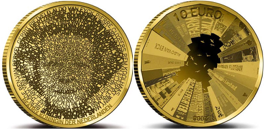
A new 10 euro commemorative coin pays tribute to the history of Dutch architecture.
The Architecture ten-euro coin was designed by artist Stani Michiels (b. 1973). The design on the obverse of the coin pays tribute to the history of Dutch architecture, with
the portrait of Queen Beatrix being distinctively constructed using the names of important architects from Dutch history. The artist used the internet as a popularity-meter to
determine the names’ order of appearance.
The reverse of the Architecture ten-euro coin draws attention to the striking fact that
many Dutch architects have also included publishing books on architecture in their professional activities. To illustrate this phenomenon, recent books on architecture rise up
from the sides of the coin like buildings. Through their careful placement they combine
to outline the Netherlands, while birds’ silhouettes suggest the capitals of all the provinces.
The other interesting fact about this coin design is that it was entirely computer designed and generated using Linux based programs that are available for free!
Currency Note of the Month

In an attempt to stimulate a little interest in International Banknote collecting I selected
this unusual country.
Transnistria, officially the Pridnestrovian Moldavian Republic is an unrecognized state
which split off from Moldova after the dissolution of the USSR and mostly consists of a
narrow strip of land between the river Dniester and the territory of Ukraine. Transnistria
has been recognized only by three other mostly non-recognized states: Abkhazia, Artsakh, and South Ossetia. The region is considered by the UN to be part of Moldova.
Transnistria is an unrecognized but de facto independent semi-presidential republic
with its own government, parliament, military, police, postal system, currency and vehicle registration. Its authorities have adopted a constitution, flag, national anthem and
coat of arms. It is the only country still using the hammer and sickle on its flag.
The ruble is the currency of Transnistria and is divided into 100 kopecks. There are
currently 6 denominations of banknotes, 1-100 Rubles and 4 denominations of coins,
1-10 Kopecks. The Transnistrian Ruble is generally not accepted as currency outside
of Transnistria,
NUMISMATIC AND HISTORICAL QUESTIONS AND FACT (October)
Q. I noticed some silver certificates that had a small red “R” or an “S” on them. Are they rarer or more valuable than other Silver Certificates?
A. In 1944 the Bureau of Engraving and Printing decided to experiment with a new pa- per for silver certificates. Some 1935A silver certificates were marked with a red “R” to designate the regular paper; others were marked with a red “S” to signify that they were printed on special paper. 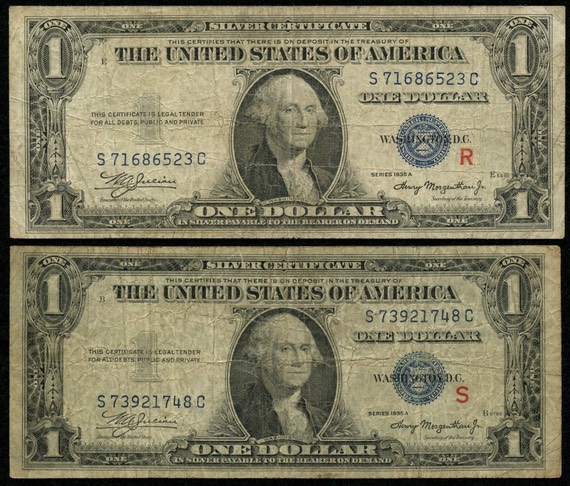 All told 1,184,000 of each type of note was printed. No conclusive results were reached and today we have a nice collectible item thanks to the attempts. You can buy a heavily circulated red R or red S note for less than $50. Uncirculated examples are common and available; they tend to sell for around $250.
All told 1,184,000 of each type of note was printed. No conclusive results were reached and today we have a nice collectible item thanks to the attempts. You can buy a heavily circulated red R or red S note for less than $50. Uncirculated examples are common and available; they tend to sell for around $250.
It is important to know the serial number ranges for these types of notes. Some less than scrupulous people have been known to just stamp an R or S on any 1935A $1 silver certificate. If your experimental note is not in the following range, then it is forged:
Red S – S73884001C – S75068000C
Red R – S70884001C – S72068000C
The rarest form of the experimental silver certificate is the star note. Only 24,000 were printed, 12,000 for the red R and 12,000 for the red S. These are very rare. The serial number range for stars are as follows:
Red S – *91188001A – *91200000A Red R – *91176001A – *91188000A
Q. What are the 8 animals that were on the first issues of Irish Republic coinage in 1928?
A. In 1926 the government of the newly founded Irish Free State formed a coinage committee to plan for a new Irish coinage. After some deliberation the committee de- cided that the Irish harp would be used as the national symbol on the coinage, as it had been since the 1530’s, and that the reverse designs would feature a series of animals important to Ireland's mainly agricultural economy.
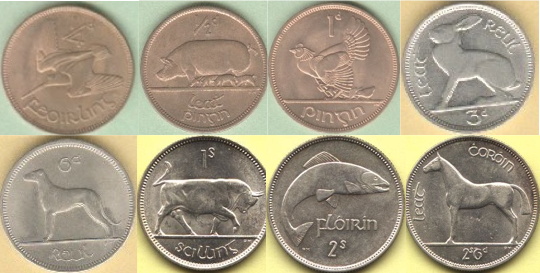
There were 8 denominations ranging from the farthing to the half-crown with the following animals on the reverse.
A Woodcock in flight, a sow with piglets, a hen with chicks, a hare, an Irish Wolfhound, a bull, a salmon, and a horse.
These type coins were initially struck starting in 1928 and all eight have since been demonetized and replaced.
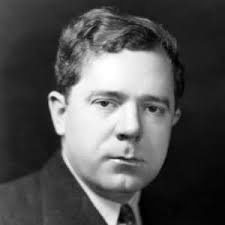
EDUCATIONAL FACT: Donald Trump is not the first controversial politician in American history and probably won’t be the last. Governor, later Senator, Huey P. Long, of Louisiana, was among the most controversial politicians of his time and will always rank near the top of the list for his colorful statements. But, politics only play a peripheral role in what is known as the “Huey Long Toilet Seat Medal”. The medal commemorates a social function held at the Sands Point Country Club, on Long Island, New York. Long’s political rhetoric made him many enemies among the country club set, so his presence at Sands Point was probably not appreciated. As was his habit, Long drank heavily that evening and, when nature called, he went to the men’s room, only the discover that every facility was occupied. The story goes that he relieved himself on the shoes and pants leg of the man standing next to him. That man, who has never been identified, took umbrage and proceeded to punch Long in the face, giving him a black eye that was featured in the anti-Long press for some time. The owner of Colliers Magazine was so pleased with the incident that he began to raise funds to recognize Long’s assailant with a gold medal. The assailant never came forward to claim his medal, so Colliers gave the medal to the American Numismatic Society. In addition to the gold medal, the Medallic Art Company struck a few in silver and approx. 500 in bronze.
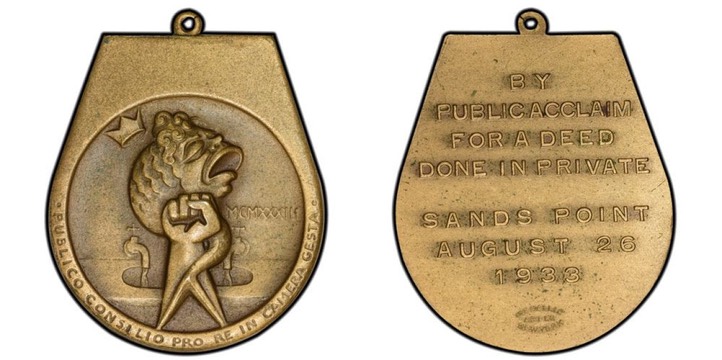
The bronze medal, 38x33mm, is in the shape of a toilet seat. The obverse depicts a fish being punched in the face and losing its crown (Long was called “The Kingfish”). Two bathroom faucets run the background, which also bears the year “MCMXXXIII” (1933) of the event. A Latin inscription around the edge is often translated as “Public acclaim for a deed done in private”. The reverse of the medal bears that translation and “Sands Point/August 26.1933′′. The medal is marked by the Medallic Art Company on the reverse and bears the artist’s initials, GZ (George de Zayas), on the obverse.
While the Toilet Seat Medal has no known recipient, it still stands as “public acclaim for a deed done in private”.
Website of the Month
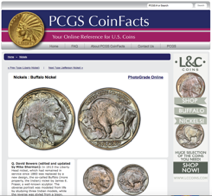 A very useful site with a lot of information is www.pcgscoinfacts.com. This excerpt is from the site itself: “PCGS CoinFacts is the Internet Encyclopedia of United States Coins, located on the Internet at www.PCGSCoinFacts.com. The original CoinFacts site was created in 1999 by numismatic expert and author Ron Guth, and it quickly became one of the most popular numismatic related websites. The CoinFacts website features a complete listing of all U.S. coins, including regular issue coins, colonials, patterns, commemoratives, territorial gold, errors, proof and mint sets, Confederate, and bullion coins. Individual pages contain technical information, high-quality images, auction prices realized, variety information, anecdotal notes, etc. CoinFacts was built for use by collectors at all levels, from beginner to advanced.”
A very useful site with a lot of information is www.pcgscoinfacts.com. This excerpt is from the site itself: “PCGS CoinFacts is the Internet Encyclopedia of United States Coins, located on the Internet at www.PCGSCoinFacts.com. The original CoinFacts site was created in 1999 by numismatic expert and author Ron Guth, and it quickly became one of the most popular numismatic related websites. The CoinFacts website features a complete listing of all U.S. coins, including regular issue coins, colonials, patterns, commemoratives, territorial gold, errors, proof and mint sets, Confederate, and bullion coins. Individual pages contain technical information, high-quality images, auction prices realized, variety information, anecdotal notes, etc. CoinFacts was built for use by collectors at all levels, from beginner to advanced.”
Coin of the Month

While I didn’t find any coins specifically related to Halloween, this coin is definitely creepy enough to fit the bill. This coin was produced by coiner Lucius Hostilius Saserna in 48 BC. The full description is as follows:
AR Denarius (19mm, 3.94 g, 10h). Rome mint. Obverse: Head of Gallia right; Gallic trumpet (carnyx) behind / Reverse: Diana of Ephesus standing facing, holding spear and stag by its antler. Crawford 448/3; CRI 19; Sydenham 953; RSC Hostilia 4.
While those are the technical details, the starkness and the ghoulish thinness of the reverse person, not to mention the same person is holding a dead deer and a spear, make this a worthy Halloween season choice.
Currency Note of the Month

I picked a large size type note for this month since I hadn’t done one in a while.
This is a Series 1869 (actually authorized by the Congressional Act of March 3rd, 1863) $20 Legal Tender issue. It is commonly referred to as a “Rainbow” note due to its striking colors on the front. It features a bust of Alexander Hamilton on the left and an allegorical vignette of “Liberty” advancing holding a shield and sword.
The reverse is a very complex and ornate design notable for its outside border com- bined with a matching second border around the denominations and the obligations in- formation. These borders are actually alternating versions of the number 20, in Arabic and Roman numeral types. The Arabic numeral 20 is repeated 105 times, while the Roman XX is repeated 103 times!
Avidly collected, as are most large size type notes, values range from $1,000 in Good to $35,000+ in Gem condition.
NUMISMATIC AND HISTORICAL QUESTIONS AND FACT (September)
Q. What is the largest size currency note?
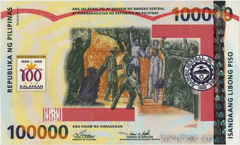 A. The largest physical size legal tender note is this Philippines 100,000 Piso note, measuring 356mm x 216mm (about the size of a legal page), that is accredited by the Guinness World Records as the world's largest legal tender note in terms of size.
A. The largest physical size legal tender note is this Philippines 100,000 Piso note, measuring 356mm x 216mm (about the size of a legal page), that is accredited by the Guinness World Records as the world's largest legal tender note in terms of size.
The front portrait is the "Cry of Pugadlawin”, when about 1,000 Filipino patriots led by Andres Bonifacio gathered in Pugadlawin, on August 23, 1896. They tore up their Spanish-issued residence certificates and yelled "Long live the Philippines", signaling the start of a revolt against Spain.
 Back: From the balcony of his house in Kawit, Cavite on June 12, 1898, General Emilio Aguinaldo displays the Philippine flag to the crowd below and proclaims independence from Spain.
Back: From the balcony of his house in Kawit, Cavite on June 12, 1898, General Emilio Aguinaldo displays the Philippine flag to the crowd below and proclaims independence from Spain.
Only 1,000 of these notes were issued in 1998 to commemorate the Centennial of Independence from more than 300 years of Spanish colonial rule. The notes were intended for collectors. The initial offering price was 180,000 Piso ($4175), substantially higher than the face value. The note is legal tender. However, if you want to spend it, it's only worth 100,000 Piso ($2390)
Q. And what is the largest value note in current circulation?
A. Strangely enough, due to a Currency Interchangeability Agreement, both the $10,000 Singapore notes and the $10,000 Brunei notes are equal in value. The coun- tries signed an agreement to accept each others currency on par in money exchanges, so as far as world value they are exactly tied.. They are both valued on the world market at approx. $7,400 U.S. because of this. However, Singapore, in 2014, stopped printing the $10,000 note citing its use in illicit transactions. So, while they continue to be legal tender, as they are deposited to banks, they are returned to the Monetary Authority of Singapore and destroyed. Brunei continues to issue their $10,000 note and currently has approx. $50million of the notes in circulation.
EDUCATIONAL FACT: There is a reference in the “Standard Catalog of World Paper Money” to what is called “siege money” which is the first known use of paper money in Europe. While there is evidence that paper money was issued as an emergency during the 1483 siege of the Spanish by the Moors, no examples are known to exist and it is believed they were all destroyed.
However, there are 8 known examples of what is described as Leyden siege money that has survived. The siege of the city of Leyden, in modern day Netherlands, is be- lieved to be the first instance wherein paper money of necessity was used. Although Leyden boasts a wide variety of metallic siege coins from the 1570s, it was here that the first paper siege notes were issued. These “notes” are not notes at all but are, more properly, considered coins. When besieged Leyden exhausted its supply of silver, the coins were made of paper torn from prayer books. Resembling the real thing, this money, struck from coin dies, nevertheless was made of paper.
A cardboard coin struck during the Spanish siege of Leyden in 1574 may be seen at 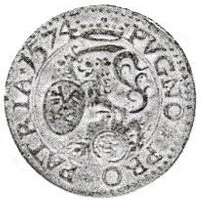 right. The arms consist of a rampant lion with shield and sword. Note the counterstamp located at six o'clock. By order of Prince William of Orange, provincial counterstamps were added to all coins in excess of 1/10 daalder. This act increased the value of the coinage in circulation by one eighth, which was then used as a war contribution.
right. The arms consist of a rampant lion with shield and sword. Note the counterstamp located at six o'clock. By order of Prince William of Orange, provincial counterstamps were added to all coins in excess of 1/10 daalder. This act increased the value of the coinage in circulation by one eighth, which was then used as a war contribution.
The Leyden siege coins are known to the Dutch as “klippes” or otherwise as “obsidional” coins, an obsidional coin being defined as “a piece of money issued for use during a siege”. Interestingly, this definition would seem to cover both metallic and paper issues.There are eight known specimens of Leyden cardboard money made from coinage dies. They range in value from 5 to 30 stuivers. All are dated 1574. Some bear countermarks while others do not. These cardboard “notes” became the first paper money to appear in the Western world.
Book of the Month
 Lost and Found Coin Hoards and Treasures: Illustrated Stories of the Greatest American Troves and Their Discoveries by Q. David Bowers
Lost and Found Coin Hoards and Treasures: Illustrated Stories of the Greatest American Troves and Their Discoveries by Q. David Bowers
In this richly illustrated book of true stories, Q. David Bowers takes you on an exploration of treasures from sunken ships, blank vaults and reserves, hidden compartments, buried chests and boxes, old safes, hideaways of pirates and privateers, cornerstones, barrels and casks, Mint and Treasury storage, wrecked buildings, caves and crevices, old estates, time capsules, forgotten collections, attics and basements, and other lost and hidden places. These valuable treasures and hoards of American coins had vanished from memory, but now many of them have been found. Some are still missing, and awaiting discovery!
Coin of the Month
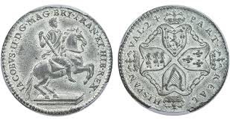
One of the more unusual coins listed in the “Red Book” is the American Plantation coin. Technically tokens, these were the first royally authorized coinage for the British colonies in America. Struck sometime after 1688, of nearly pure tin, they were made under a franchise granted to Richard Holt and were given a value of 1/24th of a Real. Most examples show black oxidation of the tin with bright examples commanding a premium. Restrikes were made about 1828 from the original dies and are less desir- able. They have a value of $300 in Good up to $20,000 in Unc.
Currency Note of the Month

This month I picked a note that is primarily known for its vignette. While there are at least 2 types of this note I have enlarged the detail from the note shown. Among obso- lete currency collectors the vignette,‘’The White Bear’’ as engraved by DeWitt Clinton Hay after Felix O.C. Darleys’ original portrait, is very popular for its depiction of “Within the pack ice, four men in a small boat about to be turned over by a polar bear.” The example shown is from the Continental Bank of Boston and the vignette was also used on a $1 Bank of Germantown obsolete note. This note is listed as #24 in Q. David Bowers book “100 Greatest American Currency Notes”.
NUMISMATIC AND HISTORICAL QUESTIONS AND FACT (August)
Q. While the phrase “Not worth a Continental” is well known, is it truly accurate?
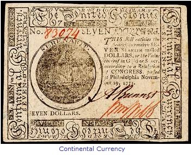
A. In general, yes. In 1787 Continental currency was still being speculated on and was selling for $250 to $1 in specie. However, in 1790 Congress passed a provision for re- financing its debts, and from 1790 to 1791 accepted
Continental currency at a rate of $100 to $1 in the purchase of U.S. bonds. 2/3rds of the bonds issued were to pay 6% interest starting in 1791 with the other 1/3rd paying 6% with payments deferred to 1800. The deferred bond subscriptions were extended almost yearly until 1797. Since the rights of the currency holders were not impaired if they didn’t subscribe to the bonds, a number of holders opted to hold onto their currency in the hope that the currency would eventually be, perhaps partially, redeemed. Unfortunately, the bonds were fully paid by 1813 and those that had not subscribed received nothing. So, for some holders at least, they eventually received 1% of face value for their Continentals!
Q. I am starting to become interested in elongated coins. Are their any that are consid- ered rare or valuable?
A. Elongated coins are generally inexpensive making them an excellent collecting di-  version when on a budget. But like most collectibles, the rarer the item, the higher the price! Surprisingly, NGC grades and slabs elongated coins and also maintains a price database based on recent auction prices. However, the king of elongated coins is certainly the “Pike” from the 1904 St. Louis Worlds Fair. Approximately 15 are known to exist and are considered the top collectible elongated. In 2012 one sold at a Stacks and Bowers auction for the sum of $4,406 (includes bidders fees) making it the highest known auction price paid for an elongated coin.
version when on a budget. But like most collectibles, the rarer the item, the higher the price! Surprisingly, NGC grades and slabs elongated coins and also maintains a price database based on recent auction prices. However, the king of elongated coins is certainly the “Pike” from the 1904 St. Louis Worlds Fair. Approximately 15 are known to exist and are considered the top collectible elongated. In 2012 one sold at a Stacks and Bowers auction for the sum of $4,406 (includes bidders fees) making it the highest known auction price paid for an elongated coin.
EDUCATIONAL FACT: Recently there was offered at auction an unusual type of prim- itive money called “feather money” that is made from bird feathers. Feather money was used on the Santa Cruz archipelago, a remote group forming part of the Solomon Islands for a very long time. This archipelago comprises the islands of Ndende, Vanikoro, Utupua, Tinakula and a number of reef islands.
The feather money consisted of a 9 meter strip of plant fibers covered with the red feathers of the small scarlet honeyeater (Myzomela Cardinalis) and often took the form of a double coil. One double coil was a trading unit which could not be subdivided and consisted of around 50 to 60 thousand red feathers. Where the idea of feather money came from is unclear, but the red color certainly points to a Polynesian influence. Red is the color of the gods, and is rare in nature.
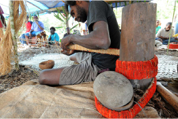 Production of the feather money was largely confined to the south-west of the main island, Ndende, and was a 3-stage process. Each stage was carried out by a specialist who had received the magic skills from the spirits and the technique was passed on from father to son. In the first stage, the scarlet honeyeaters were caught by a bird catcher, who painted a branch with mulberry tree sap to act as glue. He then lured the birds by using a real tethered bird, a decoy bird or he could imitate the creature’s call. Once the bird was stuck in the glue its feathers were plucked.
Production of the feather money was largely confined to the south-west of the main island, Ndende, and was a 3-stage process. Each stage was carried out by a specialist who had received the magic skills from the spirits and the technique was passed on from father to son. In the first stage, the scarlet honeyeaters were caught by a bird catcher, who painted a branch with mulberry tree sap to act as glue. He then lured the birds by using a real tethered bird, a decoy bird or he could imitate the creature’s call. Once the bird was stuck in the glue its feathers were plucked.
The coil-maker was a second specialist responsible for making the platelets (called lendu) composing the coils using stiff pigeon feathers. The pigeons were first shot with a bow and arrow, and the feathers were then glued together with the sap of the mulber- ry tree. The red feathers of the scarlet honeyeater were then attached to each platelet. Altogether, it took 1500 to 1800 of these platelets to form 1 coil. Each coil took around 700 hours to make.
The platelets were then taken to the coil- maker who bound them all together to form a 9 meter long coil. This involved stretching 2 strips of bark parallel to one another between 2 trees. They were held apart by a horizontal stick made from the wing bone of a flying fox. The specialist then began binding the platelets between these 2 cords, working from the centre towards the outer edges. The platelets overlapped like roof tiles. The end result was a bright red coil of feathers. The brighter the color and the better the condition of the coil, the greater the value. Altogether, there were 10 grades of feather money. The lowest grade coils were almost entirely black and were often in poor condition. A coil in a particular grade was worth twice as much as one in the next grade down. The auction example mentioned above sold for $18,750!
maker who bound them all together to form a 9 meter long coil. This involved stretching 2 strips of bark parallel to one another between 2 trees. They were held apart by a horizontal stick made from the wing bone of a flying fox. The specialist then began binding the platelets between these 2 cords, working from the centre towards the outer edges. The platelets overlapped like roof tiles. The end result was a bright red coil of feathers. The brighter the color and the better the condition of the coil, the greater the value. Altogether, there were 10 grades of feather money. The lowest grade coils were almost entirely black and were often in poor condition. A coil in a particular grade was worth twice as much as one in the next grade down. The auction example mentioned above sold for $18,750!
Website of the Month

This month I decided to make what should be an obvious choice for everybody’s website favorites list, the U.S. Mint website, usmint.gov.
While most collectors are familiar with the Mint website through the process of ordering (or at least attempting too!) the latest releases of of U.S. coins, there is also a great deal of information relating to the history and production of our current coinage. It has special sections for children, including games, informative video clips on coin production, and the latest on upcoming set releases and commemorative coinage. It even has a special section for artists wishing to submit possible design artwork!
For those that wish to keep up to date, it offers free e-mail and text updates on prod- ucts being offered. It is well worth it to keep an eye on this site for the latest info!
Coin of the Month

1794-1795 Flowing Hair Half Dime. The Flowing Hair half dime was designed by Robert Scot and this same design was also used for the half dollar and dollar silver coins minted during the same period. The obverse bears a Liberty portrait similar to that appearing on the 1794 half cent and cent but without the liberty cap and pole. These coins were much smaller than dimes in diameter and thickness, appearing to be "half dimes”, although until 1829 half dimes showed no denomination anywhere on its obverse or reverse. Mintage of the 1794 version was 7,765 while 78,660 of the 1795 version were produced. Despite the 1794 date on the early issues both were actually minted in 1795. They have the following specs, Weight: 1.35 grams, diameter: 16.5 mm, composition: .8924 silver and .1076 copper.
Currency Note of the Month

This is a series of 1886 $5 silver certificate and is the first five dollar silver certificate ever issued by The United States. The 1886 $5 silver certificate is most frequently called a “Morgan Back” and that nickname derives from the fact that there are five 1886 dated silver dollars pictured on the reverse of this bill. This type reverse design was only used for one year. The front of the note displays the portrait of Ulysses S. Grant with a large red Treasury seal and ornate lettering. There are probably less than one thousand still known to exist and high grade examples command high premiums.
NUMISMATIC AND HISTORICAL QUESTIONS AND FACT (July)
Q. Where musket balls once used as currency?
 A. Yes. In 1643, due to a lack of working coinage, the Massachusetts General Assembly made musket balls an official medium of exchange for payment of debts. There were some restrictions however. They were required to be full bore, meaning that they had to be fully formed and of the proper weight. They were given an official value of one farthing each, and there was limit of 12 pence (48 balls) that a person had to accept. Authentic period musket balls can be identified by examination of the casting characteristics, it weight, and its patina.
A. Yes. In 1643, due to a lack of working coinage, the Massachusetts General Assembly made musket balls an official medium of exchange for payment of debts. There were some restrictions however. They were required to be full bore, meaning that they had to be fully formed and of the proper weight. They were given an official value of one farthing each, and there was limit of 12 pence (48 balls) that a person had to accept. Authentic period musket balls can be identified by examination of the casting characteristics, it weight, and its patina.
Q. While traveling I heard the term “Cambist” while using one of the money exchange shops. What does the term mean?
A. From the internet site, Investopedia, a Cambist is an individual or broker  considered to be an expert in foreign exchange rates. The word cambist may also refer to a book, table, or manual that provides exchange rates on world currencies and other mediums of exchange. In the modern age, that would also include the up-to the minute computer value listings determined by the international exchange markets, for various countries currency. A person making a living by either profiting, or taking a commission for, in the buying and selling of currencies would be called a Cambist.
considered to be an expert in foreign exchange rates. The word cambist may also refer to a book, table, or manual that provides exchange rates on world currencies and other mediums of exchange. In the modern age, that would also include the up-to the minute computer value listings determined by the international exchange markets, for various countries currency. A person making a living by either profiting, or taking a commission for, in the buying and selling of currencies would be called a Cambist.
EDUCATIONAL FACT: While the mummies and burial crypts of Egypt garner great at- tention for their beauty and historical significance, the Chinese also have some amaz- ing ancient funerary items on display in various museums.
The Chinese Princess Dou Wan died more than 2,000 years ago and was preceded in death by her husband Prince Liu Sheng. When their remains were discovered in 1968, they created a sensation because of the great wealth of over 2,800 funeral offerings that surrounded them in the vast tomb.
But the most spectacular artifacts were the jade burial suits that had been created for them. Each of the green suits is composed of over 2,000 plates of sewn jade, with gold used to sew the prince’s and silver for the princess. There have been fewer than two dozen other suits found since their discovery, partly because they were so expensive and labor intensive to make; even the most skilled jadesmith would have taken over 10 years to make one of the suits. Also in AD 223, Emperor Wen of Wei ordered that the production of jade suits be stopped, as they encouraged tomb looters who would burn the suits to retrieve the gold thread.
Jade was believed to have preservative and protective qualities that would prevent the deterioration of soft tissues and keep away bad spirits. Yet beneath the stone suits there were only crumbled skeletons. Nevertheless, since jade is porous, it’s possible that DNA from the royal couple might be embedded in the stones over 2,000 years af- ter their deaths, giving them a form of immortality.
The two jade suits are now on display in the Hebei Provincial Museum in the city of Shijiazhuang.
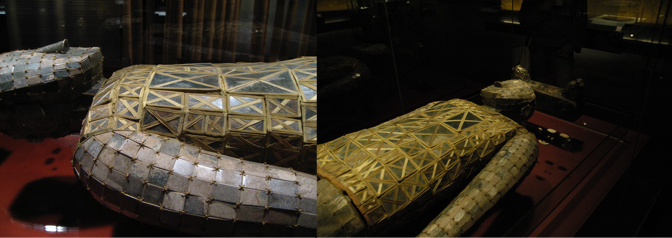
Coin of the Month

The Russian ruble is the oldestnational currency after the Pound sterling, and the world's first decimal currency. The ruble has been used in the Russian territories since the 13th century. The modern Russian ruble actually appeared in December 1991 in parallel with the Soviet ruble, which remained in circulation until September 1993. After the fall of the Soviet Union, the Russian Federation introduced new coins in 1992 in denominations of 1, 5, 10, 20, 50 and 100 rubles. The coins depict the double-head- ed eagle without a crown, a sceptre and globus cruciger above the legend "Банк России" ("Bank of Russia"). It is exactly the same eagle that the artist Ivan Bilibin painted after the February Revolution as the coat of arms for the Russian Republic. They have the following specs, Weight: 3.25 grams, diameter: 20.5 mm, composition: Cupronickel 1997-2009 and Nickel-plated steel 2009 to present.
Currency Note of the Month

This is the new British 5 pound polymer note. I saw a couple of examples at the- Coinarama (San Diego) Coin Show last weekend and thought it would make a good selection for this month.
The Bank of England is advertising these notes as being cleaner, safer, and stronger. The polymer material is expected to last 2.5 times as long as the old notes and is recy- clable which means less energy will be used to replace damaged or worn notes. When the notes are destroyed, they are made into plastic pellets suitable for making into new products.
It also has the latest in anti-counterfeiting technology. As can be seen in just the photo, the small portrait of Queen Elizabeth to the left, is actually a see-through window and the border will change colors, purple to green, as the note is tilted. The detailed Eliza- beth Tower is gold on the front and silver on the reverse. The small silver denomination of “Five”, below the tower, will change to “Pounds” as the note is tilted and the crown above the tower also appears as 3 dimensional. Lastly, it has a “5” at the top of the note that glows under ultraviolet light!
The 5 and 10 Pound notes have already been released and the 20 is expected to be released in 2020.
Book of the Month
 Coin World Almanac 8th Edition
Coin World Almanac 8th Edition
by Coin World, Beth Deisher (Editor)
No other numismatic reference can match the scope or breadth of in- formation contained in the new Eighth Edition of the Coin World Almanac. The editors of Coin World have gathered and compiled hundreds of thousands of the most vital facts about U.S. and world coinage and paper money and present it in nearly 700 pages and 24 chapters. The new 8th edition features: News highlights from the rare coin market from 2000-2011 Background on America s rarest coins and the record prices paid Expanded, in-depth section on U.S. commemorative coins, including every special set issued for modern commemorative coins. Expert information on how to avoid buying counterfeit coins. Tips for using the Internet in your collecting pursuits Get all this and more in one single, comprehensive reference book produced by the top researchers and editors in the numismatic market! (AMAZON.COM)
NUMISMATIC AND HISTORICAL QUESTIONS AND FACT (June)

Q. I’ve seen the huge U.S. flag they display at the football games. Are there any larger U.S. flags??
A. A company called “Superflag", displayed a flag measuring 255ft. x 505ft. over the Hoover Dam to commemorate the 1996 Olympic Torch Relay. The event was recorded by the Guinness Book of World Records, giving Superflag the record for the Worlds Largest Flag. It is available for rental for special events. However, at 3,000 pounds, it requires 600 people to handle and unfurl it. The stars alone are 17 feet across!
In contrast, students at the University of Texas, Dallas, have managed to create a U.S. flag, complete with all 50 stars and 13 stripes, that is 7 microns tall, compared to the 100-micron width of a human hair. The flag and its pole were cut using an ion beam, a microscopic version of a laser, and lifted to a standing position by a nano manipulator. Guinness has been unable to verify their claim however, since they lack a method of actually viewing the flag.
Q. Is it possible to accurately determine the metal content of a coin to identify a fake without damaging the coin?
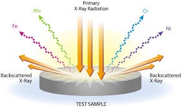
A. In a word, yes. There are a couple of instruments that can be used to verify gold and silver content in a coin. One design sends electromagnetic waves through the coin and compares the resulting wave signal against known patterns stored by the device. This is an efficient and relatively cheap method ofverifying the precious metal content .
The other, more expensive method ($10K+), is called an XRF Analyzer. Each of the elements present in a sample or coin, produces a unique set of characteristic x-rays for that specific element when illuminated by primary x-rays. XRF analyzers determine the elemental composition of a sample by measuring 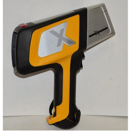 the energy of the characteristic x-ray emitted by the different elements in the sample when it is illuminated by primary x-rays. By simultaneously measuring the fluorescent x-rays emitted by the different elements in the sample, a portable XRF analyzer can rapidly determine those elements present in the sample and their relative concentrations. It is then bye to provide an accurate purity analysis for identification of gold, silver, and all precious metals, as well as quantification of other desirable and undesirable elements.
the energy of the characteristic x-ray emitted by the different elements in the sample when it is illuminated by primary x-rays. By simultaneously measuring the fluorescent x-rays emitted by the different elements in the sample, a portable XRF analyzer can rapidly determine those elements present in the sample and their relative concentrations. It is then bye to provide an accurate purity analysis for identification of gold, silver, and all precious metals, as well as quantification of other desirable and undesirable elements.
Keep in mind however, that both tests only determine metal content. Counterfeiters are becoming more skilled at producing fakes with the proper metal content so this testing should only be used in conjunction with other methods as a way of deter- mining authenticity.
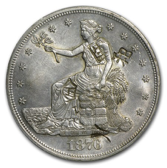
EDUCATIONAL FACT: The U.S. Trade dollar was originally produced for use in the Asian market, primarily China. They provided an outlet for the massive quantity of silver that was being produced in the western states at the time. However, for use in China, they had to be considered on par in value with the currently traded Mexican and Spanish silver coins. Many Chinese merchants and bankers marked their acceptance of a coin by counter-stamping the coin with what is called today a “chopmark”.
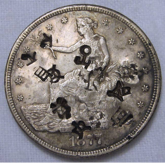
The term “chop” is derived from the Indian word “chappa”, meaning a seal or official stamp. Chopmarks come in over 600 types with everything from Chinese characters to Arabic numerals. In many cases, the port where the coin was originally traded can be identified by the specific chop. Today, collectible Trade dollars sell with or without chops but there is usually a steep drop in value for Trade dollars with chopmarks. It hasn't always been that way. In the early 1900’s dealer price lists show that chopped dol- lars were preferred over chop-free examples. There is a reference book called “Chopmark” by R.M. Rose that extensively covers chopmarks and chopped coins but it has long been out of print and is difficult to find, although occasionally a copy will show up on Ebay and Amazon. And also, know that chopmarks can be faked, so don't rely on them as being an authentication factor for the Trade dollar.
Coin of the Month
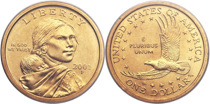
The Coinage Act of 1997 called for a new dollar coin of the same size and weight as the Susan B. Anthony dollar, but with a golden color and a plain edge. After a national competition, a design by Glenna Goodacre was chosen, featuring a portrait of the Shoshone Indian, Sacagawea, carrying her infant son Jean-Baptiste (or "Pomp"). From 2000 to 2008, the reverse featured an eagle design by Thomas D. Rogers. Since 2009, the reverse of the Sacagawea dollar has been changed yearly, with each design in the series depicting a different aspect of Native American cultures. The coin was heavily promoted and nearly three-quarters of a billion Sacagawea dollars were struck for circulation. However, the design failed to catch on with the American public and current issues are struck only for collector purposes.
There are a few collectible varieties. Glenna Goodacre, the obverse designer, request- ed payment in 5,000 Sacagawea dollars and these feature a special finish. There was also a promotional run of coins provided to Cheerios as cereal box prizes that have enhanced tail feathers on the eagle on the reverse. Additionally, there exists a number of “mules’ where the obverse die is correct but the reverse is a die from a state quarter design.
They have the following specs, Designer: Obverse, G. Goodacre Reverse, T. D. Rogers, Sr. Weight: 8.1 grams, Diameter: 26.5 mm, Edge: Plain Composition: Pure copper core with outer layers of manganese brass. Minted at Philadelphia, San Francisco and Denver.
Currency Note of the Month

This is the iconic 1918 $1 Federal Reserve Banknote. This $1 note was issued only in Series 1918 and was issued and backed by the individual Reserve bank noted on the front. These notes differ from Federal Reserve notes because of that reason. The face has a portrait of Washington, the name of the issuing Reserve bank, and a blue seal. The reverse displays a defiant flying eagle, clutching the flag, symbolizing America’s defensive posture in World War I. Although modern, these notes are avidly collected and are considered scarce. Most of the issue of these notes has been redeemed and according to the Treasury Department records only a little more than 2 million dollars is still outstanding out of a total issue of nearly 762 million.
Website of the Month
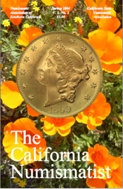 The California Numismatist edited by Greg Burns
The California Numismatist edited by Greg Burns
Since I just started to recommend websites in the newsletter I would be remiss if I didn’t feature our own southern California website calnumismatist.com This site contains all the past issues of the California Numismatist in PDF format. It is a good research source and is also an excellent spot to just read some of the CSNA/NASC goings on from past years. The California Numismatist has been winning awards since its inception back in 2004 when Greg Burns combined the CSNA’s “CalCoin News” and NASC’s “Quarterly” into the publication you see here. Stop by and take a look at some of the past issues of The California Numismatist!
NUMISMATIC AND HISTORICAL QUESTIONS AND FACT (May)
Q. What is a “Las Vegas” dollar?
A. Circa 1964, Bill Harrah, owner of Harah’s Casino, became dismayed at the thou- sands of silver dollars being drained from the casino by the souvenir-crazy public ex- changing large sums of paper for the pre-1936 cartwheels. This was around the time when several casinos in Reno had ordered 1.5 million silver dollars from the Treasury Department at face value and was the final such order before Treasury dispersals of the coins were ended.
Bill Harrah, in a desperate move to stem the outflow of silver dollars from his casinos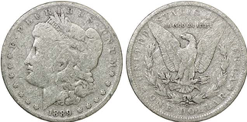 , commissioned his maintenance department to sandblast them. He thought that by de- facing them they would retain their hefty feel and clanking sound but look so hideous that patrons would not want them for souvenirs. The plan proved ineffective and silver dollars continued to disappear at a swift pace, spurred even more so by the rising price of bullion.
, commissioned his maintenance department to sandblast them. He thought that by de- facing them they would retain their hefty feel and clanking sound but look so hideous that patrons would not want them for souvenirs. The plan proved ineffective and silver dollars continued to disappear at a swift pace, spurred even more so by the rising price of bullion.
Not long after the cessation of silver dollar sales by the Treasury Department, casino owners began contracting with the Franklin Mint and other private mints to manufacture base-metal tokens as silver dollar substitutes.
Q. I was told that current Chinese money has 2 different names? What are they?
A. ”Renminbi" is the official name of the currency introduced by the Communist Peo- ple's Republic of China at the time of its foundation in 1949. It means "the people's currency”. Yuan (“Yoo-an”) is the name of a unit of the renminbi currency. Something may cost one yuan or 10 yuan. It would not be correct to say that it cost 10 renminbi.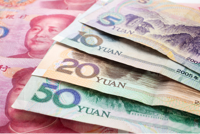 As it happens, Chinese people rarely talk about renminbi or yuan. The word they use is "kuai", which literally means "piece", and is the word used historically for coins made of silver or copper. Also common is "10 kuai qian", literally "10 pieces of money". "Kuai" is colloquial, like "quid" in the UK and “buck"in the US, but it is the word used in everyday Mandarin, whether you are in Beijing or Taiwan - which, of course, has its own currency, the new Taiwanese dollar, also known as the yuan.
As it happens, Chinese people rarely talk about renminbi or yuan. The word they use is "kuai", which literally means "piece", and is the word used historically for coins made of silver or copper. Also common is "10 kuai qian", literally "10 pieces of money". "Kuai" is colloquial, like "quid" in the UK and “buck"in the US, but it is the word used in everyday Mandarin, whether you are in Beijing or Taiwan - which, of course, has its own currency, the new Taiwanese dollar, also known as the yuan.
The same thing happens again when you break down your yuan into smaller units, the jiao and the fen (one yuan is equal to 10 jiao and one jiao is equal to 10 fen).
EDUCATIONAL FACT: The Badge of Military Merit is considered the first military award of the United States Armed Forces. Although the Fidelity Medallion is older, after being issued to three soldiers for a specific event in 1780 it was never awarded again, so the Badge of Military Merit is often considered the oldest. The writings of General Washington indicate that three badges, two Honorary Badges of Distinction and a Badge of Military Merit, were created on August 7, 1782. This is thought to be the first time in modern history that military awards had been presented to common soldiers. The practice in Europe was to honor high-ranking officers who had achieved victory, rather than honoring common soldiers. But in America, as General Washington said, the "road to glory in a patriot army and a free country is...open to all.” After the Revolutionary War,
award of the United States Armed Forces. Although the Fidelity Medallion is older, after being issued to three soldiers for a specific event in 1780 it was never awarded again, so the Badge of Military Merit is often considered the oldest. The writings of General Washington indicate that three badges, two Honorary Badges of Distinction and a Badge of Military Merit, were created on August 7, 1782. This is thought to be the first time in modern history that military awards had been presented to common soldiers. The practice in Europe was to honor high-ranking officers who had achieved victory, rather than honoring common soldiers. But in America, as General Washington said, the "road to glory in a patriot army and a free country is...open to all.” After the Revolutionary War, the Badge of Military Merit fell into disuse although it was never officially abolished. In 1932, the United States War Department authorized the new Purple Heart Medal for soldiers who had previously received either a Wound Chevron or the Army Wound Ribbon. At that time, it was also determined that the Purple Heart Medal would be
the Badge of Military Merit fell into disuse although it was never officially abolished. In 1932, the United States War Department authorized the new Purple Heart Medal for soldiers who had previously received either a Wound Chevron or the Army Wound Ribbon. At that time, it was also determined that the Purple Heart Medal would be ![]() considered the official "successor decoration" to the Badge of Military Merit.
considered the official "successor decoration" to the Badge of Military Merit.
 By Executive Order of the President of the United States, the Purple Heart was revived on the 200th Anniversary of George Washington's birth, out of respect to his memory and military achievements, by War Department General Order No. 3, dated February 22, 1932. The Purple Heart is a United States military decoration awarded in the name of the President to those wounded or killed while serving, on or after April 5, 1917, with the U.S. military. With its forerunner, the Badge of Military Merit, which took the form of a heart made of purple cloth, the Purple Heart is the oldest military award still given to U.S. military members. The National Purple Heart Hall of Honor is located in New Windsor, New York.
By Executive Order of the President of the United States, the Purple Heart was revived on the 200th Anniversary of George Washington's birth, out of respect to his memory and military achievements, by War Department General Order No. 3, dated February 22, 1932. The Purple Heart is a United States military decoration awarded in the name of the President to those wounded or killed while serving, on or after April 5, 1917, with the U.S. military. With its forerunner, the Badge of Military Merit, which took the form of a heart made of purple cloth, the Purple Heart is the oldest military award still given to U.S. military members. The National Purple Heart Hall of Honor is located in New Windsor, New York.
Currency Note of the Month
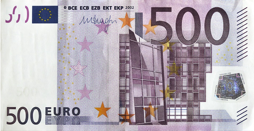
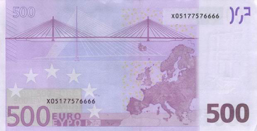
The five hundred euro note (€500) was the highest-value euro banknote and was used between the introduction of the euro (in its cash form) in 2002 until 2018 when its pro- duction was stopped. The banknote is still under circulation, keeping the original value. It is one of the highest-value circulating banknotes in the world, worth around 620 USD, 3,914 CNY, 66,413 JPY, 584 CHF or 440 GBP. The note is used in the 23 coun- tries which have the euro as their sole currency (with 22 legally adopting it), with a population of about 338 million.
Initially, the high denomination notes were introduced very rapidly so that in the first 7 years (up to December 2008) there were 530,064,413 five hundred euro banknotes in circulation. Subsequently, the rate of increase was radically slowed. In January 2016 there were 611,833,416 in circulation. It is the largest note measuring 160 × 82 mm and has a purple color scheme. The five hundred euro banknotes depict bridges and arches/doorways in modern architecture (around the late 20th century). The five hun- dred euro note contains several complex security features such as watermarks, invisi- ble ink, holograms and microprinting that make counterfeiting very difficult.
The European Central Bank announced on 4 May 2016 that it would phase out the 500 euro note by the end of 2018. “Authorities increasingly suspect that they (€500 notes) are being used for illegal purposes, an argument that we can no longer ignore,” according to a high-ranking bank official, Benoît Cœuré.
Coin of the Month
COMMON REVERSE
 15 OBVERSES
15 OBVERSES

The 1-euro coin is a euro coin with a value of one euro (€1). All coins have a common reverse side and country-specific national sides. The coin has been used since 2002, with the present common side design dating from 2007.
As of July 2015, there were approximately 6.7 billion one-euro coins in circulation, constituting 26.4% of all circulated euro coins by value and 5.9% by quantity.
The coin dates from 2002, when euro coins and banknotes were introduced in the twelve-member Eurozone and its related territories. The common side was designed by Luc Luycx, a Belgian artist who won a Europe-wide competition to design the new coins. The design of the one and two euro coins was intended to show the (EU) as a
whole with the then 15 countries more closely joined together than on the 10 to 50- cent coins.
There were then 15 versions of the national sides (eurozone + Monaco, San Marino and the Vatican who could mint their own) and in each case there was a national com- petition to decide the design, which had to comply with uniform specifications, such as the requirement to include twelve stars (see euro coins). National designs were not al- lowed to change until the end of 2008, unless a monarch (whose portrait usually ap- pears on the coins) died or abdicated. This happened in Monaco and the Vatican City, resulting in three new designs in circulation (the Vatican had an interim sede vacante design until the new Pope was elected). National designs have seen some changes, as they are now required to include the name of the issuing country.
They have the following specs, Designer: Reverse, Luc Luycx weight: 7.5 grams, di- ameter: 23.25 mm, Edge: Alternating segments, three smooth, three finely ribbed Composition: Outer segment: nickel brass.Inner segment: three layers: copper-nickel, nickel and copper-nickel.
Book of the Month
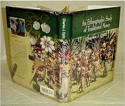 Ethnographic Study of Traditional Money: A Definition of
Ethnographic Study of Traditional Money: A Definition of
Money and Descriptions of Traditional Money
by Charles J. Opitz
Everywhere among the peoples of the world we see examples of traditional money. From the wampum of the American Indian used in the past, to the mamulis still being used by villagers for bride price on the Island of Sumba, we have always been fasci-
nated by the relationship between culture and money. Traditional money has always been used for the important events in life such as buying land, bride price, death, the birth of a child, and coming of age. Even when coins or paper money are used for everyday activities, traditional money may still be used for the most important occasions. The book's introduction explores the definition of money and the book is a comprehensive listing and explanation of forms of money excluding coins and paper money. The 410 page book contains more than 1200 photographs with 150 photos in color. Most of the photographs have been taken by the author and are items in his personal collection.
NUMISMATIC AND HISTORICAL QUESTIONS AND FACT (APRIL)

Q. I was looking at a cut out Braided Hair cent in a dealers case and he told me it was a “Copperhead” badge?

A. In the 1860s, the Copperheads were a vocal faction of Democrats in the Northern United States of the Union who opposed the American Civil War and wanted an immediate peace settlement with the Confederates. Republicans started calling anti-war Democrats "Copperheads", likening them to the venomous snake. Those Democrats accepted the label, reinterpreting the copper "head" as the likeness of Liberty, which they cut from Liberty Head large cent coins and proudly wore as badges. By contrast, Democratic supporters of the war were called War Democrats. The Copperheads represented the more extreme wing of the Northern Democrats. Notable Copperheads included two Democratic Congressmen from Ohio: Clement L. Vallandigham and Alexander Long. Republican prosecutors accused some prominent Copperheads of treason in a series of trials in 1864.
Q. What is the easiest way to identify specific world banknotes? I have the phone book sized Krause World Currency reference but its pretty bulky for coin show use.
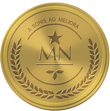 A. Meso Numismatics Corp., might have what you are looking for. They have just released an application, simply entitled Meso, that is a banknote recognition software, which uses advanced artificial intelligence to identify almost any banknote from around the world. Simply snap a photo of any banknote, and information such as the issuing entity, the country, the denomination, which printer printed the note, and more, is identified instantly. In addition, a matching picture from the Company’s database is displayed directly below the information provided. Currently it is only available to Google and Android users but they are in the process of adding it to the Apple App store also.
A. Meso Numismatics Corp., might have what you are looking for. They have just released an application, simply entitled Meso, that is a banknote recognition software, which uses advanced artificial intelligence to identify almost any banknote from around the world. Simply snap a photo of any banknote, and information such as the issuing entity, the country, the denomination, which printer printed the note, and more, is identified instantly. In addition, a matching picture from the Company’s database is displayed directly below the information provided. Currently it is only available to Google and Android users but they are in the process of adding it to the Apple App store also.
EDUCATIONAL FACT: The hobo nickel is a sculptural art form involving the creative  modification of small-denomination coins, essentially resulting in miniature bas reliefs. The US nickel coin was favored because of its size, thickness and relative softness. However, the term hobo nickel is generic, as carvings have been made from many different denominations. Due to its low cost and portability, this medium was particularly popular among hobos, hence the name.
modification of small-denomination coins, essentially resulting in miniature bas reliefs. The US nickel coin was favored because of its size, thickness and relative softness. However, the term hobo nickel is generic, as carvings have been made from many different denominations. Due to its low cost and portability, this medium was particularly popular among hobos, hence the name.
When the Indian Head, or Buffalo nickel, was introduced in 1913, it became popular among coin engravers. The big Native American head was a radical departure from previous designs and would not be seen on any subsequent coins. The large, thick profile gave the artists a larger template to work on and allowed for finer detail.
On earlier coins, the head was much smaller in relation to the size of the coin. For example, on a Lincoln cent, the head covers about one-sixth of the area. On the Buffalo nickel, the Native American's head occupies about five-sixths of the area. Moreover, the nickel is a larger coin. Large heads also adorn the Morgan dollar and the Columbian half dollar commemoratives of 1892-93, but these coins were rarely altered due to their high value.
Another factor contributing to the Buffalo nickel's popularity was the sex of the subject. Nearly all previous coins had depicted women (Liberty head nickels, Indian head cents, Barber and Morgan silver dollars). A male head has larger, coarser features (nose, chin, brow) that can be altered in many ways. Even the buffalo on the reverse could be changed into another animal or a man with a backpack. About 100,000 (and possibly as many as 200,000) classic hobo nickels were created from 1913 to 1980.
Hobo nickels continue to be produced by current carvers, however, they are usually produced using modern power tools. They can be identified by telltale marks, such as a rough area behind the head. Also watch for arcs, crescents, dashes, dots, and stars made by punches vice being engraved by hand. Many of the modern designs, includ- ing a person wearing a derby, or occupational themes such as a fireman or railway en- gineer were not used by the early engravers.
Currency Note of the Month

This extremely ornate $2 note was the first $2 silver certificate issued. Bearing a Series date of 1886 it was printed and issued until replaced by the Series 1891 silver certifi- cate. It has the portrait of General Winfield Scott Hancock (February 14, 1824 – February 9, 1886) who was a career U.S. Army officer and the Democratic nominee for President of the United States in 1880. He served with distinction in the Army for four decades, including service in the Mexican–American War and as a Union general in the American Civil War. Known to his Army colleagues as "Hancock the Superb”, he was noted in particular for his personal leadership at the Battle of Gettysburg in 1863. The ornately designed reverse carries the obligation, ”This certificate is receivable for customs, taxes, and all public dues, and when so received may be reissued”. There are 5 varieties of this note (FR#’s 240-244), with different signatures and 2 sizes of treasury seal.
Coin of the Month

I noticed that it has been over a year since I featured a gold coin. The first gold com- memorative coins issued by the United States Mint were the 1903 Louisiana Purchase Exposition Gold Dollars. The 1903 Louisiana Purchase Exposition Gold Dollars were issued to commemorate the exposition held the following year in St. Louis, Missouri for the 100th anniversary of the Louisiana Purchase. The coins were available with two different obverse designs featuring Thomas Jefferson or William McKinley and carried a rather high authorized mintage of 250,000 coins across both designs.
The Louisiana Purchase Exposition Gold Dollar features a portrait of either President Jefferson or Mckinley on the obverse with both designs credited to Charles E. Barber. Each is a left facing portrait with the surrounding inscription “United States of America”. The reverse design, also by Barber, features a single olive branch with an arrangement of inscriptions. The words “Louisiana Purchase Exposition” and “St. Louis” appear around the outer edge, with the denomination “One Dollar” and dual date “1803-1903” in the center.
There were 125,000 of each design of the Louisiana Purchase Exposition Gold Dollars minted. These coins were promoted to collectors and others as a souvenir for the exposition and distributed exclusively by Farran Zerbe. The offering price for the $1 face value coins was a lofty $3 each, which turned off many collectors.
At the conclusion of sales, 215,000 coins were returned to the Mint for melting, leaving a net distribution of 35,000 coins, estimated to be evenly split between the Jefferson and McKinley designs. While unappreciated in their day, the low surviving mintage makes the Louisiana Purchase Exposition Gold Dollars appealing for today’s collec- tors.
They have the following specs, Designer: Charles Barber, weight: 1.672 grams, diame- ter: 15 mm, composition: 90% gold 10% copper.
Book of the Month
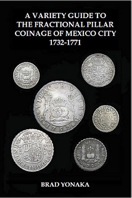 A Variety Guide to the Fractional Pillar Coinage of Mexico City 1732-1771 by Brad Yonaka
A Variety Guide to the Fractional Pillar Coinage of Mexico City 1732-1771 by Brad Yonaka
In 1732 the first machine-struck coins in the New World were manufactured, at the Spanish colonial mint of Mexico City. They were dubbed pillars or ‘columnarios’ due to the prominent rendition of the Pillars of Hercules flanking globes symbolizing the Old and New Worlds, united under the Spanish banner. They quickly became an international currency, trusted and traded around the world.
This book, published April 2017, is a much-needed variety guide for the fractional pillar issues, specifically the half, one, two, and four reales. The targeted audience is the collector of Spanish colonial or Mexican coinage, and presumes the reader has a basic knowledge of 18th century minting processes. It draws from a database of over 5000 high resolution coin images gathered over a period of ten years from online auctions and photographs of private collections. It has been over a decade since the last published accounting of die varieties in this series, and since that time, over sixty unlisted overdates and other significant design variations have been recorded by the author. Additionally, some speculative variety types listed but unproven in past re- search are refuted by lack of current evidence, to the end of simplifying the task of the ardent variety collector. With over 400 black and white photos of full coins and close- ups of variety details, this book strives to provide collectors with the most descriptive tools possible in pursuit of this famous coin type. Full cross references are given for varieties already proven from previous works.
NUMISMATIC AND HISTORICAL QUESTIONS AND FACT (MARCH)

Q. Why was the design of the Shield nickel changed after only one year?
A. In 1866 the U.S. Mint started producing a 5 cent piece, with a design similar to Longacre's two-cent piece, with a shield on the obverse and a numeral 5 surrounded by stars and rays on the reverse. This has come to be known as the Shield nickel.

The new coins proved difficult to produce; owing to the hardness of the planchet, the coins were not of high quality and the life of the striking dies was brief. The rays were eliminated from the reverse design in 1867, in the hope of eliminating some of the production problems. It was believed by some however, that the “Stars and Bars” design was originally intended to show support for the defeated Southern cause and that it was changed as a cover up on the part of the Mint!


Q. With the S.S. Central America treasure so much in the news, is any of the treasure going to be affordable at the “common man” level?
A. Most certainly! There are already slabs with small amounts of certified gold dust from the shipwreck for sale and the recent court approval to liquidate the sale of the treasure recovered in 2014 will certainly make even more available in the near future. While the 3100 recovered gold coins have received most of the spotlight there was also over 10,000 silver coins brought up. These will be processed for sale after the gold coins have been completed and sold. The over 100 pounds of gold dust is expected to be sold in small “pinch” size amounts and any gold nuggets will be sold whole. So by the time the entire treasure is liquidated, which could take years, there should be a wide variety of treasure items for sale at varying price ranges.
EDUCATIONAL FACT: ON June 28, 1831, a violent earthquake hit the west coast o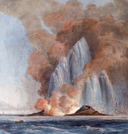 f the Mediterranean island of Sicily. By July 19, 1831, in a region between Sicily and the coast of Africa, a new island could be seen —spawned by the eruption of an underwater volcano.The island continued to grow in size until it became about 2.5 miles in circumference and 207 feet in height.
f the Mediterranean island of Sicily. By July 19, 1831, in a region between Sicily and the coast of Africa, a new island could be seen —spawned by the eruption of an underwater volcano.The island continued to grow in size until it became about 2.5 miles in circumference and 207 feet in height.
The English were highly interested in claiming the island due to its location close to the sailing route from Gibraltar to Malta. Captain Sanhouse, commander of the cutter, H.M.S. Hind, who disembarked on the island, planted the British flag thus claiming it for the King of England and naming it “Graham Island” for the First Lord of the Admiralty.
The British realized that the island was closer to the European continent than the Island of Malta and felt that it would be to their advantage to claim the island as a base to control traffic in the Mediterranean. The King of Sicily also realized the strategic value and dispatched a ship to claim the new land and name it “Ferdinandea” in honor of King Ferdinand II. Then the French came along and compared it to a bottle of champagne and named it “Ile Julia” because of the month it first appeared.
For five months the nations fought in the press and through diplomatic channels over who had first claim to a 200-foot high piece of basalt. Tourists traveled to see the island, and a resort was planned to utilize its beaches. Sadly the volcanic material from which the island was formed was so fragmented and soft that it could not withstand the effects of the ocean waves. By December 17, 1831, officials reported that there was no trace of Graham Island.
Today on marine charts, it is called Graham’s Bar and is approximately 18 feet below the surface of the Mediterranean.Briefly in 1863, the volcano re-established Graham Island for a few short weeks and then disappeared. In 1986, United States planes bombing Libya mistook Graham’s shoal for a Libyan submarine and dropped depth charges on it.
bombing Libya mistook Graham’s shoal for a Libyan submarine and dropped depth charges on it.
In 2000, David Mannucci designed a coin with the bust of Queen Elizabeth II on theface and a logo of “Ferdinandea” Island on the back. He produced an unofficial minting of a penny in silver and in copper after reading about the existence of the “ghost island” in a newspaper articleIt is interesting to note that while this coin bears the name of a King of Two Sicilies (Naples and Sicily) it also bears the likeness of an English Queen and is in the denomination of the British realm.
Currency Note of the Month
The first Bank of England £5 note was issued in 1793 in response to the need for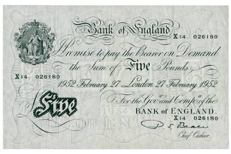 smaller denomination banknotes to replace gold coin during the French Revolutionary Wars. (Previously the smallest note issued had been £10.) The 1793 design, latterly known as the "White Fiver" (black printing on white paper), remained in circulation essentially unchanged until 21 February 1957 when the multicoloured (although predominantly dark blue) "Series B" note, depicting the helmeted Britannia, was introduced. The notes were 195 x 120mm in size (much bigger than today’s equivalent of 135 x 70mm) and featured a seated image of “Britannia” along with a flourished script printing. They utilized the image and flourishes to hide anti-counterfeiting markers, along with a complicated prefix and serial combination to create an effective counterfeit detection system. The old "White Fiver" was withdrawn on 13 March 1961.
smaller denomination banknotes to replace gold coin during the French Revolutionary Wars. (Previously the smallest note issued had been £10.) The 1793 design, latterly known as the "White Fiver" (black printing on white paper), remained in circulation essentially unchanged until 21 February 1957 when the multicoloured (although predominantly dark blue) "Series B" note, depicting the helmeted Britannia, was introduced. The notes were 195 x 120mm in size (much bigger than today’s equivalent of 135 x 70mm) and featured a seated image of “Britannia” along with a flourished script printing. They utilized the image and flourishes to hide anti-counterfeiting markers, along with a complicated prefix and serial combination to create an effective counterfeit detection system. The old "White Fiver" was withdrawn on 13 March 1961.
Coin of the Month
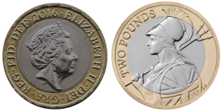
The bi-metallic British two pound (£2) coin is a denomination of the pound sterling. Its obverse has featured the profile of Queen Elizabeth II since the coin’s introduction. Three different portraits of the Queen have been used, with the current design by Jody Clark being introduced in 2015. The reverse design features Britannia.
The coin was introduced on 15 June 1998 (coins minted 1997) after a review of the United Kingdom's coinage decided that a general-circulation £2 coin was needed.[As of March 2014 there were an estimated 417 million £2 coins in circulation with an estimated face value of £834 million. They have the following specs, Designer: Obverse Jody Clark, Reverse Antony Dufort, weight: 12 grams, diameter: 28.4 mm, composition: Outer ring, Nickel-Brass, Center, Cupro-Nickel. The edge is incused with the phrase “QUATUOR MARIA VINDICO” meaning "I will claim the four seas"
NUMISMATIC AND HISTORICAL QUESTIONS AND FACT (FEBRUARY)
Q. What does the U.S. Mint do with the working dies from previous years?
A. The U.S. Mint is required by a law, passed in 1869, to destroy every dated die from the 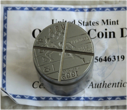 previous year. Considering the number of overdate varieties, this has not always been followed to the letter. However, in all fairness to the Mint, coins are usually minted for the next year prior to the end of the previous year so most overdates would have occurred prior to the years end deadline. With the modern practice of having the date as part of the master die this should no longer happen. Another reason for the destruction of the previous years dies is the problem of storing the thousands of dies, although a number of countries do this for their own coinage. The French Mint, for example, has dies dating back to the French and American Revolutions.
previous year. Considering the number of overdate varieties, this has not always been followed to the letter. However, in all fairness to the Mint, coins are usually minted for the next year prior to the end of the previous year so most overdates would have occurred prior to the years end deadline. With the modern practice of having the date as part of the master die this should no longer happen. Another reason for the destruction of the previous years dies is the problem of storing the thousands of dies, although a number of countries do this for their own coinage. The French Mint, for example, has dies dating back to the French and American Revolutions.

Q. I just purchased a 1 oz. silver bar stamped “Minted From U.S. Strategic Stockpile Silver”. I assume the silver came from a wartime emergency supply, but why was the silver liquidated? A. The United States National Defense Stockpile was created after World War II to store critical strategic materials for national defense purposes. This helps ensure that the United States will have the materials it needs in the time of a crisis. The Silver Strategic Stockpile (then called the Strategic and Critical Materials Stockpile) was formed in June, 1968, with a 'donation' of 165 million ounces of silver from the U.S. Treasury. 25.5 million ounces was removed in 1970, leaving 139.5 million ounces. It stayed at about that level through 1985, after which it declined each year until 2002 when it was all used up as the silver was sold to the Treasury for making Silver Eagles. As early as 1979 it was determined that the silver was not necessary, because "the probable wartime supply exceeds projected U.S. requirements”. There were 1, 10, and 100 ounce bars sold.

EDUCATIONAL FACT: One of the more interesting, albeit highly technical, minting forums, is the Technical Forum held every year during the World Money Fair. Composed as a group of presentations from money design developers, the presentations are a glimpse at the future in coin and currency technology. Everything from counterfeit detection to coin design is presented by various companies and World Mints developing new technology. Imagine having coins that are multicolored artwork or the ability to detect counterfeits autonomously during the purchasing process! During the 2016 Forum the Mint of Poland presented a bonded coating process wherebycoins would never tarnish and the Royal Mint displayed a “Phoenix Ascendant” medal that used micro digital sculpting to produce. These are all shown in high quality presentations and displays focusing on new innovations and developments spe cifically. The presentation screeners are very careful to eliminate market hype and focus on the latest and newest technology being developed. The presentations for the last 4 years (2014-2017) are available on-line at worldmoneyfair.de and provide an interesting glimpse into the future of coin design.
cifically. The presentation screeners are very careful to eliminate market hype and focus on the latest and newest technology being developed. The presentations for the last 4 years (2014-2017) are available on-line at worldmoneyfair.de and provide an interesting glimpse into the future of coin design.
Currency Note of the Month

So there wasn’t any strong reason to pick this note this month other than I saw one being purchased on “Pawn Stars” and I was intrigued.
This Fr. 1132-D 1918 $500 Federal Reserve Note features Supreme Court Chief Justice John Marshall in the portrait on the face. Marshall (1755-1835) was the fourth Chief Justice and was the longest-serving Chief Justice as well, having held the position from 1801-35. Perhaps most importantly, he reinforced the concept of judicial review in Marbury v. Madison in 1803. The Courts’ 1819 decision in the McCulloch v. Maryland case upheld the supremacy of the federal government to authorize the Second Bank of the United States, among other actions.
Engraver Frederick Girsch’s DeSoto “Discovering the Mississippi” was used for the backs of these notes. The engraving was also used for the $10 Nationals of the First Charter period. Girsch’s engraving was based on William Henry Powell’s painting in the Capitol Rotunda in Washington, D.C., “Discovery of the Mississippi by DeSoto" in 1542. Spanish explorer Hernando DeSoto (1500-42) was said to have been the first European to view the Mississippi River. These are exceptionally rare notes with VG examples worth more $4500. The VF example on “Pawn Stars” was purchased by the store for approx. $15,000.
Coin of the Month
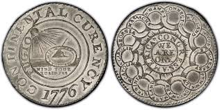
The Continental Dollar was the first pattern struck for the United States of America. Most specimens were minted in pewter, but also known are three in silver and a dozen or so in brass. It is thought that the distinctive designs were suggested by Benjamin Franklin. The reverse design, featuring linked rings, was a plea for insurgent unity, something that the philosopher-scientist constantly brought to people's attention.
The obverse sundial motif with its Latin motto ("Fugio") is also characteristic of Franklin. The design is a rebus, and its component parts may be read as "time flies, so mind your business." This and other pewter specimens were apparently struck for the inspection of members of Congress, who would have to pass enabling legislation before the coinage could proceed. Elisha Gallaudet, a New York engraver, was the person responsible for translating Franklin's concepts into metal. It is thought that he struck the coins at a makeshift private mint in Freehold, New Jersey. Earlier issues of Continental currency had included a bill worth a dollar. This practice was suspended in the spring of 1776, apparently because the Congress intended for a new, one-dollar coin to take its place.
Based on the Spanish-American piece of eight, the new Continental dollar was to serve as the linchpin of the entire monetary arrangement. The plan failed. The patriots were unable to obtain sufficient silver for the coinage, and by the time the enabling legislation had been passed, the value of Continental currency had begun its descent, emerging as almost worthless only a few years later. (http://amhistory.si.edu/coins/)
Book of the Month
 Million Dollar Nickels: Mysteries of the 1913 Liberty Head Nickels Revealed. by Paul Montgomery, Mark Borckardt, and Ray Knight
Million Dollar Nickels: Mysteries of the 1913 Liberty Head Nickels Revealed. by Paul Montgomery, Mark Borckardt, and Ray Knight
Renowned numismatists Mark Borckardt and Paul Montgomery, along with researcher Ray Knight, uncover a 90-year old mystery involving the most valuable five coins in America. Framed in the backdrop of a nation-wide media frenzy is a story of eccentric and famous collectors, persistent reporters searching for the truth, an anonymous heiress, shameless profiteers, and agents of the Smithsonian desperate to stay above the fray. Million Dollar Nickels reveals previously unknown information to dealers, and to the public, an outlandish business where dealers pay $10,000 for the privilege to look at a coin, and offer a $1,000,000 to buy a nickel thought to be lost forever. Generations of Americans have searched in vain - even on the side of a desolate highway - for the elusive 1913 Liberty nickel. But the truth lay hidden away, buried deep in numismatic lore. In the end, under the watchful gaze of armed guards, six of the nations most respected coin experts sat in a small room. No one expected what they found, and what they found rewrote numismatic history.
NUMISMATIC AND HISTORICAL QUESTIONS AND FACT (JANUARY)
Q. Is it possible to be allergic to the metal in coins?
A. It is rare, but there are some people who will have an allergic reaction to handling coins made of certain metals. The most likely metal would be copper, since there are hematological and neurological disorders caused by a copper deficiency. Ruminant an- imals are known to have this neurodegenerative syndrome, in which case it is known as swayback. (Coin Clinic Jun 2017, R. Giedroyc)

Q. I discovered an 1864 2-cent coin that has an almost 180 degree rotated die error. Is it worth any additional premium?
A. Your coin exhibits medal rotation vice normal coin rotation. Unfortunately, this is a very common variety for this particular denomination and date issue. It commands little to no premium based solely on the rotational error.

EDUCATIONAL FACT?: The oldest known and one of the most interesting shipwrecks discovered and excavated is the Uluburun shipwreck discovered off the coast of Tur-key by a local sponge diver. It is a Late Bronze Age shipwreck dated to the late 14th century BC, and located in southwestern Turkey. The ship itself is estimated to be 15-16 meters long and was a wooden single masted ship.
Eleven consecutive recovery campaigns of three to four months' duration took place from 1984 to 1994 totaling 22,413 dives, revealing one of the most spectacular Late Bronze Age assemblages to have emerged from the Mediterranean Sea. With the evi- dence provided from the cargo on the ship it can be assumed that the ship set sail from either a Cypriot or Syro-Palestinian port. It has been proposed that the ship’s destination was a port somewhere in the Aegean Sea.

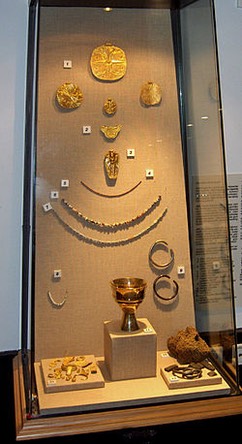
The Uluburun ship’s cargo consisted mostly of raw materials that were trade items, which before the ship’s discovery were known primarily from ancient texts or Egypti tomb paintings. The cargo included, copper and tin ingots, canaanite jars and Pistacia resin (an early turpentine), glass ingots (the ear- liest known), weapons and tools, and a large grouping of natural items used in trading. There was also a group of 139 zoomorphic pan-balance weights for accurate trading. Additionally, there was also a collection of jewelry, mostly gold and silver but also a bronze figure layered in gold, along with some raw soapstone and ebony wood.
An entire decade of archaeological investigation into what is the world’s oldest known shipwreck has revealed a vast cornucopia of ancient treasures, and the wreck was voted by Scientific American journal to be one of the ten greatest archaeological discoveries of the 20th century. The artifacts and a full size replica of the ship are currently exhibited at the Bodrum Museum of Underwater Archaeology in Turkey.
Currency Note of the Month

The 1923 $1 legal tender note is the successor to the series of 1917 issues. Just like all other one dollar legal tender notes printed since 1869, the series of 1923 issue also has a portrait of George Washington it. The serial number and seal are both printed in red ink. This dollar bill is popular because it is another unique design and signature combination notes. All 1923 red seals have the printed signatures of Speelman and White. Based on that signature combination we know that these could have been printed as late as 1927, despite saying series of 1923. This is one of the few large size notes from the 20th century that does not have a well-known nickname, although the moniker “cogwheel”, based on the reverse design, is used on occasion.There are lots of low serial number 1923 $1 red seals known to exist. Serial numbers under 100 command premiums. There is also a large run of uncirculated star notes known to exist from this series. Star notes are available in perfect condition starting at about $2,000 and Fine examples run around $150-200. An interesting display can be shown with one of these and a 1923 Blue Seal Silver Certificate which were issued and circulated at the same time.
Coin of the Month
Had to go out on limb for this coin, since it is a non-circulating issue, but it is certainly fitting for southern California! Not only does this coin have an awesome colored design but it also has it’s own scent. If you rub the coin then you can smell the scent of the ocean. It even has the word “Onoliscious”, a surfer slang meaning something really great, and comes from the Hawaiian word "ono" (delightful, groove), inscribed in the silver. The reverse shows the coat of arms of Palau and the $5 denomination. With a mintage of 2,500, and containing .743 oz. of silver, they are valued at around $75.
Website of the Month
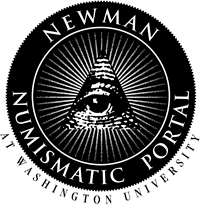
To start off the new year, I decided to add a new section to the newsletter called “Web- site of the Month”. Just so there is no confusion, this will be appearing alternately with the usual “Book Recommendation” section. I wanted to do this as more numismatic in- formation becomes easily accessible on-line.
So for the first pick of the year, I went with the Newman Numismatic Portal at www.newmanportal.org
The all-seeing eye is emblematic of the Newman Numismatic Portal, the goal of which is to freely share a vast online store of both printed and virtual numismatic resources. Books, periodi- cals, ephemera, as well as online forums and auction offerings will be captured in one location, freely available, and searchable from anywhere in the world. With unprecedented knowledge at their disposal, collectors and researchers will gain greater ap- preciation for numismatic science and more clearly discern fact from fiction.
It is beyond the scope of this small article to highlight how much searchable informa- tion is available at this website but research efforts once requiring substantial time and expense can be reduced to a few keystrokes. The Newman Numismatic Portal will ex- tend the Newman legacy of scholarly research by making freely available the largest online archive of numismatic information in the world. It is certainly well worth a visit!
NUMISMATIC AND HISTORICAL QUESTIONS AND FACT (DECEMBER)
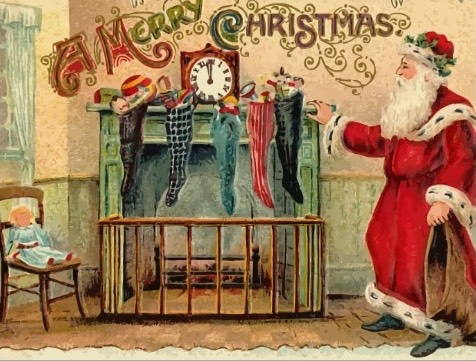
EDUCATIONAL FACT?: The tradition of putting coins into Christmas stockings has a long past. This is one version of how that tradition came to be provided by the British Royal Mint!
“The tradition of Christmas stockings also began with coins. There are countless ver- sions of the story, but this one is delightful, and starts with St. Nicholas. A 4th Century Greek saint, he was also rich as his wealthy parents had died when he was young.
He loved giving gifts to those less fortunate, preferably in secret, and heard about a lo- cal nobleman who had lost both his wife and his money, and had moved into a peas-ants’ cottage with his three daughters, all of marriageable age. In those days, a girl needed a dowry to offer the groom’s parents, and this poor family had barely enough to eat.
St. Nicholas knew they were too proud to accept charity. On spotting that the girls had hung their stockings to dry on the chimney ledge St Nicolas decided to climb down
the chimney and put a bag of silver coins into the oldest girl’s stocking. On the next visit he placed coins into the second daughter’s stocking. The third time, the grateful father hid in the room and caught St. Nicholas in the act. Although St. Nicholas begged him to keep it a secret, word soon got out, and everyone started to hang their stockings, hoping for a visit from St. Nicholas. Of course, his generosity meant that all three daughters could marry which, perhaps, may have led to another long-held tradition that, at first sight, has nothing to do with Christmas at all...”(royalmint.com)
Q. I heard about a British Christmas tradition of cooking with a coin for good luck? Any truth to the tale?
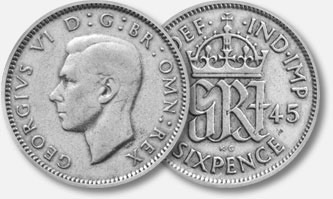
A. Stir-up-Sunday, the next before Advent Sunday, is the traditional day to make the Christmas pudding. Traditionally, a silver sixpence was stirred in to the mix, to bring the finder wealth and good luck in the year to come. In the past it was usual for every member of the household to give the pudding a stir and make a wish. Some families have used the same Christmas sixpence for as long as they can remember!
Q. Have any information about magical Christmas tree spiders?
A. The Legend of the Christmas Spider is an Eastern European folktale which explains the origin of tinsel on Christmas trees. It is most prevalent in Ukraine, where small ornaments in the shape of a spider are traditionally a part of the Christmas tree decorations.
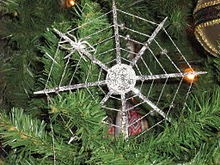
(The Story): A poor but hardworking widow once lived in a small hut with her children. One summer day, a pine cone fell on the earthen floor of the hut and took root. The widow's children cared for the tree, excited at the prospect of having a Christmas tree by winter. The tree grew, but when Christmas Eve arrived, they could not afford to decorate it. The children sadly went to bed and fell asleep. Early the next morning,they woke up and saw the tree covered with cobwebs. When they opened the windows, the first rays of sunlight touched the webs and turned them into gold and silver. The widow and her children were overjoyed. From then on, they never lived in poverty again.
Currency Note of the Month
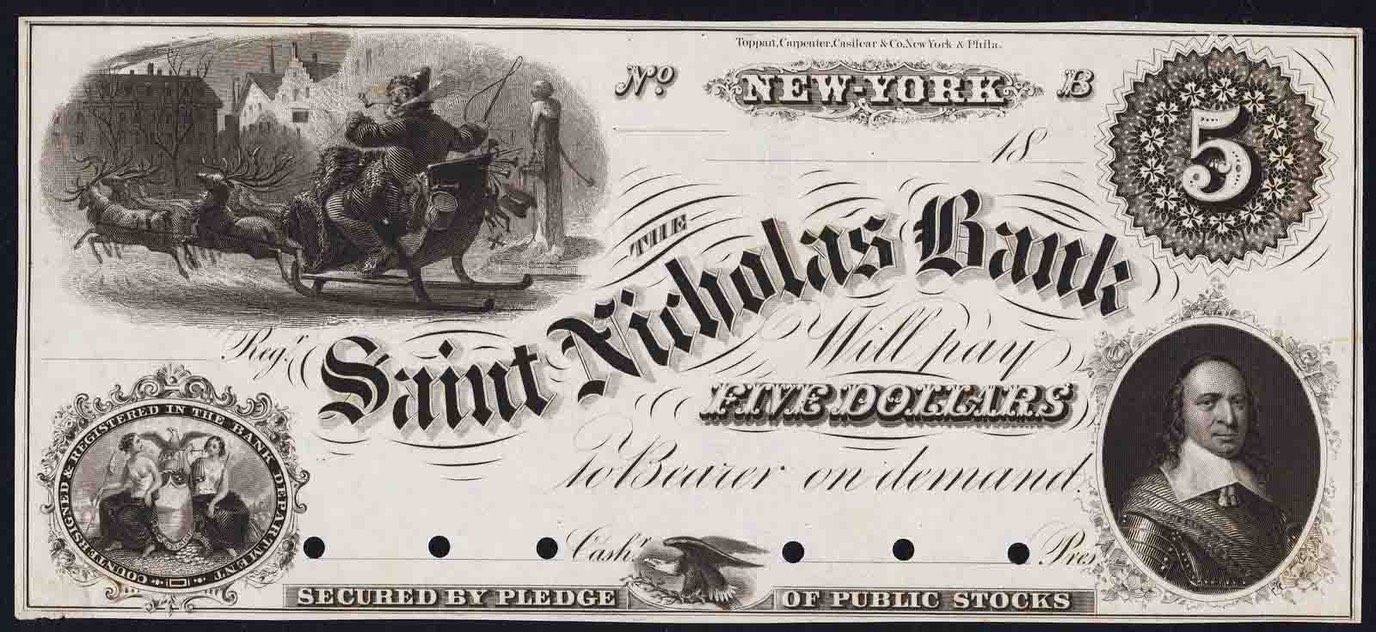
St. Nicholas Bank, 1854-1893
Remembered only by currency collectors who value its notes that featured Santa Claus, this historic bank operated on Wall Street throughout the second half of the 19th century. Historian Stephen Mihm found that the bank was established in 1853 with a capitalization of half a million dollars and operated until 1893. As a state-chartered bank, it issued its own currency notes in the years prior to the creation of federal notes. The bank was led by Caleb Barstow, who served as president from 1856 to 1874 and was remembered for his generosity. The bank's notes incorporate ships (the original Saint Nicholas was the patron saint of sailors), several images of Santa, and even one bill with early New York founder Peter Stuyvesant.
The mythical Santa Claus was modeled after a real-life Saint who became famous for his generosity. While most Europeans forgot the story, Dutch residents continued to revere "Sint Nikolass." New York City was founded by the Dutch and was originally named New Amsterday. The connection between the city and Santa Clause became even stronger when New York resident and author Clement Clarke Moore wrote "A Visit From Saint Nicholas" in 1822. The poem began with the now-famous line "Twas the night before Christmas," and with its popularity, the legend of Santa Claus spread throughout the city of New York by the early 1830s. (theclio.com)
Coin of the Month
While not intended to be a circulating issue, this colorized Santa coin is a legal tender coin with a face value of 25 cents issued by the Canadian Mint. It is widely available from most foreign coin dealers and since it contains no precious metal, with a composition of 4.4 grams of Nickel plated steel, it is relatively inexpensive. There was a total mintage of 62,777 and is currently valued at $5 in MS63. It was, however, part of a seven coin Holiday gift set and is probably easier to locate as a complete set.
NUMISMATIC AND HISTORICAL QUESTIONS AND FACT (NOVEMBER)
EDUCATIONAL FACT: Back on July 4, 1795, none other than midnight-rider Paul Revere and Samuel Adams, who was then Massachusetts’ governor, laid a time capsule in the Massachusetts State House in Boston. The event was a big to-do. Fifteen white horses (one for each state of the union) pulled the capsule to the ceremony, where a 15-gun salute accompanied its entombment within a cornerstone by Revere, Adams, and fellow revolutionary William Scollay.
There was an initial fear that the capsule’s contents hadn’t survived the centuries, particularly because the 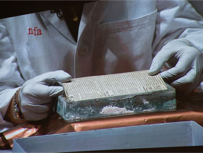 whole thing had been opened once before—in 1855, while repairs were done to the State House. At the time, 19th century “preservationists” had reportedly washed most of the capsule’s items in acid. However, they also enclosed all of the materials in a brass box—a more reliable vessel for the collection than the two heavy sheets of lead originally used.
The 10-pound capsule was finally opened at the Museum of Fine Arts in Boston in front of a crowd of press and history enthusiasts, after Pam Hatchfield, the museum’s Head of Objects Conservation, spent about five hours delicately loosening the screws that held down the lid. Inside, conservators found a well-preserved collection of Revolutionary-era artifacts, as well as some dating to the first opening in 1855.
There were over a dozen coins, including a one-shilling piece from 1652, as well as a half-cent, a 3-cent, a dime, a “quar. dol” and a half-dollar coin. A Saturday morning paper and the Boston Traveler newspaper (priced at 2 cents) were discovered in readable condition.Also within: The title page of the first volume of the Massachusetts Colony Records, a paper impression of the Seal of the Commonwealth, a medal depicting George Washington and a silver plaque commemorating the erection of the State House.
whole thing had been opened once before—in 1855, while repairs were done to the State House. At the time, 19th century “preservationists” had reportedly washed most of the capsule’s items in acid. However, they also enclosed all of the materials in a brass box—a more reliable vessel for the collection than the two heavy sheets of lead originally used.
The 10-pound capsule was finally opened at the Museum of Fine Arts in Boston in front of a crowd of press and history enthusiasts, after Pam Hatchfield, the museum’s Head of Objects Conservation, spent about five hours delicately loosening the screws that held down the lid. Inside, conservators found a well-preserved collection of Revolutionary-era artifacts, as well as some dating to the first opening in 1855.
There were over a dozen coins, including a one-shilling piece from 1652, as well as a half-cent, a 3-cent, a dime, a “quar. dol” and a half-dollar coin. A Saturday morning paper and the Boston Traveler newspaper (priced at 2 cents) were discovered in readable condition.Also within: The title page of the first volume of the Massachusetts Colony Records, a paper impression of the Seal of the Commonwealth, a medal depicting George Washington and a silver plaque commemorating the erection of the State House.
Q. I found this token in a junk box and wondered if ti had any special significance?

A. In 1916, the German government of Kaiser Wilhelm II was deeply entrenched in WWI and desperately needed gold to continue the war effort. In his attempt to to obtain gold, the Kaiser appealed directly to the German peopler help stating that it was “patriotic” forth to redeem their gold for currency. For those who did participate , a special medallion (donation token), made of iron, was issued expressing the governments appreciation for their patriotic contribution to the German war effort. The medal, when translated, states “I gave gold and received iron in honor of it”.
Q. What is aTally stick?
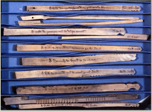

A. Tally sticks were introduced in the Middle Ages and used for about 600 years as a way to record debt. The wooden sticks would have notches marked in both ends and would then be split in two, with the halves given to the debtor and the creditor.
The debtor's half was called the "foil" while the creditor was given the "stock". The word "stocks" is still used by British bankers today to refer to debts of the British government. The system was abolished by the government in 1826 and in 1834 the decision was taken to burn the sticks - but with disastrous results.
They were put in a coal-fired stove in the House of Lords, which led to a raging chimney fire that destroyed most of the Palace of Westminster.
Currency Note of the Month

National gold bank notes (NGBN), issued by nine national gold banks in California in the 1870s and 1880s, were national bank notes redeemable in gold. Printed on a yellow-tinted paper, six NGBN denominations circulated: $5, $10, $20, $50, $100, and $500. Today, national gold bank notes are very rare in the higher denominations (and unknown on some issuing banks) with condition generally falling in the good to fine range. Approximately 630 NGBNs are known to exist, and roughly only 20 grade above "very fine”. This particular $5 note was issued with 4 dates, 1880, 1882,1883,and 1884. The signatures are bank officers, Edwin D. Morgan (cashier) and Ralph C. Woolworth (president). Of the 630 gold notes known to exist, 427 are this denomination. The face has a vignette depicting Christopher Columbus sighting at left and at right a presentation of an Indian Princess, representing America, to the Old World. The reverse is ornamental with an array of United States gold coins depicted.
Coin of the Month

Since its been 4 years since I originally picked a large cent as “Coin of the Month” I thought I would get to the next large cent in the series, the “Classic Head”. The Classic Head Large Cent was struck during the years 1808 to 1814, creating seven different dates. Compared to other series of large cents, this series is somewhat overlooked. Besides demand from type set collectors, overall interest in the series is low despite the scarcity of some issues. The Classic Head Large Cent wasn't called "Classic" until the mid-1800's by a collector, and was first known as the "The Blowsy Barmaid". It was not a popular design over the previous Draped Bust Large Cent of 1796-1807, and while readily available in lower grades, all the dates are very scarce in Uncirculated condition. The quality of the planchets appears to be sub-standard as well, and glossy surfaces are the exception rather than the rule. Interesting varieties include the 1810 10/09, 1811 1 over 0, Small and Large dates of 1812 and Plain and Crosslet 4's of 1814.
No large cents were struck in 1815 due to a fire at the Mint, this being the only year in which One cent pieces (of any size) were not made.
They have the following specs, Designer: J. Reich, weight: 10.89 grams, diameter: 29 mm, composition: copper, plain edge.
NUMISMATIC AND HISTORICAL QUESTIONS AND FACT (OCTOBER)
Q. What is the advantage to silver and gold coins bearing a monetary denomination rather than simply indicating the pieces bullion weight?
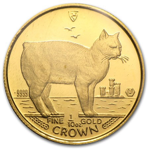
A. The advantage of their being designated a coin vice bullion is the avoidance of having to pay customs duties when it crosses international borders. Coins, in some jurisdictions, are exempt from capital gains taxes that are levied on bullion. However, the U.S. IRS says holdings in precious metals such as gold, silver or platinum are considered to be capital assets, and therefore capital gains may apply. When it comes to tax purposes, the IRS classifies precious metals as collectibles, and thus they may potentially be taxed at the maximum collectable capital gains rate of 28 percent.
Q. What does it mean when a gold coin is described as “dirty”?
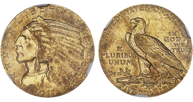 A. Collectors often are baffled when they hear a gold coin described as “dirty” and then learn that it can be a desirable trait. A coin that looks “dirty” often has what numismatists covet: original surfaces.
Gold has a natural luster color that is darker than the bright (I.E. polished or cleaned) surfaces that most collectors desire. Especially in AU condition the original surface luster may be stripped with the hope that the coin will appear to be Mint State with a subsequent increase in value. Also gold coins can show varying shades of gold making the coin appear dirty when in fact, it actually has original surfaces.
A. Collectors often are baffled when they hear a gold coin described as “dirty” and then learn that it can be a desirable trait. A coin that looks “dirty” often has what numismatists covet: original surfaces.
Gold has a natural luster color that is darker than the bright (I.E. polished or cleaned) surfaces that most collectors desire. Especially in AU condition the original surface luster may be stripped with the hope that the coin will appear to be Mint State with a subsequent increase in value. Also gold coins can show varying shades of gold making the coin appear dirty when in fact, it actually has original surfaces.
EDUCATIONAL FACT: In 1858, Lincoln had argued in his House Divided speech that 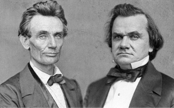 Stephen Douglas wanted to nationalize slavery. Douglas had ended the Missouri Compromise ban on slavery in Kansas and Nebraska four years earlier. However, in the presidential election of 1860, Douglas was unable to beat the “Railsplitter", as Lincoln was known, even though Douglas had the support of a number of railroads.
Although historians still argue over whether or not Douglas was for or against slavery, after the election, he did support Lincoln’s presidency. When the Civil War began in 1861, he rallied his supporters to join the Union cause to unite the country as a free nation, although a few weeks later, he died of typhoid fever.
But even Douglas knew that the better man had won. At Lincoln’s inauguration, he showed respect to the new leader when Lincoln was looking for a place to put down his stovepipe hat before stepping to the platform to speak. Douglas took the hat saying, “If I can’t be the President, at least I can hold his hat”.
Stephen Douglas wanted to nationalize slavery. Douglas had ended the Missouri Compromise ban on slavery in Kansas and Nebraska four years earlier. However, in the presidential election of 1860, Douglas was unable to beat the “Railsplitter", as Lincoln was known, even though Douglas had the support of a number of railroads.
Although historians still argue over whether or not Douglas was for or against slavery, after the election, he did support Lincoln’s presidency. When the Civil War began in 1861, he rallied his supporters to join the Union cause to unite the country as a free nation, although a few weeks later, he died of typhoid fever.
But even Douglas knew that the better man had won. At Lincoln’s inauguration, he showed respect to the new leader when Lincoln was looking for a place to put down his stovepipe hat before stepping to the platform to speak. Douglas took the hat saying, “If I can’t be the President, at least I can hold his hat”.
Book Recommendation
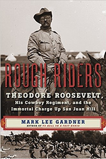 The first definitive account of this legendary fighting force and its extraordinary leader, Theodore Roosevelt, Mark Lee Gardner’s Rough Riders is narrative nonfiction at its most invigorating and compulsively readable. Its dramatic unfolding of a familiar, yet not-fully-known story will remind readers of James Swanson’s Manhunt.
The first definitive account of this legendary fighting force and its extraordinary leader, Theodore Roosevelt, Mark Lee Gardner’s Rough Riders is narrative nonfiction at its most invigorating and compulsively readable. Its dramatic unfolding of a familiar, yet not-fully-known story will remind readers of James Swanson’s Manhunt.
Two months after the sinking of the USS Maine in Havana Harbor in February 1898, Congress authorized President McKinley to recruit a volunteer army to drive the Spaniards from Cuba. From this army emerged the legendary “Rough Riders,” a mounted regiment drawn from America’s western territories and led by the indomitable Theodore Roosevelt. Its ranks included not only cowboys and other westerners, but several Ivy Leaguers and clubmen, many of them friends of “TR.” Roosevelt and his men quickly came to symbolize American ruggedness, daring, and individualism. He led them to victory in the famed Battle at San Juan Hill, which made TR a national hero and cemented the Rough Riders’ place in history.
Rich with action, violence, camaraderie, and courage, Rough Riders sheds new light on the Theodore Roosevelt saga—and on one of the most thrilling chapters in American history.Money Talks is a fast-paced history of the humble British coin, the events which at times literally shaped it and the stories reflected in its creation. (amazon.com)
Currency Note of the Month
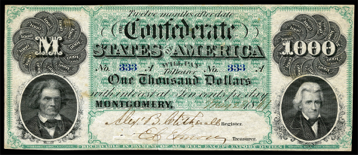
This $1,000 Confederate States of America note is one of 607 issued and features images of John C. Calhoun on the left and Andrew Jackson on the right. The first four Confederate notes were issued from the original Confederate capital of Montgomery, Alabama and they epitomize the highest quality engraving and printing. Almost all of the Montgomery issued notes were signed by hand by Alex B. Clitherall, Register, and E.C. Elmore, Treasurer.
The Confederate States of America issued their first paper money in April 1861, when the Confederacy was just two months old, and on the brink of the outbreak of the Civil War.
At first, Confederate currency was accepted throughout the South as a medium of exchange with high purchasing power. As the war progressed, however, confidence in Confederate success waned, the amount of paper money increased, and their dates of redemption were extended further into the future. As the war progressed, the currency underwent depreciation and soaring prices characteristic of inflation occurred. This was partly due to the fact that the Union was printing counterfeit Confederate currency. Near the end of the war, the currency became practically worthless as a medium of exchange. When the Confederacy ceased to exist as a political entity at the end of the war, the money lost all value. While valueless then, Confederate issues are currently highly sought and collected with values of this denomination of note ranging from $10,000-$100,000 in conditions Good to Uncirculated.
Coin of the Month

The origin of the Confederate cent is as follows: in 1861 an official of the Confederate States of America contacted the jewelry firm of Bailey & Co (later Bailey, Banks, and Biddle) and requested a die cutter who could make a C.S.A. cent. Robert Lovett, Jr. was selected, and he was a logical choice, as he had extensive experience with die engraving. Lovett employed the head of Minerva, which he had used on an earlier one cent sized token from 1860, and employed a wreath of distinctive Southern agricultural products, including a bale of cotton at the bottom. Lovett struck twelve coins with his dies, employing the then current Union alloy of copper and nickel used on Indian cents. Lovett soon had second thoughts, and fearing arrest by Union authorities for aiding the Confederates, he canceled the project and concealed the dies and dozen coins. After the war ended, Lovett took one of the coins and used it as a pocket piece. One day in 1873, Lovett accidentally spent the Confederate cent at a Philadelphia bar. The barkeep recognized the piece as unusual and showed the coin to a numismatist friend. Or so the story goes. In any event, Edward Maris, a prominent Philadelphia collector learned of the coin and its source. Maris contacted Lovett and purchased not only the other coins, but the dies too. Soon Capt. John W. Hazeltine and his associate J. Colvin Randall learned of the coins and dies, and procured them from Maris or possibly Lovett (if Maris hadn't purchased the dies). A plan was hatched to coin restrikes, and Peter Kinder (a medalist and die sinker) of Philadelphia was engaged for this purpose. A pamphlet was produced which stated that seven gold, twelve silver, and 55 copper restrikes had been made, with the dies breaking on the 55th copper strike. No copper-nickel restrikes were made to preserve the integrity of the original dozen coined by Lovett. In 1961 Robert Bashlow, a New York entrepreneur, took the rusted and broken dies and had copies made by the transfer process. These pieces have irregular surfaces, and are quite unlike the 1874 restrikes. The original strikes have the following specs, weight: 4.67 grams, diameter: 19 mm, composition: copper-nickel. Plain edge. (coinfacts.com)
NUMISMATIC AND HISTORICAL QUESTIONS AND FACT (SEPTEMBER)
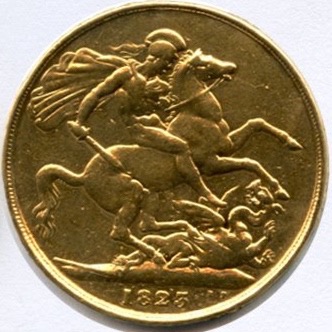
Q. I recently saw a gold coin described as “sweated” and wondered what it meant?
A. Sweating a coin is merely robbing it of a portion of Its legal weight without altering Its appearance. Sweating was originally performed by putting gold or silver coins in a leather bag and shaking the bag violently, removing gold and silver from the coins in a process that more closely resembled the natural wear and tear that coins sustained from jingling in pockets and purses over several years of circulation. It was an accelerated process of natural wear and tear and captured small but valuable amounts of gold and silver.
A modern version involves using acids to dissolve small amounts from the surface of gold coins into a suspended solution for recovery later. This leaves a granulated and pock- marked surface on the coin which is disguised through polish- ing to create a normal worn appearance.
Q. Is there any special significance to the wheat ears on the reverse of 1909-1958 Lincoln cents?

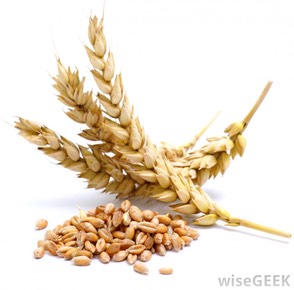
A. Victor D. Brenner originally submitted a reverse design with tree branches, but Mint Director Frank A. Leach deemed the design unsuitable and it was changed to 2 ears of durum wheat. Durum was developed by artificial selection of the domesticated emmer wheat strains formerly grown in Central Europe and the Near East around 7000 BC. Durum wheat is the wheat of choice for pasta due to its density and high gluten content. Durum production is geographically concentrated to North Dakota and the surrounding area because it demands a special agronomic environment. North Dakota produces 73 percent of the U.S. durum crop. It is unknown why it was specifically chosen for the Lincoln cent design.
EDUCATIONAL FACT: Most Texas Rangers did not wear badges until around the turn of the 20th century. Many felt that they didn’t need to wear badges, just anouncing their authority was usually sufficient, while others felt a shiny badge made a tempting target. They also weren’t provided and since most Rangers were poorly paid, were unwilling top purchase them on their own. Nevertheless, some Texas rangers did wear badges. The first of these appeared around 1875, often made from Mexican peso coins and cut into a star reminiscent of Texas’s Lone Star flag. When considering purchasing one, be wary of modern made fakes, as genuine badges are very rare.
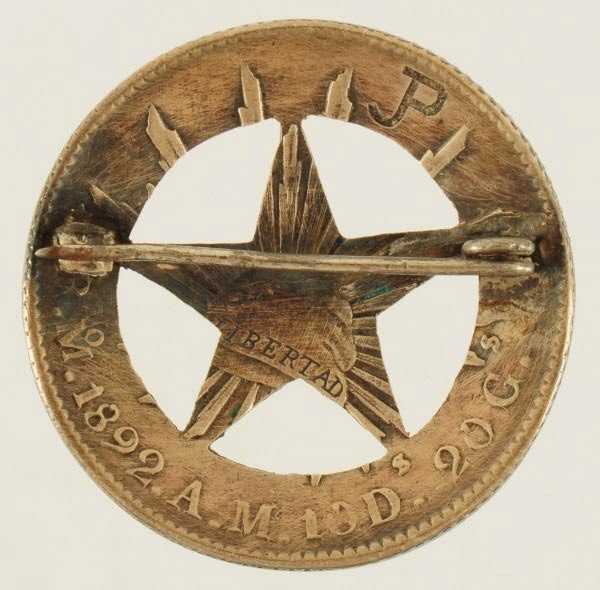
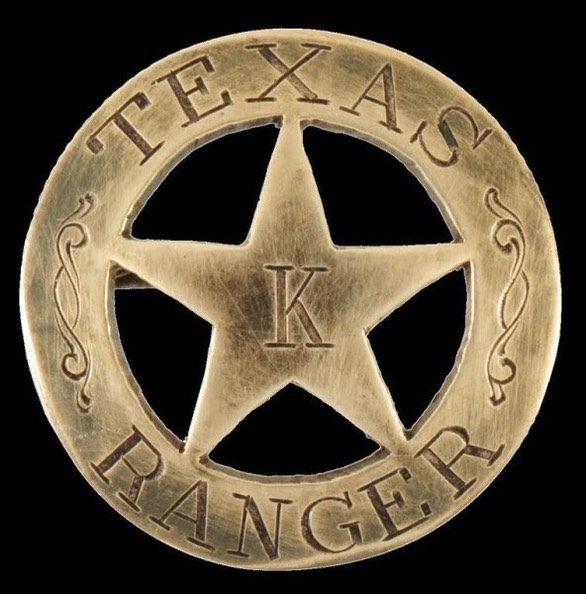
Book Recommendation
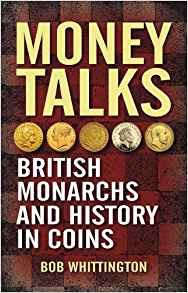
Money Talks: British Monarchs and History in Coins by Bob Whittington
Money Talks is a fast-paced history of the humble British coin, the events which at times literally shaped it and the stories reflected in its creation.
It has been used to barter and to bribe, to hold a cloak in place and to pay a king’s ransom, been an object of pride and a symbol of courage. The coin has witnessed the great events in history – about kings and queens and the transfer of power – and it speaks to us of generations passed, of battles and heroic deeds, of countries and empires as well as of moments we would rather forget.
Money Talks is about how such a small object of desire has been regarded as a sym- bol of power and authority for more than 2,500 years. It traces British history through the one thing that has come to dominate our lives – hard cash – and it demonstrates how monarchs down the centuries have used it to fund their wars, maintain their lifestyles and portray their image to prove their position or legitimatise dubious claims to the throne.
Currency Note of the Month
With Texas and hurricane Harvey in the news, I thought I would pick an obsolete note from Texas to feature this month. This $5 note is one of 9 denominations of Texas notes called “redback” notes for their colorful red ink reverse. This “redback” note was issued in Austin by the Republic of Texas. Redbacks were issued from late 1839 until 1842. The most prolific issue of Texas money, redbacks were reissued and stamped as such, thus the total number issued is not known. “Redbacks" were named for the red ink used on their versos. Lines border each edge of the note. The word ""FIVE' is print- ed vertically in a decorative border along the left edge of the note. A bust of Erastus 'Deaf' Smith is printed in the center of the right border of the note; the Roman numeral 'V' is printed above and below the vignette. A vignette of a Native American brave seated and overlooking ruins is printed along the upper-center of the note; he is hold- ing a bow in his left hand and has a tomahawk at his feet. The number '5' is printed to the left and right of the center vignette.
Two ornate designs printed in red ink comprise the left and right borders of the note's verso; a five-pointed star and the letters of the word 'TEXAS' are printed in red ink in- between the two designs.
The note is signed on the recto by James Harper Starr, Secretary of the Treasury, and Mirabeau Buonaparte Lamar, President.
Coin of the Month
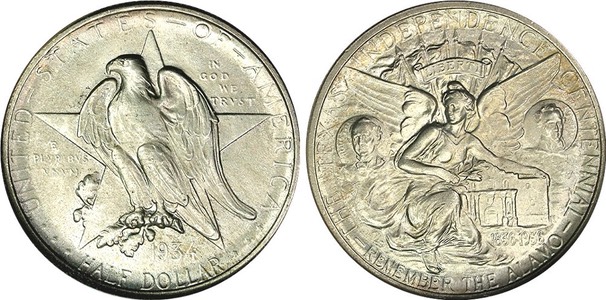
The Texas Centennial half dollar commemorative coin was minted to honor the Cen- tennial of Texas's independence from Mexico. Early in the administration of President Franklin Delano Roosevelt, on June 15, 1933, Congress passed an act to authorize the coinage of silver half dollars "in commemoration of the one hundredth anniversary in 1936 of the independence of Texas, and of the noble and heroic sacrifices of her pi- oneers, whose revered memory has been an inspiration to her sons and daughters during the past century." This was the first of over two dozen commemorative bills that would become reality during Roosevelt's tenure. The legislation provided that "no more than one and a half million pieces" be created on behalf of the American Legion Texas Centennial Committee, located in Austin in that state.
The coin was designed by Pompeo Coppini, a Texan. The obverse depicts an Eagle sitting on a branch in front of the Lone Star, the symbol of Texas. The reverse depicts the goddess Victory spreading her wings over the Alamo. It also depicts Sam Houston on her left and Stephen F. Austin on her right. The Six Flags of Texas fly above her head. Under her it reads REMEMBER THE ALAMO. Over Sam Houston, Victory, and Stephen F. Austin it reads THE TEXAS INDEPENDENCE CENTENNIAL.
Produced from 1934-1938 at the Philadelphia, Denver, and San Francisco mints, they have the following specs, weight: 12.5 grams, diameter: 30.6 mm, composition: .90 Sil- ver and .10 copper. Reeded edge.
NUMISMATIC AND HISTORICAL QUESTIONS AND FACT (AUGUST)
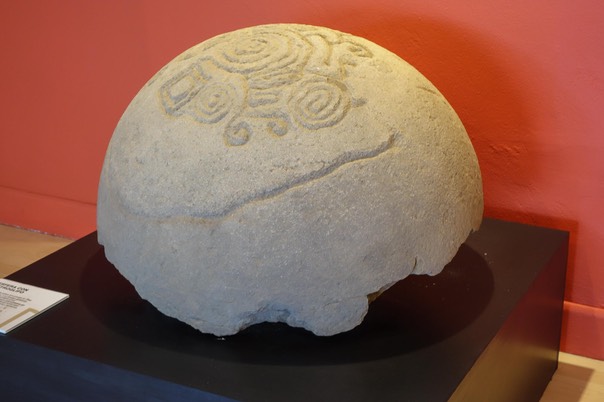
Q. What are the Diquis Spheres?
A. The stone spheres (or stone balls) of Costa Rica are an assortment of over three hundred petrospheres in Costa Rica, located on the Diquís Delta and on Isla del Caño. Locally, they are known as Las Bolas (literally The Balls).
The spheres are commonly attributed to the
extinct Diquís culture and are sometimes re-ferred to as the Diquís Spheres. They are the best-known stone sculptures of the Isthmo-Colombian area. They are thought to have been placed in lines along the approach to the houses of chiefs, but their exact significance remains uncertain. When initially discovered by workmen of the United Fruit Co. in the 1930’s, several were blown up with dynamite in the mistaken belief that they contained gold.
Q. When minting coins, what is the difference between a “close” col- lar and an “open”collar?
A. A close collar allows a lettered edge to be placed on a coin simul- taneously with the obverse and the reverse images. An open collar allows the planchet to expand without impacting the edge of the coin.
EDUCATIONAL FACT: The Civil War ended more than 150 years ago, but the U.S. government is still paying a veteran's pension from that conflict.
"One beneficiary from the Civil War [is] still alive and receiving benefits," Randy Noller of the Department of Veterans Affairs confirms.
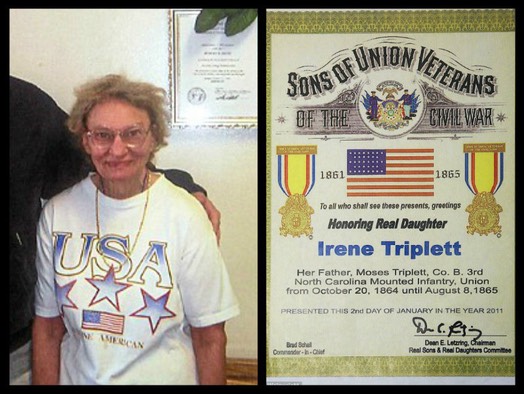
Irene Triplett – the 86-year-old daughter of a Civil War veteran – collects $73.13 each month from her fa- ther's military pension. The identity of Triplett was first reported by The Wall Street Journal in 2014.
Triplett's father was Mose Triplett, born in 1846. He
joined the Confederate army in 1862, but later deserted and signed up with the Union. His first wife died and they did not have any children. He later married Elida Hall who was at least 50 years younger. They had five children, three of whom did not survive infancy. But Irene, and her younger brother Everette did. Mose Triplett was 83 when Irene was born, nearly 87 when her brother Everette came along.
Mose Triplett died a few days after returning from the 75th anniversary of the Battle of Gettysburg in 1938.
While Triplett has outlived all the spouses of Civil War veterans, it is not by as long a period as one might think. The last Confederate widow, Maudie Hopkins died on Aug. 1, 2008, at age 93. The last Union widow, Gertrude Janeway, died Jan. 17, 2003, also at age 93. The last Civil War veterans themselves, both Union and Confederate, died in the 1950s. Both men were more than 100 years old. (U.S. News)
Coin of the Month

The twelve-sided Australian fifty-cent piece is the third-largest denomination coin of the Australian dollar and the largest under a dollar in circulation. It is the only 12-sided coin of its size in the southern hemisphere. It was introduced in 1969 to replace the round fifty-cent coin issued in 1966.
It is by diameter the largest Australian coin currently issued and second largest after the Crown of 1937–38. It is also the heaviest Australian coin in common circulation. Many commemorative designs have been issued, the large size allowing for detailed content.
As with all coins of Australia, the reigning monarch features on the obverse. Only Eliz- abeth II has been monarch during the coin's existence.
Unlike other decimal denominations, four different portraits of Her Majesty have been used on 50c coins. A unique effigy by Vladimir Gottwald was used for the 2000 Royal Visit commemorative fifty-cent piece. This is the only Australian decimal coin to have an obverse designed by an Australian and to have a portrait of the queen which is not also used on British currency.
Produced from 1969 to present at the Royal Australia Mint, they have the following specs, weight: 15.55 grams, diameter: 31.65 mm, composition: .75 Copper and .25 Nickel. Plain edge.
Currency Note of the Month

The Australian one-dollar note (or $1 bill) was introduced in 1966 due to decimalisa- tion, to replace the 10-shilling note. The note was issued from its introduction in 1966 until its replacement by the one-dollar coin in 1984. Approximately 1.7 billion one-dollar notes were printed.
During the note's issue, between its introduction and 1974, the note bore "Common- wealth of Australia" as the identification of country. At least 680,000,000 notes were printed in this time period. After 1974 and until the dollar coin was introduced in 1984, the note bore "Australia" as its identification of country. Around 1,020,000,000 such notes were printed after 1974.
The Australian one-dollar note was designed by Gordon Andrews, the design being ac- cepted in April 1964. The note features Queen Elizabeth II wearing Garter robes on the obverse with the Australian coat of arms. This portrait was based on a photo taken by Douglas Glass. The reverse of the note features Aboriginal contemporary art, created by David Malangi. The artwork depicts the "mortuary feast" of one of the artist's cre- ation ancestors, Gunmirringu, the great ancestral hunter. The Manharrngu people at- tribute this story as the origin of their mortuary rites.
The one-dollar note was replaced by the current gold-coloured coin on 13 May 1984, due to the longer service life and cost effectiveness of coins.
Book Recommendation
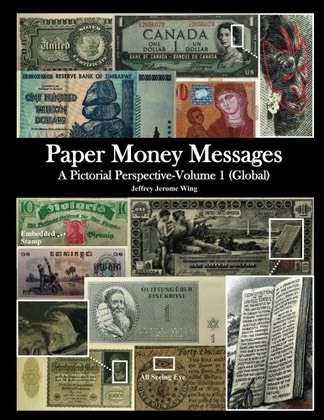
Paper Money Messages: A Pictorial Perspective
- Volume 1by Jeffrey J Wing
A wide range of readers will be intrigued by the subject of paper money. This book is highly illustrated, making it an enticing study for those that simply enjoy the many art forms on the world’s cur- rencies. Paper money is part of the currency of every nation in the world, conveying messages of historical significance, ranging from the affairs of government in war and peace to the consequences of challenging economic times and political upheaval. The evolu- tion of its colorful imagery and revealing script provide for an in-
teresting study with broad appeal. Whether it expressed the pride that a town, state, or nation found in its historical background, its heroes and distinguished citizens, its archi- tectural accomplishments, or even themes of religious importance and the natural envi- ronment, paper money almost always reflected the temperament of the community. This book explores the role that money plays in our everyday lives and addresses the perception of a money’s value. What is it that gives this paper any real, material value, when it is backed solely by one’s faith in the government that issued it? History records the answer, by the number of governments which have experience hyperinflation. The enigma that people will accept the value of paper money unbacked by anything of real substance is a major topic covered by this book.
NUMISMATIC AND HISTORICAL QUESTIONS AND FACTS (JULY)
Q. What is considered a “Crown” coin?
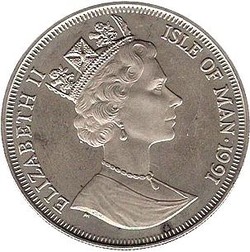
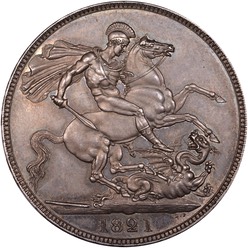
A. The British crown is traditionally a large silver coin, 39mm in diameter and weighing a little over 28g, with a monetary value of 5 shillings. Earlier examples are .925 with an ASW of .8409 ozt, while some 20th century ones are .500 bringing the ASW down to a measly .4545 ozt (and, of course, even later examples with no silver content). World Crowns are coins from various countries around the world that are roughly similar in size to British Crowns from which the name originates. U.S. Silver Dollars such as Morgans fit the definition. World crown coins generally have diameters from 36mm to 40mm and weights from 20g to over 30g. Many have their weight and fineness struck on them, something that adds interest for collectors in addition to adding to their intrinsic value.
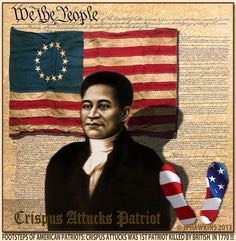
Q. Crisps Attucks, a black man, was the first person killed in the Boston massacre, in Boston, Massachusetts, and is widely considered to be the first American killed in the American Revolution. Is it known how many blacks served in the Revolutionary Army?
A. In 1775 at least 10 to 15 black soldiers, including some slaves, fought against the British at the battles of Lexington and Bunker Hill. George Washington officially lifted the ban on black enlistment in January 1776 and there were also all-black units started in Rhode Island and Massachusetts. In all, approximately 5000 black soldiers participated in the revolutionary War.
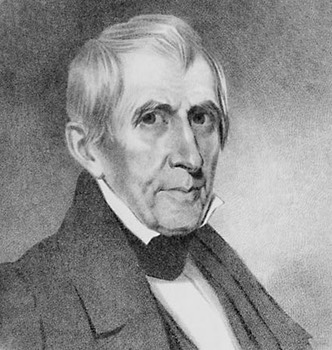
EDUCATIONAL FACT: President William Henry Harrison passed away 31 days into his term after catching pneumonia giving his inaugural speech. Since there was no defined succession procedure in the Constitution it was left to Vice-President John Tyler to decide whether to order himself sworn in as President or hold the office temporarily while a special election was held. He chose to have himself sworn in, setting a precedent that has been followed ever since. He was widely criticized for the decision and even his own Whig party refused to support him. He was often referred to as “the president without a party” and “His Accidency”. In 1842 he vetoed a bill to re-establish the Bank of The united States and his entire Cabinet resigned with the exception of Secretary of State Daniel Webster. However, the succession precedent he set was followed until 1967 when the 25th Amendment to the Constitution was passed creating a formal succession procedure
Coin of the Month
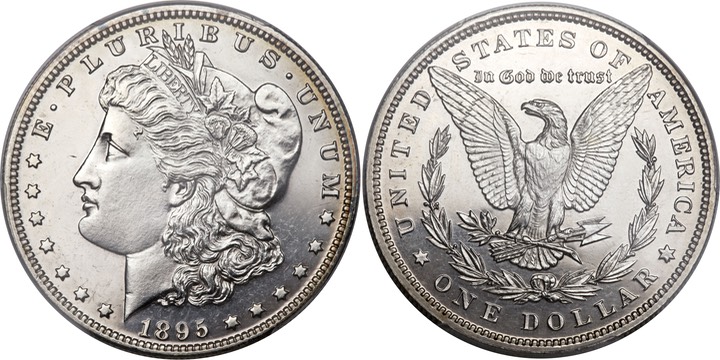
The Morgan dollar was a United States dollar coin minted from 1878 to 1904, and again in 1921. It was the first standard silver dollar minted since production of the previous design, the Seated Liberty dollar, ceased due to the passage of the Coinage Act of 1873, which also ended the free coining of silver. The coin is named after its designer, United States Mint Assistant Engraver George T. Morgan. The obverse depicts a profile portrait representing Liberty, while the reverse depicts an eagle with wings outstretched. One of the most popularly collected U.S. coins they are available in large numbers and grades. There are also a large number of varieties known. Sharply struck, proof-like, morgan dollars have highly reflective surfaces and are very scarce, and usually command substantial premiums. Mintage totals for all mints combined shows over 20,345,000 were minted! Produced from 1878 to 1904, and then again for 1 year in 1921, at the Philadelphia, New Orleans, Carson City, Denver, and San Francisco mints, they have the following specs, weight: 26.73 grams, diameter: 38.1 mm, composition: .900 silver and .100 Copper. Reeded edge.
Currency Note of the Month
The 100,000 dollar bill is a banknote of the United States that was printed by the Bureau of Engraving and Printing from 1934 to 1935. It was never publicly circulated and was only used for transactions between Federal Reserve Banks. With a face value of 100,000 dollars, it is the highest-denominated piece of paper money ever produced by the United States. The note technically still holds the status of legal tender, but has not seen circulation since the 1960s.
It was printed from December 18, 1934 to January 9, 1935, and was issued by the Treasurer of the United States to Federal Reserve Banks only against an equal amount of gold bullion held by the Department of the Treasury. As the note was only intended for transactions between Federal Reserve Banks, no examples were ever put into circulation for the general public. Initially intended to facilitate larger money transfers between banks, use of the 100,000 dollar bill eventually ended in the 1960s, partially due to the advent of wire transfers. Since that date, many of the 42,000 examples printed were destroyed by the government, and as a result, only a few specimens are known to exist today. All of the surviving notes have been accounted for, and are currently in the hands of the United States Government; thus, private ownership of a legitimate example is illegal.
Book Recommendation
 Standard Catalog of World Crowns and Talers: From 1601 to Date- Including the Early Continental European Listings Paperback – April, 1994
Standard Catalog of World Crowns and Talers: From 1601 to Date- Including the Early Continental European Listings Paperback – April, 1994
by Chester L. Krause, Clifford Mishler, and Colin R. Bruce (Editor).
Get combined research on European world talers and issues of the Orient, Modern Island Nations and Americas from world coin expert Colin Bruce. Historical notes provide background data. If you are a Crown collector or if you are planning to be a Crown coin collector, then this and the world coin series from other centuries are a must. The list is near exhaustive and the photos and drawings of the individual coins is most helpful. The books also provide the collector with market prices for each coin.(amazon.com)
NUMISMATIC AND HISTORICAL QUESTIONS AND FACTS (JUNE)
Q. What is a “Hobo” nickel?
A. The hobo nickel is a sculptural art form involving the creative modification of sm all-denomination coins, essentially resulting in miniature bas reliefs. The US nickel coin was favored because of its size, thickness and relative softness. However, the term hobo nickel is generic, as carvings have been made from many different denominations.
Due to its low cost and portability, this medium was particularly popular among hobos, hence the name. Many artists made hobo nickels in the 1910s and 1920s, with
all-denomination coins, essentially resulting in miniature bas reliefs. The US nickel coin was favored because of its size, thickness and relative softness. However, the term hobo nickel is generic, as carvings have been made from many different denominations.
Due to its low cost and portability, this medium was particularly popular among hobos, hence the name. Many artists made hobo nickels in the 1910s and 1920s, with new artists joining in as the years went by. The 1930s saw many talented artists adopting the medium. Bertram Wiegand, known almost exclusively as Bert, began carving nickels in the teens, and his student George Washington Hughes, known as Bo, began carving in the late teens (and up to 1980). During this period, Buffalo nickels were the most common nickels in circulation.
new artists joining in as the years went by. The 1930s saw many talented artists adopting the medium. Bertram Wiegand, known almost exclusively as Bert, began carving nickels in the teens, and his student George Washington Hughes, known as Bo, began carving in the late teens (and up to 1980). During this period, Buffalo nickels were the most common nickels in circulation.
Q. My friend has a $1FRN that has a bright blue reverse. Is this a printing error?
A. The green ink used to print paper money has both yellow and blue components. If the note is exposed to an acid or acid fumes the yellow component can be destroyed leaving a blue note. The opposite is also true. If the note is exposed to an alkali, the blue component can be destroyed leaving a yellow note. In both cases the note will have no premium value because the note has been altered vice it being a printing error.
EDUCATIONAL FACT: In this day and age of leaks, hacks, and classified material being exposed, the story of the ship, the Hughes Glomar Explorer is interesting. In 1968 the Soviet submarine K-129 sunk in the North Pacific. The Soviets lacked the technology to locate the sub but the U.S. in a combined Air Force/Navy effort was able to clandestinely locate the sub and extensively photograph it. The U.S. was interested in recovering the sub and its nuclear warhead but the depth, weight of 2,000 tons, and the secrecy needed, required a specialized recovery ship combined with a plausible cover story for its use. The CIA, with sponsorship by Howard Hughes, was able to build the battle-ship size recovery ship, the Hughes Glomar Explorer with the cover story that it was for exploratory sea floor mining. Of course, as soon as they started operations in the area of the sunken sub, the Soviets started surveillance but the Explorer was able to recover 38 feet of the forward area of the sub containing 2 torpedoes and the remains of several crewmen before damaging the recovery grapple. Before a second attempt at recovery the story was finally exposed in the media and the operation was halted. But the operation had been a well kept a secret for over 7 years! The ship itself was too specialized for other uses, but in 1978 was actually leased out for use in sea floor mining which was the original cover story. In 2010 theHughes Glomar Explorer was sold for $20 million but it is currently scheduled to be scrapped sometime this year. For the full story and details see the book, "Project Azorian: The CIA and the Raising of the K-129".
being exposed, the story of the ship, the Hughes Glomar Explorer is interesting. In 1968 the Soviet submarine K-129 sunk in the North Pacific. The Soviets lacked the technology to locate the sub but the U.S. in a combined Air Force/Navy effort was able to clandestinely locate the sub and extensively photograph it. The U.S. was interested in recovering the sub and its nuclear warhead but the depth, weight of 2,000 tons, and the secrecy needed, required a specialized recovery ship combined with a plausible cover story for its use. The CIA, with sponsorship by Howard Hughes, was able to build the battle-ship size recovery ship, the Hughes Glomar Explorer with the cover story that it was for exploratory sea floor mining. Of course, as soon as they started operations in the area of the sunken sub, the Soviets started surveillance but the Explorer was able to recover 38 feet of the forward area of the sub containing 2 torpedoes and the remains of several crewmen before damaging the recovery grapple. Before a second attempt at recovery the story was finally exposed in the media and the operation was halted. But the operation had been a well kept a secret for over 7 years! The ship itself was too specialized for other uses, but in 1978 was actually leased out for use in sea floor mining which was the original cover story. In 2010 theHughes Glomar Explorer was sold for $20 million but it is currently scheduled to be scrapped sometime this year. For the full story and details see the book, "Project Azorian: The CIA and the Raising of the K-129".
Coin of the Month

I just noticed (and I actually do keep a list!) that I have not yet done a spotlight on one of the most popular U.S. series of coins, the Standing Liberty Quarter. Designed by Hermon A. MacNeil and released in 1916, it depicts Lady Liberty with her left arm upraised uncovering a shield in an attitude of protection. Her right hand bears the olive branch of peace. The original design was modified after the first year due to public outcry over Liberties exposed breast. The reverse was also altered then with a different arrangement of stars and the eagle was placed higher. In 1925, the date was recessed due to the date wearing quickly thereby making it last longer. Minted from 1916 to 1930 at the Philadelphia, Denver, and San Francisco mints, they have the following specs, weight: 6.25 grams, diameter: 24.3 mm, composition: .900 silver and .100 Copper. Reeded edge. No proofs are known but some specimen strikings of the 1917 Type 1 issue are known.
Currency Note of the Month

The Japanese yen is the 3 largest traded currency in the world and this months note is the largest issued denomination of Japanese currency, the 10,000 Yen Note. This particular note is the latest version, issued in 2011. The front side of the 10,000 yen note includes a portrait of Yukichi Fukuzawa, a Meiji era philosopher and the founder of Keio University. He is considered one of the founders of modern Japan.The back of the note shows a drawing of the Hōō (a mythical Phoenix-bird) in the Hall of the Phoenix, Byōdō-in.
While unassuming in its appearance, these notes feature extensive anti-counterfeiting measures including intaglio printing, holograms, microprinting, fluorescent ink, latent images, watermarks, and angle-sensitive ink. At todays current exchange rate the value of this note is $90.70.
Book Recommendation
 Gold Coins of the World: From Ancient Times to the Present; an Illustrated Standard Catalog With Valuations 9th Edition by Arthur L. Friedburg
Gold Coins of the World: From Ancient Times to the Present; an Illustrated Standard Catalog With Valuations 9th Edition by Arthur L. Friedburg
On every continent. In more than 50 countries. Wherever gold coins are bought and sold. The world s standard reference. New. Revised. Expanded. Now, bigger and more complete than ever! The indispensable classic reference: 832 pages, completely revised and updated. More than 8,500 photos, nearly ALL of them new. 22,000+ listings of coin types, with sections expanded and hundreds of new listings. Ottoman Empire coinage completely revised. From the 6th cent. BC to date over 2,500 years of gold coins from ancient Greece to Zanzibar. The universally-used FriedbergTMNumbering System: The worlds’ standard method of cataloging, describing, buying and selling gold coins. Tables of weight and fineness with each country. Market valuations in two states of preservation. Directory of the worlds’ leading gold coin dealers and auction houses. Unsurpassed in content and scope. A must for every collector, dealer and library. (amazon.com)
NUMISMATIC AND HISTORICAL QUESTIONS AND FACTS (MAY)
Q. Who came up with the idea of milled or reeded edges?
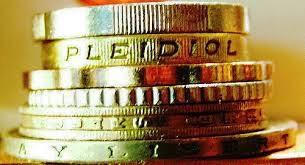
A. By the late 1600s, England's financial system was in full-blown crisis mode. The country's currency consisted entirely of silver coins, and that silver was often worth more than the value stamped on it. Some of the more enterprising criminals melted down the coins or "clipped" silver from the edges to sell to France. In 1696, the British government called on Sir isaac Newton to solve the problem of clipping. By that time, the average bag of English coins was just a hodgepodge of damaged and unrecognizable silver chunks. As such, forgers had a field day. Since English coins varied so widely in size and quality, it was easy to pass off even the most sloppy knockoffs as legal tender. Sir Isaac Newton recalled all English coins and had them melted down and remade into a higher-quality, harder-to-counterfeit design. It was a bold move, considering that the entire country had to make do without a currency for an entire year. Working as many as 18 hours a day, Newton reorganized the Royal Mints into high-quality, high-efficiency factories pumping out currency that was highly resistant to forgers. Milled edges, also called reeding, was a feature introduced by Newton on English coins to prevent clipping. (Numismatist, Sept. 2106)
Q. How much raw material does the U.S. Mint purchase for coinage?
A. While the actual amounts of raw coinage material is located somewhere in the an- nual budget report of the U.S. Mint, it can be difficult to locate. In March of 2000, the U.S. Mint released an announcement that it had purchased 3,600 tons of zinc, 1,938 tons of nickel and 18.3 million pounds of copper.
The Mint doesn't buy metals on a daily basis, but it does watch for price fluctuations in order to buy when prices are favorable. Buying the metal is only part of the job. Some planchets from which our coins are struck are purchased from outside vendors. Most are made inside the Mint as part of the manufacturing process.
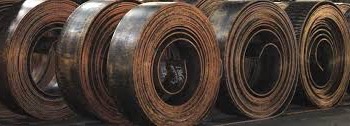
Metals, precious or otherwise, are stored in ingot form at the Mint or nearby facilities. The ingots are heated, then placed on a rolling machine and rolled out into a long strip of a specific thickness before these strips are placed into a punch machine, which produces the blanks used for coins. (Richard Giedroyc - Mar 21, 2000)
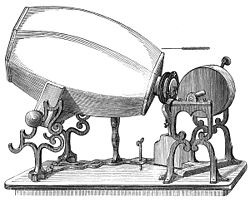
EDUCATIONAL FACT: The phonautograph is the ealiest known device for recording sound. Previously, tracings had been obtained of the sound-producing vibratory motions of tuning forks and other objects by physical contact with them, but not of actual sound waves as they propagated through air or other media.
Invented by Frenchman Édouard-Léon Scott de Martinville, it was patented on March 25, 1857. It transcribed sound waves as undulations or other deviations in a line traced on smoke-blackened paper or glass. Intended solely as a laboratory instrument for the study of acoustics, it could be used to visually study and measure the amplitude envelopes and waveforms of speech and other sounds, or to determine the frequency of a given musical pitch by comparison with a simultane- ously recorded reference frequency.
Apparently, it did not occur to anyone before the 1870s that the recordings, called pho- nautograms, contained enough information about the sound that they could, in theory, be used to recreate it. Because the phonautogram tracing was an insubstantial two- dimensional line, direct physical playback was impossible in any case.
Several phonautograms recorded before 1861 were successfully played as sound in 2008 by optically scanning them and using a computer to process the scans into digital audio files. (Wikipedia)
Currency Note of the Month
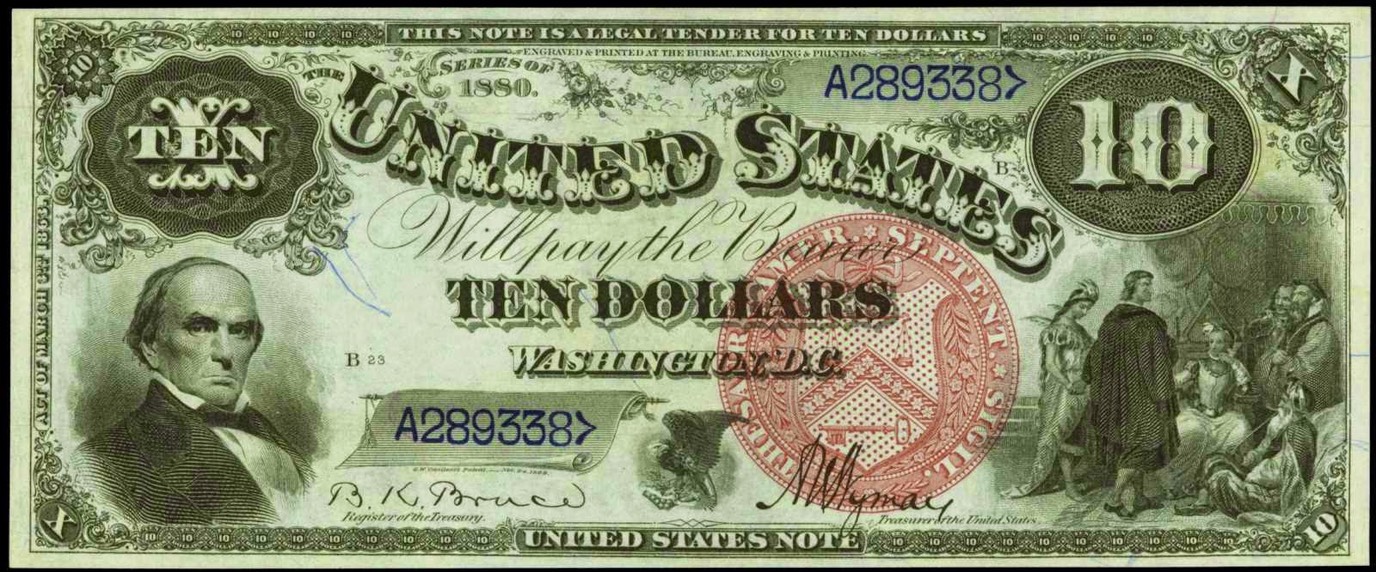
This months currency note is the Series of 1880 $10 legal tender note commonly called the“Jackass” note. If your turn the bill upside down, then the center eagle (sup- posedly?) looks like a donkey. A stern-faced Daniel Webster, engraved by Alfred Sealy, is shown on the left hand side of the bill and a vignette with Pocahontas is on the right side of the bill.
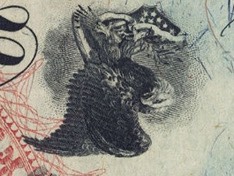
Some 1880 $10 bills were rare for many years. However, in early 2000 a hoard of a hundred of these notes were discovered at a bank in Florida. That discovery has significantly lowered the cost of most 1880 $10 bills. These bills are regularly available inper- fect condition for very reasonable(?) prices. The current population census shows over 100 known. Variations: There are 14 different varieties to the1880 $10 bill. The varieties relate to signature, seal type, and serial color differences.
Coin of the Month
This months coin is the famous Krugerrand, a South African gold coin, first minted in 1967 to help market South African gold and produced by the South African Mint. By 1980 the Krugerrand accounted for 90% of the global gold coin market. The name itself is a compound of Kruger (the former South-African president depicted on the obverse) and rand, the South African unit of currency. During the 1970s and 1980s some Western countries forbade import of the Krugerrand because of its association with the apartheid government of South Africa.This ended in 1994.
The Krugerrand is 32.77 mm in diameter and 2.84 mm thick. The Krugerrand's actual weight is 1.0909 troy ounces (33.93 g). It is minted from gold alloy that is 91.67% pure (22 karats), so the coin contains one troy ounce (31.1035 g) of gold. The remaining 8.33% of the coin's weight (2.826 g) is copper (an alloy known historically as crown gold which has long been used for English gold sovereigns), which gives the Kruger- rand a more orange appearance than silver-alloyed gold coins. Copper alloy coins are harder and more durable, so they can resist scratches and dents.
Book Recommendation
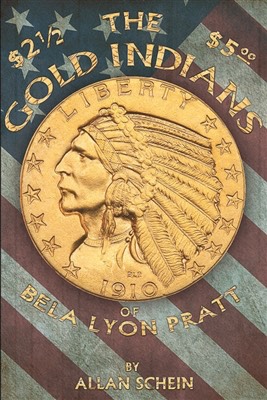
THE $2.50 & $5 GOLD INDIANS OF BELA LYON PRATT by Allan Schein.
The first comprehensive book ever written about this popular and unique American coin series. Includes an extensive biography of
sculptor Pratt, his education and sculptural history. Numismatic
contents includes the most up to date information available with
chapters on the coins design elements, grading, DATA sheets, photographic grading section and more. every date, branch mint and
proof coin of both denominations are presented clearly and concisely, visually and descriptively. Includes more than 725 images
and dozens of varieties never before described. Complete in depth
description of the Indians identity and the creation and develop-
ment of these beautiful iconic coins.
NUMISMATIC AND HISTORICAL QUESTIONS AND FACTS (APRIL)
Q. In Marco Polo’s writings there is mention of “salt money” and how 80 cakes of salt was worth a “saggio" of gold. What is a saggio?
A. A saggio is not a specific item but a measure of weight. While dried salt cakes car- ried the seal of the Grand Khan and were officially valued at 80 cakes per saggio, the farther from the realm of the Grand Khan the less they were worth. A saggio is approx- imately 1/6 of an ounce of gold dust and was traded for anywhere from 80 salt cakes to a low of 40 in the outlying areas.
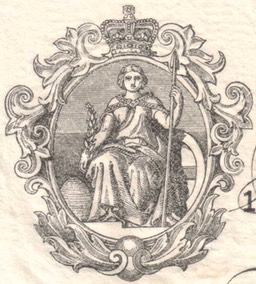
Q. On British “white” banknotes there is what appears to be a beehive at the foot of the vignette of Britannia. Does it have any special significance?
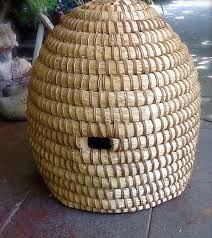
A. The beehive shown is called a “Skep” beehive. A medieval de- sign, it is made of woven straw with an opening to allow the bee colony entry and to allow them to create and build a hive. Bridal couples in medieval Holland were given a skep to parade around the village as a symbol of starting a new home, and a swarm of bees as a wedding gift. But, once the modern Langstroth box hive was perfected and came into common use, bee skeps fell out of fashion.They are no longer legal to use, in Britain anyway, for bee- keeping, since the only way to extract the honey is to cut open the beehive destroying the colony.
EDUCATIONAL FACT: Recently, the board game Monopoly was in the news as the parent company Hasbro held an on-line voting contest to replace 3 of the aging game pieces. The thimble, wheelbarrow, and the shoe player pieces were retired and re- placed by a T-Rex, a penguin, and a rubber duck.
While this may seem like a minor change when it comes to the classic version of the game there is also a new version of the game that is a fairly radical departure and re- flects the way current business and commerce is handled.
While the classic game uses $20,580 in play money, the Ultimate Electronic Banking version utilizes player bank cards and a swiping unit called the Ultimate Banking Unit to track all the player cash balances, property values, title deeds, and even the event cards. Players swipe their cards rather than handling and counting the paper money and it reportedly greatly speeds up the game. Only time will tell which version will be- come the more popular but with dozens of variations of the game already on the mar- ket both should be around for a long time!
Currency Note of the Month
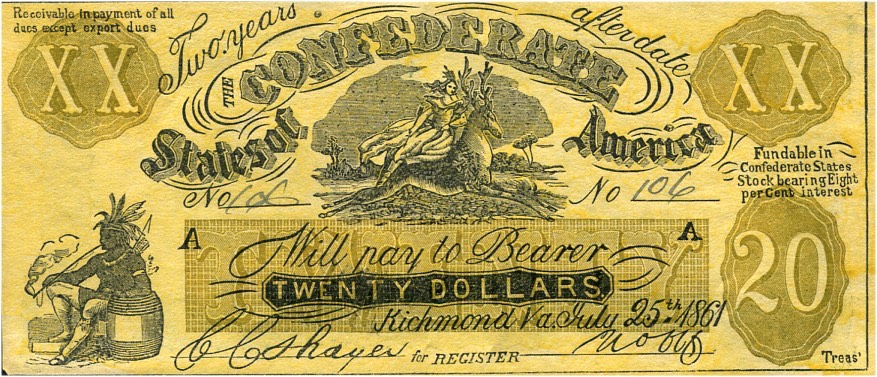
One of the most famous of bogus notes is the Confederate 20 dollar ‘issue’ of 25 July 1861, a bill known among collectors as the “Female Riding Deer” note. The note was similar in genuine design to other Confederate notes in circulation, so it would not ap- pear unusual to those who were accustomed to have different notes of the same de- nomination in their possession. This twenty featured a woman riding a deer as its cen- tral vignette. Other ornamentation included an Indian smoking a pipe and the custom- ary numeration expressed as “20s” and “XXs”. To make the note appear convincing it’s face states that it is “Fundable in Confederate States Stock bearing Eight Percent In- terest”. The notes were hand-numbered in two places and contained printed signatures, which should have been a dead giveaway, as all genuine Confederate notes were signed by hand. The circumstances surrounding its issue are unknown; however, it was possibly the inspiration of one Samuel C. Upham, a Philadelphia merchant who dedicated his war years to making the South miserable. By his own admission he acknowledged responsibility for counterfeiting over 1.5 million notes, which were then smuggled into the South during the period 1862-1863. That the female riding deer CSA 20 dollar bill was widely accepted in the South as a genuine issue of their government there is no doubt, as almost all surviving specimens are well worn from circulation. From: (“THE USE OF BANK NOTES AS AN INSTRUMENT OF PROPAGANDA PART I” by John E. Sandrock) at thecurrencycollector.com
Coin of the Month
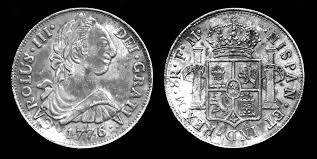
The real de a ocho, also known as the Spanish dollar, the eight-real coin, or the piece of eight (Spanish peso de ocho), is a silver coin, of approximately 38 mm diameter, worth eight reales, that was minted in the Spanish Empire after 1598. Its purpose was to correspond to the German thaler. Some countries countersigned the Spanish dollar so it could be used as their local currency.
The Spanish dollar was the coin upon which the original United States dollar was based, and it remained legal tender in the United States until the Coinage Act of 1857. Because it was widely used in Europe, the Americas, and the Far East, it became the first world currency by the late 18th century.
Millions of Spanish dollars were minted over the course of several centuries. They were among the most widely circulating coins of the colonial period in the Americas, and were still in use in North America and in South-East Asia in the 19th century.
Book Recommendation

The Collector's Handbook
by James L. Halperin
The Collector's Handbook is a step-by-step guide for collectors. From record keeping and preservation to tax planning and estate disposition/ liquidation methods, this handy primer cuts right to the chase on every topic. It is mostly written to the active collector, but pertinent chapters also have "Tips for Heirs" sections to aid non-collectors in avoiding common pitfalls when inheriting a collection. (And once you've read this book, its covenient size makes it perfect for inclusion alongside your collection in a storage vault or safe deposit box.)
Written by two owners of Heritage Galleries, the world's largest and most respected rare coin and collectibles dealer and auctioneer, The Collector's Handbook offers sound advice and the experience gained from billions of dollars in collectibles transac- tions over four decades.
NUMISMATIC AND HISTORICAL QUESTIONS AND FACTS (MARCH)
Q. What is a “holey” dollar?
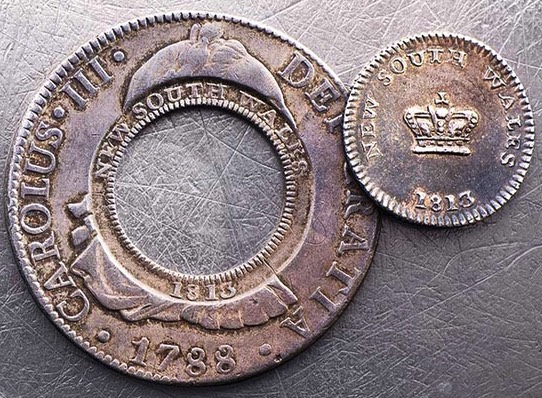
A. Holey dollar is the name given to coins used in the early history of two British settlements: Prince Edward Island (now part of Canada) and New South Wales (now part of Australia). The middle was punched out of Spanish dollars, creating two parts: a small coin, known as a "dump" in Australia, and a "holey dollar". This coin was one of the first coins struck in Australia. To overcome a shortage of coins, in 1800 Governor Lachlan Macquarie took the initiative of using £10,000 in Spanish dollars sent by the British government to produce suitable coins in a similar manner to that described above. With the shipment of currency were strict instructions to prevent the newly arrived coinage from leaving the country, so after consultation with the Judge Advocate and other officials, Governor Macquarie had a convicted forger named William Henshall cut the centres out of the coins and counter stamp them, thus making them useless outside the colony. The central plug (known as a dump) was valued at 15 pence (i.e., 1 shilling, 3 pence, or 1s 3d), and was restruck with a new design (a crown on the obverse, the denomination on the reverse), whilst the holey dollar received an overstamp around the hole ("New South Wales 1813" on the obverse, "Five Shillings" on the reverse). This distinguished the coins as belonging to the colony of New South Wales, creating the first official currency produced specifically for circulation in NSW.The combined nominal value in NSW of the holey dollar and the dump was 6s 3d, or 25 percent more than the value of a Spanish dollar; this made it unprofitable to export the coins from the colony.
Q. I've noticed on a lot of currency that it warns of a penalty of death for counterfeiting. How common was capital punishment for counterfeiting actually imposed?
A. While its common to see such warnings (threats?) on various issues of currency, rarely has the penalty officially been imposed. However, there is a famous incident that occurred in Illinois in 1841. At the time there was an organized criminal gang calling themselves the “Prarie Pirates” or “Banditti”, which specialized in counterfeiting, among other criminal endeavors in the northern Illinois area. They had become such as problem that a local vigilante group called the “Regulators” had been formed to combat the crime problem. In Ogle County the leader of the local gang was John Driscoll and his 4 sons. After the murder of the leader of the Regulators, 500 of them rode to the home of Driscoll and a Regulator court found John Driscoll and his son William guilty of the murder. They were sentenced to be hanged but requested execution by firing squad instead. John Driscoll was executed first by a firing squad of 56 men (half of the Regulator jury) and then his son was executed by the other jury half of 55 men. The lynching of the Driscolls did not spell the end of the Regulators, nor the Banditti, but it did serve to greatly decrease Banditti activity in Ogle County!
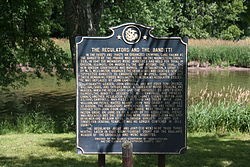
“Mob Trial and Execution", an Illinois historical marker near the mob lynching site where the Banditti "prairie pirates", father and son John and William Driscoll of the Driscoll Gang, were tried by an illegal Regulator court of 500 concerned citizens for murder and shot to death by a firing squad of 111 men.
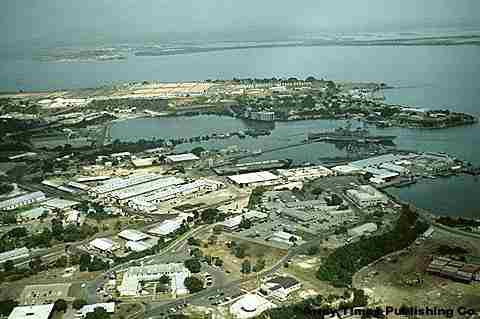
EDUCATIONAL FACT: As the debate flares anew over whether to close the detention center at Guantanamo Bay, supporters of the prison camp are pointing to an often forgotten factoid: Gitmo is one of the best real estate deals the U.S. taxpayers have ever seen. Under a treaty signed more than a century ago, the United States technically pays Cuba a little more than $4,000 a year for the land. That's roughly the monthly cost of an apartment in Midtown Manhattan. And it's a check the Castro brothers' government rarely cashes. "Rent is only $4,000 a year, which Fidel Castro routinely refuses to cash ... out of protest,” as reported by FoxNews.com. The Naval Base at Guantanamo Bay is the oldest existing U.S. military base outside U.S. territory. Located near the northern tip of Cuba, it faces Haiti and Jamaica, and is located on what was once the Oriente Province. Its history with the United States dates back to June 10, 1898 when it was used as a camp for the first U.S. troops to arrive in Cuba during the Spanish-American war. Five years later, the U.S. signed the deal with Cuba to lease 46.8 square miles of land in Guantanamo Bay for 2,000 gold coins – or $4,085 a year. The Feb. 23, 1903, deal was made by President Theodore Roosevelt as part of the Cuban-American Treaty.
Coin of the Month
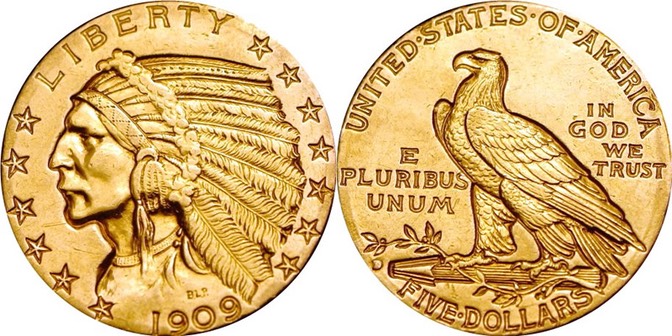
The Indian Head Quarter Eagle represents a departure from all precedents in United States coinage. Its design features no raised edge, and the main devices and legends are in sunken relief below the surface of the coin.
Boston sculptor Bela Lyon Pratt was the designer of this and the similar half eagle piece. A pupil of the famous Augustus Saint-Gaudens, Pratt based his “standing eagle” motif on the reverse of his teacher’s gold ten-dollar coin of 1907. (That eagle was itself derived from the reverse of Theodore Roosevelt’s 1905 unofficial inaugural medal, designed by Saint-Gaudens and engraved by Adolph A.Weinman. Among the public, there was some concern that the recessed design of Pratt’s quarter eagle would collect germs—an unfounded fear. The artistry of the design was condemned loudly by some numismatists. Few people were interested in saving the coin for their collections. The result is a series with relatively few examples surviving in higher grades. Any initial disfavor has mellowed with time; today Pratt’s design is recognized as part of the early 20th-century renaissance of American coinage. Minted at the Philadelphia and Denver Mints from 1908 to 1929 they have the following specs, weight: 4.8 grams, diameter: 18 mm, composition: .900 gold and .100 Copper. Reeded edge.
Currency Note of the Month
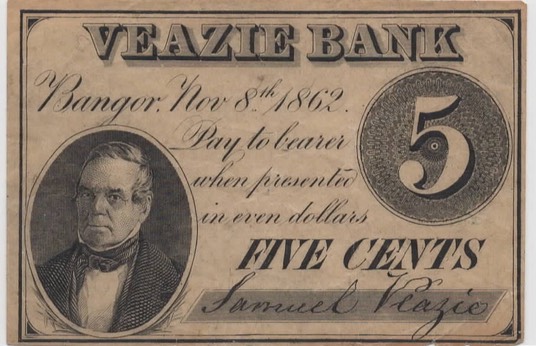
This small obsolete note may not look like much but it is an example of where there is more to the story than just the note. Prior to 1866, banks were chartered by the individual states with those banks issuing currency notes (now called Obsolete notes) which had mixed results in the stability of the bank and the value of those issued notes.
In an effort to stabilize the currency system and create a reliable federal revenue system, Congress passed the following, "That every national banking association, state bank, or state banking association shall pay a tax of ten percentum on the amount of the notes of any state bank or state banking association paid out by them after the 1st day of July, 1866.”. This effectively made it impossible for the state banks to issue currency and allowed the creation of a Federal government currency system using Legal Tender notes and National banknotes.
The Veazie Bank, owned by Samuel Veazie and portrayed on the note above, sued claiming the Federal government didn’t have this federal power to tax state chartered banks for issuing currency and refused payment of the tax.
In Veazie vs. Fenno (a Federal Tax collector), the U.S. Supreme Court opinion, written by Justice Salmon P. Chase, concluded that the act could be viewed not as a tax but as an action to control the national currency, clearly a congressional function and that the Veazie Bank would be required to pay the tax or close. Chase’s explanation of the power to tax would prove to be an important landmark in the years ahead, as the taxing power became a powerful instrument of public policy.
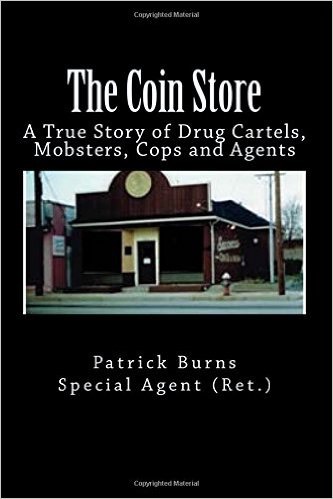
The Coin Store: A True Story of Drug Cartels, Mobsters, Cops and Agents Kindle Edition
by Patrick Burns Special Agent (Ret.)
Before anyone knew “El Chapo”, everyone knew Pablo Escobar. He was the King of Cocaine, the wealthiest and most violent criminal in the world. By the 1980s his Medellin Drug Cartel was responsible for smuggling several tons of cocaine into America each and every day, killing thousands of people along the way. The end result was hundreds of millions of dollars in cash profits.
In response, Congress created the Money Laundering Act of 1986. The goal was to take the profit out of Escobar’s business. And the plan was working. Drug Money seizures went up. But as U.S. Agents became more and more efficient at finding the dirty cash, Pablo and other Cartel leaders sought a more efficient method to get their money back to Colombia.
They found the solution in an unlikely place, a dusty back room of a tiny, rare coin shop in the small town of Cranston, Rhode Island. The shop owner was a young, local mobster who had already been laundering much of the Mob's stolen gold. With a few minor adjustments, his coin shop evolved into a springboard for a new venture, a billion dollar money laundering scheme. The Italian Mafia's stolen gold was used to dispose of the Colombian Cartel's dirty cash. It was the perfect scheme, brilliant. As his customer base grew, the young mobster, known as Fat Man, a.k.a. Mr. Cash, set up a string of phony gold shops crisscrossing America. The end result was one of the world's largest, most efficient money laundering networks. By some accounts, Fat Man laundered more than a billion dollars of drug profits for Pablo Escobar and the other Cartel leaders. This is the true story of how it all happened and how it was stopped, told by the DEA agent that did it!
NUMISMATIC AND HISTORICAL QUESTIONS AND FACTS (FEBRUARY)
Q. I am thinking about collecting U.S.military medals and was wondering what the laws/rules are as far as private ownership of such medals?

A. Military decorations such as medals, ribbons, miniature medals, and reproductions are legal to own, sell, and trade with the exception of the Medal of Honor. 18 USC 704, as regulated by 32 CFR 507, prohibits "purchasing, attempting to purchase, soliciting for purchase, mailing, shipping, importing, exporting, producing blank certificates of receipt for, manufacturing, selling, attempting to sell, advertising for sale, trading, bartering, or exchanging for anything of value" the Medal of Honor only. All other medals can be bought/sold/traded, etc.
 However, this regulation applies to possession only. 18 U.S. Code 704 also says: Whoever, with intent to obtain money, property, or other tangible benefit, fraudulently holds oneself out to be a recipient of a decoration or medal described in subsection (c)(2) or (d) shall be fined under this title, imprisoned not more than one year, or both. Additional penalties can also apply under this code, to a number of specific medals and combat badges.
However, this regulation applies to possession only. 18 U.S. Code 704 also says: Whoever, with intent to obtain money, property, or other tangible benefit, fraudulently holds oneself out to be a recipient of a decoration or medal described in subsection (c)(2) or (d) shall be fined under this title, imprisoned not more than one year, or both. Additional penalties can also apply under this code, to a number of specific medals and combat badges.
Q. We see MS and Proof 70 coins now on a regular basis and it was once believed that such perfection was unattainable. When were the first coins graded a perfect 70 by a third party grading service?

A. The first coins to receive a perfect 70 grade were $5 Statue of Liberty gold coins graded by The American Numismatic Association Certification Service (ANACS). In July of 1986 a single Uncirculated coin and 4-5 Proofs were graded MS and PR 70 respectfully. Prior to 1986 there were 5 recognized grades for uncirculated coins but after Professional Coin Grading Service entered the marketplace as a third party grading service that was expanded to the current 11 numerical grades. (Coin World, B. Deisher, Oct. 2016)
EDUCATIONAL FACT: In contrast to the American concept of “Finders Keepers”, the British have been proactive in the area of treasure finds research. A great deal of historical information can be gleaned when treasure, such as coin hordes and antiquities, are left intact at the discovery site. This information can be who and when, in general, may have hidden or lost the items and may provide clues as to the events of the era.
To that end, the British passed the Treasure Act of 1996 which provides that anyone that discovers a group of coins buried together or any artifact that is suspected to be more than 300 years old and has at least a 10% gold or silver content  has a legal obligation to report the find to the local coroner within 14 days of discovery. A Treasure Valuation Committee then determines the value of the items and the British Museum is allowed first chance to purchase (or decline) the treasure. When the items are sold, a large percentage goes to the original finders and the landowner where it was discovered.
has a legal obligation to report the find to the local coroner within 14 days of discovery. A Treasure Valuation Committee then determines the value of the items and the British Museum is allowed first chance to purchase (or decline) the treasure. When the items are sold, a large percentage goes to the original finders and the landowner where it was discovered.
Book Recommendation
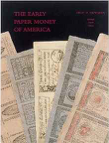 The Early Paper Money of America: Colonial Currency 1696-1810-By Eric P. Newman
The Early Paper Money of America: Colonial Currency 1696-1810-By Eric P. Newman
A recent surge in this paper money arena provides a ready-made audience for a new edition of this one-of-a-kind book. Top-dollar auctions are putting more Colonial American paper money into collectors' hands, creating a wealth of collectors seeking a new edition of the definitive guide -- The Early Paper Money of America.
This is the collectors' best choice, because it:
*Offers 1,100+ detailed, high quality illustrations investors, history enthusiasts, re-enactment groups and educators can turn for identifying issues
*Represents the most comprehensive guide to Colonial American paper money and early states issues *Provides information not readily available to general paper money collectors (Coin Week Nov. 2007)
Coin of the Month
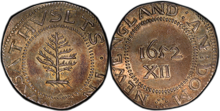
The Massachusetts Pine Tree Shilling was produced form 1667 to 1674. As early as 1650, the colony of Massachusetts Bay was a commercial success. But an inadequate supply of money put its future development in jeopardy. England was not inclined to send gold and silver coins to the colonies, for they were in short supply in the mother country.
Taking matters into their own hands, Boston authorities allowed two settlers, John Hull and Robert Sanderson, to set up a mint in the capital in 1652. The two were soon striking silver coinage - shillings, sixpences, and threepences. Nearly all of the new coins bore the same date: 1652.
This was the origin of America's most famous colonial coin, the pine tree shilling. The name comes from the tree found on the obverse. It may symbolize one of the Bay Colony's prime exports, pine trees for ships' masts. Massachusetts coinage not only circulated within that colony, but was generally accepted throughout the Northeast, becoming a monetary standard in its own right.
Why the 1652 date? Some believe that it was intended to commemorate the founding of the Massachusetts mint, which did occur in 1652. Others believe the choice was a reflection of larger political events. Coinage was a prerogative of the King. In theory, these colonists had no right to strike their own coins, no matter how great their need.
But in 1652, there was no king. King Charles had been beheaded three years previously, and England was a republic. The people in Massachusetts may have cleverly decided to put that date on their coinage so that they could deny any illegality when and if the monarchy were reestablished.
This "1652" shilling is likely to have been minted around 1670. In 1682, the Hull/Sanderson mint closed after closer royal scrutiny of the operation.
It is composed of silver with an avg. diameter of 27.5 mm. and a weight of 4.120 grams.
Currency Note of the Month
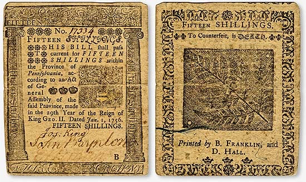
One of the most sought after collector type of Colonial currency are notes printed by Philadelphia printer Benjamin Franklin, whose firm manufactured paper money for Pennsylvania, New Jersey, and Delaware. His expertise in the most imaginative anticounterfeiting ideas began In 1739, when he began printing bills on which he deliberately misspelled Pennsylvania. A counterfeiter, Franklin figured, would correct the spelling on the assumption that the bills were themselves fakes, produced by a less literate criminal.
The back of each of the bills featured an image of a leaf. Franklin worked with blocky lead printer's type, but the leaves, with their traceries of veins, had the fine detail of copper engravings. These "nature prints" succeeded in baffling counterfeiters, and everyone else as well. It wasn't until the 1960s that a historian discovered the secret: Franklin had made lead casts of actual leaves.
Franklin, our national symbol of thrift, was a strong advocate of paper money, which to some represented economic irresponsibility. He argued to the English Board of Trade that the colonial economy could not survive on coins alone. But the dramatic fluctuations in the value of colonial currency - not to mention the confusion caused by all the different notes - worked against the interests of British merchants. In 1764, Parliament passed the Currency Act, which prohibited any further issue of American paper money. Like the Stamp Act the following year, this attempt to impose control over the colonies succeeded only in uniting them in protest.
NUMISMATIC AND HISTORICAL QUESTIONS AND FACTS (JANUARY)
Q. Is it true that individuals could have the U.S. Mint strike Trade dollars for them, if the individual provided their own silver?
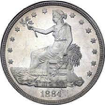
A. Individuals were charged a half percent striking fee under an 1873 law to have their own silver struck into Trade dollars. These coins were intended to be used only for international trade and were not meant to be released to the general public and such use was actually prohibited by law. In March 1875 the fee was raised to one percent in a effort to discourage their release to the gener- al public. However, the value of silver had dropped to the point that, even with the cost of striking, it still was economically viable to have $1 face value U.S. coins minted.
Q. What is a “hoer” note?
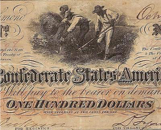
A. There are 2 Confederate notes that depict the vignette of 3 slaves hoeing (weeding) cotton. The first was a $50 First Issue (1861 T-1) note, and the second, is a $100 (Fourth Issue T-42). Some collectors like to collect Confed- erate notes by the vignette on the note. There are 39 dif- ferent vignettes on Confederate notes and 13 portraits. There is a number of varieties of those vignettes depend- ing on the note design and issue.
Historical Fact: With all of the political talk of the last few months I thought I would in- clude an article written by Peter Huntoon, staff writer for the Bank Note Reporter.
“The First National Bank of Liberal MO, charter 7094, lasted less than seven years be- tween 1903 and 1910 before being converted into the Bank of Liberal under a state charter. During its short existence the bankers issued small number of $5, $10, and $20 Red Seals. None have been reported. The town currently has a population of less than 800 and is located north of Joplin close to the western border of the state.
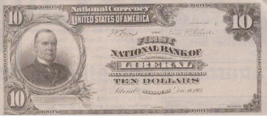
Now this was a town with an interesting founding. George Walser, a free thinking lawyer, bought 2,000 acres upon which he organized the town in 1880 as a utopia for atheists where Christians were not to be allowed. “With one foot upon the neck of priestcraft and the other upon the rock of truth” he declared it a home for intellectual infidels that should have neither God, Jesus, devil, hell, church, preacher, nor saloon. Of course, Christian missionaries took all of that as quite a challenge and slowly infil-trated the place despite the early posting of Walser’s followers at the train station who would advise disembarking Chris- tians that they “weren’t welcome.” (Peter Huntoon, Bank Note Reporter, Sept. 2016) Ed. note:The banknote is a recently discovered proof example.
Book Recommendation
A Guide Book of Morgan Silver Dollars, 5th Edition
 In the fifth edition of A Guide Book of Morgan Silver Dollars, Q. David Bowers offers an engaging portrait of the country's most popular classic coin. You'll learn what to look for when you buy, how to grade your coins, how to cherrypick varieties, and ways to become a smarter collector.
In the fifth edition of A Guide Book of Morgan Silver Dollars, Q. David Bowers offers an engaging portrait of the country's most popular classic coin. You'll learn what to look for when you buy, how to grade your coins, how to cherrypick varieties, and ways to become a smarter collector.
The pricing, text, and certified population data have been edited and updated. New research covers counterfeit error coins and other topics, including a numismatic bombshell: recent discoveries and photographs revealing the previously unknown 1964 Morgan silver dollar.
The fifth edition includes a history of the silver dollar dating back to the 1790s, and chapters on the Morgan dollar's design, its minting process, the five mints that struck the coin from 1878 to 1921, and Treasury hoards and other accumulations. Collectors benefit from advice on ways to collect Morgan dollars; grading and the marketplace, and how to specialize in die varieties. The book's year-by-year catalog is an analysis by date and mintmark of more than 100 coins in the series, priced in up to eleven circulated grades and three levels of Proof. Appendices offer further study of Morgan dollar patterns and error and misstruck coins. (Ed.Note: this months selection was inspired by Phil DeAgustino and his donation of this book for the Christmas party raffle!)
Coin of the Month
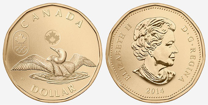
The Canadian one dollar coin, commonly called the loonie, is a gold-colored one-dollar coin introduced in 1987. It bears images of a common loon, a bird which is common and well known in Canada, on the reverse, and of Queen Elizabeth II on the obverse.
The coin has become the symbol of the Canadian dollar: media often discuss the rate at which the loonie is trading against other currencies. The nickname loonie (huard in French) became so widely recognized that in 2006 the Royal Canadian Mint secured the rights to it. When the Canadian two-dollar coin was introduced in 1996, it was in turn nicknamed the "toonie" (a portmanteau of "two" and “loonie").
It has been produced by the Royal Canadian Mint at its facility in Winnipeg from 1987 to present with the following specs: Weight- 6.27 g. Composition: .91.5% Nickel and 8.5% Bronze plating. Diameter: 13 or 26.5 mm. Eleven sided, smooth edge.
Currency Note of the Month

Since the “Coin of the Month” is the Canadian dollar coin I thought it appropriate that I feature the note that it replaced.
On July 3, 1934, with only 10 chartered banks still issuing notes, the Bank of Canada was founded. It took over the federal issuance of notes from the Dominion of Canada. It began issuing notes in denominations of $1, $2, $5, $10, $20, $25, $50, $100, $500 and $1000. In 1944, the chartered banks were prohibited from issuing their own currency, with the Royal Bank of Canada and the Bank of Montreal among the last to issue notes. The $1 note was printed from 1935 to 1989. Printing of the $1 note ceased in 1989 after the release of the loonie (in 1987) had been implemented. These notes are virtually never seen in circulation today. The most recent banknote series that included the $1 note was the Scenes of Canada, with the $1 note released in 1974, coloured green and black. The face featured a portrait of Queen Elizabeth II; the back featured an image of Parliament Hill from across the Ottawa River, with log driving activities taking place on the water.
NUMISMATIC AND HISTORICAL QUESTIONS AND FACTS (DECEMBER)
Q. What is a piedfort coin?
A. A piedfort (French pronunciation: pee-ay-for or pyay-for; English pronunciation: 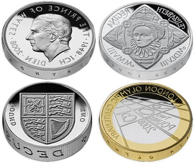 peed-fert or peed-fort) is an unusually thick coin, often exactly twice the normal weight and thickness of other coins of the same diameter and pattern. Piedforts are not normally circulated, and are usually only struck for presentation purposes by mint officials (such as patterns), or for collectors, dignitaries, and other VIPs. Piedfort is commonly misspelled as "piefort".The first British piedforts were silver pennies minted during the reign of Edward I (1239 to 1307). Britain stopped routinely minting piedforts in 1588, but France continued to mint them for at least another 150 years before also ceasing production. The routine production of piedforts began again in France in 1890, and Britain began to produce piedforts available to the public for the first time in 1982. Since then, Great Britain's Royal Mint has become well known for creating many commemorative piedfort coins. China produced piedforts for collectors in 1988.
peed-fert or peed-fort) is an unusually thick coin, often exactly twice the normal weight and thickness of other coins of the same diameter and pattern. Piedforts are not normally circulated, and are usually only struck for presentation purposes by mint officials (such as patterns), or for collectors, dignitaries, and other VIPs. Piedfort is commonly misspelled as "piefort".The first British piedforts were silver pennies minted during the reign of Edward I (1239 to 1307). Britain stopped routinely minting piedforts in 1588, but France continued to mint them for at least another 150 years before also ceasing production. The routine production of piedforts began again in France in 1890, and Britain began to produce piedforts available to the public for the first time in 1982. Since then, Great Britain's Royal Mint has become well known for creating many commemorative piedfort coins. China produced piedforts for collectors in 1988.
Q. In reading about obsolete notes, I am seeing references to the terms "spurious", "counterfeit", and "raised". What are the differences as they relate to obsolete currency?
A. Obsolete currency notes are notes issued by any public entity prior to the Federal Government issues starting in 1865. At best, the U.S. banking system was a hodgepodge of State and Municipal banks plus various businesses all issuing various types of bank and change notes which made things easy for the scam artists of the time.
The term “spurious” is used for a note where the stated issuer or bank didn’t exist. In other words a totally fake note.
“Counterfeit” means that while the issuer or Bank was a real business or bank, the note itself was not legally issued by them and thus was worthless.
Lastly, a “raised” note is a real issued note that has been altered to increase the value, such as changing a $1 note to a $5 note. This could be done in a number of ways, varying from crudely pasting over the denomination to actually purchasing notes from a printer and making them any denomination wanted.
Surprisingly, these notes all circulated because it was difficult to determine the validity of any specific note unless the person was able to go to the locale in person. Because of that most obsolete reference books list all of these types of notes with notations as to their status.
Historical Fact: There are regular references to “The Seven Wonders of the World” but few know what they are (or were). Various lists of the Wonders of the World have been compiled from antiquity to the present day, to catalogue the world's most spectacular natural wonders and manmade structures.
The Seven Wonders of the Ancient World is the first known list of the most remarkable creations of classical antiquity; it was based on guidebooks popular among Hellenic sightseers and only includes works located around the Mediterranean rim. The number seven was chosen because the Greeks believed it represented perfection and plenty, and because it was the number of the five planets known anciently, plus the sun and moon.The original wonders list was compiled by the historian Herodotus (ca. 484 – 425 BCE), and the scholar Callimachus of Cyrene (ca. 305 – 240 BCE) at the Museum of Alexandria. Their writings have not survived, except as references.
The classic seven wonders were:
• Great Pyramid of Giza
• Hanging Gardens of Babylon
• Statue of Zeus at Olympia
• Temple of Artemis at Ephesus
• Mausoleum at Halicarnassus
• Colossus of Rhodes
• Lighthouse of Alexandria
The only ancient world wonder that still exists is the Great Pyramid of Giza.

Coin of the Month

The gold dollar was produced from 1849 to 1889. 1849 to 1853 gold dollar coins were 13 mm across and are called Type I. Type II gold dollars were thinner but larger at 15 mm diameter and were produced from 1854 to 1855. The most common gold dollar are the Type III and started in 1856 until 1889. Production US $1 gold dollars was high until the Civil War and by 1863, only the larger value gold coins were produced in large quantities.
Most gold coins produced from 1863 and onward were produced for imports to pay for enormous amounts of war material and interest on some US Government bonds. Composed of 90% pure gold, it was the smallest denomination of gold currency ever produced by the United States Federal government. When the US system of coinage was originally designed there had been no plans for a gold dollar coin, but in the late 1840s, two gold rushes later, Congress was looking to expand the use of gold in the country’s currency. The gold dollar was authorized by the Act of March 3, 1849, and the Liberty Head type began circulating soon afterward. Because of the high value of gold, the gold dollar is also the smallest coin in the history of US coinage.
Minted from 1849 to 1854 at the Philadelphia, Charlotte, Dahlonega, San Francisco, and New Orleans mints. Specs: Weight- .04837 oz. Composition: .900 Gold and .100 Copper. Diameter: 13 or 15mm. Reeded Edge. Designer-James B. Longacre.
Currency Note of the Month

This month I picked the Series of 1886-1908 $10 Silver Certificate, commonly called the “Tombstone” note. The portrait of Hendricks appears like it is featured on a tombstone. The tombstone design may not be an accident by the Bureau of Engraving and Printing. Thomas Hendricks (the man in the portrait) died just a few months before his image was used on 1886 $10 silver certificates. So the tombstone style may have been an acknowledgement to his recent passing. Hendricks was the acting Vice-President of The United States when he died in office.
The Tombstone ten dollar silver certificate was issued from 1886 until 1908. No star notes were printed for either series of 1886 and 1891, but there are some 1908 Tombstone star notes known to exist. There are ten different signature combinations over the span of issued notes There is no premium for one signature combination over another. Each note has a red seal and blue serial numbers.
Type Values range from $500 in Fine up to around $7,000 in Uncirculated condition. 1886 specimens are generally double those figures.
Book Recommendation
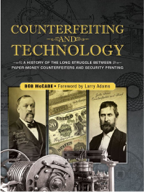 Counterfeiting and Technology: A History Of The Long Struggle Between Paper-Money Counterfeiters And Security Printing by Bob McCabe
Counterfeiting and Technology: A History Of The Long Struggle Between Paper-Money Counterfeiters And Security Printing by Bob McCabe
For centuries legitimate authorities and equally determined rogues have fought in an attempt to improve (or copy) the technology and security of paper money. Now in Counterfeiting and Technology, their stories are captured in vivid detail from colonial times to the present. Paper-money historian Bob McCabe explores the lives of the innovators who made brilliant advancements in the chemistry and ingenuity of America's paper money. Counterfeiters, mostly unknown or unrecognized for their dishonest cleverness until now, are finally brought to light. McCabe details the beginning and evolution of the U.S. Secret Service and the men who sought to capture the villains. And he follows the technology of American currency—from paper-making fugitive inks to roller presses—from early colonial attempts to the modern era.
Counterfeiting and Technology presents the history of paper money in a way that's never been seen before. It combines chemistry and artistry, inventions and escapades, tales of arrest and daring escapes. Collectors and historians of American money will love this engaging and informative narrative about our nation's paper currency.(Amazon)
NUMISMATIC AND HISTORICAL QUESTIONS AND FACTS (NOVEMBER)
Q. Has a coin ever been listed in the “Red Book” and then removed?
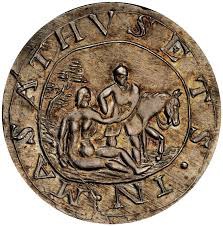
A. Yes, at least one, the Good Samaritan Shilling, was listed in the first 12 or more editions. It was described thusly, “The Good Samaritan Shilling, supposed to be a pattern piece, was struck at a Boston mint and is extremely rare. This piece is of the same general type as the Pine Tree Shilling, but has a device illustrating the parable of the Good Samaritan on the obverse. It is in silver and dated 1652 on the reverse.” In 1959, numismatic researcher Eric P. Newman exposed the piece as a fraud saying the Good Samaritan Shilling “was the fakest coin in history!”
In 1848 the British Museum purchased a Good Samaritan Shilling that was known to exist as early as 1730. The coin, Newman determined, was a Pine Tree Shilling on which the obverse had been ground off and replaced with the seal of the British Commission of Sick and Wounded, a 17th century precursor of the Red Cross. English coin dealer Thomas Snelling and American dealer Thomas Wyatt separately faked their own versions of the supposedly genuine coin and palmed them off on unsuspecting collectors. The “Red Book” listed the piece for a few years but added a note that the known specimens were fabrications.(Coin World, Gerald Tebben, 2016)

Q. Ever heard of a “scruple” coin?
A. A scruple coin is actually not a coin but an apothecary weight. Pharmacists used them to measure medicines on a small balance scale prior to digital scales and and medicine in pill form. They have the appearance of coins and are often collected like a numismatic item. They are relatively inexpensive. For info: a scruple is equal in weight to 20 grains and 3 scruples equals a drachm or dram.

Historical Fact: Hollow coins were used by Soviet agents as early as the 1930’s to hide microdots (tiny photographic reductions of documents) and coded messages. The ploy was discovered in Brooklyn, NY in 1953 when a newspaper boy dropped a nickel he was given by a woman buying a paper. Upon hitting the ground, the coin popped apart, revealing a tiny photograph hidden inside. The photo contained a series of numbers. An exhaustive four-year investigation of the mysterious coin by the FBI revealed the existence of a Soviet spy ring in New York, resulting in the arrest and imprisonment of Soviet agent Rudolf Abel. The woman who gave the newspaper boy the hollow coin was a spy associate of Abel’s.
Coin of the Month
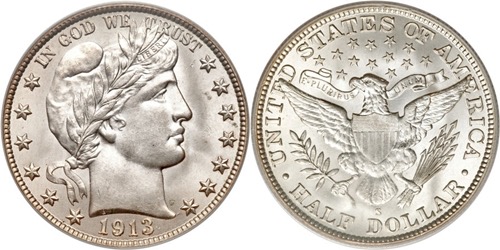
The Barber Half Dollar was designed by United States Bureau of the Mint Chief Engraver Charles E. Barber. They were minted between 1892 and 1915. By the late 1880s, there were increasing calls for the replacement of the Seated Liberty design, used since the 1830s on most denominations of silver coins. In 1891, Mint Director Edward O. Leech, having been authorized by Congress to approve coin redesigns, ordered a competition, seeking a new look for the silver coins. As only the winner would receive a cash prize, invited artists refused to participate and no entry from the public proved suitable. Leech instructed Barber to prepare new designs for the dime, quarter, and half dollar, and after the chief engraver made changes to secure Leech's endorsement, they were approved by President Benjamin Harrison in November 1891. Striking of the new coins began the following January.
Public and artistic opinion of the new pieces was, and remains today, mixed. In 1915, Mint officials began plans to replace them, after the design's minimum term expired in 1916. The Mint issued Barber dimes and quarters in 1916 to meet commercial demand, but did not issue half dollars. Before the end of the year, the Walking Liberty half dollar had begun production. Barber half dollars saw heavy circulation during their heyday and mainly for this reason (and collector demand), Barber half dollars of any date are becoming very difficult to locate in the higher circulated grades (Extremely Fine and above). Barber half dollars in Fine and Very Fine are also relatively scarce in number when compared to the numbers of Barber half dollars that grade between Good and Very Good.
Minted at the Philadelphia, Denver, New Orleans, and San Fransisco Mints in 1892 to 1915 they have the following specs, weight: 12.5 grams, diameter: 30.6 mm, composition: .900 silver and .100 Copper. Reeded edge.
Currency Note of the Month

These Zimbabwean $100 Trillion notes are the largest denomination currency notes ever issued. Only a few million of the note shown were actually printed and by the time they were issued they were practically worthless. Zimbabwe issued these large denomination notes in early 2009 but in just a few months one of these wouldn’t even pay for bus fare. Shopkeepers were literally changing their cash prices hourly in an effort to keep up with a hyperinflation rate of over 230 million% per year! Use of the Zimbabwean dollar as an official currency was effectively abandoned on 12 April 2009. The Zimbabwean dollar was demonetised in 2015, with outstanding bank accounts able to be reimbursed until April 30, 2016 at a rate of $5 US to 175 Quadrillion Zimbabwe dollars! The front of the notes depict the famous Chiremba Balancing rocks and the reverse vignettes are local Zimbabwean scenes. Surprisingly, these notes were very inexpensive after they were demonetized, $3-4 for uncirculated notes, but due to collector interest they currently sell for $50-60. As an aside, to make change for these notes, denominations of $50 Trillion, $10 Trillion, and $500 Million were also printed.
Book Recommendation
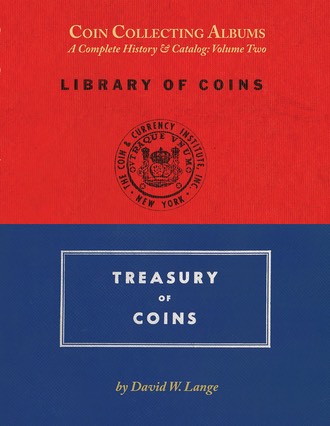
Coin Collecting Albums - A Complete History & Catalog, Volume Two: Library of Coins & Treasury of Coins by David W. Lange (Author)
This book is a complete history and catalog of coin albums produced by The Coin & Currency Institute. It features detailed listings of each item in the Library of Coins and Treasury of Coins lines. It is richly illustrated, including 64 pages in full color. Also included is a biography of Robert Friedberg and a profile of his books.
NUMISMATIC AND HISTORICAL QUESTIONS AND FACTS (OCTOBER)
Q. Are the terms “Eagle” and its derivatives I.E. half-eagle, quarter-eagle, etc. official names or are they just the common names numismatists use to describe the different weight U.S. gold coins?
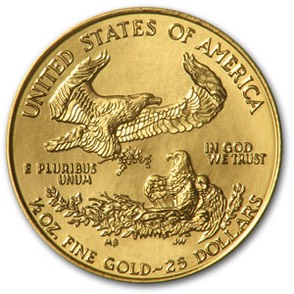
A. It is a common misconception that "eagle"-based nomenclature for gold U.S. coinage was merely slang. This is not the case. The "eagle," "half-eagle" and "quarter-eagle" were specifically given these names in the Coinage Act of 1792. Likewise, the double eagle was specifically created as such by name ("An Act to authorize the Coinage of Gold Dollars and Double Eagles", title and section 1, March 3, 1849).
Q. What is a “touch” coin?

A. It was believed at one time that Royal Monarchs and the Pope were endowed with the power to heal by touching the afflicted person. Touch coins, are coins or medallions that were both given out as momento’s and some that are believed to have healing powers imparted to them by the giver. The tradition of touch pieces goes back to the time of Ancient Rome, when the Emperor Vespasian (69–79 AD) gave coins to the sick at a ceremony known as "the touching.” Many touch piece coins were treasured by the recipients and sometimes remained in the possession of families for many generations, such as with the "Lee Penny" obtained by Sir Simon Lockhart from the Holy Land whilst on a crusade. This coin, an Edward I groat, still held by the family, has a triangular-shaped stone of a dark red color set into it. The coin is kept in a gold box given by Queen Victoria to General Lockhart. It can supposedly cure rabies, hemorrhage, and various animal ailments. The coin was exempted from the Church of Scotland's prohibition on charms and was lent to the citizens of Newcastle during the reign of King Charles I to protect them from the plague. (Wikipedia)
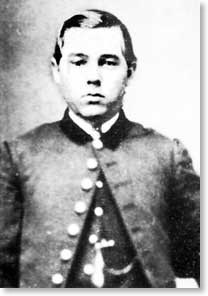
Educational Fact: John Summerfield Staples is not a common name although he holds a unique place in the history of the Civil War. Born in 1845 in Stroud Township in rural Pennsylvania, he enlisted in late 1862 as a private in Company C of the 176th Pennsylvania volunteer infantry, but only served a few months due to illness, likely typhoid fever. Following his medical discharge, he moved to Washington, D.C., where he worked with his father as a carpenter. In October 1864, he was approached by a representative of President Lincoln. During the Civil War, it became customary for many citizens to pay for "substitutes" to serve in the army in their place. Hoping to set a good example, President Lincoln selected Staples as his substitute and offered him a bounty of $500. Staples saw little action during the year he served as the president's representative, primarily working as a clerk and prison guard. He mustered out in September 1865. Following the war, Staples returned to Pennsylvania where he died in 1888. He is buried in Stroudsburg Cemetery. In 1910 a bill appropriating funds to erect a memorial to Summerfield was introduced in the United States House of Representatives. In 1999, the Pennsylvania Historical and Museum Commission and the Monroe County Historical Association erected a historical marker on W. Main Street in Stroudsburg to commemorate John Summerfield Staples and his ties to President Lincoln.
Book Recommendation
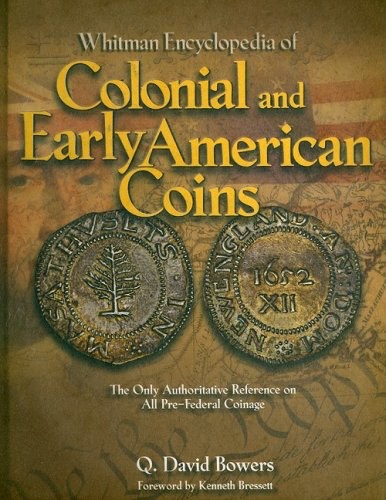
The Whitman Encyclopedia of Colonial and Early American Coins By Q. David Bowers.Foreword by Kenneth Bressett. From Q. David Bowers comes a book so comprehensive and authoritative that only the "Dean of American Numismatics" could have created it! Drawing on the expertise of dozens of specialists from around the world, plus Bowers's own vast knowledge of the subject, the Whitman Encyclopedia of Colonial and Early American Coins includes: Chapter 1: Money in Early America Chapter 2: Minting and Distribution Chapter 3: Collecting Colonial Coins Chapter 4: How to Use This Book Chapter 5: Silver Coins of Massachusetts Chapter 6: British Coins and Tokens for America, Early Issues Chapter 7: American Coins and Tokens from 1783 to 1788 Chapter 8: Other Early American Pieces Chapter 9: European Coins and Tokens for America, Later Issues Chapter 10: Early Washington Coins and Tokens Chapter 11: Unrelated Foreign Coins Chapter 12: 19th Century Colonial Copies and Fantasies.This is the new definitive reference on colonial and early American coins and tokens, and related issues.
Currency Note of the Month

The note I picked this month has a very interesting story behind it. It is the Series 1900 $10,000 Gold Certificate. Most were destroyed, with the exception of a number of bills that were in a box in a post office near the U.S. Treasury in Washington, D.C. There was a fire there on 13 December 1935, and employees threw burning boxes of Treasury material out into the street to reduce the fuel for the fire. The box of canceled high-denomination currency burst open in the street and were quickly snatched up by passers-by. However, much to the dismay of the scavengers, they were worthless due to the cancellation markings. There are several hundred outstanding, and their ownership is technically illegal, as they are stolen property. However, due to their lack of intrinsic value, the government has not prosecuted any owners, citing more important concerns. They carry a collector value in the numismatic market and, as noted in Bowers and Sundermans' The 100 Greatest American Currency Notes, are the only United States notes that can be purchased for less than their face value. This is the only example of "circulating" U.S. currency that is not an obligation of the government, and thus not redeemable by a Federal Reserve Bank. The note bears the portrait of Andrew Jackson and has no printed design on its reverse side. Editors Note: As an aside, there is a local CA dealer that has one of these notes for sale and due to its grading certification having a notation of “Exceptional Paper Quality” is worth a substantial premium. Most of these notes show evidence of fire or water damage.
Coin of the Month
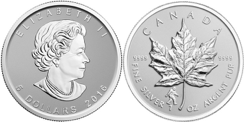
The legend of the elusive ape-man continues at the Royal Canadian Mint. In the U.S. we refer to this creature as Bigfoot, in Asia they refer to it as the Yeti, and in the far reaches of the Canadian wilderness, Sasquatch is the hairy beast that roams the woods and now appears on silver rounds.
The RCM is never one to shy away from the chance to include a unique privy mark on their coins. Their newest privy is the Bigfoot, featured on the RCM’s 2016 $5 Silver Maple Leaf Coin.The RCM’s eccentric privy also makes it a great coin for collectors interested in unusual coin designs.
The obverse features the countenance of Queen Elizabeth II and the reverse portrays the iconic Canadian maple leaf. Below the maple leaf appears Sasquatch in stride. The image of the ape-man is a familiar one to cryptozoologists and anyone who’s seen the 1967 images from the Patterson-Gimlin film that claimed to capture Sasquatch on video.
From descriptions, Bigfoot is an enormous creature standing around 10 feet tall and weighing around 500 lbs. On Canada’s $5 fine silver coin however, the Sasquatch is mere millimeters.
Thousands of reports from all over the world have claimed to have encountered the creature, but none have been confirmed. So the legend of Bigfoot continues. No matter what you call it—Sasquatch, Bigfoot, or the Yeti—the fascination with its possible existence remains. Produced by the Royal Canadian Mint in 2016 they have the following specs, weight: 31.03 grams, diameter: 38mm, composition: 1 troy oz. .9999 silver. Reeded edge.
NUMISMATIC AND HISTORICAL QUESTIONS AND FACTS (SEPTEMBER)
Q. I’ve seen gold jewelry advertised as available in different colors. What is the difference that makes that happen?
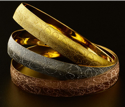
A. Gold is usually sold in 3 general hues, yellow gold, red gold, and pink gold. The difference is in the type and amount of the alloys used. Since gold is such a soft metal, it is usually alloyed with other metals. For example, 22K Yellow gold is 91.6% gold, 5% Silver, 2% copper and 1.33 zinc. 18K Red gold is 75% gold and 25% copper and 18K Pink gold is 75% gold, 20% copper and 5% silver. By varying the percentages of the different metals in the alloy various hues can be produced.
Q. I specialize in aviation related coins and picked up an Australian coin with an early plane that has the name “Houdini’ on it. Could you give me some details?
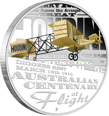
A. What you have is a 2010 Perth Mint commemorative coin celebrating the 100th Anniversary of the first airplane flight in Australia. Surprisingly, Harry Houdini, of escape artist fame, was interested in powered flight. He purchased a Voisin French box kite flyer, had it shipped to Australia, and in 1910 became the first person to fly an airplane in Australia! It must not have been that important to Houdini however, because after his historic flights, he sold the airplane and returned to the U.S. to resume his stage career. Your coin has a image of the airplane and the annotation “Diggers Rest (the location) March 18th, 1910”.
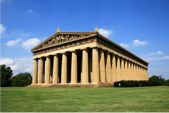
Educational Fact: The Parthenon in Athens, Greece is beyond many peoples budget to visit, but there is also the Parthenon in Nashville! Listed in the U.S. National Register of historic places, it is a full scale copy of the original. Built in 1897 as part of the Tennessee Centennial Exposition, today it functions as an art museum. Alan LeQuire's 1990 re-creation of the Athena Parthenos statue is the focus of the Parthenon just as it was in ancient Greece. The statue of Athena Parthenos within is a reconstruction of the long-lost original to careful scholarly standards: she is cuirassed and helmeted, carries a shield on her left arm  and a small 6-foot-high (1.8 m) statue of Nike (Victory) in her right palm, and stands 42 feet (13 m) high, gilt with more than 8 pounds (3.6 kg) of gold leaf; an equally colossal serpent rears its head between her and her shield. Since the building is complete and its decorations were polychromed (painted in colors) as close to the presumed original as possible, this replica of the original Parthenon in Athens serves as a monument to what is considered the pinnacle of classical architecture. The plaster replicas of the Parthenon Marbles found in the naos (the east room of the main hall) are direct casts of the original sculptures which adorned the pediments of the Athenian Parthenon, dating back to 438 BC. Many fragments of the originals are housed in the British Museum in London; others are at the Acropolis Museum in Athens.
and a small 6-foot-high (1.8 m) statue of Nike (Victory) in her right palm, and stands 42 feet (13 m) high, gilt with more than 8 pounds (3.6 kg) of gold leaf; an equally colossal serpent rears its head between her and her shield. Since the building is complete and its decorations were polychromed (painted in colors) as close to the presumed original as possible, this replica of the original Parthenon in Athens serves as a monument to what is considered the pinnacle of classical architecture. The plaster replicas of the Parthenon Marbles found in the naos (the east room of the main hall) are direct casts of the original sculptures which adorned the pediments of the Athenian Parthenon, dating back to 438 BC. Many fragments of the originals are housed in the British Museum in London; others are at the Acropolis Museum in Athens.
Currency Note of the Month
 Went with a big note this month! An 1891 $1,000 Marcy Silver Certificate sold Wednesday, June 12, for a new world record price of $2.6 million, Stack’s Bowers Galleries has announced.
Went with a big note this month! An 1891 $1,000 Marcy Silver Certificate sold Wednesday, June 12, for a new world record price of $2.6 million, Stack’s Bowers Galleries has announced.
The 1891 $1,000 Marcy Silver Certificate, Graded VF 25 by PMG, is one of two known to exist, with the other held in the National Numismatic Collection at the Smithsonian Institution.
The note was purchased from a collector who wishes to remain anonymous and was sold to an anonymous buyer. On the front and to the right of the note is a depiction of William L. Marcy, a U.S. Senator, the 11th Governor of New York and Cabinet member holding positions of Secretary of War and Secretary of State. To the left is an allegory of Peace, holding a sword with a 1000 counter on a shield. Signatures: James Fount Tillman (Register of the Treasury) and Daniel Nash Morgan (Treasurer of the United States). On the back of the note are the boldly emblazoned words SILVER, CERTIFICATE, UNITED STATES and 1000.
Large-size silver certificates started with the Series of 1878 and ended with the Series of 1923. The Bland-Allison Act of February 28, 1878, which created Morgan silver dollars, was also the genesis for Silver Certificates. A curious section in the legislation stipulated that Silver Certificates were not legal tender but could be exchanged for legal tender silver dollars. Silver Certificates of Deposit were soon printed.
Coin of the Month
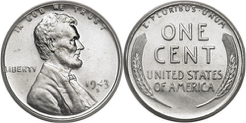
I decided to get back to a basic coin selection this month, after that $1000 note, although the 1943 steel cent has quite an interesting story. The 1943 steel cent, also known as a steel war penny or steelie, was a variety of the U.S. one-cent coin which was struck in steel due to wartime shortages of copper. It used the same design that Victor David Brenner had made in 1909 for the copper Lincoln cent. Due to wartime needs of copper for use in ammunition and other military equipment during World War II, the United States Mint researched various ways to limit dependence and meet conservation goals on copper usage. After trying out several substitutes (ranging from other metals to plastics) to replace the then-standard bronze alloy, the one-cent coin was minted in zinc-coated steel. This alloy caused the new coins to be magnetic and 13% lighter.
However, problems began to arise from the mintage. Freshly minted, they were often mistaken for dimes. Magnets in vending machines (which took copper cents) placed to pick up steel slugs also picked up the legitimate steel cents. Because the galvanization process didn't cover the edges of the coins, sweat would quickly rust the metal. After public outcry, the Mint developed a process whereby salvaged brass shell casings were augmented with pure copper to produce an alloy close to the 1941–42 composition. This was used for 1944–46-dated cents, after which the prewar composition was resumed. Although they continued to circulate into the 1960s, the mint collected large numbers of the 1943 cents and destroyed them.[3]
The steel cent is the only regular-issue United States coin that can be picked up with a magnet. The steel cent was also the only coin issued by the United States for circulation that does not contain any copper. Produced in 1943 by the Philadelphia, Denver, and San Francisco Mints, they have the following specs, weight: 2.7 grams, diameter: 19mm, composition: steel coated with zinc. Plain edge.
Book Recommendation
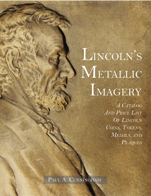 Lincoln's Metallic Imagery by Paul A. Cunningham
Lincoln's Metallic Imagery by Paul A. Cunningham
From nationally and internationally well-known exonumist Paul A. Cunningham comes the completely updated and expanded version of King's 'Lincoln in Numismatics'. Listing all known metallic exonumia bearing Abraham Lincoln's likeness, photos are featured with concise item descriptions, logically organized and easily referenced. This stunning hardbound book features 1600 new, full-color photos, some never before seen by the public. Take a step back in time and trace Lincoln's life from his earliest political days in Illinois to his last days and beyond through the world of coins, tokens, medals and plaques. This book has something to offer all collectors of Lincoln paraphernalia.
NUMISMATIC AND HISTORICAL QUESTIONS AND FACTS (AUGUST)
Q. Since the medals are different for every Olympics do you have any info on the ones that will be awarded in Rio?
A. Gold, Silver, and Bronze are what Olympic dreams are made of! However, the  medals for the Olympic Games Rio 2016 have been made from extra special materials. Produced by the Brazilian Mint, the 5,130 medals for the 2016 Olympic and Paralympic Games will be symbols of sustainability and accessibility as well as sporting excellence. The coveted prizes, which weigh 500g each, comprise 30 per cent recycled silver and bronze while the ribbons are made from 50 per cent recycled PET. Meanwhile, the gold medals are completely free of mercury.
The gold medals are purer than ever, meeting sustainability criteria from extraction to refining, as well as meeting strict environmental and labour laws. They make use of recycled raw silver at 92.5 per cent purity, coming from leftover mirrors, waste solders and X-ray plates. And 40 per cent of the copper used in the bronze medals came from waste at the Mint itself. The substance was melted and decontaminated to provide material for the medals.
The Olympic medal design includes the traditional laurel leaf while the Paralympic prizes feature engravings representing the “seeds of courage, persistence and development of the athletes.” As is tradition, the reverse side of the medal displays an etching of Nike, the Greek goddess of victory. Commemorative gold, silver, bronze and golden bronze medals will be available to purchase.
medals for the Olympic Games Rio 2016 have been made from extra special materials. Produced by the Brazilian Mint, the 5,130 medals for the 2016 Olympic and Paralympic Games will be symbols of sustainability and accessibility as well as sporting excellence. The coveted prizes, which weigh 500g each, comprise 30 per cent recycled silver and bronze while the ribbons are made from 50 per cent recycled PET. Meanwhile, the gold medals are completely free of mercury.
The gold medals are purer than ever, meeting sustainability criteria from extraction to refining, as well as meeting strict environmental and labour laws. They make use of recycled raw silver at 92.5 per cent purity, coming from leftover mirrors, waste solders and X-ray plates. And 40 per cent of the copper used in the bronze medals came from waste at the Mint itself. The substance was melted and decontaminated to provide material for the medals.
The Olympic medal design includes the traditional laurel leaf while the Paralympic prizes feature engravings representing the “seeds of courage, persistence and development of the athletes.” As is tradition, the reverse side of the medal displays an etching of Nike, the Greek goddess of victory. Commemorative gold, silver, bronze and golden bronze medals will be available to purchase.
Q. has the U.S. ever minted bi-metal coin? That is  a coin with a center plug of one metal ringed by a second metal?
a coin with a center plug of one metal ringed by a second metal?
A. While a number of other countries produce 2 and 3 metal coins, the U.S. has only minted one. That is the 2000 Library of Congress Bicentennial $10. The coin is composed of a gold outer ring with a platinum center plug.
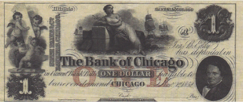
Educational Fact: While most people think that business and afterlife shouldn’t mix, Seth Paine was a spiritualist that founded, helped by major investor Ira B. Eddy, the Bank of Chicago on Sept. 1st, 1852. The prospectus of the new bank, written by Paine himself, stated the banks principals as: “We loan to no one to pay debts. We loan to no one to aid in the murder of anything which has life. We loan to no man to speculate in the necessities of life. We loan nothing on real estate, believing that it cannot be bought or sold. We loan nothing to aid in the manufacture or sale of liquor or tobacco. We loan nothing to gamblers or or money lenders. Our basis for making loans is the established character of the borrower. He must be temperate, honest, and religious, with a mind sufficiently developed to understand business.” Soon after the bank opened a trance medium named Mrs. Herrick was hired to channel the spirit of Alexander Hamilton and Mrs. Herrick (or Alexander Hamilton depending on your belief!) approved all customers. Anyone the spirits didn’t approve of was thrown out by the bouncers on staff! Women, children, Negroes (sic), and spiritually minded men were served in that order. Eventually the largest investor in the bank, Ira B. Eddy was adjudged insane and an injunction served to protect his interests in the bank. All these things came to a head with a run on the bank and the subsequent arrest of the entire bank corps. This caused the bank to go out of business. However, despite its bizarre operating procedures, the bank was totally solvent and all banknotes issued by the bank were redeemed in full.
Book Recommendation
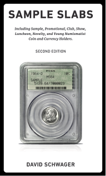 The book everyone has been waiting for is now out! That's right, the slab book was recently released and well worth the small price to get one. Over 420 pages in length, it cover over 80 companies and 200 varieties of normal production, sample slabs, novelty slabs and bodybags combined. Each one has a photo along with a description of the slab and history of the company and slabbing in general.Collecting sample slabs is easy and fun. It can be a simple as going to a show and stopping by a services table to pick a free one up or browsing eBay. They are relatively scarce, and usually no more than several hundred are made for each show or new label change. On average there are less than 200 produced and are never made again. Many collectors pick them up at the show and later crack out the coin and spend it, or just plain forget about them in some dusty drawer. New varieties are constantly being found which adds to the excitement of this new field.
The book everyone has been waiting for is now out! That's right, the slab book was recently released and well worth the small price to get one. Over 420 pages in length, it cover over 80 companies and 200 varieties of normal production, sample slabs, novelty slabs and bodybags combined. Each one has a photo along with a description of the slab and history of the company and slabbing in general.Collecting sample slabs is easy and fun. It can be a simple as going to a show and stopping by a services table to pick a free one up or browsing eBay. They are relatively scarce, and usually no more than several hundred are made for each show or new label change. On average there are less than 200 produced and are never made again. Many collectors pick them up at the show and later crack out the coin and spend it, or just plain forget about them in some dusty drawer. New varieties are constantly being found which adds to the excitement of this new field.
Their scarcity does not keep them from being unattainable. Most samples can be found in the $8-$15 range and the more scarce ones in the $40-$55 (few dozen known) range. Bargains are definitely out there in dealer junk boxes, as most of them don’t know much about samples. Collecting scarce samples is fun, cheap and somewhat unappreciated right now.-Cameron Kiefer
Coin of the Month
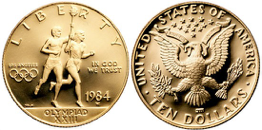
In 1984 the U.S. minted a $10 Los Angeles Olympiad Commemorative Gold Coin. It was the first U.S. gold piece minted in over 50 years and it is also noteworthy for being the first coin to bear the “W” mintmark of West Point.
The obverse depicts two runners bearing the olympic Torch aloft and was designed by John Mercanti based on a concept by James Peed; an artist at the mint. The eagle on the reverse is modeled after that on the Great Seal.
Produced in 1984 by the West Point Mint, they have the following specs, weight: 16.718 grams, diameter: 27 mm, composition: 900 gold and .100 copper. Reeded edge.
Currency Note of the Month
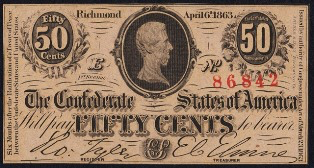
Confederate notes are very popular with collectors and this month I decided to feature the smallest denomination Federate currency printed, the 50c note. These notes were part of both the 6th and the 7th issues of Confederate currency which accounts for the 2 different issue dates. They are also noteworthy as being the only Confederate currency with printed signatures vice hand-signed.
The notes feature the portrait of Jefferson Davis in profile and have the printed signatures of Robert Tyler (Confederate Register of the Treasury and son of U.S. President Tyler) and Edward C. Elmore (Treasurer of the Confederacy). The reverse is blank. They also feature the promise across the left edge of the bill: "SIX MONTHS AFTER THE RATIFICATION OF A TREATY OF PEACE BETWEEN THE CONFEDERATE STATES AND THE UNITED STATES" and then across the middle, the "CONFEDERATE STATES OF AMERICA WILL PAY FIFTY CENTS TO BEARER”. There is one noted variety for both issues, that being a missing flourish above the series letter. Also the notes have both red and black serial numbers. 1,831,517 of these notes were issued and are worth approx. $50 in uncirculated condition.
NUMISMATIC AND HISTORICAL QUESTIONS AND FACTS (JULY)
Q. I thought that the Declaration of Independence was on display at the Library of Congress. But I recently read that there is more than one original copy?
A. After ratifying the text on July 4, Congress issued the Declaration of Independence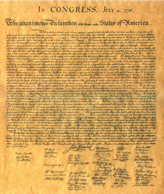 in several forms. It was initially published as the printed Dunlap broadside that was widely distributed and read to the public. The source copy used for this printing has been lost, and may have been a copy in Thomas Jefferson's hand. Jefferson's original draft, complete with changes made by John Adams and Benjamin Franklin, and Jefferson's notes of changes made by Congress, are preserved at the Library of Congress. The best known version of the Declaration, a signed copy that is popularly regarded as the official document, is displayed at the National Archives in Washington, D.C. This engrossed copy was ordered by Congress on July 19, and signed primarily on August 2.
The Dunlap broadsides were the first published copies of the Declaration of Independence, printed on the night of July 4, 1776. It is unknown exactly how many broadsides were originally printed, but the number is estimated at about 200. There were 24 known copies of the Dunlap broadside in 1989, when a 25th broadside was discovered behind a painting bought for four dollars at a flea market. On July 2, 2009, it was announced that a 26th Dunlap broadside was discovered in The National Archives in Kew, England. It is currently unknown how this copy came to the archive, but one possibility is that it was captured from an American coastal ship intercepted during the War of Independence.
in several forms. It was initially published as the printed Dunlap broadside that was widely distributed and read to the public. The source copy used for this printing has been lost, and may have been a copy in Thomas Jefferson's hand. Jefferson's original draft, complete with changes made by John Adams and Benjamin Franklin, and Jefferson's notes of changes made by Congress, are preserved at the Library of Congress. The best known version of the Declaration, a signed copy that is popularly regarded as the official document, is displayed at the National Archives in Washington, D.C. This engrossed copy was ordered by Congress on July 19, and signed primarily on August 2.
The Dunlap broadsides were the first published copies of the Declaration of Independence, printed on the night of July 4, 1776. It is unknown exactly how many broadsides were originally printed, but the number is estimated at about 200. There were 24 known copies of the Dunlap broadside in 1989, when a 25th broadside was discovered behind a painting bought for four dollars at a flea market. On July 2, 2009, it was announced that a 26th Dunlap broadside was discovered in The National Archives in Kew, England. It is currently unknown how this copy came to the archive, but one possibility is that it was captured from an American coastal ship intercepted during the War of Independence.
Q. Why are $2 bills considered unlucky?
A. Two-dollar bills have never been popular. Introduced in 1862 the bill was nicknamed a “deuce” for its “2” denomination but “the deuce” was also a euphemism for the devil which didn’t help its reputation! In 1925 the U.S. government made an unsuccessful attempt to popularize them by inserting one in each pay envelope given to federal employees. Several newspapers offered to aid in the campaign by giving prizes for two-dollar bills containing certain serial numbers. The Post Office Department, however, pronounced this practice a lottery and therefore a violation of the postal laws. There were a number of social mores related to why the notes are considered unlucky. 1. In the 1930’s, a 5 minute session with a prostitute cost $2, thus possession of one of those bills proved its holder had been consorting with ladies of the evening. 2. In the days when election-rigging was the norm, campaign bosses would hire men to vote for their candidate. The ringers would be trucked in, given names from the voters' list to claim as their own, and the name of the man they were to vote for. Once they'd done the deed, they would each be rewarded with a $2 bill. The same fellows would be moved from polling place to polling place, each time to assume new names, vote for the same guy, and be paid again. Having $2 bills in your wallet was therefore proof you'd sold your vote. 3. The standard bet in American horse racing was two dollars, and winners were paid with $2 bills. Ergo, possession of a sheaf of these notes was prima facie evidence that one had been betting on the ponies. Given the prohibitions against gambling (in the not-so-distant past it was considered an activity thoroughly steeped in sin), no respectable person wanted to be associated with it, not even by happenstance.


However, the bad luck could be dispelled by tearing or cutting a corner from the note but a number of people did this every time they spent one which resulted in large quantities being pulled from circulation due to damage! There was also a short-lived superstition in the 1920’s that $2 bills were lucky because it was possible to see four leaf clovers in the lawn of the Monticello vignette under magnification!
Educational Fact: Trade dollars are silver coins minted as trade coins by various countries to facilitate trade with China and the Orient. They all approximated in weight and fineness the Spanish dollar, which had set the standard for a de facto common currency for trade in the Far East. While here in the U.S. the most recognized is the U.S. Trade dollar, there were at least 3 countries that produced silver trade dollars specifically for use in China. These coins, including the U.S. Trade dollar, are the:
U.S. Trade Dollar British Trade Dollar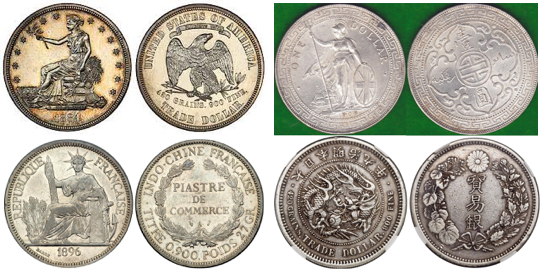
French Indochina Piastre Japanese Trade Dollar
These Trade dollars were generally produced during the mid 1800’s through the turn of the century with various levels of success in the Chinese market. The Chinese also produced their own coin, the Dragon Dollar intended for use in the international market. All of these types of trade dollars were eventually demonetized and redeemed in some way by their issuing country. The U.S. Trade dollar was demonetized in 1887 but was restored to legal tender by the Coinage Act of 1965 making it the only U.S. silver to ever be demonetized.
Book Recommendation
“Philippine Emergency Notes: Counterstamped, Signed & Initialed, Cebu Province” by Kenneth J.E. Berger, D. Env.
While this may seem to be an unusual choice for a book recommendation, I am always happy to give support to a local numismatic writer. Ken Berger is a noted 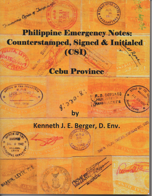 expert in these notes and resides in San Diego. He is also a member of a number of southern California clubs including the San Diego Paper Money Club and the International Numismatic Society of San Diego. By way of background on these notes, at the start of WWII, then Philippines President Quezon authorized the issuance of Emergency currency notes to be used in the country during the war. These notes were signed or stamped as authorization by various individuals, including the Japanese, while they occupied the country, and this book is an examination of all the authenticating signatures and stamps used in each locale. The forward for the book is written by Neil Shafer, noted Philippines currency expert, and author of numerous articles on the subject. The first 200 books are individually serialized and included with the book is a sample authentic Cebu Emergency note with the book serial number matching the serial number of the note! There is also a CD with the book on it in digital format. On a personal note, I purchased my copy from Ken at the San Diego Coinarama show so I was able to have it signed and personalized. I hope to have Neil Shafer also sign it at the Worlds Fair of Money in August.
expert in these notes and resides in San Diego. He is also a member of a number of southern California clubs including the San Diego Paper Money Club and the International Numismatic Society of San Diego. By way of background on these notes, at the start of WWII, then Philippines President Quezon authorized the issuance of Emergency currency notes to be used in the country during the war. These notes were signed or stamped as authorization by various individuals, including the Japanese, while they occupied the country, and this book is an examination of all the authenticating signatures and stamps used in each locale. The forward for the book is written by Neil Shafer, noted Philippines currency expert, and author of numerous articles on the subject. The first 200 books are individually serialized and included with the book is a sample authentic Cebu Emergency note with the book serial number matching the serial number of the note! There is also a CD with the book on it in digital format. On a personal note, I purchased my copy from Ken at the San Diego Coinarama show so I was able to have it signed and personalized. I hope to have Neil Shafer also sign it at the Worlds Fair of Money in August.
Coin of the Month

The United States Bicentennial coinage was a set of circulating commemorative coins, consisting of a quarter, half dollar and dollar struck by the United States Mint in 1975 and 1976. Regardless of when struck, each coin bears the double date 1776–1976 on the normal obverses for the Washington quarter, Kennedy half dollar and Eisenhower dollar. No coins dated 1975 of any of the three denominations were minted.
A nationwide competition resulted in designs of a Colonial drummer for the quarter, Independence Hall for the half dollar and the Liberty Bell superimposed against the moon for the dollar. All three coins remain common today due to the quantity struck. Circulation pieces were in copper nickel; Congress also mandated 45,000,000 part-silver pieces be struck for collectors. The Mint sold over half of the part-silver coins before melting the remainder after withdrawing them from sale in 1986.
Currency Note of the Month
Development of the first banknotes began in the Tang Dynasty during the 7th century, with local issues of paper currency, although true paper money did not appear until the 11th century, during the Song Dynasty. Its roots were in merchant receipts of deposit during the Tang Dynasty (618–907), as merchants and wholesalers desired to avoid the heavy bulk of copper coinage in large commercial transactions.
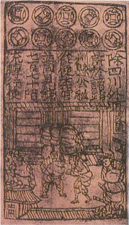
Before the use of paper, the Chinese used coins that were circular, with a rectangular hole in the middle. Several coins could be strung together on a rope. Merchants in China, if they became rich enough, found that their strings of coins were too heavy to carry around easily. To solve this problem, coins were often left with a trustworthy person, and the merchant was given a slip of paper recording how much money he had with that person. If he showed the paper to that person he could regain his money.
Song Dynasty Jiaozi, the world's earliest paper money Eventually, the Song Dynasty paper money called "jiaozi" originated from these promissory notes.
By 960 the Song Dynasty, short of copper for striking coins, issued the first generally circulating notes. A note is a promise to redeem later for some other object of value, usually specie. The issue of credit notes is often for a limited duration, and at some discount to the promised amount later. The jiaozi nevertheless did not replace coins during the Song Dynasty; paper money was used alongside the coins.
The central government soon observed the economic advantages of printing paper money, issuing a monopoly right of several of the deposit shops to the issuance of these certificates of deposit. By the early 12th century, the amount of banknotes issued in a single year amounted to an annual rate of 26 million strings of cash coins.
NUMISMATIC AND HISTORICAL QUESTIONS AND FACTS (JUNE)
Q. I recently read an article in “Paper money” magazine about a vignette on the 3rd Issue 50c Justice fractional note that depicts an eagle that was a Civil War mascot. Do you know any details?
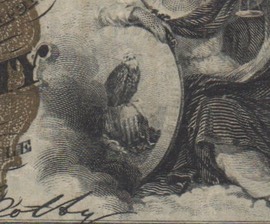
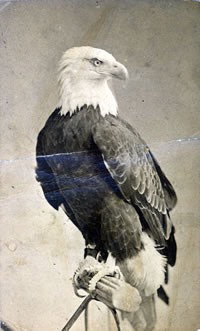
A. On the 50c Justice note there is an eagle on the shield that is under Justice’s right arm. The eagle is “Old Abe” and was the mascot of Co. “C” of the 8th Wisconsin Volunteer Infantry during the Civil War. The following is from the Wisconsin Veterans Museum: “One of the most well known figures in Wisconsin from the Civil War is Old Abe, an American bald eagle who served as the mascot for the Eighth Wisconsin Volunteer Infantry Regiment. He participated in over thirty battles, narrowly avoiding significant wounds on several occasions. During the war, he became a rallying point to Union troops and an anathema to Confederate soldiers, who called him the Yankee Buzzard and set bounties on him. His service to the Union resulted in widespread fame, and his life after the war reflected the esteem with which Wisconsin and other states held him. While fire ultimately took Old Abe’s life and physical remains, his legacy still remains and can be seen to this day around Wisconsin and the United States.”
Q. What are “adjustment marks”?

A. Adjustment marks are marks that are left after a precious metal planchet or coin blank has been filed to make the blank meet the weight standard of a particular denomination coin. Usually the flat side is filed and then when the blank is stamped the file marks are obliterated. However, sometimes deep filing marks may be able to still be seen. There are also some cases, particularly older coins struck without a collar, where the blank is filed on the edge. Generally , adjustment marks are considered mint made and are not a factor in the desirability or grade of the coin. Adjustment marks are far less important on the reverse than on the obverse and less important at the border of a coin than at the center. Adjustment marks are most often seen on coins from the 1790’s and early 1800’s but they are sometimes seen on coins as late as the 1830’s.
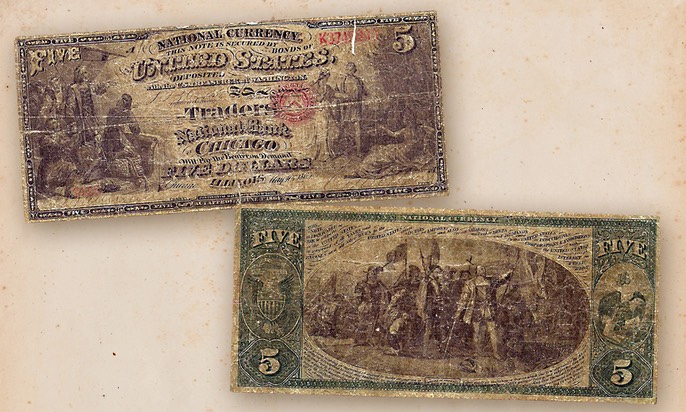
Educational Fact: In 1880 Billy the Kid was involved with a counterfeit money laundering scheme. After knowingly receiving payment for some stolen cattle in the form of counterfeit currency, he was a subject of interest in an investigation by the Secret Service. When Billy discovered that the Secret Service agent sent to New Mexico knew of his involvement, (by illegally reading the agents’ mailed reports, with the help of a crooked mail carrier), he volunteered to snitch on the rest of the ring. However, the original counterfeiter in New York had already been arrested so the Kid’s offer was never acted on and he was never charged. The story would end there except that the agent retained a sample of the counterfeit money as part of his case file and it was recently discovered in the Secret Service archives! The case file contained information about the ring and detailed the Kids’ involvement and provides a glimpse into the real life of one of the Wests most famous personalities. The photo is of the actual note from the file.
Book Recommendation
“Collecting Coins in Retirement” by Tom Bilotta
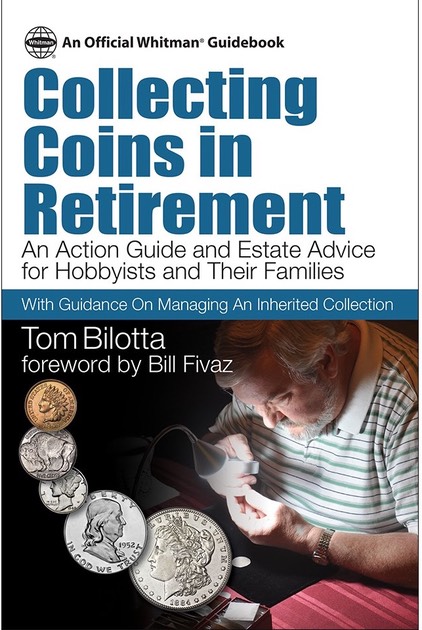
Coin collecting during retirement poses special challenges and offers unique opportunities, says professional numismatist Tom Bilotta, an award-winning developer of software for coin collectors. For more than 20 years Bilotta has worked closely with retirement-age hobbyists, giving him a firm understanding of their wants and needs. Now he shares his insight in a valuable step-by-step guidebook. Are you a longtime collector? Collecting Coins in Retirement coaches you toward increased enjoyment of the hobby and helps you plan for the future. Or maybe you re a family member of a collector? This book helps you understand the hobby and lays the foundation for wisely managing an inherited coin collection. Coin collectors will learn: Why coin collecting is different in retirement, how to devise a collecting strategy that works for you, ways to define your hobby objectives and consolidate your collection, when, where, and how to sell your coins, and important information to share with your family. Ways to allocate your collection to heirs Family members will learn: The issues involved in managing an inheritance The best ways to profit from an inherited coin collection Strategies for selling different parts of a collection Probate and tax considerations Also inside: Coin industry trends Selling on eBay for pleasure and profit Using technology in your hobby and more! Well thought out and presented, logical, and user-friendly Collecting Coins in Retirement is a must-read for hobbyists and their families. (amazon.com)
Coin of the Month

The 2011 Medal of Honor $5 Gold Coin was issued by the United States Mint to recognize and celebrate the establishment of the Medal of Honor, to recognize its recipients, and promote awareness of the award and what it represents. The Medal of Honor is the highest award that may be given to a member of the Armed Services for valor in action against an enemy force.
The obverse design of the gold coin features the original Medal of Honor authorized by Congress as the Navy’s highest personal decoration. The dual dates of “1861” and “2011” are included to mark the 150th anniversary. Additional inscriptions read, “Liberty”, “In God We Trust”, and “Medal of Honor”.
A rendition of Minerva is depicted on the reverse of the coin. She appears in full figure, holding a Union shield and flag with munitions and a Civil War era cannon in the background. Minerva appeared within the central image of the original Medal of Honor.
The maximum authorized mintage for the Medal of Honor Gold Coins was established at 100,000 under the authorizing legislation. Produced in 2011 the Proof coins were struck at the West Point Mint, while the uncirculated coins were struck at the Philadelphia Mint. They have the following specs, weight: 8.359 grams, diameter: 21.6 mm, composition: 90% gold and 10% alloy, reeded edge.
Currency Note of the Month
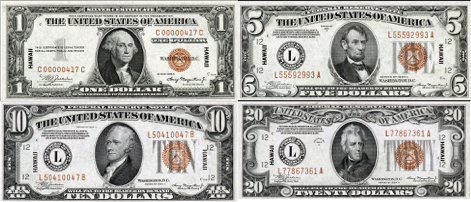
Hawaii Wartime Emergency notes are an interesting currency collecting niche and are enjoyed by a large number of currency collectors. After the attack on Pearl Harbor, military officials surmised that in the event of an invasion of Hawaii, Japanese forces would have access to a considerable amount of US currency that could be seized from financial institutions or private individuals. Faced with this scenario, an order was issued to recall all regular US paper money in the islands, save for set caps on how much money both individuals ($200) and businesses ($500, save extra currency for payroll purposes) could possess at any time.
On June 25, 1942, new overprinted notes were first issued. Series 1935A $1 silver certificate, Series 1934 $5 and $20 Federal Reserve Notes, and Series 1934A $5, $10, and $20 Federal Reserve Notes from the Federal Reserve Bank of San Francisco were issued with brown treasury seals and serial numbers. Overprints of the word HAWAII were made; two small overprints to the sides of the obverse of the bill between the border and both the treasury seal and Federal Reserve Bank of San Francisco seal, and huge outlined HAWAII lettering dominating the reverse. The hope was that should there have been a Japanese invasion, the US government could immediately declare any Hawaii-stamped notes worthless, due to their easy identification.
With this issue, military officials made the use of non-overprinted notes redundant and ordered all Hawaii residents to turn in unstamped notes for Hawaii-stamped notes by July 15. Starting from August 15, 1942, no other paper currency could be used except under special permission. The notes and issuance continued in use until October 21, 1944. By April 1946, the notes were being recalled. Many notes were saved as curios and souvenirs by servicemen.
NUMISMATIC AND HISTORICAL QUESTIONS AND FACTS (MAY)
Q. I recently saw for sale a1920 Maine Centennial Commemorative Half Dollar in XF condition. Since these are commemorative coins why are so many found in circulated condition?
A. The Maine Centennial Half Dollar was authorized by Congress to celebrate the 100th anniversary of the formation of the state of Maine. Congress authorized the minting of the coins on May 10, 1920, to be sold at the centennial celebration at Portland. They were received too late for this event and were sold by the state  treasurer for many years. Ultimately the coins were sold by the Maine Centennial Commission to the public for $1 each but many circulated at face value after the centennial celebration was over. The Philadelphia Mint produced 50,028 coins, with the unsold quantity retained by the Maine State Treasurer, rather than melted.
treasurer for many years. Ultimately the coins were sold by the Maine Centennial Commission to the public for $1 each but many circulated at face value after the centennial celebration was over. The Philadelphia Mint produced 50,028 coins, with the unsold quantity retained by the Maine State Treasurer, rather than melted.
Q. I have read that the only woman portrayed on U.S. Federal currency was Martha Washington. Is that true or have there been others?
A. While it is true in general, there are technical exceptions which accounts for some of the confusion. Martha Washington's featured portrait is on 2 different notes, the obverse of the 1886 $1 Silver Certificate and the reverse of the of the 1896 $1 Educational Silver Certificate with her husband George.
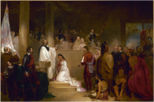
However, Pocohantas was also on 1863-1882 $20 First Charter notes as part of a painting of her baptism featured on the reverse. Her sister is also depicted in the painting but not by name. She is also shown in another vignette painting on 1869 and later $10 Legal Tender notes being presented to another woman, Queen Elizabeth the First.


There are also numerous unidentified women on various notes with group scenes, such as the pilgrim scenes on early large notes. Lastly there are also numerous allegorical images of women representing themes such as education, steam, and electricity on the 1896 Educational Silver Certificate series.

Educational Fact: In 1913 it was legal to mail children. With stamps attached to their clothing, children rode trains to their destinations, accompanied by letter carriers. One newspaper reported it cost fifty-three cents for parents to mail their daughter to her grandparents for a family visit. As news stories and photos popped up around the country, it didn't take long (1920) to get a law on the books making it illegal to send children through the mail. In the early years of Parcel Post service, before the U.S. Post Office implemented more specific regulations, people shipped all sorts of unusual things by mail — including, as suggested above, babies and small children. However, it was neither a regular occurrence nor a routine aspect of the Parcel Post service for people to wrap up children, slap some stamps on them, and ship them cross-country — the few documented examples of children being sent through the mail were nearly all publicity stunts, instances of people who knew the postal workers in their area asking them to carry their babies a relatively short distance along their routes to some nearby relatives, or cases in which children were listed as 'mail' so they could travel on trains without the necessity for purchasing a ticket. Neither of the photographs displayed above has any connection to a real-life case of a child being sent via U.S. mail and are believed to be publicity stunt photos .
Book Recommendation
 The Numismatourist: The Only Worldwide Travel Guide to Museums, Mints, and Other Places of Interest for the Numismatist by Dr. Howard M. Berlin.
The Numismatourist: The Only Worldwide Travel Guide to Museums, Mints, and Other Places of Interest for the Numismatist by Dr. Howard M. Berlin.
The Numismatourist is the first book of its kind as a worldwide travel guide for the numismatist. It is also for the numismatist who is traveling, either on vacation or business, and wishes to visit those places that are of interest to the hobby or profession. Inside you will find a numismatic travel guide, listing over 175 places in 75 countries open to the public, with almost 100 of these described in detail with pictures that are spread over North, Central, and South America, the Caribbean, Europe, Asia, the Middle East, Africa, and Oceania-Pacific. The book's foreword is written by Karen M. Lee, Curator, National Numismatic Collection, National Museum of American History at the Smithsonian Institution.
Coin of the Month
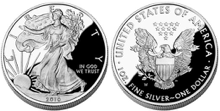
The American Silver Eagle is the official silver bullion coin of the United States. It was first released by the United States Mint on November 24, 1986. It is struck only in the one-troy ounce size, which has a nominal face value of one dollar and is guaranteed to contain one troy ounce of 99.9% pure silver by the U.S. Mint. In addition to the bullion version, the United States Mint also produces a proof version and an uncirculated version for coin collectors.
The design on the coin's obverse was taken from the "Walking Liberty" design by Adolph A. Weinman, which originally had been used on the Walking Liberty Half Dollar coin of the United States from 1916 to 1947. The obverse is inscribed with the year of minting or issuance, the word LIBERTY, and the phrase IN GOD WE TRUST. The reverse was designed by John Mercanti and portrays a heraldic eagle behind a shield; the eagle grasps an olive branch in its right talon and arrows in its left talon, echoing the Great Seal of the United States; above the eagle are thirteen five-pointed stars representing the Thirteen Colonies. The reverse is inscribed with the phrases UNITED STATES OF AMERICA, 1 OZ. FINE SILVER~ONE DOLLAR, and E PLURIBUS UNUM (on the banner that the eagle holds in its beak), as well as the mintmark if applicable.
Produced from 1986 to present at the Philadelphia, San Francisco, and West Point Mints, depending on whether the issue is a bullion, proof, or uncirculated issue, they have the following specs, weight: 31.101 grams, diameter: 40.6 mm, composition: 99.93 silver and .07 copper, reeded edge.
Currency Note of the Month

With the discussion ongoing as to whether a woman should be placed on a U.S. currency note and then on what denomination, I thought that this would be a good choice for this months note. This is a $1 Silver Certificate, Series of 1891 (Fr. #223), depicting Martha Washington with engraved signatures of James Fount Tillman (Register of the Treasury) and Daniel N. Morgan (Treasurer of the United States). Note: FR.#222 is similar but has the printed signatures of Rosecrans and Nebecker. Martha Washington is the only adult woman (other than vignettes representing Liberty and Justice) depicted on United States Banknotes from the federal issuing period of 1861 to the present. The portrait featured on the currency is a copy of a painting by Gilbert Stuart. The portrait is the only existing likeness of Martha Washington by Stuart. He painted it in 1796, along with a companion portrait of George Washington. Stuart deliberately left the portraits unfinished so he would not have to deliver them to the Washingtons. Today the Martha Washington portrait is in the National Portrait Gallery in the Smithsonian Institution. Value of this type note is very dependent on condition. An example in Fine runs approx. $3-400 while uncirculated examples can be obtained for less than $2,000.
NUMISMATIC AND HISTORICAL QUESTIONS AND FACTS (APRIL)
Q. I am familiar with currency notes of huge denominations due to hyperinflation, such as the Zimbabwe Trillion dollar notes, but were there similar high denomination coins?
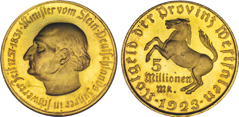
A. One of the most famous examples of hyperinflation is probably the period in the Germany Weimar Republic between 1914 and 1923 when the victor nations in World War I decided to assess Germany for their costs of conducting the war against Germany. With no means of paying in gold or currency backed by reserves, Germany ran the currency presses, causing the value of the Mark to collapse. In 1914 the German Mark was being exchanged at 4.2 marks to the dollar but by 1923 had fallen to 4.2 TRILLION marks to the dollar! A 5 million mark coin was issued by the German State of Westphalia in January 1923 but, despite its high denomination, this coin's monetary value dropped from its issue value of $714.29 to about 1/1000 of a cent by October of 1923, substantially less than the value of its metallic content.
Q. I read that the Japanese have an ATM that actually cleans the bills before dispensing them to customers? Is the story real?
A. There are some bank automated teller machines there that sanitize and press bills before customers withdraw funds. The "Clean ATMs," as they are known, dispense yen notes that, while not quite as crisp as newly minted ones, are nearly wrinkle-free. Customers can even insert bills and get them back laundered.
The machines feed bills through a roller, heat them to 392 degrees and supposedly kill 90 percent of certain staphylococcus bacteria before disbursing them to customers.
 Virgin money plays an especially key role at weddings, where cash is the favored gift. No respectable Japanese would give anything but untainted bills.
Virgin money plays an especially key role at weddings, where cash is the favored gift. No respectable Japanese would give anything but untainted bills.
"If you go to a ceremony, it is our culture to bring money that is not bent," said Masahiro Takahashi, spokesman for the Clean ATM's manufacturer, Hitachi Ltd. "Sometimes we cannot prepare. If you pass by the ATM, it will iron the money."Hitachi had hoped to sell 500 of the machines in the first year, and in the first five months already has orders for 250. Most are from small regional banks that, Takahashi suggested, want to present a "clean" image.
Educational Fact: While it has been a long time since there was a stagecoach robbery to steal the Wells, Fargo and Co. strongbox, Wells Fargo is still going strong and criminals are still targeting its valuables. In January 2015, the Wells Fargo corporate museum in San Francisco was targeted by 3 thieves that rammed an SUV thru the glass entranceway, held a security guard at gunpoint, and broke into a glass display case holding gold nuggets from the Forty-Niner days! While the stolen nuggets are valued at about $10,000 -their sentimental value aside- damage to the entrance was estimated at more than $200,000. Two iconic red and yellow company stagecoaches on display were undamaged in the heist.
museum in San Francisco was targeted by 3 thieves that rammed an SUV thru the glass entranceway, held a security guard at gunpoint, and broke into a glass display case holding gold nuggets from the Forty-Niner days! While the stolen nuggets are valued at about $10,000 -their sentimental value aside- damage to the entrance was estimated at more than $200,000. Two iconic red and yellow company stagecoaches on display were undamaged in the heist.
Book Recommendation
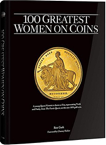 100 Greatest Women on Coins by Ron Guth (Author)100 Greatest Women on Coins is the 10th entry in Whitman Publishing's popular "100 Greatest" library. More than 700 queens, princesses, empresses, actresses, political and religious leaders, goddesses, and other women were up for consideration. They were voted on and ranked by members of Women in Numismatics to determine the 100 Greatest Women on Coins. The 100 Greatest Women on Coins include real women such as Cleopatra, Martha Washington, and Elena Aladova; goddesses such as Athena, Demeter, and Nike; allegorical women (who represent and idea or nationality) such as Miss Liberty, Mother Earth, and Britannia; and women in art, such as La Pietà and Auguste Renoir's Girls at the Piano. "This book is a celebration of women's impact on numismatics," says award-winning author Ron Guth. Each notable woman is described with an illustrated essay and colorful images of the coins on which she appears. Guth also discusses the long history of women featured on coins, and how anyone today can assemble a remarkable and meaningful collection. The book's scholarly value is further expanded with a checklist for the specialist, and bibliography for further research.
100 Greatest Women on Coins by Ron Guth (Author)100 Greatest Women on Coins is the 10th entry in Whitman Publishing's popular "100 Greatest" library. More than 700 queens, princesses, empresses, actresses, political and religious leaders, goddesses, and other women were up for consideration. They were voted on and ranked by members of Women in Numismatics to determine the 100 Greatest Women on Coins. The 100 Greatest Women on Coins include real women such as Cleopatra, Martha Washington, and Elena Aladova; goddesses such as Athena, Demeter, and Nike; allegorical women (who represent and idea or nationality) such as Miss Liberty, Mother Earth, and Britannia; and women in art, such as La Pietà and Auguste Renoir's Girls at the Piano. "This book is a celebration of women's impact on numismatics," says award-winning author Ron Guth. Each notable woman is described with an illustrated essay and colorful images of the coins on which she appears. Guth also discusses the long history of women featured on coins, and how anyone today can assemble a remarkable and meaningful collection. The book's scholarly value is further expanded with a checklist for the specialist, and bibliography for further research.
Coin of the Month

I saw this coin? advertised in Coin World and it was so extravagant I thought I would feature it. It is a 1 Kilo (32.15 oz.) of .999 gold concave coin produced by the Monnaie de Paris mint matched with a porcelain tripod and bowl produced by Sèvres, Cité de la Céramique.
The obverse features the half-length portrate of Maire-Antoinette on the face of the plate designed coin, and embraced by a "Grand Feu Blue" or Royal Blue (Sèvres’ signature colour) enamel backdrop.
The reverse: offsetting the magnificent depth of this coins majestic obverse, the reverse of this coin mimics the beautifully crafted matching Porcelain Bowl. The bowl is a replica of Queen Antoinettes 1787 “bol sein” and is decorated with the Sèvres blue glaze on the interior and topped with a rim of gold. The Bowl's porcelain tripod, also used as a stand for the kilo, has the heads of three goats just as the original did.
It carries a nominal denomination of 5000 Euros and only 16 will be produced. It currently carries a price tag of only $134,000!
Currency Note of the Month
This month I am highlighting a note that is close to home.. You’ll also note that this particular note is the one I used for our club cards! I am including the original auction listing from Heritage Auctions below:

Hemet, CA - $5 1902 Plain Back Fr. 606 The First NB Ch. # (P)10764
This hamlet in Riverside County featured a lone National Bank which was chartered in 1915. It issued Series 1902 Plain Backs in denominations of $5, $10, and $20. When it was liquidated in the summer of 1934, just $440 in large size notes remained outstanding. The recent discovery of this note boosts the number of known large size notes from this bank to just three pieces. Just one of those pieces has made an auction appearance, a modest but well circulated Fine that we sold in 2004 for $6325. This serial number 2 example comes directly from a descendent of one of the signers and, aside from being folded for safe keeping in a desk drawer or jewelry box, saw no wear. The paper is perfectly original with only folds accounting for the grade. The signatures of Thomas and Whittier remain bold, and even margins frame the design details. A simply lovely California rarity. PCGS Very Fine 35PPQ. Ed.:This note sold for $12,337.50 in 2012.
NUMISMATIC AND HISTORICAL QUESTIONS AND FACTS (MARCH)

Q. What is a “raised” note?
A raised note is a note that has been altered to increase its value, usually by changingthe denomination markings . One common method is to glue numerals from higher denomination notes to the corners of lower denomination notes. These bills are also considered counterfeit, and those who produce them are subject to the same penalties as other counterfeiters.
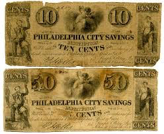
Obsolete notes, were issued by a variety of institutions from 1782-1866 and were particularly susceptible to being raised since vignettes and designs widely varied from bank to bank. Also in a number of cases, when a bank would fail, the unused notes would be prime material for either being raised or falsely issued!
Q. I have what I believe is a Spanish coin, based on the writing, but can’t find any information about it. Any idea?


A. What you have is a Mexican arras token. A Catholic wedding tradition requires that the groom gives the bride a container of 13 coins known as an arras. Wealthy grooms can give gold coins as arras. Next would be silver, then copper coins. Others would use gold-plated or silver-plated tokens (not coins, but they look like coins). Most of these come from Mexico, but there are similar tokens from other countries. These tokens often have the words 'Recuerdo Matrimonial' which translates as 'Wedding Souvenir' or 'Marriage Memory'. Other tokens, specifically 'Maximilano' gold tokens made to look like old-fashioned coins, could be used.
Historical Fact: After last months meeting there was a discussion about the origins of the symbol known as the swastika. So I decided to do a little research on the symbol and its origins.
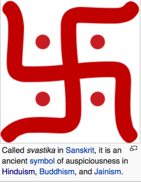
The Swastika (also known as the gammadion cross, cross cramponnée, or wanzi) and as a character: (卐 or 卍) is an ancient religious symbol that generally takes the form of an equilateral cross, with its four legs bent at 90 degrees. It is considered to be a sacred and auspicious symbol in Hinduism, Buddhism and Jainism and dates back to before 2nd century B.C.
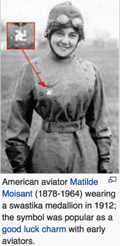
It has been used as a decorative element in various cultures since at least the Neolithic. It is known most widely as an important symbol long used in Indian religions, denoting "auspiciousness."
It was adopted as such in pre-World War I-Europe and later, and most notably, by the Nazi Party and Nazi Germany prior to World War II. In many Western countries, the swastika has been highly stigmatized because of its use in and association with Nazism.
It continues to be commonly used as a religious symbol in Hinduism and Buddhism.
Western literature's older term for the symbol, gammadion cross, derives mainly from its appearance, which is identical to four Greek gamma letters affixed to each other.The name swastika comes from the Sanskrit word svastika, meaning "lucky or auspicious object".
Book Recommendation
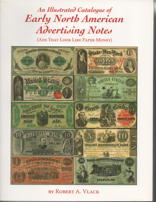 An Illustrated Catalogue of Early North American Advertising Notes: (Ads That Look like Paper Money) by Robert A. Vlack. The only catalog of American advertising notes. This catalog covers all types of firms for the United States and Canada. A black and white image of each note is provided. The Catalog covers advertising notes for all time periods from printers, engravers, banknote engravers, and security features for all international firms. This is an interesting catalog and is considered the best reference on the subject.
An Illustrated Catalogue of Early North American Advertising Notes: (Ads That Look like Paper Money) by Robert A. Vlack. The only catalog of American advertising notes. This catalog covers all types of firms for the United States and Canada. A black and white image of each note is provided. The Catalog covers advertising notes for all time periods from printers, engravers, banknote engravers, and security features for all international firms. This is an interesting catalog and is considered the best reference on the subject.
Coin of the Month

This month I decided to feature a foreign coin. This Vienna Mint coin was issued in 2009 as part of a series of silver 10 Euro coins called: “Tales and Legends in Austria”. This coin was the first of series and is dedicated to a medieval legend from Vienna - The Basilisk.
The Basilisk is a mutant monster that is part snake, part toad, and part cockerel. It’s said that the stench and poisonous fumes of the creature killed all that inhaled them and looking the monster in the eyes was instant death!
As the fable is told the only way to kill a Basilisk is to confront the creature and have it look at itself in a mirror. In the tale a Basilisk is discovered in the village well of Schönlaterngasse (Lovely Lantern Lane), and a baker’s apprentice volunteers to be lowered into the well with a large mirror in exchange for the bakers daughters’ hand in mariage. The baker’s apprentice is successful in getting the Basilisk to look at itself and in a fit of rage and revulsion at its own image, the basilisk bursts!
The coin shows the legendary monster as it turns and sees its reflection in the mirror held by the baker’s apprentice, who peeps timidly over the frame. At the top of the well two more frightened faces peer (almost comically) over the stone edge at the scene below. On the other side we see a view of the Schönlaterngasse (Lovely Lantern Lane) in Vienna. At the end is the gateway into Holy Cross Court, belonging to the great Cistercian Holy Cross Abbey in Lower Austria. On the right is the Basilisk House No. 7 as it appears today with a fresco legend depicting the brave apprentice and his mirror on its façade.
This 10 Euro silver coin is struck in sterling silver (.925 fine) in three qualities: proof (max. 40,000 pieces), special uncirculated (max. 30,000 pieces) and circulation quality (130,000 pieces).
Currency Note of the Month
Ed. Note: A recent incident (see below) in Detroit is the impetus for picking “Hell” notes as this months currency selection.
 Hell money is a form of joss paper printed to resemble legal tender bank notes. The notes are not an officially recognized currency or legal tender since their sole intended purpose is to be offered as burnt-offerings to the deceased as often practiced by the Chinese and several East Asian cultures. This faux money has been in use since at least the late 19th century and possibly much earlier. The word hell on hell bank notes refers to Diyu (“underworld prison"; also "underworld court"). These words are printed on some notes. In traditional Chinese belief, it is thought to be where the souls of the dead are first judged by the Lord of the Earthly Court, Yan Wang. After this particular judgement, they are either escorted to heaven or sent into the maze of underworld levels and chambers to atone for their sins. People believe that even in the earthly court, spirits need to use money.
Feb. 18, 2016. The US Customs and Border Protection (CBP) Office of Field Operations announced on Wednesday (Feb. 12) that it seized $4.65 million in counterfeit US dollars and Vietnamese Dong when a couple arriving in Detroit from South Korea couldn't get their stories straight about the amount of currency they were carrying.
Hell money is a form of joss paper printed to resemble legal tender bank notes. The notes are not an officially recognized currency or legal tender since their sole intended purpose is to be offered as burnt-offerings to the deceased as often practiced by the Chinese and several East Asian cultures. This faux money has been in use since at least the late 19th century and possibly much earlier. The word hell on hell bank notes refers to Diyu (“underworld prison"; also "underworld court"). These words are printed on some notes. In traditional Chinese belief, it is thought to be where the souls of the dead are first judged by the Lord of the Earthly Court, Yan Wang. After this particular judgement, they are either escorted to heaven or sent into the maze of underworld levels and chambers to atone for their sins. People believe that even in the earthly court, spirits need to use money.
Feb. 18, 2016. The US Customs and Border Protection (CBP) Office of Field Operations announced on Wednesday (Feb. 12) that it seized $4.65 million in counterfeit US dollars and Vietnamese Dong when a couple arriving in Detroit from South Korea couldn't get their stories straight about the amount of currency they were carrying.
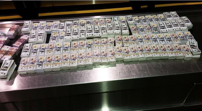
The couple maintains that the bills were merely "hell money."
Hell money is money that is "printed on joss paper and resembles legal tender bank notes but is not legal tender or recognized currency instead, hell money is presented as burnt offerings to the deceased," the CBP release explained.
However, even if the couple did intend to burn the money for ceremonial purposes, “attempting to import any amount of counterfeit currency, regardless of the intended purpose, can have serious implications for arriving travelers,” said CBP Port Director Devin Chamberlain in the release.
"A search of their luggage resulted in the discovery of 93 bundles of counterfeit US $100 bills and 32 bundles of counterfeit Vietnamese Dong," the CBP states. Agents from the Department of Homeland security and the US Secret Service are now in custody of the bills. Despite the scrape with law enforcement, the CBP allowed the couple to continue on in their travels.
NUMISMATIC AND HISTORICAL QUESTIONS AND FACTS (FEBRUARY)
Q. Is it true that one of the famous “Inverted Jenny” error stamps was actually used and cancelled?
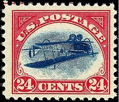 A. On May 14th 1918, stamp collector William T. Robey was fortunate enough to purchase at face the only sheet (100 ea.) of the famous stamps. That sheet was eventually purchased intact by the noted collector Col. Edward Green for $20,000. The sheet was broken up and partially sold as singles and plates of 4 with Col. Green retaining possession of 41 of the stamps. One was placed in a locket as a gift for his wife. A number of them have been damaged thru mishandling, including one that was sucked into a vacuum cleaner! 6 are still missing after theft or mishandling. But, to answer the question, Col. Greens’ wife did actually accidentally use one, and while it was quickly recovered, it is the only Inverted Jenny stamp that has been Post Office cancelled. The individual stamps are currently valued at over $1,000,000.
A. On May 14th 1918, stamp collector William T. Robey was fortunate enough to purchase at face the only sheet (100 ea.) of the famous stamps. That sheet was eventually purchased intact by the noted collector Col. Edward Green for $20,000. The sheet was broken up and partially sold as singles and plates of 4 with Col. Green retaining possession of 41 of the stamps. One was placed in a locket as a gift for his wife. A number of them have been damaged thru mishandling, including one that was sucked into a vacuum cleaner! 6 are still missing after theft or mishandling. But, to answer the question, Col. Greens’ wife did actually accidentally use one, and while it was quickly recovered, it is the only Inverted Jenny stamp that has been Post Office cancelled. The individual stamps are currently valued at over $1,000,000.
Q. I was looking at some interesting coins that were identified as pattern coins and were number labeled with “Judd” numbers. What are Judd numbers?
A. Andrew W. Pollock III defines a pattern as “an experimental piece which either illustrates a proposed coinage design, or which embodies a proposed innovation of composition, size, or shape.” In 1954 Abe Kosoff encouraged avid collector Dr. J. Hewitt Judd to underwrite the costs of a reference work on patterns. Published under Judd’s name in 1959, “United States Pattern, Experimental and Trial Pieces” underwent seven revisions by 1982, all orchestrated and edited by Kosoff. To date, Judd’s book has been the reference on patterns, and “Judd numbers” are commonly used today to identify the various pattern coins. More recent editions have been edited by Q. David Bowers. In 1994, researcher Andrew Pollock’s in-depth “United States Patterns and Related Issues” was released but Judd numbers are still the standard for recognizing rarity and cataloging pattern coins.
(Ed. note: Instead of a strictly historical item I thought this might be an interesting current event. Feb, 4, 2016 Daily Grind)
A perpetual mousetrap that was patented in 1861, the year Abraham Lincoln became president, proved its claim that it “will last a lifetime” when it caught a mouse that inexplicably penetrated impenetrable glass.
An assistant curator at the Museum of English Rural Life in Reading, England, discovered the dead mouse Wednesday in the 155-year-old Victorian mousetrap manufactured by Colin Pullinger & Sons of Silsey, West Sussex, the museum and Daily Mail reported.
 “There appears to be a dead mouse in this mousetrap … which is not described as being there on the database,” the assistant curator wrote in an email to the staff.
“There appears to be a dead mouse in this mousetrap … which is not described as being there on the database,” the assistant curator wrote in an email to the staff.
The discovery baffled museum officials.
“So, this retired rodent had managed to sneak past University of Reading security, exterior doors and museum staff, and clambered its way up into our Store,” the museum wrote in a blog post.
 “Upon finding itself there it would have found the promised land: a mouse paradise laid before it full of straw, wood and textiles. Then, out of thousands of objects, it chose for its home the very thing designed to kill it some 150 years ago: a mousetrap.”
“Upon finding itself there it would have found the promised land: a mouse paradise laid before it full of straw, wood and textiles. Then, out of thousands of objects, it chose for its home the very thing designed to kill it some 150 years ago: a mousetrap.”
The Victorian mousetrap, designed to catch lots of mice, was patented in 1861, the year Abraham Lincoln became president.
Photo: Courtesy of Museum of English Rural Life
The Victorian mousetrap was designed to catch lots of mice, using a seesaw beam inside the box with several compartments, the Daily Mail explained.
A mouse steps onto the beam, making the seesaw tilt to the right and trapping the mouse. It then would proceed through a one-way mouse-gate at the bottom of the device into the space behind the beam.
These mousetraps were meant to be baited to entice the mouse to enter the trap, but this one in the museum was not baited.
The museum speculated on how the mouse got into the case, suggesting that it might have snuck into the trap before the glazing of the case or during construction work that was recently carried out for the museum’s redevelopment.
“This mouse managed to sign its own death warrant before it could do any more damage, the extent of which was only a nibbled label,” the museum wrote.
For now, the mouse will remain in the mousetrap until museum officials figure out what to do with it.
“One option is a dignified burial,” the museum wrote. “Another is to desiccate it or have it prepared to remain as a permanent feature of the mousetrap for our new displays.”
No doubt that the smell will hasten a decision.
Coin of the Month
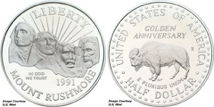
In 1991 there was a total of three different commemorative coin programs but only one would include a half dollar, the 50th Anniversary of Mount Rushmore. It was one of three coins issued, which also included a silver dollar and $5 gold coin.
The obverse features the Mount Rushmore Memorial and a sunburst (rays). On the outer periphery are the words “LIBERTY” and “MOUNT RUSHMORE”. Located directly below the main design are the words “IN GOD WE TRUST” and year of issue “1991”.
The reverse features an American Bison (Buffalo) with the phrase “GOLDEN ANNIVERSARY” with the entire design surrounded by a wreath of 50 stars (one for each state). Near the Bison's front foot are the designer's initials “TJF” while to the right of the Bison is the mint mark “S” for San Francisco or “D” for Denver, (note: proof coins were only minted at San Francisco and business strikes were only minted at Denver). An interesting fact for the reverse design was that it was the first U.S. Coin to depict a Bison since the Indian Head nickel ended in 1938.
The Mount Rushmore Commemorative 50c Draped Bust was only produced during 1991 with mintages of 172,754 (business) and 753,257 (proofs) with the following specs, weight: 11.34 grams, diameter: 30.6 mm, composition: .9167 copper and .0833 nickel, reeded edge. Obverse designed by Marcel Jovine and the reverse by T. James Ferrell.
Currency Note of the Month

This month I picked a highly unusual and also rare note. This is an 1865 $50 Interest Bearing note. It would have been purchased for face value and then the coupons would have been detached as the interest was payed. While they were always worth the face value, only the early issues were given legal tender status. This particular note is referred to as a “seven-thirty” note due its interest bearing status of 7.3%. It would have matured in 3 years although earlier issues matured in 1 and 2 years. It has an ornate Eagle vignette with the eagle clutching an olive branch and and a bundle of arrows. It also has the signatures of Colby and Spinner. This particular note is extremely rare and is held as part of the National Numismatic Collection at the Smithsonian Institution. It is one of 6 known with only 2 of those known to have intact coupons.
Book Recommendation
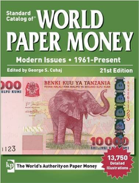 “Standard Catalog of World Paper Money, Modern Issues, 1961-Present” by George S. Cuhaj (Editor)
“Standard Catalog of World Paper Money, Modern Issues, 1961-Present” by George S. Cuhaj (Editor)
The "standard" reference for modern world bank notes! This 21st edition of the Standard Catalog of World Paper Money, Modern Issues provides the most comprehensive and complete reference to world bank notes issued since 1961. This catalog reference features: 21,250 variety listings of world bank notes,13,750 illustrations for easy identifications of bank notes and signature varieties. Bank note values in two popularly available conditions, Country signature charts for specific and accurate variety identification. A network of more than 80 world paper money collectors, dealers, researchers and national bank officials work with editor George S. Cuhaj to ensure that the Standard Catalog of World Paper Money, Modern Issues is the most informed, accurate and all-encompassing resource on the market for the proper identfication, description and valuation of modern world bank notes.
NUMISMATIC AND HISTORICAL QUESTIONS AND FACTS (JANUARY)
Q. What is the earliest dated U.S. Mint coin?
This trick question and answer is provided by Joel Orosz of Coin World (Ed.).
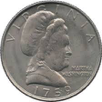 While the U.S. Mint was not established until 1792, in 1965 the Mint was being forced to experiment with new metal compositions and designs. This was due to the rise in the price of silver causing the current coinage to be worth almost more in silver value than its face value. If the silver price increased further, it was possible that it would be worthwhile to melt large quantities of coinage for its silver content causing problems with the nations coinage supply. 10 different metal compositions were tested using what the Mint calls “nonsense die pieces”. The experimental die designs featured Martha Washington with a date of 1759 on the obverse and Mount Vernon on the reverse. The current copper-nickel composition was chosen and quickly implemented and ended U.S. circulating coinage with any intrinsic value. But to answer the original question, technically, the earliest dated U.S. Mint coin had a date of 1759!
While the U.S. Mint was not established until 1792, in 1965 the Mint was being forced to experiment with new metal compositions and designs. This was due to the rise in the price of silver causing the current coinage to be worth almost more in silver value than its face value. If the silver price increased further, it was possible that it would be worthwhile to melt large quantities of coinage for its silver content causing problems with the nations coinage supply. 10 different metal compositions were tested using what the Mint calls “nonsense die pieces”. The experimental die designs featured Martha Washington with a date of 1759 on the obverse and Mount Vernon on the reverse. The current copper-nickel composition was chosen and quickly implemented and ended U.S. circulating coinage with any intrinsic value. But to answer the original question, technically, the earliest dated U.S. Mint coin had a date of 1759!
Q. What coin is considered to be the first commemorative of the modern era?
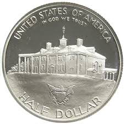
 A. The 1982 George Washington Commemorative Half Dollar marked the beginning of the modern commemorative coin era. The coin was issued to celebrate the 250th anniversary of the birth of George Washington.
The obverse of the coin portrays George Washington on horseback. The reverse features the eastern facade of Washington’s home at Mount Vernon, with a heraldic eagle appearing below. The coin was designed by Elizabeth Jones, who was serving as the chief sculptor and engraver of the United States Mint at the time the coin was issued.
The obverse inscriptions read “George Washington”, “Liberty”, “250th Anniversary of Birth” and the date “1982”. The reverse inscriptions include “United States of America”, “In God We Trust”, and the denomination “Half Dollar”.
Coins were struck in 90% silver and represented the first 90% silver coins to be produced by the United States Mint since 1964. Proof and uncirculated versions were issued, with proof coins struck at the San Francisco Mint and the uncirculated coins struck at the Denver Mint.
Unlike most subsequent modern commemoratives, the George Washington Half Dollars were produced in anticipation of sales throughout 1982 and 1983, although all coins were dated 1982. When the US Mint finally stopped accepting orders for the coins on December 31, 1985, a quantity of more than one million unsold coins were melted. Nonetheless, the program achieved a profit of more than $36 million, which was deposited into the Treasury General Fund.
A. The 1982 George Washington Commemorative Half Dollar marked the beginning of the modern commemorative coin era. The coin was issued to celebrate the 250th anniversary of the birth of George Washington.
The obverse of the coin portrays George Washington on horseback. The reverse features the eastern facade of Washington’s home at Mount Vernon, with a heraldic eagle appearing below. The coin was designed by Elizabeth Jones, who was serving as the chief sculptor and engraver of the United States Mint at the time the coin was issued.
The obverse inscriptions read “George Washington”, “Liberty”, “250th Anniversary of Birth” and the date “1982”. The reverse inscriptions include “United States of America”, “In God We Trust”, and the denomination “Half Dollar”.
Coins were struck in 90% silver and represented the first 90% silver coins to be produced by the United States Mint since 1964. Proof and uncirculated versions were issued, with proof coins struck at the San Francisco Mint and the uncirculated coins struck at the Denver Mint.
Unlike most subsequent modern commemoratives, the George Washington Half Dollars were produced in anticipation of sales throughout 1982 and 1983, although all coins were dated 1982. When the US Mint finally stopped accepting orders for the coins on December 31, 1985, a quantity of more than one million unsold coins were melted. Nonetheless, the program achieved a profit of more than $36 million, which was deposited into the Treasury General Fund.
Numismatic Fact: While virtually unknown in the U. S., the work of French sculptor Jean-Antoine Houdon greatly influenced the portrait designs seen on our coinage. His portraiture sculptures of Benjamin Franklin, George Washington, and Thomas Jefferson were the basis and inspiration for the coin portrait designs seen on the Franklin half-dollar, the Washington quarter, and the Jefferson 5 cent pieces. While these pieces are the ones best known in the U.S. he also executed sculptures of Voltaire, Robert Fulton, and his last piece before his death in 1828, the grandson of Russian Catherine the Great, Czar Alexander the First!
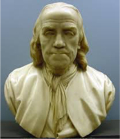
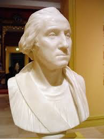
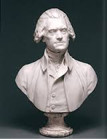
Coin of the Month
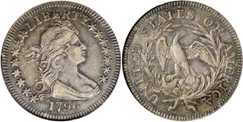
In 1796, Congress responded to the almost universal dissatisfaction of the first coins (Flowing Hair) and decreed a new design. As was the custom of the time, all denominations bore the same design or, in this case, the same obverse. By Congressional decree, certain features were required: The Eagle, the word Liberty, Stars, and United States of America. It was not considered necessary to include the value of the coin since it could be discerned from its size based on the precious metal content.
From 1795-1797, a scrawny, naturalistic bald eagle was depicted on the reverse side of all silver coins. This design is known as the Draped Bust, Small Eagle and usually commands a high price due to the extremely low mintage at the time.
All coins (copper and silver) bore the same obverse. Robert Scot, Chief Engraver of the U.S. Mint, 1793–1829, transformed a portrait of a society lady by Gilbert Stuart into a rather buxom Ms. Liberty.
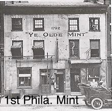
The Draped Bust (Small Eagle Reverse) was only produced during 1796 with a total mintage of 6,146 at the 1st Philadelphia Mint with the following specs, weight: 6.74 grams, diameter: 27.5 mm, composition: .8924 silver and .1076 copper, reeded edge. Designed by Gilbert stuart and Engraved by Robert Scot. It is listed as #71 in the book The Greatest 100 U.S. Coins and is eagerly sought after as a type coin. In 2013, one graded PCGS 67+, was sold at auction for $1,527,000
Book Recommendation
 “Pleasure & Profit: 100 Lessons for Building and Selling a Collection of Rare Coins” by Robert W. Shippee and Q. David Bowers.
“Pleasure & Profit: 100 Lessons for Building and Selling a Collection of Rare Coins” by Robert W. Shippee and Q. David Bowers.
Longtime collector Robert W. Shippee dissects how, twenty years ago, he got serious about building a collection of rare coins, gradually and carefully assembled the Waccabuc Collection, and later sold its half cents through double eagles. He tells the story "warts and all" --- from creating a grand vision to the emotional rush of live auctions, the learning process, successful purchases, as well as duds and costly mistakes. Learn how he assembled and eventually sold his collection of 150 copper, nickel, silver, and gold coins for $1.5 million at public auction. The story includes Shippee's observations on acquisition strategies, storage choices, and disposition options, supplemented with commentary on grading services, auction houses, famous dealers, numismatic personalities, market valuations, and, with candor that's rare these days, his laid-bare financial results. His insight is humorous, wise and unflinching, uniquely valuable for today's collector and investor.(amazon.com)
NUMISMATIC AND HISTORICAL QUESTIONS AND FACTS (DECEMBER)
Q. When did “Star” notes first start being printed?
A: In 1910 the Bureau of Engraving and Printing switched to a new type of printing press which delivered finished notes in cut form rather in sheets. This made it difficult to replace damaged notes with the proper serial No.’s. It was decided to print Star notes, or replacement notes, individually serialized but in sheets, with a star annotating that it was a replacement note. They were slowly introduced starting in 1910 with low denomination notes and then on $10 and $20 notes starting in 1914. $100 notes followed in 1918. No $500 or higher notes were issued with stars due to their being produced in such small quantities.
Q. Are all the 1921 Peace dollars minted in high relief?
A. Yes. The 1921 Peace dollars were coined very late in the year due to the original reverse needing to be re- designed. The original design had an eagle clutching a broken sword which was intended to be emblematic of the end of war. Some viewed the design as a sign of defeat though, so U.S. Mint Chief Engraver George Morgan cleverly reshaped the sword into part of the olive branch. This delayed coining until Dec. 28th so only a little over a million were produced before the end of the year. The high relief caused striking problems so for the 1922 mintage new hubs were produced with much less relief thereby ex- tending the die life.
Christmas trivia! Children all over the world continue the tradition of hanging Christmas stockings. In some countries children have similar customs.
In France the children place their shoes by the fireplace, a tradition dating back to when children wore wooden peasant shoes.
In Holland the children fill their shoes with hay and a carrot for the horse of Sintirklass. In Hungary children shine their shoes before putting them near the door or a window sill.
Italian children leave their shoes out the night before Epiphany, Jan- uary 5, for La Befana the good witch.
And in Puerto Rico children put greens and flowers in small boxes and place them under their beds for the camels of the Three Kings. The first mention of Christmas stockings being hung from or near a chimney were made only earlier this century by the illustrator, Thomas Nast, through his pictures and the writer, Clement Moore, in a story about a 'visit from St.Nick'. The story quickly caught on.
"The stockings were hung by the chimney with care In hopes that Saint Nicholas soon would be there"
Up until lately, it was traditional to receive small items like fruit, nuts and candy in your stocking, but these have been replaced in the last half-century by more expensive gifts in many homes.
Coin of the Month

This months coin is a Canadian commemorative with a Christmas theme! Featuring a Christmas-themed design with Santa, it was the tenth release from the Royal Cana- dian Mint’s series of commemorative $20 silver coins that were sold at face value. The Santa commemorative coin had a mintage of 225,000 and was designed by Jesse Koreck. The reverse features an image of Santa holding presents. Surrounding the jolly-bearded guy are inscriptions with the coin’s face value of ’20 DOLLARS’, its purity of ‘ARGENT PUR FINE SILVER 9999’, ‘CANADA’, ‘2013’ and ‘JK’ for the de- signer’s initials.
Found on the obverse or heads side of every $20 for $20 coin is Susanna Blunt’s por- trait of Queen Elizabeth. Encircling inscriptions include ‘ELIZABETH II’ and ‘D.G. REGINA’.
Minted in 2013 by the Royal Canadian Mint with the following specs: Weight 7.96- grams. Composition: .9999 Silver, Diameter: 27 mm. Reeded edge. Designer: Jesse Koreck (reverse) and Susanna Blunt (obverse)
Currency Note of the Month.
In keeping with the Christmas theme, there is this note. Issued in the 1850s by the Howard Banking Company, this five dollar bill featuring Santa Claus actually func-
tioned as legal tender. Unlike today, when the federal government issues all of the pa- per currency for the United States, private banks held that responsibility from the close of the American Revolution until 1861. Now called "obsolete bank notes," the bills varied in design from bank to bank and were often quite colorful. The issuing institutions typi- cally used stock images provided by the companies that engraved and printed the currency.
A number of banks made use of Santa Claus illustrations in the 1850s—the most log- ical being the St. Nicholas Bank of New York City. The Santa who graces this Howard Banking Company bill is descended from Sinter Klaas, a traditional figure brought by Dutch settlers to New York in the 17th century. He went through several significant metamorphoses in America, including features added by Washington Irving in his Knickerbocker History (1809) and the 1822 poem "A Visit from St. Nicholas" ("Twas the Night before Christmas"), attributed to Clement Moore.
This note is listed as Haxby# MA-246-C8a, Howard Banking Company of Boston, Mass. (1853-1858). $5 dated Aug. 23, 1857 New England Bank Note Co. Boston, Rawdon, Wright, Hatch & Edson New York, engravers/printers
Book Recommendation
Weird Christmas: A Collection of Curious and Crazy Customs and Coincidences Concerning Christmas
by Joey Green, Lisa Weber
So, didn’t think there was a book about weird Christmas stuff? ”Ah, the delights of Christmas Holiday carolers, beautifully
wrapped packages, twinkling lights, and...a feast of caterpillars fried in oil?!? Welcome to Weird Christmas, a journey off the beaten path to the bizarre
side of the world's favorite holiday, where, for every Christmas sugarplum there is a plate of lutefisk (that's cod soaked in lye—a Christmas favorite in Norway).” (Barnes and Noble)
NUMISMATIC AND HISTORICAL QUESTIONS AND FACTS (NOVEMBER)
Q. I have some small flat pieces that appear to be silver. I have been told they are ac- tually coins?
 A: Russian wire money was produced from the 14th century thru the beginning of the 18th century. They were issued in kopek and denga denominations depending on the time period struck. The coins were struck by cutting silver wire to the proper weight and then smashing it be- tween a pair of dies by hand. Since they were produced by hand there are thousands of varieties.
A: Russian wire money was produced from the 14th century thru the beginning of the 18th century. They were issued in kopek and denga denominations depending on the time period struck. The coins were struck by cutting silver wire to the proper weight and then smashing it be- tween a pair of dies by hand. Since they were produced by hand there are thousands of varieties.
Q. What are the oldest gold coins known?


A. While its difficult to be specific when gold pieces were actually considered coinage, it is known that the Lydians of present day Turkey, produced coins of electrum, a combination of silver and gold in 564 BC. However, the ancient Chi- nese also produced a square gold coin, called the Ying Yuan, also in 564 BC. So determining who was first is debatable.
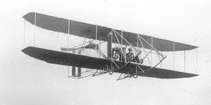
Historical Fact: In July 1910, Charles Royce of Rolls-Royce fame was killed when his Wright bi- plane, coming in for a landing, broke up, perhaps as a result of a faulty tail piece recently added to the aircraft and not part of the original design. Be- fore his death, Rolls tried to persuade his busi- ness partner, Henry Royce, to enter the aviation business, but Royce preferred to focus on auto- mobiles. During WWI, Royce reversed his posi-tion and began to manufacture airplane engines.
Coin of the Month

The 1994 Vietnam Veterans Memorial Silver Dollar coin was issued to mark the 10th anniversary of the dedication of the Vietnam Veterans Memorial Wall in Washington, DC. Surcharges raised from the sale of coins went to an endowment for the repair and maintenance of the Wall. The obverse design features a hand touching the Memorial Wall. The Washington Monument can be seen in the background of the scene and the reverse design features three military medals awarded during the Vietnam War. The obverse coin inscriptions include “Liberty”, the date “1994”, “In God We Trust”, and the caption “Vietnam Veterans Memorial”. The reverse coin inscriptions include “United States of America”, “E Pluribus Unum”, and the denomination “One Dollar”. The 1994 Vietnam Veterans Memorial Silver Dollars were minted in uncirculated version at the West Point Mint and in proof version at the Philadelphia Mint. The maximum authorized mintage across both options was 500,000, which was not reached. The coins were offered for sale individually, or as part of three coin sets which included the other two “Memorial” Silver Dollars. Minted in 1994 at the Philadelphia (Proofs), West Point (Unc) Mints with the following specs: Weight 26.73 grams. Composition: .900 Silver and .100 Copper, Diameter: 38.1 mm. Reeded edge. Designer: John Mercanti (obverse) and Thomas Rodgers Sr. (reverse)
Currency Note of the Month.

In keeping with the theme of Veterans Day this month I thought a small sampling of Military Payment Certificates would be appropriate. Military payment certificates, or MPC, was a form of currency used to pay U.S. military personnel in certain foreign countries. It was used in one area or another from a few months after the end of World War II until a few months after the end of U.S. participation in the Vietnam War – from 1946 until 1973. In autumn of 1973, a surprise conversion day was held there, retiring MPC and substituting greenbacks. MPC was never again issued, and the concept lay dormant until the late 1990s, when it was revived somewhat in the form of the Eagle Cash stored value card system, used by U.S. armed forces in Iraq. MPC utilized layers of line lithography to create colorful banknotes that could be produced cheaply. Fifteen series of MPCs were created. However, only 13 series were issued. The remaining two were largely destroyed, although some examples remain. Among the 13 released series a total of 94 notes are recognized. They are a very popular niche collecting area for numismatics.
Book Recommendation
“Keep the Change: A Collector's Tales of Lucky Pennies, Counterfeit C-Notes, and Other Curious Currency” By Harley J. Spiller
 Harley J. Spiller began collecting money at the age of five when, home sick from school, his father tossed him a sack of pennies and a Whitman coin folder. In the five decades since, author Spiller has amassed one of America's most extensive collections of unusual financial artifacts as well as a wealth of anecdotes and quirky historical details about U.S. currency. In Keep the Change, Spiller takes an irreverent look at our most uncommon coins and bills.
Harley J. Spiller began collecting money at the age of five when, home sick from school, his father tossed him a sack of pennies and a Whitman coin folder. In the five decades since, author Spiller has amassed one of America's most extensive collections of unusual financial artifacts as well as a wealth of anecdotes and quirky historical details about U.S. currency. In Keep the Change, Spiller takes an irreverent look at our most uncommon coins and bills.
Readers learn why greenbacks are green; what happens to worn-out bills (compost is involved); how artists navigate the fine line between art and mutilation; whether it's ever acceptable to burn money (short answer: maybe); and how coin clippers and counterfeiters through the ages have profited by manipulating money. This highly selective tour through currency legends and lore will inspire readers to look with a new sense of wonder at the bills that pass through our hands every day.(amazon.com)
NUMISMATIC AND HISTORICAL QUESTIONS AND FACTS (OCTOBER)
Q. I’ve noticed occasional white spots on some silver coins. What are they and are they removable?
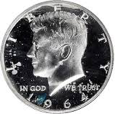 Those spots are commonly called “milk spots” and are usually from the cleaning solution used to wash the blank planchets being struck. Once struck, the residue is imbedded in the surface of the coin. Removal would destroy the surface of the coin. Proper storage, keeping the coin clean and dry without temperature fluctuations will help prevent the development of spots.
Those spots are commonly called “milk spots” and are usually from the cleaning solution used to wash the blank planchets being struck. Once struck, the residue is imbedded in the surface of the coin. Removal would destroy the surface of the coin. Proper storage, keeping the coin clean and dry without temperature fluctuations will help prevent the development of spots.
Q. Was one of the signers of the “Indian Chief” notes actually an Indian?
 A. Of the 11 different signature combinations on Chief notes, one has the facsimile signature of Houston Benge Teehee. Teehee was appointed Register of the Treasury by Woodrow Wilson and served in that position from March 1915 to November 1919. His signature appears with that of Treasurer John Burke. Teehee’s father was 7/8ths Cherokee and his mother half Cherokee. Despite being an Oklahoma alderman, mayor, county attorney, and state representative, until the 1924 passage of the Indian Citizenship Act he was not considered a citizen and was not allowed to vote!
A. Of the 11 different signature combinations on Chief notes, one has the facsimile signature of Houston Benge Teehee. Teehee was appointed Register of the Treasury by Woodrow Wilson and served in that position from March 1915 to November 1919. His signature appears with that of Treasurer John Burke. Teehee’s father was 7/8ths Cherokee and his mother half Cherokee. Despite being an Oklahoma alderman, mayor, county attorney, and state representative, until the 1924 passage of the Indian Citizenship Act he was not considered a citizen and was not allowed to vote!

Historical Fact: The most recognized song in the English language, “Happy Birthday” was penned by the sisters Patty and Mildred Hill from the existing 8 note melody “Good Morning to All”. Recently a federal judge in Los Angeles ruled that the original copyright on the song, filed in 1935 by the Summy Company, granted only the rights to specific piano arrangements of the music and not the lyrics. Warner/Chappell, the publishing arm of Warner Music, had been enforcing a copyright since 1988, when it bought Birch tree Group, the successor to the Summy Co., which claimed the original copyright. It is believed that the song was generating royalties in excess of $2,000,000 a year for Warner/Chappell. The judges ruling means that, unless evidence is found that the Hill sisters specifically conveyed the rights to the song to someone, that the song will be considered a public work and free to use.
Coin of the Month
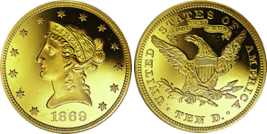
The Liberty head $10 Gold Eagle was produced from 1838 to 1907 in 2 types. In 1866 a ribbon with the motto “In God We Trust” was added to the reverse creating the 2 different types. There are number of varieties including, large and small dates, overdates, and small numbers of very rare proofs. Minted from 1838 to 1907 at the Philadelphia, Carson City, Denver, New Orleans, and San Francisco Mints with the following specs: Weight 16.718 grams. Composition: .900 Gold and .100 Copper (net weight: .48375 oz. pure gold), Diameter: 27 mm. Reeded edge. Designer: Christian Gobrecht.
Currency Note of the Month

This is one of my favorite notes despite the fact that they are so pricey I will probably never own one. The series of 1899 $5 silver certificate goes by many names. It is sometimes called an Indian, Chief, Running Antelope, or Oncpapa. All of the names derive from the fact that there is a Native American featured on the front of each 1899 $5 bill. That Indian Chief is Ta-to-in-yan-ka also known as Running Antelope of the Oncpapa tribe of Sioux Indians. This is the only piece of United States currency that solely features a Native American. 1899 $5 silver certificates are popular, but also extremely common, especially in circulated grades. All 1899 $5 bills have blue seals and serial numbers. All bills say series of 1899; however, they were printed as late as the 1920s. There are 11 different signature combinations for the series of 1899 $5 silver certificate. George F.C. Millie engraved the portrait. Examples run from $500 in VG condition up to in excess of $3,000 for uncirculated examples. Star notes were also issued for the series of 1899 $5 silver certificate and can run into 5 figures in price.
Book Recommendation
United States Paper Money Errors: A Comprehensive Catalog & Price Guide: by Frederick J. Bart
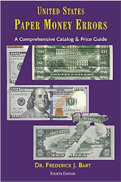
Error notes continue to carve an ever larger niche in paper money collecting. This edition of the definitive reference allows advanced collectors to recognize the value in their holdings and still permits members of the general public to identify potentially profitable notes encountered in circulation. The entirely revised and long awaited 4th edition offers more than 550 photos and values in four grades,making identification easy. Chapters are arranged according to the actual production sequence within the Bureau of Engraving and Printing (BEP) providing a logical flow to the arrangement. In addition, historic photographs from the BEP offer a fascinating glimpse into currency production during a bygone era, contrasting sharply with the advanced technology currently in use.(amazon.com)
NUMISMATIC AND HISTORICAL QUESTIONS AND FACTS (SEPTEMBER)
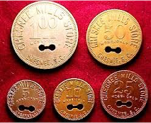
Q. What is or was the smallest denomination of U.S. coinage?

A. Currently the smallest denomination minted is the Lincoln cent with a value of 1/1ooth of a dollar. Also the half-cent was authorized to be minted in 1792 and was minted off and on through 4 different types till 1857. However, when our currency system was first established in 1786 there was a denomination designated as a mill which was worth 1/10th of a cent. While never minted as a federal issue, a number of states made mill tokens in various values for use in paying regional types of sales taxes. In 1935, Secretary of the Treasury, Henry Morgenthau, asked Congress for a license to make a coin to replace the states' tokens but Congress reacted to the proposal with some amusement and the permission was’t granted.

Q. Considering the number of Indian casino’s in operation throughout the U.S., how many different tribes are recognized as legitimate individual tribal Nations? A. While the general attention is concentrated on perhaps a dozen tribes, with the Sioux, Apaches, and Comanches leading the list, according to the 2013 U.S. Federal Register there are 566 tribes eligible to receive services from the Bureau of Indian Affairs. Each one had, and continues to have, a distinctive style as a Nation.
Numismatic Fact: The Bureau of Engraving and Printing (BEP) is currently in the planning stages of placing a womans' portrait on the $10 bill. While there has been 2 previous instances of actual women on currency, (Pocahontas in 1875 and Martha Washington in 1886), it is certainly a rarity. It also appears that it is a rarity for other countries as well. Recently, Israeli social activist, Shir Nosatzki, researched hundreds of bills from over 200 countries using on-line databases. She discovered that of the 609 people depicted on on paper currency, only 51 of them,or 8 percent, are women. The current Australian system is the most equal in representation with the $5 note having a portrait of Queen Elizabeth and all other issues having a man on one side and a woman on the other.
Coin of the Month
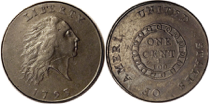
The Chain cent was America's first large cent and the first circulating coin officially produced by the United States Mint. The obverse design consisted of a stylized Liberty head with flowing hair. The inscription "LIBERTY" appeared above the portrait, and the date below. The reverse's central design figure, for which the coin is named, is an interlocking chain with 15 links, representing the 15 American states in existence at that time. Both the words "ONE CENT" and the fraction "1/100" appear within the chain. Along the outer edge is inscribed "UNITED STATES OF AMERICA". On the first working die, the engraver failed to allow adequate room for the entire inscription, and it had to be abbreviated to "UNITED STATES OF AMERI.". These early dies were cut by hand, rather than being made from master hubs as is the practice today. Chain cents were struck during late February and early March 1793; records indicate that approximately 36,103 were produced. However, the public reaction to the coins was largely negative. One newspaper criticized the appearance of the Liberty head, saying that it appeared to be "in a fright". And, while the reverse chain had been intended to symbolize the togetherness of the newly formed Union (similar iconography had been utilized on the reverse of the earlier Fugio Cent and Revolutionary War era Continental currency), many commentators instead interpreted it as representative of slavery. By March, the Mint had run out of planchets, which temporarily halted striking. During this time, a new design, the Wreath cent, was quickly prepared and approved. Minted only in 1793 at the Philadelphia Mint with the following specs: Weight 13.48 grams. Composition: Copper, Diameter: 26-27 mm. Edge: bars and slender vines with leaves. Designer: Unknown, Engraver: Henry Voight.
Currency Note of the Month.
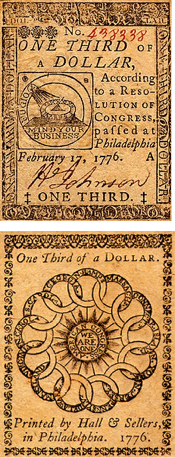
Since I used an early American coin as “Coin of the Month” I decided to continue with the theme in currency. After the American Revolutionary War began in 1775, the Continental Congress began issuing paper money known as Continental currency, or Continentals. The front design on this fractional note includes the first use of the "FUGIO" (I fly) legend and sundial as well as the "Mind your Business" legend. The back shows the thirteen linked rings representing the colonies and the legends "We are one" and "American Congress”. The designs of the devices and the borders were created by Benjamin Franklin and cut by Elisha Gallaudet, who also helped designed the Continental Currency coin. There is one signer, in red ink, on the fractional bills and note that on the fractional bills the dots in the corners of the front design reflect the denomination, with one dot designating a sixth of a dollar, two dots for a third, three dots for $1/2 and four dots for $2/3. The paper, made at Ivy Mills in Chester County, Pennsylvania, contained blue fibers and mica flakes. Printed by Hall and Sellers in Philadelphia.
Continental currency depreciated badly during the war,giving rise to the famous phrase "not worth a continental”. A primary problem was that monetary policy was not coordinated between Congress and the states, which continued to issue bills of credit. The glut of issued notes plus large scale British counterfeiting caused runaway inflation and subsequent devaluation of the notes. By the end of 1778, Continentals retained from 1/5 to 1/7 of their face value. By 1780, the bills were worth 1/40th of face value. Congress attempted to reform the currency by removing the old bills from circulation and issuing new ones, without success. By May 1781, Continentals had become so worthless that they ceased to circulate as money.
Book Recommendation
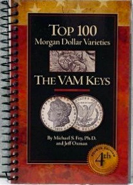 The Top 100 Morgan Dollar Varieties: The VAM Keys 4th Edition:
The Top 100 Morgan Dollar Varieties: The VAM Keys 4th Edition:
by Michael S. Fey (Author), Ph.D. and Jeff Oxman (Author)
This is the latest updated edition of a best selling selling book that created a revolution in collecting and investing in Morgan silver dollar varieties. The 4th edition contains new and fully illustrated Top 100 varieties, updated pricing, updated rarity information, certified populations and condition census data as well as a new chapter on rotated reverses. If you own silver dollars from 1878-1921, collect them, or are looking to acquire some of the rarest most desirable examples, this book is a must read. You should buy this book before you buy or sell another silver dollar! (amazon.com)
NUMISMATIC AND HISTORICAL QUESTIONS AND FACTS (AUGUST)
Editors Note: Last month during our meeting there was a discussion about coin doubling. I decided to do some research and would like to pass on the following information on the subject.
A doubled die is a term in numismatics used to refer to doubling in the design elements of a coin. Doubled dies can appear as an outline of the design or in extreme cases, having legends and dates appear twice in an overlapping fashion.
Doubled dies are a result of the way in which in the United States Mint's dies are created. Before 1997, a die was made by hubs that contained the raised design elements that were intended to appear on the coin. The blank dies were heated (to soften them) and then were pressed against the hubs to transfer the design from the hub to the striking die. In every case, one impression was not enough to transfer the design elements from the hub to the die, so multiple impressions were required to transfer enough of the design. For this reason, after the first impression was made, the die was reheated and prepared for a second impression. The mint workers would use guides to align the hub and the working die perfectly to prevent overlapping, or a doubled die. It is when mint workers failed to align dies properly during this process that doubled dies were produced.
Modern coining methods have vastly reduced the frequency of these varieties due to the use of a single squeeze hubbing method during die creation. With the new die making process, implemented after 1996, dies only required one impression of the hub to transfer all of the design from the hub to the die. But it has been discovered that the pressure created is so great, that some dies tend to slightly rotate during this process creating doubling errors seen mostly in Lincoln cents.

Doubled die error coins can fetch significant prices when they are noticeable to the naked eye or occur in a popular coin series. One example of this is the 1955 doubled die Lincoln Wheat cent.
Mechanical doubling, also called machine doubling or strike doubling, is a form of doubling which appears on a coin and is easily confused with doubled die strikes. On a true doubled die coin, the doubling comes from a mistake in the process used to make the coin die itself. In mechanical, or machine doubling, the doubled image results from mechanical issues during the striking of the coin, such as the coin shifting during striking, or the die itself being jarred out of position as a result of vibration or improper coin press maintenance.
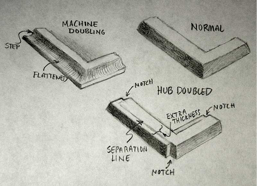
Mechanical, machine, and strike doubling are all considered by purists to be forms of damage, and are therefore not collectible as an error coin.
Most of the time, when novices think they have found a new type of doubled die, they've actually found a coin exhibiting worthless mechanical doubling instead.
Q. Did Indians in the Old West really use smoke signals as communication?
A. Many tribes did but in a limited fashion. Obviously, detailed messages were impossible considering the medium, so most signals were intended to be used as a prearranged code, especially since the signal would be seen by both friend and foe. (Wild West Magazine, Jan. 2015)
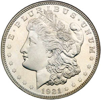
Numismatic Fact: Back when silver dollars were being used to financially back U.S. Silver Certificates, the Mint stored those freshly minted silver dollars in the vault of the Philadelphia Mint. In 1912 Carmi A. Thompson, the newly appointed Treasurer of the United States, reported that there were in excess of 116 million silver dollars being held in storage. That was enough silver dollars to fill 555 freight cars, and would have made for a train 6 miles long. Eventually, as a result of the Pittman Act, all of the silver dollars were melted, plus dollars from the other mints, and sold to the British government in the form of 62 pound silver bars. The act stabilized the price of silver at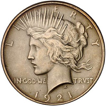 $1.015 per oz.(hence, the 62 pound bars=$1,000 ea.) and the British government used them to pay off their financial commitments to India. Eventually this meant that the U.S. didn’t have enough silver dollars to back silver certificates so in 1921 Morgan dollars were again minted until the dies for the new Peace dollar was finished. The number of silver dollars melted for sale to the British was more than 300 million!
$1.015 per oz.(hence, the 62 pound bars=$1,000 ea.) and the British government used them to pay off their financial commitments to India. Eventually this meant that the U.S. didn’t have enough silver dollars to back silver certificates so in 1921 Morgan dollars were again minted until the dies for the new Peace dollar was finished. The number of silver dollars melted for sale to the British was more than 300 million!
Coin of the Month.
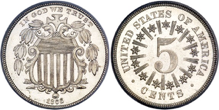
The Shield nickel was the first United States five-cent piece to be made out of copper-nickel, the same alloy of which American nickels are struck today. Designed by James B. Longacre, the coin was issued from 1866 until 1883, when it was replaced by the Liberty Head nickel. The coin takes its name from the motif on its obverse, and was the first five-cent coin referred to as a "nickel"—silver pieces of that denomination had been known as half dimes.
The new coins proved difficult to produce; due to the hardness of the planchet, the coins were not of high quality and the life of the striking dies was brief. The design of the coins was widely criticized, with Industrialist (and the raw nickel supplier) Joseph Wharton describing the shield design as suggesting "a tombstone surmounted by a cross and overhung by weeping willows." The American Journal of Numismatics described it as "the ugliest of all known coins". More seriously, the reverse design reminded many of the "stars and bars" motif of the defeated Confederate States. The rays were eliminated from the design in early 1867, in the hopes of eliminating some of the production problems. Even so, production difficulties continued, causing many minor varieties which are collected today. Minting of the Shield nickel for circulation was suspended in 1876 for a period of over two years due to a glut of low-denomination coinage and it was struck in only small quantities until 1882. The following year, the coin was replaced by Charles E. Barber's Liberty head design. Minted from 1866-1883 at the Philadelphia Mint with the following specs: Weight 5 grams. Composition: .750 Copper and .250 Nickel, Diameter: 20.5 mm. Plain edge. Designer: James B. Longacre.
Currency Note of the Month.

This months note is nicknamed the “Poker Chip” note due to the denomination design on the reverse resembling a poker chip.It is a Series 1923 Legal Tender $10 note and was the last large size $10 note issued prior to the introduction of small size notes in 1929. It carries the printed signatures of Speelman and White. There are no varieties known for this note although 2 Star notes of this issue are known. Considered scarce, values range from $700 in Very Good to $16,000 in Gem Uncirculated. The last Star note of this type auctioned publicly, sold for $92,000 in a grade of Fine.
Book Recommendation
 At the Coinarama Coin Show in San Diego last week Ron Guth (the co-author) had a table and was selling copies of this months book selection. I will have the book at the August meeting for anyone that is interested. The description below is from amazon.com.
At the Coinarama Coin Show in San Diego last week Ron Guth (the co-author) had a table and was selling copies of this months book selection. I will have the book at the August meeting for anyone that is interested. The description below is from amazon.com.
Noted numismatists Ron Guth and Jeff Garrett have created a definitive work of American history. United States Coinage: A Study by Type, invites the reader to peer into the heart and soul of America-to view snapshots of the life and ideals of its people-by examining the coins the nation has produced since 1792. Inside this hard cover book, you'll see the simple beginnings of the United States Mint, the growth and maturation of the nation during the 1800's, the staid designs of coins of the Industrial Era, the glory and excess of the early 1900's, and the hero-worship of recent years. Completely illustrated with full-color photos. Hardcover. 192 pages.
NUMISMATIC AND HISTORICAL QUESTIONS AND FACTS (JULY)
Q. I just purchased a $2 Confederate note with an interesting portrait on it. I was wondering who it was?
 A.The gentleman on your note is Judah P. Benjamin. He first served as a U.S. Louisiana senator but then served in the Confederacy in a number of roles including Attorney General, Secretary of War, and Secretary of State. With the surrender of the Confederacy, he was able to escape, despite a $40,000 reward for his capture. He made passage through the Caribbean and eventually arrived in London where he became a successful barrister. He passed away at the age of 73 in Paris. He has the distinction of appearing on every $2 note issued by the Confederate States of America. There are 6 varieties of these notes and readily available. (Information from Coin World, W. Wolka, May 22 2015)
A.The gentleman on your note is Judah P. Benjamin. He first served as a U.S. Louisiana senator but then served in the Confederacy in a number of roles including Attorney General, Secretary of War, and Secretary of State. With the surrender of the Confederacy, he was able to escape, despite a $40,000 reward for his capture. He made passage through the Caribbean and eventually arrived in London where he became a successful barrister. He passed away at the age of 73 in Paris. He has the distinction of appearing on every $2 note issued by the Confederate States of America. There are 6 varieties of these notes and readily available. (Information from Coin World, W. Wolka, May 22 2015)
Q. How frequent was mail service in the Old West?
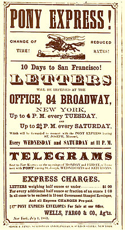 A. Mail service was infrequent and slow. From 1858-1861, the Butterfield Overland Mail transported the mail twice a week from St. Louis, Missouri, to San Francisco, California, in about 25 days. During its brief history, from April 1860 to October 1861, the Pony Express delivered a letter from St. Joseph, Missouri, to Sacramento, California, in about 10 days. Trans-Western mail service continued to operate with Wells Fargo, Ben Holliday, and Overland Mail lines. The U.S. government cancelled its last overland mail contract on May10th, 1869, the day the Transcontinental Railroad was completed from Omaha, Nebraska, to Sacramento, California, reducing the time in transit for mail to a week or less. (Wild West Magazine, Aug. 2014)
A. Mail service was infrequent and slow. From 1858-1861, the Butterfield Overland Mail transported the mail twice a week from St. Louis, Missouri, to San Francisco, California, in about 25 days. During its brief history, from April 1860 to October 1861, the Pony Express delivered a letter from St. Joseph, Missouri, to Sacramento, California, in about 10 days. Trans-Western mail service continued to operate with Wells Fargo, Ben Holliday, and Overland Mail lines. The U.S. government cancelled its last overland mail contract on May10th, 1869, the day the Transcontinental Railroad was completed from Omaha, Nebraska, to Sacramento, California, reducing the time in transit for mail to a week or less. (Wild West Magazine, Aug. 2014)
Numismatic Fact: The 1937 Roanoke Island, North Carolina, commemorative half dollar depicted 3 actual people, including 2 women! Sir Walter Raleigh is featured on
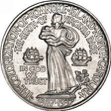

the obverse and the reverse bears the likeness of 2 females; Eleanor Dare, member of the Roanoke “Lost Colony,” and her infant daughter Virginia, the first child born to a British colonist in the future United States. The Roanoke Colony, also known as the Lost Colony, established on Roanoke Island, in what is today's Dare County, North Carolina, United States, was a late 16th-century attempt by Queen Elizabeth I to establish a permanent English settlement.
Coin of the Month.
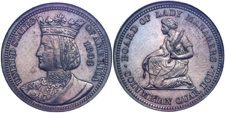
Since I picked a book about Commemorative coinage for the monthly book selection I thought it appropriate to feature a commemorative coin. The Isabella quarter or Columbian Exposition quarter was a United States commemorative coin struck in 1893. Congress authorized the piece at the request of the Board of Lady Managers of the World's Columbian Exposition and is the only U.S. commemorative of that denomination that was not intended for circulation.
The quarter depicts the Spanish Queen Isabella I of Castile, who sponsored Columbus's voyages to the New World. The Board of Lady Managers, headed by Chicago socialite Bertha Palmer, wanted a woman to design the coin and engaged Caroline Peddle, a sculptor. Peddle left the project after disagreements with Mint officials, who then decided to have Bureau of the Mint Chief Engraver Charles E. Barber do the work. The reverse design, showing a kneeling woman spinning flax, with a distaff in her left hand and a spindle in her right, symbolizes women's industry and was based on a sketch by Assistant Engraver George T. Morgan.
The quarter's design was deprecated in the numismatic press. The coin did not sell well at the Exposition; its price of $1 was the same as for the Columbian half dollar, and the quarter was seen as the worse deal. Nearly half of the authorized issue was returned to the Mint to be melted; thousands more were purchased at face value by the Lady Managers and entered the coin market in the early 20th century. Minted in 1893 at the Philadelphia Mint with the following specs: Weight 6.25 grams. Composition: .900 Silver and .100 Copper, Diameter: 24.3 mm. Reeded edge. Designer: Charles Barber
Currency Note of the Month.

 I am continuing the commemorative theme this month but since the U.S. Bureau of Engraving and Printing has never released a currency commemorative I decided to feature a world note (a first!). This Commemorative $10 note was released by the Reserve Bank of Australia (RBA) in January of 1988. It is certainly an artistic note with a very historical theme. The following is info I obtained from the RBA website about the design and symbolism of the note.
I am continuing the commemorative theme this month but since the U.S. Bureau of Engraving and Printing has never released a currency commemorative I decided to feature a world note (a first!). This Commemorative $10 note was released by the Reserve Bank of Australia (RBA) in January of 1988. It is certainly an artistic note with a very historical theme. The following is info I obtained from the RBA website about the design and symbolism of the note.
The RBA released the Commemorative $10 polymer currency note on Australia Day 1988. Eleven ships of the First Fleet Re-enactment sailed into Sydney Harbor on 26 January 1988 to start the Australia Day celebrations. Harry Williamson, designer of the $100 decimal note, was chosen to lead the design team, with a theme of 'settlement'. This Commemorative $10 note was the first banknote in the world to be printed on a non-fibrous polymer substrate. It incorporated a Diffractive Optically Variable Device (DOVD), which featured Captain Cook.
One side of the note symbolized European settlement with HMS Supply, the first ship to drop anchor in Sydney Cove, and a medley of persons symbolizing all who have contributed to Australia's development since 1788. The other side of the first polymer note symbolized the original discovery and settlement of Australia some 40–60,000 years earlier. It depicts an Aboriginal youth, a Morning Star Pole and other designs including from Aboriginal artworks commissioned by the Bank.
NUMISMATIC AND HISTORICAL QUESTIONS AND FACTS (JUNE)
Q. Todays postage rate for a First Class letter is 49 cents. I was wondering what the rate was when the Postal Service was created?
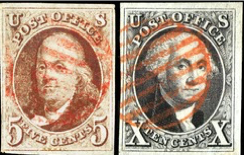 A. The Postal Service Act was signed on Feb. 20th, 1792. it spelled out congressional power in establishing mail routes and also allowed mail deliveries to include newspapers. The Act also declared it illegal for postal officials to open anyone’s mail. The postal service served the nation’s 4 million people by operating 75 regional post offices and making deliveries along 2,400 miles of postal routes.
A. The Postal Service Act was signed on Feb. 20th, 1792. it spelled out congressional power in establishing mail routes and also allowed mail deliveries to include newspapers. The Act also declared it illegal for postal officials to open anyone’s mail. The postal service served the nation’s 4 million people by operating 75 regional post offices and making deliveries along 2,400 miles of postal routes.
The cost of sending a letter via the U.S. Postal Service in 1792 varied from 6 to 12 cents, depending on the destination. That amount today would be roughly equivalent to spending between $1.45 and $2.90 for a first class postage stamp. However, prepaid postage hadn’t come to be yet, so the recipient paid the postage on delivery vice the sender! The adhesive postage stamp (example shown above) didn’t come into use until 1847. (CoinAge Magazine, May 2015)
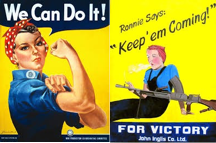 Q. Was the iconic figure “Rosie, The Riveter” based on a real person?
Q. Was the iconic figure “Rosie, The Riveter” based on a real person?
A. Rosie was based on an actual woman named Rosie Bonavitas, who worked for Convair, an American aircraft manufacturer in San Diego, CA. The concept of Rosie also stems from a Canadian woman named Veronica Foster, who was widely known as “Ronnie, the Bren Gun Girl” and a poster child for women in the war effort. While many women who were employed during World War II returned to stay-at-home life after the conflict ended, millions remained in the workforce and helped fuel the feminist movement that would develop in the coming decades. (CoinAge, Jan. 2015)
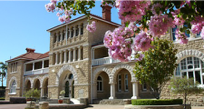 Historical Fact: The Perth Mint in Australia was founded in the 1890’s to handle the refinement of the thousands of gold deposits from the gold rush of Western Australia. When it was de-commissioned in 1990, 14 of the old smelting furnaces were crushed and about 18 kilograms of gold (about $800,000) was recovered that had embedded itself in the brickwork. Inspired by this, the corrugated ceiling was also hand scraped by wire brush and an additional 1.5 kilograms was recovered in the form of microscopic gold dust. When the smelting furnaces got too hot, (sometimes reaching 3,000 degrees+ Fahrenheit), the gold vaporized and became lodged on any nearby surface. Despite the Perth Mints’ best efforts a loss of a gram a day, an ounce a month, was normal, causing headaches for the Perth Mint’s accountants. The new Perth Mint uses electronically controlled furnaces eliminating the overheating and subsequent loss.
Historical Fact: The Perth Mint in Australia was founded in the 1890’s to handle the refinement of the thousands of gold deposits from the gold rush of Western Australia. When it was de-commissioned in 1990, 14 of the old smelting furnaces were crushed and about 18 kilograms of gold (about $800,000) was recovered that had embedded itself in the brickwork. Inspired by this, the corrugated ceiling was also hand scraped by wire brush and an additional 1.5 kilograms was recovered in the form of microscopic gold dust. When the smelting furnaces got too hot, (sometimes reaching 3,000 degrees+ Fahrenheit), the gold vaporized and became lodged on any nearby surface. Despite the Perth Mints’ best efforts a loss of a gram a day, an ounce a month, was normal, causing headaches for the Perth Mint’s accountants. The new Perth Mint uses electronically controlled furnaces eliminating the overheating and subsequent loss.
Coin of the Month.
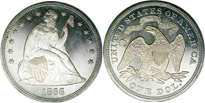
The June coin is the Seated Liberty dollar. It was the last silver coin of that denomination to be struck before passage of the Coinage Act of 1873, which temporarily ended production of the silver dollar for American commerce. The coin's obverse is based on that of the Gobrecht dollar, which had been minted experimentally from 1836 to 1839. However, the soaring eagle used on the reverse of the Gobrecht dollar was not used, instead, the United States Mint used a heraldic eagle, based on a design by late Mint Chief Engraver John Reich first utilized on coins in 1807.
Seated Liberty dollars were initially struck only at the Philadelphia Mint; in 1846, production began at the New Orleans facility. In the late 1840s, the price of silver increased relative to gold because of an increase in supply of the latter caused by the California Gold Rush; this led to the hoarding, export, and melting of American silver coins. In 1866, "In God we trust" was added to the dollar following its introduction to United States coinage earlier in the decade creating two types of Seated dollars. Seated Liberty dollar production was halted by the Coinage Act of 1873, which authorized the trade dollar for use in foreign commerce. Minted at the Philadelphia, New Orleans, Carson City, and San Francisco Mints with the following specs: Weight: 26.73 grams. Composition: .900 Silver and .100 Copper, Diameter: 38.1 mm. Reeded edge. Designer: Christian Gobrecht
Currency Note of the Month.
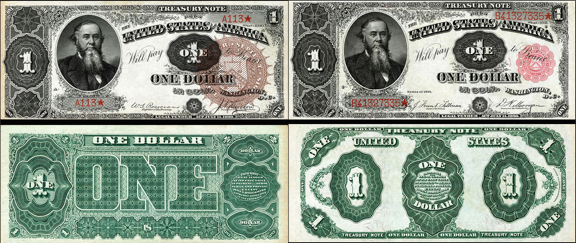
$1 1890 and 1891 Stanton Treasury Notes
The $1 Stanton Treasury Note (also known as a “Coin Note”) was a type of representative money issued by the United States government from 1890 until 1893 under authority of the Sherman Silver Purchase Act. It was issued as part of 2 series’ of notes with denominations of $1 to $1,000.
These Treasury Notes were issued by the government to individuals selling silver bullion to the Treasury. Unlike other redemption notes like silver and gold certificates, (which stipulated whether the note was backed by and redeemable for silver or gold coin, respectively) Treasury Notes stipulated only that they were redeemable in coin. This allowed the Treasury to fulfill the note's obligation in silver coin, gold coin, or both, at its discretion when the note was redeemed. This flexibility allowed the Treasury some control over releasing gold or silver when the relative value of the two metals fluctuated. The origin of the term "Coin Note" to describe the note is unclear, it may refer either to the coin it could be exchanged for, or derive from the fact that it was issued to pay for silver that would later be turned into coins
A distinctive engraved portrait of Stanton is portrayed on these notes dated 1890 and 1891. These rare notes are considered by many to be among the finest examples of detailed engraving ever to appear on banknotes. The $1 Stanton "fancyback" note of 1890, with an estimated 900–1,300 in existence relative to the millions printed, ranks as number 83 in the "100 Greatest American Currency Notes" compiled by Bowers and Sundman. There are 6 signature varieties for this note. Prices start at around $300 for a well circulated example up to $25,000 for uncirculated examples of the 1890 note. 1891 notes are much more reasonable with a price range of $200 to $3,000 respectively.
Book Recommendation
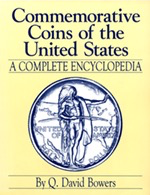 This months newsletter marks the 50th Book recommendation that I have done. Not only is this a good reference book written by one of the most knowledgable numismatic writers, but it is available for FREE on-line! Professional Coin Grading Service maintains an excellent library of coin and currency reference books on-line and this is one of them. Just go to PCGS.COM and check out the resources section for a large library selection of free numismatic references. For those that still favor a printed copy, Amazon offers it on their website in both new and used condition for less than $20.
This months newsletter marks the 50th Book recommendation that I have done. Not only is this a good reference book written by one of the most knowledgable numismatic writers, but it is available for FREE on-line! Professional Coin Grading Service maintains an excellent library of coin and currency reference books on-line and this is one of them. Just go to PCGS.COM and check out the resources section for a large library selection of free numismatic references. For those that still favor a printed copy, Amazon offers it on their website in both new and used condition for less than $20.
"Commemorative Coins of the United States: A Complete Encyclopedia" by Q. David Bowers
Few U.S. Coin series elicit the excitement and collector enthusiasm as do the Commemorative Coins. Struck from 1892 through the present day, these beautiful coins mark important events in our nation's history. In his Complete Encyclopedia, author Q. David Bowers recounts the entire story of these fascinating issues, including mintage statistics, grading, designer biographies, market history and a coin by coin look at the entire series. Although the pricing data is no longer current, there is little else about commemoratives which cannot be found in this comprehensive work. (PCGS.COM)
NUMISMATIC AND HISTORICAL QUESTIONS AND FACTS (MAY)
Q. I’ve noticed coins left on the headstones of military members. Do you know of any specifics about the practice?
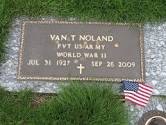
A. While there is some argument as to how far back the tradition goes, there is cer- tainly evidence that it experienced a surge in popularity during, and following, the Vietnam War. The coins themselves do have specific sig- nificance. A penny is just a simple sign that the grave was visited and respects were paid. A nickel means that the visitor spent time with the deceased at boot camp. If you see a dime, it means that the visitor served with the soldier at some point in time. Finally, a quarter indicates that the visitor was present at the time when the de- ceased fell.It’s also thought that the act may stem from the Ancient Greek/Roman tradition of leaving coins on the eyes of the deceased to help pay for passage into the afterlife.This Memorial Day, remember to give thanks and appreciate all of the fallen heroes who have served and given up their lives for our freedom.
Q. The country of Transdniester recently issued coins made of plastic. Are they really the first government to issue coins of this material as they claim to be?
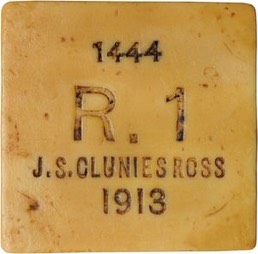
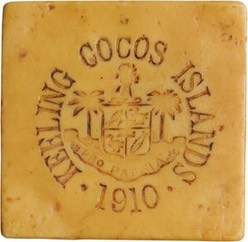
A. When you say “first government,” that becomes questionable. Keeling Cocos was established by two gentlemen in the 19th century. Captain John Clunies-Ross brought his family (including his mother- in-law), while Alexander Hare was accompanied by his private harem of 40 Malay women. A feud and “invasion” of Hare’s “kingdom” by the captain’s sailors ensued. Following the victory, the captain’s employ- ees were later paid in Cocos rupee denominated company store money. In 1913 plastic ivory composition coins were issued, followed by plastic coins in 1968. Since Keeling is an Australian Territory it can be argued the coins are tokens. Likewise, since only Russia recog- nizes Transdniester are the Transdniester issues coins or tokens? (Coin Clinic, R. Giedroyc, Numismatic News, Oct 3,2014)
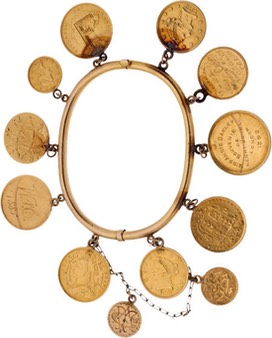
Historical Fact: While Annie Oakley rarely wore bracelets due to in- terfering with her performance shooting, Heritage Auctions recently sold a charm bracelet that was owned by her and apparently had sentimental value. Consisting of hinged gold pipes (about 1/8" in di- ameter) with a spring-blade clasp and safety chain, from the wrist band and chain hang twelve gold charms. But they are not just charms. Each is a gold coin: one British gold sovereign, four British gold half-sovereigns, four U.S. five-dollar gold coins, and three U.S. $2 1/2 gold coins. The oldest coins are an 1873 $5 gold piece and an 1873 half-sovereign; the newest is the sovereign which was first issued in this style in 1887. As charms, they date from 1885 to 1892.
How precious was the charm bracelet to her? By 1919, the first charms were nearly thirty-five years old; the newest had been given to her twenty-seven years before. During 1917 and 1918 Annie had melted down almost all of her silver and gold medals, cups, and trinkets to buy Liberty Bonds, setting a public example of support for the war effort. So apparently it was not the intrinsic value of the gold (about 1.35 troy ounces) that made her continue to treasure it. The bracelet meant too much to her to part with for several reasons. It provided a sentimental attachment to significant events; it was an emblem of loyalty to the memory of Buffalo Bill and the others; and, it was a beautiful piece of jewelry, tasteful, understated, elegant, and perfectly suited to her sense of herself.
Coin of the Month.
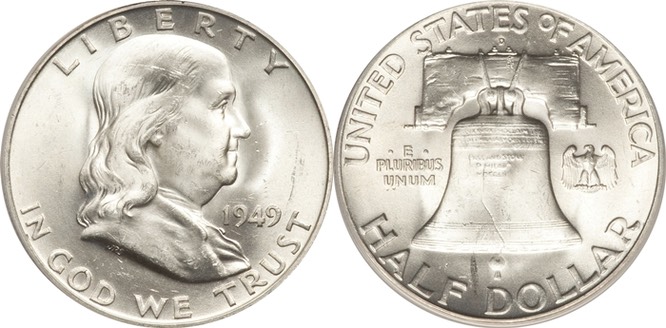
This months’ coin is the Franklin Half Dollar which is avidly collected by many numis- matists, including myself. First struck in 1948 at the start of the “Cold War” its intro- duction completed the conversion of U.S. coin designs from allegorical figures to por- traits of famous Americans. The choice of Ben Franklin as a U.S. coinage subject was an excellent one. Of all the Founding Fathers, Franklin very likely enjoyed the great- est stature among his contemporaries, not only in this country but also abroad. He was justly renowned as a printer, publisher, author, inventor, scientist and diplomat, and he played a pivotal role in helping the colonies gain their independence by secur- ing vital aid from France.
The Liberty Bell on the reverse made sense as a complement to Franklin, since both have become closely identified not only with the nation’s birth but also with the city of Philadelphia. Three inscriptions are arranged around the bell in the same sans serif style used on the obverse: UNITED STATES OF AMERICA is above, HALF DOLLAR below and E PLURIBUS UNUM, in much smaller letters, to the left. To the right of the bell is a puny-looking eagle. This had been required by law on the half dollar since 1792 and was reaffirmed by the Coinage Act of 1873, which mandated the placement
of an eagle on every U.S. silver coin larger than the dime. The eagle was added by Gilroy Roberts, who completed work on the coin following Sinnock’s death in 1947.
Because they are so plentiful, in circulated condition most Franklin halves bring little or no premium above their bullion value. A full set of Franklin halves consists of 35 different business strikes and 14 different proofs. Because it is so compact and easily affordable in less-than-pristine grades, the series is widely collected by date and mint. Those with deeper pockets may seek to assemble date-and-mint sets in MS-65 and above or collections of high grade proof Franklins with deep cameo contrast. Points on the design to first show wear are Franklin’s cheek, shoulder and hair behind the ear and the lettering and lines on the Liberty Bell.
Minted from 1948 to 1963 at the Philadelphia, Denver, and San Francisco mints with the following specs: Weight: 12.50 grams. Composition: .900 Silver and .100 Copper, Diameter: 30.6 mm. Reeded edge. Designer: John Sinnock (Liberty Bell based on a sketch by John Frederick Lewis)
Currency Note of the Month.
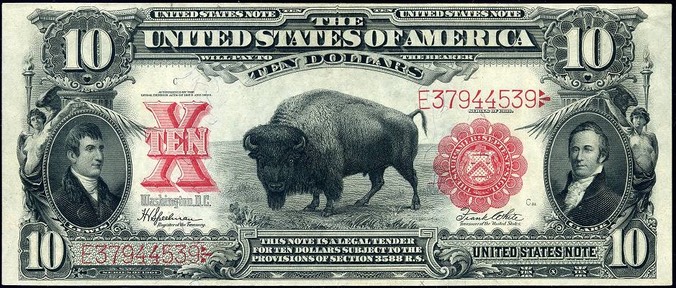
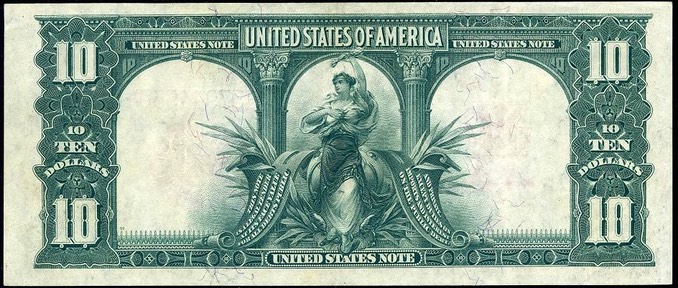
$10 Bison Note Series of 1901.
While there is some controversy as to the original model for the bison engraving on this note, according to research, the original engraving is based on a stuffed bison that was on display at the Smithsonian in the late 19th century. That specific bison was apparently shot in Montana in 1886. The image of the bison was based on a drawing by celebrated wildlife artist Charles Knight. The intricately detailed portraits on either side of the bison are of Meriwether Lewis and William Clark, two adventur- ers whose famous 4,000-mile journey had an incredible influence on the shaping of the American West. The reverse features an allegorical figure representing Columbia between two Roman-styled pillars and 2 scrolls with the value obligation written on them.
Issued from 1901 until 1925, this popular but exceedingly rare collectible bill honors the U. S. government’s commitment to frontier development at the turn of the 19th
century. It was welcomed with much fanfare during its first year—in fact, the April 10, 1901 edition of The New York Times hailed it “as artistic as any bill that has been is- sued in many years.”
While it is unknown how many still exist, the note is rare. Prices start at around $500 for a well circulated example up t0 $15-25,000 for uncirculated examples. There are 9 signature varieties but the big draw for this note is the spectacular artwork and de- sign.
Book Recommendation
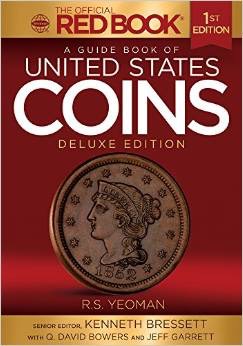
When I first started doing a book recommendation in the newsletter, the first book I did was the classic Red Book. Well, this year Whitman Pub- lishing has released a new version of the Red Book called “The Deluxe Edition”. Billed as the “biggest, most useful Red Book ever,” the Deluxe Edition measures 7 x 10 inches and has 1,504 pages. The larger size and increased page count combined make the Deluxe Edition five times bigger than the regular-edition Red Book. It prices 8,018 items in up to 12 grades each, with 50,205 individual values and 16,667 auction records covering circulated, Mint State, and Proof coinage. The book is illustrated with 5,753 images. This is one “BIG” book! The book’s Senior Editor is Kenneth Bressett, Valuations Editor is Jeff Garrett, and Research Editor is Q. David Bowers. A 57- page introduction, “The Story of American Money,” is based on the work of the late Dr. Richard Doty, senior curator of the National Numismatic Collection at the Smithsonian. Each year, the new Deluxe Edition will feature an in-depth focus on one or more coin series. The first edition includes a special 364-page section on copper half cents and large cents written by Q. David Bowers, with images, history, diagnostics, and pricing for 832 die varieties, 1793– 1857. For those that love statistics and mass information this is the book for you!
NUMISMATIC AND HISTORICAL QUESTIONS AND FACTS (APRIL)
 Q. How much copper is on the Statue of Liberty?
Q. How much copper is on the Statue of Liberty?
A. The Statue of Liberty is famous for its greenish tint, a result of the oxidation of her copper sheathing. However her copper skin is surprisingly thin! Lady Liberty is sheathed in 3/32” copper about the thickness of 2 cents. The total weight of the copper is 62,000 lbs. with a value of $248,000.
Q.Is it legal for a private Mint to use legal tender silver dollars as blanks to strike fantasy or souvenir coins?
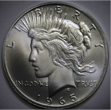 On July 22, 1980, U.S. Mint Counsel Kenneth B. Gubin wrote to Vance fowler on Dept. of the Treasury, Office of the Director of the Mint stationery. The letter has since been published in Fowler’s book Encyclopedia of the Modern Elongated. Within this letter Gubin states, “{Title 18, USC sections 331} being a criminal statute, a fraudulent intent is required for violation. Thus, the mere act of compressing coins into souvenirs is not illegal, without other factors being present.”
On July 22, 1980, U.S. Mint Counsel Kenneth B. Gubin wrote to Vance fowler on Dept. of the Treasury, Office of the Director of the Mint stationery. The letter has since been published in Fowler’s book Encyclopedia of the Modern Elongated. Within this letter Gubin states, “{Title 18, USC sections 331} being a criminal statute, a fraudulent intent is required for violation. Thus, the mere act of compressing coins into souvenirs is not illegal, without other factors being present.”

Historical Fact: A British 5 pound coin will be released next year to commemorate the 100th anniversary of the death of Edith Cavell, a World War 1 nurse. Cavell saved thousands of lives on both sides and helped nearly 200 Allied soldiers escape German-occupied Belgium. Found guilty of treason for her actions, she was executed by a German firing squad, an act that brought global press coverage and condemnation. The coin will be part of a set produced by the Royal Mint to mark the war’s centennial. (The Numismatist, August, 2014)
Coin of the Month.

I decided to pick a real rarity this month with 1792 half disme. The 1792 half disme (pronounced dime) was an American silver coin with a face value of five cents. Although it is subject to debate as to whether this was intended to be circulating coinage, or instead an experimental issue, President George Washington referred to it as "a small beginning" and many of the coins eventually were released into circulation. It is widely (although not universally) considered the first United States coinage struck under authority of the Mint Act of April 1792. Because of President Washington's connection with these early coins, numismatic folklore holds that the portrait on the obverse is that of First Lady Martha Washington and that some of the coins were struck using melted-down silverware from the Washington household.However, there is no solid evidence for either of these assertions.
Although the exact number is not known, it is believed that between 2,000 and 3,500 specimens were produced. Approximately 10% of these survive today; one expert estimated between 250 and 400 half dismes exist, and most appear to have been used in circulation for some time. An almost uncirculated 1792 half disme was auctioned for $138,000 on July 24, 2004. Because this was some of the the first coinage minted the exact specifications are variable, but the following is reasonably close: Minted in the Philadelphia basement of Thomas Birch, the designer, with the following specs: Weight: 20 grains. Composition: .8924 Silver and .1076 Copper, Diameter: 16.5 mm. Reeded edge. Designer: Thomas Birch
Currency Note of the Month.
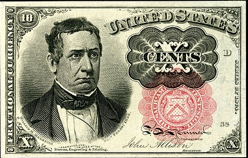
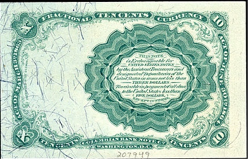
Fractional currency was first issued during the Civil War as a replacement for small change. Small change was hoarded for its intrinsic metal value due to the uncertainties of the war and merchants were clamoring for an acceptable substitute. Fractional currency was created and released in 5 Cogressionally authorized issues from 1862 to 1876. It should be mentioned that this was the first currency ever issued by the Federal Government and that, while it was redeemed when coinage returned to normal levels, it was never officially cancelled and remains legal tender even today.
This particular note is a 10 cent Fifth issue and is referenced as a FR-1265 based upon the Friedberg numbering system used by most fractional collectors. There are 3 varieties of this note. 2 with red Treasury seals (different size keys in the seal) and one with a green seal. The portrait is of William Meredith and is considered by many (including this author!) as one of the worst portraits ever for a U.S. currency note. He was Secretary of the Treasury from 1849-1850 and was recently deceased when this note was issued. He was an extremely intelligent individual, graduating from the University of Pennsylvania at the age of 13 and admitted to the Board by the age of 18! Almost 200 million of these notes were produced with the latest in counterfeiting techniques (the random blue fibers in the paper are one example) and are reasonably common for collectors.
Book Recommendation
 This month’s book recommendation may be a little outside of the realm of numismatics but it may inspire someone to search for a real treasure! The Fenn Treasure is a treasure reportedly worth $1M–$3M (TrueWest magazine just made an estimate of $5M) hidden by art dealer and writer Forrest Fenn in the Rocky Mountains. Forrest Fenn was diagnosed with cancer in 1988. He came up with the idea during this illness to create a bronze chest full of treasure for anyone to go
This month’s book recommendation may be a little outside of the realm of numismatics but it may inspire someone to search for a real treasure! The Fenn Treasure is a treasure reportedly worth $1M–$3M (TrueWest magazine just made an estimate of $5M) hidden by art dealer and writer Forrest Fenn in the Rocky Mountains. Forrest Fenn was diagnosed with cancer in 1988. He came up with the idea during this illness to create a bronze chest full of treasure for anyone to go  find. He filled the chest with "treasure" containing gold nuggets, rare coins, jewelry and gemstones, along with a jar holding his autobiography. He intended to hide it and die in the wilderness, with the treasure as a legacy. However, he survived his illness and waited until he was 79 or 80 to hide the treasure.His memoir "The Thrill of the Chase” was published in 2010, containing a poem that contains clues that lead to the location of the hidden treasure. Fenn has also provided additional clues on "The Today Show" and in various interviews. In September 2013, Fenn announced the publication of a new book, “Too Far to Walk”, containing a pullout map of the area surrounding the treasure. As of 2014, Fenn has stated that to his knowledge it is still not found.
find. He filled the chest with "treasure" containing gold nuggets, rare coins, jewelry and gemstones, along with a jar holding his autobiography. He intended to hide it and die in the wilderness, with the treasure as a legacy. However, he survived his illness and waited until he was 79 or 80 to hide the treasure.His memoir "The Thrill of the Chase” was published in 2010, containing a poem that contains clues that lead to the location of the hidden treasure. Fenn has also provided additional clues on "The Today Show" and in various interviews. In September 2013, Fenn announced the publication of a new book, “Too Far to Walk”, containing a pullout map of the area surrounding the treasure. As of 2014, Fenn has stated that to his knowledge it is still not found.
NUMISMATIC AND HISTORICAL QUESTIONS AND FACTS (MARCH)
 Q. What has been the largest salvage of shipwrecked gold and silver?
Q. What has been the largest salvage of shipwrecked gold and silver?
A. Odyssey Marine Exploration has recovered over 15,500 silver and gold coins as well as 45 gold bars and hundreds of gold nuggets, dust and jewelry from the SS Central America shipwreck. The total value of the recovered gold was estimated at $100–150 million. A recovered gold ingot weighing 80 lbs. (36 kg) sold for a record $8 million and was recognized as the most valuable piece of currency in the world at that time. While salvage operations are still currently on-going, the S.S. Central America will never be topped, as no other ship with more numismatically desirable gold has ever been lost.
Q.Since all the of the proof Eisenhower Bi-Cenntenial dollars have the same combination date, 1776-1976, is it possible to tell which coins were struck in 1975 and which in 1976?

A. Although no problems were reported with the striking of the silver-clad Eisenhower dollars, there was problems with the striking of the copper-nickel versions. Chief Engraver Frank Gasparro retooled the dies and this resulted in 2 types of copper-nickel clad Bi-Centennial dollar coins. Type II dollars feature sharper, narrower lettering on the reverse than Type I examples. All proof copper-nickel dollars from 1975 feature a Type I reverse, while all 1976 copper-nickel clad proofs are Type II.
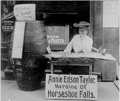
Historical Fact: Surprisingly, the first person to go over Niagara Falls in a barrel was a woman! On 24 October 1901, Annie Edson Taylor, on her 63rd birthday, was the first person to go over the falls in a barrel. She took the 167 foot plunge in an old pickle barrel, padded with a mattress, in the hope of making money. The watertight barrel was inflated to 30 PSI with a bicycle pump prior to the plunge. Miraculously, she survived with only cuts and bruises, but the fortune she hoped for never appeared.
Coin of the Month
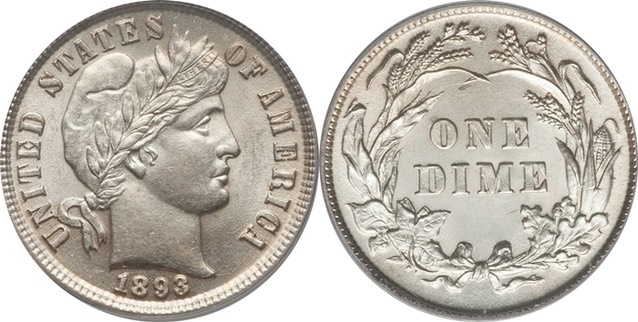
The Barber Dime,also known as the Liberty Head dime, was minted from 1892 to 1916 by Charles Barber. These are more commonly called "Barber Dimes" because of this. The coins were originally meant to be designed by the public but later taken over by Charles Barber the then current Chief Engraver for the United States Mint due to financial issues.
The obverse of this coin has the head of liberty crowned by a wreath. The reverse is engraved with a wreath of corn or wheat representing American agricultural products. The Barber dime series consists of 74 regular issues, plus the ultra-rare 1894-S and two major varieties (1893/2-P and 1905-O micro-O).
In the first half of 1894, 24 proofs of the Barber series dimes were minted in San Francisco, which is where the S in the common name of the coin comes from. The superintendent of the San Francisco Mint is said to have had them minted as gifts for some important bankers. Only nine are known to survive; seven are uncirculated, while two are heavily worn. Further, three of the dimes were said to have been given to the superintendent's daughter, who allegedly spent one on ice cream and sold the other two in the 1950s. Due to the rarity of the coin and the mysteries surrounding its past, the 1894-S dime is one of the most valuable coins produced in the United States. In the late 1990s, one of the remaining 1894-S dimes was bought for $825,000. Since then one sold for $1.3 million in 2005; and one for $1.9 million in 2007.
Minted at the Philadelphia, San Francisco, New Orleans, and Denver Mints with the following specs: Weight: 2.5 grams. Composition: .900 Silver and .100 Copper, Diameter: 17.9 mm. Reeded edge. Designer: Charles E. Barber
Currency Note of the Month.

Collectors know the Series 1923 Fr. 282 $5 Porthole Note by its nickname the “Porthole Note.” It’s easy to see how this $5 Silver Certificate came by this descriptive moniker. At its very center on the face, our nation’s 16th President Abraham Lincoln gazes from a circular ring emblazoned “The United States of America” which mimics the shape of a maritime window. The photo on which the portrait is based was taken by Anthony Berger and shows how Civil War President looked on his 55th birthday in the throes of our great national calamity. The starched presidential photo on which the currency engraving is based was taken Feb. 9, 1864, just three days before.
Besides its spectacular portrait, the well-balanced design has a blue Treasury Seal, denomination counter, and serial numbers. The five dollar back is a generic back and simply states FIVE DOLLARS. One would have to turn it over to recognize that it was a Silver Certificate. It was part of the Series 1923 standard back designs. It also sports the Great Seal of the United States as used on the back of small size $1 notes engraved by Robert Ponickau. Treasury records show 6.32 million Porthole Notes were issued, all regular notes from the AB block. Only one variety exists, signed by Register of the Treasury Harley V. Speelman and U.S. Treasurer Frank White. They served in office jointly from Jan. 25, 1922 to Oct. 30, 1927. Experts estimate about 2,500 examples of the Porthole Note still exist. Only 38 of them are the coveted Star (replacement) Notes, that have thus far been recorded. Today well-circulated (VG-F) examples are available for under a thousand dollars, well worth the price because their jumbo presidential image can still give less than perfect notes “wow appeal.”
Book Recommendation
Carson City Morgan Dollars: Featuring the Coins of the GSA Hoard (Official Whitman Guidebook) by Adam Crum, Selby Ungar, and Jeff Oxman.

In this expanded and revised 2nd edition, three numismatic experts chronicle the amazing history of the California Gold Rush, its effects on silver mining and the development of Nevada, and the birth of the Carson City Mint. They give the collector and investor a detailed insider's view of today's market for Carson City Morgan dollars, including VAM varieties and focusing especially on GSA-slabbed coins. Whether you collect by date/mintmark or by variety, this in-depth book will make you a more savvy buyer. Includes condition census, market notes, enlarged full-color photographs, valuations, mintages, certification data, prooflike and DMPL coins, and more. (amazon.com)
NUMISMATIC AND HISTORICAL QUESTIONS AND FACTS (FEBRUARY)
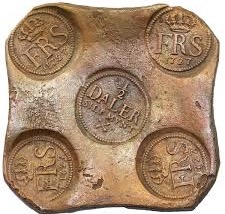
Q. There has been some articles lately about Swedish Plate money. What are they?
A. Swedish copper plate coins are one of the most unusual types of coin. Plate money was issued as a replacement for silver and gold coinage, as specie in these metals was scarce in Sweden and its possessions while copper was readily available in massive quantities. These large “coins” were issued from 1644 to 1776 in denominations from one-third daler to 8 dalers. The copper came not just from mines but also from cannon barrels that were repurposed and used to produce these coins. Many known examples of Swedish plate money were recovered from the wreck of the Nicobar, a Dutch East India Co. ship that struck a reef near Cape Agulhas, South Africa, and sank July 11, 1783. A collection of these was recently sold at a Stack’s Bowers Galleries sale during the New York International Numismatic Convention generating the recent interest.
Q.What real person holds the record for most biographical books written about them or their lives?
A. The top 4 (approx.), in ascending order, are Napoleon Bonaparte (5,700 books), Abraham Lincoln (20,000 books), William Shakespeare (56,000), and Jesus Christ (over 100,000).

Historical Fact: Readers that are baseball fans know that Abner Doubleday is credited (incorrectly) with inventing baseball and doing so in Calvin Graves’ hometown of Cooperstown N. Y. This myth was established almost solely on the basis of eyewitness testimony (letters) of Abner Graves (the nephew of Calvin Graves) to a special commission set up in 1907. Though slow to be accepted to this day, in June of 1953, Congress officially credited Alexander Cartwright with inventing the game, and not in Cooperstown. Soon after providing testimony as to the origins of the game of baseball, Abner Graves killed his wife and thereafter spent his remaining life in a mental institution.
Coin of the Month.
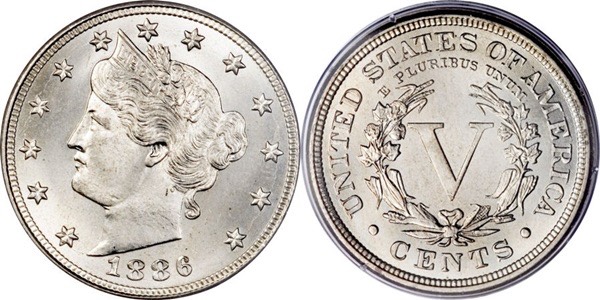
This month we have the Liberty Head nickel, sometimes referred to as the V nickel because of its reverse (or tails) design. An American five-cent piece it was struck for circulation from 1883 until 1912, with at least five pieces being surreptitiously struck dated 1913. The original copper–nickel five-cent piece, the Shield nickel, had longstanding production problems, and in the early 1880s, the United States Mint was looking to replace it. Mint Chief Engraver Charles Barber was instructed to prepare designs for proposed one, three, and five cent pieces, which were to bear similar designs. Only the new five-cent piece was approved, and went into production in 1883. For almost thirty years large quantities of coin of this design were produced to meet commercial demand, especially as coin-operated machines became increasingly popular. Although no 1913 Liberty head nickels were officially struck, five are known to exist. While it is uncertain how these pieces originated, they have come to be among the most expensive coins in the world, with one selling in 2010 for $3,737,500. Minted at the Philadelphia, San Francisco, and Denver Mints with the following specs: Weight: 5 grams. Composition: .750 Copper and .250 Nickel, Diameter: 21.2 mm. Plain edge. Designer: Charles E. Barber
Currency Note of the Month.
This months currency selection is the common $1 Federal Reserve note. This is the dollar note we see almost every day and is probably one of the most unappreciated! The one dollar denomination of Federal Reserve notes are a recent addition to the FRN series, starting production in 1963 and continuing to the present. If a beginning United States currency collector wanted to put together a whole series of notes, this would be the place to start. The entire set of one dollar federal reserve notes could be put together at a modest cost, even including the star notes.
All of the 1.00 FRN bills have George Washington (painted by Gilbert Stuart) on the front. On the left is an alphabetic seal designating the issuing Federal Reserve Bank and to the right is the seal of the Department of the Treasury. Printed signatures of the Treasurer of the United States and the Secretary of the Treasury are at the bottom of the note. At the top is the notation “This Note is Legal Tender For All Debts Public and Private”. 2 matching serial numbers and 4 denomination indicators complete the design.
The reverse features both sides of the Great Seal of the United States created by Charles Thomson. On the right is the obverse with an American bald eagle as the centerpiece and a shield upon the eagle's breast. In the eagle's right talon is an olive branch. In its left, a tightly drawn bundle of arrows. Thomson said these symbols represent "the power of peace and war.” In the eagle's beak, he placed a scroll with the first committee's motto: E Pluribus Unum (Out of Many, One). For the crest above the eagle's head, Thomson used the radiant constellation of thirteen stars suggested by the second committee. He described the light rays as "breaking through a cloud”. For the reverse of the Great Seal, Thomson used an unfinished pyramid with the eye of Providence in its zenith, with a triangle around the eye. He also created two new mottoes: "Novus Ordo Seclorum" (A New Order of the Ages) and "Annuit Coeptis" (Providence has Favored Our Undertakings).
Book Recommendation
That odd-looking coin could be worth a fortune! Mistakes happen. Now you can cash in on them. The U.S. Mint produces error coins every year on every denomination. From doubled die cents to rotated reverse quarters to missing letters on dollars, these coins can be worth far more than face value. Featuring expert insight, hundreds of close-up images, concise details on what to look for and where, and up-to-date market values, you will learn how to spot and profit from even the most well disguised treasures in the new edition of Strike It Rick with Pocket Change.Co-authored by Ken Potter and Brian Allen.
NUMISMATIC AND HISTORICAL QUESTIONS AND FACTS (JANUARY)
Q. I have seen a number of so-called “wooden nickels” but has there ever been any issues of real denominations?

A. When the Citizens Bank of Tenino Wash. failed during the Depression, the local Chamber of Commerce decided to issue wooden money allowing some of the account holders to at least recover some of their money from the failed bank. Each account holder was allowed to convert 25% of their account into the substitute money printed on “slice wood” spruce and cedar. Eight different series were issued with a total face value of $10,000.
Q. What is the longest a coin series has not been minted and then brought back to production?

A. While the Morgan Silver Dollar was not produced from 1905 to 1920 (17 years), the Susan B. Anthony dollar holds the record with a gap of 18 years (1981-1999) in production. With dwindling supplies for postage vending machines the U.S. Mint produced 29.5 million SBA dollars in 1999!
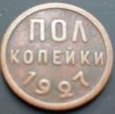
Historical Fact: In 1925 the Communist regime of the Union of Soviet Socialist Republics released a small copper half kopeck coin. It was not a popular coin, (it was only produced for 3 years), and would have passed on unnoticed if not for the reason of its production. It appears its primary use, although never officially admitted, was as a deposit on a vodka bottle! Early Soviet philosophy blamed capitalism for all the people’s ills, alcoholism among them, and it would never do to for the half kopeck to suggest there continued alcohol abuse in the workers’ and peasants’ fatherland.
Coin of the Month.
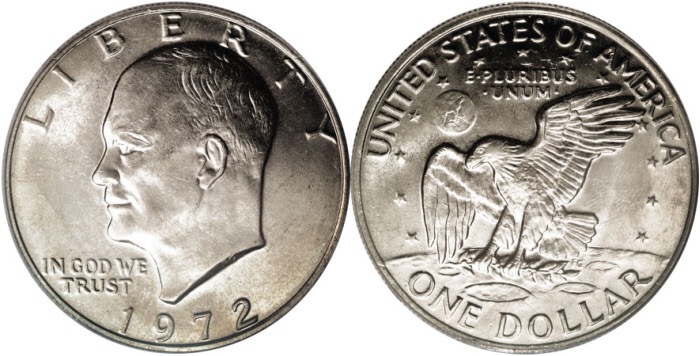
The Eisenhower dollar is a one-dollar coin issued by the United States Mint from 1971 to 1978; it was the first coin of that denomination issued by the Mint since the Peace dollar series ended in 1935. The coin depicts General and President Dwight D. Eisenhower, who appears on the obverse. At Congress's insistence, the chief engraver created a reverse design in commemoration of the Apollo XI lunar landing, based on the mission patch conceived by astronaut Michael Collins and others. The reverse depicts an eagle (representing the lunar lander, Eagle) swooping low over the Moon's surface, holding an olive branch, token of peace, in its claws.Both its obverse and reverse were designed by Frank Gasparro. Although the collector's pieces sold well, the new dollars failed to circulate to any degree, except in and around Nevada casinos, where they took the place of privately issued tokens. There are no dollars dated 1975; coins from that year and from 1976 bear a double date 1776-1976, and a special reverse by Dennis R. Williams in honor of the bicentennial of American independence. Due to their modest cost and the short length of the series, sets of Eisenhower dollars are becoming more popular among collectors. Minted in 2 types (40% Silver Collector and Clad Circulating) from 1971 to 1978 at the Philadelphia, San Francisco, and Denver Mints with the following specs: Weight: Collector ver. 24.9 grams and Clad ver. 22.68 grams. Composition: Collector ver. .400 Silver and .600 Copper, Clad ver. .725 Copper and .250 Nickel. Diameter: 38.1 mm. Reeded edge. Designer: Frank Gasparro
Currency Note of the Month.
One of the most popular and valuable notes of all U. S. currency is the Series 1918 Federal Reserve Bank Note $2. The obverse is very ornate with a portrait of Thomas Jefferson to the left and a blue Federal Reserve Bank seal on the right. It also has the printed signatures of the Secretary of the Treasury, the Register of the Treasury, and the Cashier and Governor of the issuing bank. The reverse of this note displays the picture of a Battleship -- hence the "Battleship $2." For many years, it was not clear whether the ship was intended to be the battleship Texas, which survives on public display at the San Jacinto Battlefield outside Houston, Texas, or its sister ship, the New York. Recently the Bureau of Printing and Engraving, however, announced that the ship was supposed to be the New York. Whichever it is, the battleship depicted is of 1914 vintage and extremely detailed. Charles Burt was the engraver of the Thomas Jefferson portrait, while its back deploys C.M. Chalmers engraving of the battleship New York steaming left to right (west to east). It is said this served a propaganda purpose of warning European despots that America was ready to return and defend freedom in Europe if it were jeopardized again. Issued by all 12 of the Federal Reserve banks there are 33 combinations of signatures. Values range from around $300 for well circulated notes to $1500 or more for uncirculated.
Book Recommendation
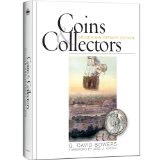
In the brand-new Golden Anniversary Edition of Coins & Collectors, Q. David Bowers brings us more than 50 illustrated chapters, telling of famous coins, obscure and mysterious tokens and medals, beautiful paper money, and legendary hoards and collections. A "Collector's Appendix" give the market values of the items discussed. Bowers shares the stories behind the popular favorites and modern-day classics. (amazon.com) This book is an entertaining read and is an excellent choice for those (hopefully!) rainy winter days. JP
NUMISMATIC AND HISTORICAL QUESTIONS AND FACTS (DECEMBER)
Q. I know that previous to the issuance of Fractional currency that Encased Postage was attempted as a solution to the on-going shortage of coinage. Was it possible to actually make change using encased stamps?
A. Encased Postage was an attempt to use stamps as small change and they were encased in small metal disks with clear mica faces to prevent the obvious problems of the stamps sticking together or being destroyed by handling. The pieces were produced by a man named John Gault and he used the backs as advertising space for a number of products and businesses that purchased the pieces from him to make change. It was possible to make change with the pieces as they were produced in 1c, 3c, 5c, 10c, 12c, 24c, 30c, and 90c denominations. It is believed that approx. 3,500 to 7,000 pieces still exist out of 750,000 produced. Common pieces sell in the $300 to $500 range and rare pieces (the 90c in particular) can go for over $25,000!
Q. How long were the Bicentennial Silver sets available for sale from the mint?
A. The Bicentennial Silver sets were an extremely popular issue by the Mint and they saw no need to stop sales as long as there was demand. The proof sets took 11 years (1974-1985) to sell out and the Mint sets lasted another year after that. (Coinage, April 2014)
Historical Fact: When the Buffalo nickel was first introduced in 1913, it was not uncommon for people to hoard the new coin in large numbers as these 2 samples attest. In January of 1917, as reported by the the Bryan Daily Eagle and Pilot of Bryan TX, Mrs. Sam Buchanan bought a new Ford Model T touring car with 7,912 Buffalo nickels. The price of the car was exactly $395.50. Mrs. G. P. Ehley of Mankato KS, had the same idea. She started saving them as soon as they were released, dropping them into a chute that ran from the kitchen to a wooden box in the cellar. According to the Nov. 6th, 1918 issue of the Dakota County Herald, she purchased a new Ford for her husband with 14,000 nickels! (Coins, August 2014)
Coin of the Month.
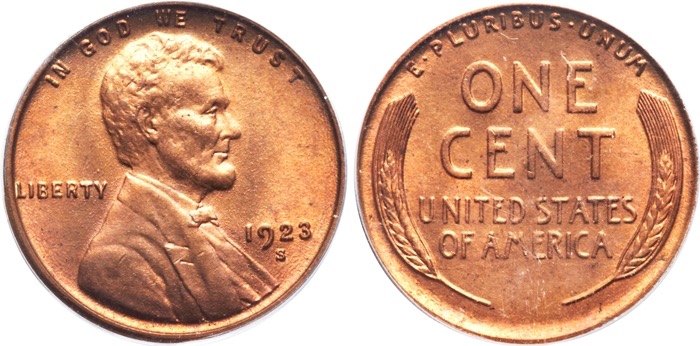
The Lincoln Cent (Wheat Ear reverse) debuted in 1909, replacing the fifty year old Indian Head Cent design. Victor D. Brenner created the famous bust of Lincoln with which we are all so familiar today. Lincoln was chosen as the subject for the new Cent since 1909 was the centennial of his birth. Until the appearance of Brenner's design, no person (living or dead), had ever appeared on a coin made for general circulation. (However, this precedent had already been established on a few commemorative coins.) The earliest versions of the Lincoln Cent featured Brenner's initials (V.D.B.) near the bottom of the back of the coin. Apparently, such a prominent display was considered offensive, and the initials were removed later in 1909. In 1918, the initials re-appeared, this time hidden on the truncation of Lincoln's bust. The reverse is adorned with 2 wheat ears. There are 2 composition varieties of the Lincoln cent (Wheat Ear reverse). The original cent was composed of .950 copper and .50 tin and zinc. In 1943, due to a shortage of copper, steel planchets coated with zinc were used, and in 1944 the original composition returned, albeit with copper salvaged from shell casings giving the coins a slightly different color. Minted from 1909 to 1958 at the Philadelphia, San Francisco, and Denver Mints with the following specs: Weight: 3.11 grams (steel var. 2.7 grams). Diameter: 19 mm. Plain edge. Designer: Victor D. Brenner
Currency Note of the Month.

U.S. Fractional Lincoln notes were part of the 4th U.S. Issue of Fractional’s and were released from July 1869 through December 1869. The issue of Lincoln notes was quickly stopped and recalled due to the large quality of good counterfeits that appeared but not before over 19,000,000 were issued. Fractional notes are generally referenced by Friedberg numbers and the 50c Lincoln note is cataloged as FR-1374. The Lincoln note is one of the most popular fractional pieces, and that, combined with the short issuing period make it one of the more sought after fractional notes. At the time it was printed it had the latest in anti-counterfeiting technology including watermarked paper imbedded with pink fibers and a large over-printed Treasury seal. The reverse is very ornate, also in an effort to make counterfeiting difficult. The portrait of Lincoln was rendered by Treasury engraver Charles Burt and is considered to be one of the best portraits of Lincoln. Values run from $200 for well-worn pieces up to well over $2,000 for uncirculated examples. Surprisingly, Fractional currency has never been officially recalled by the Treasury so these notes are still considered legal tender!
Book Recommendation
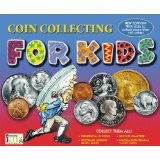
This month, since it’s close to Christmas time, I thought I would recommend something for the younger generation. (For the bargain hunters, look at Amazon’s “Used” section for specials on this book!) The “Coin Collecting for Kids” board book by Steve Otfinoski (Author), Jack Graham (Illustrator). Newly updated to include Presidential $1 coins and Westward Journey nickels! A colorful, kid-friendly book to introduce children to a lifelong hobby, Coin Collecting for Kids encourages children to search for, save, and learn all about many different U.S. coins. Take a tour through the mint and save pennies from four different decades while learning about how coins are made. Slots on every page let kids collect birth-year coins, millennium coins, and twentieth-century coins. Lastly, a gatefold spread will accommodate all 50 wildly popular statehood quarters. Organized by release year, each slot lists the state's nickname, motto, flower, and bird.
NUMISMATIC AND HISTORICAL QUESTIONS AND FACTS (NOVEMBER)
Q. A friend of mine just purchased a selection of gold plated U.S. banknotes. Are they rare and do they have any value?
A. These types of notes are commonly seen but unfortunately have little intrinsic value. They are actually not plated notes but are made from polycarbonate covered in extremely thin gold foil to resemble actual banknotes. The gold foil is approximately 0.5 microns thick. A sheet of copier paper is 60 microns thick. To give that another perspective, an ounce of the gold foil would cover an area 10 ft. by 13 ft! A single note has less than $1.00 of gold even if the foil used is 24 karat quality. They are striking looking however, and many people collect them for that reason.
Q. I recently saw some certified coins that were annotated “Shipwreck Effect” and given a “Details” grade. Could you tell me why they were graded that way?
A. They are coins recovered from famous shipwrecks that have been damaged by corrosion. Gold coins generally are not damaged by exposure to salt water but silver coins do corrode. These recovered silver coins were conserved to stabilize them and keep them from corroding further. Then they are graded based on the saltwater damage and, if possible, the original condition of the coin. The term “Shipwreck Effect” is used to annotate the cause of the surface damage. While lower value coins will get a boost from being certified as coming from a well known shipwreck, a higher value coin may trade at a discount to a problem-free coin.
Historical Fact: During the Civil War, Union forces filled a number of New England whaling and merchant vessels with stone and sank them in Charleston Harbor in an effort to prevent blockade runners from entering. The group of vessels was then called the First Stone Fleet. The vessel remains were recently discovered and mapped during an underwater survey of Charleston Harbor conducted by the University of South Carolina and funded by the National Park Service.
Coin of the Month.
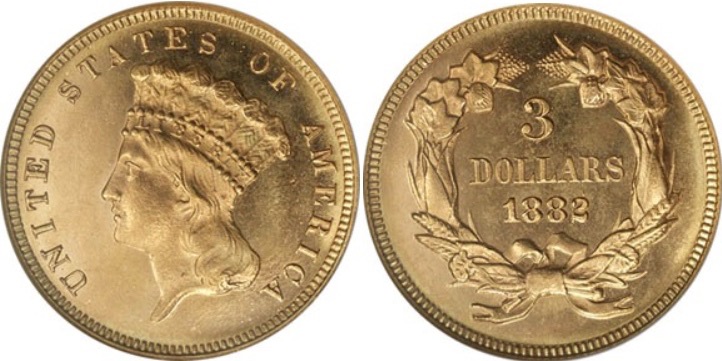
The three-dollar piece was a gold coin produced by the United States Bureau of the Mint from 1854 to 1889. Authorized by the Act of February 21, 1853, the coin was designed by Mint Chief Engraver James B. Longacre. The obverse bears a representation of Lady Liberty wearing a headdress of a Native American princess and the reverse a wreath of corn, wheat, cotton, and tobacco. In 1851, Congress had authorized a silver three-cent piece so that postage stamps of that value could be purchased without using the widely disliked copper cents. Two years later, a bill was passed which authorized a three-dollar coin. By some accounts, the coin was created so larger quantities of stamps could be purchased. Longacre, in designing the piece, sought to make it as different as possible from the quarter eagle or $2.50 piece, striking it on a thinner planchet and using a distinctive design. Although over 100,000 were struck in the first year, the coin saw little use. It circulated somewhat on the West Coast, where gold and silver were used to the exclusion of paper money, but what little place it had in commerce in the East was lost in the economic disruption of the Civil War, and was never regained. The piece was last struck in 1889, and Congress ended the series the following year. Minted from 1854 to 1889 at the Philadelphia, San Francisco, Denver, and New Orleans Mints with the following specs: Weight/Composition: 5.015 grams, .900 Gold and .100 Copper. Diameter: 20.5 mm. Reeded edge. Designer: James B. Longacre
Currency Note of the Month.

This month’s notes are the little brothers of last month’s 1918 large size $10,000 Federal Reserve note. The $10,000 small size Federal Reserve notes were issued in 2 Series, 1928 and 1934, and they are the largest denomination of U.S. currency ever in public circulation. Numerous examples of small size $10,000 notes exist (336 as of May, 2009) with current values ranging from $70,000 up to $350,000. The face has the same portrait as the large size notes of Salmon P. Chase, (painted by Henry Ulke in 1880), and the reverse has an abstract scroll-work with ornate denomination identifiers. Salmon P. Chase was Secretary of the Treasury during the Civil War and is credited with promoting our current U.S. banking system. Although they are still technically legal tender in the United States, high-denomination bills were last printed on December 27, 1945, and officially discontinued on July 14, 1969, by the Federal Reserve System.The $5,000 and $10,000 notes effectively disappeared well before then.
Book Recommendation

A while back I did a recommendation for the book “Manhunt” by James L. Swanson. This is the companion book to that one by the same author. The following synopsis is provided by Amazon.com. “In Bloody Crimes, James L. Swanson—the Edgar® Award-winning, New York Times bestselling author of Manhunt—brings to life two epic events of the Civil War era: the thrilling chase to apprehend Confederate President Jefferson Davis in the wake of the Lincoln assassination and the momentous 20-day funeral that took Abraham Lincoln’s body home to Springfield. A true tale full of fascinating twists and turns, and lavishly illustrated with dozens of rare historical images—some never before seen—Bloody Crimes is a fascinating companion to Swanson’s Manhunt and a riveting true-crime thriller that will electrify civil war buffs, general readers, and everyone in between.”
NUMISMATIC AND HISTORICAL QUESTIONS AND FACTS (OCTOBER)
Q. Why were there 2 different sizes of gold dollars mined?
A. The gold dollar was first authorized in 1849 and the Type 1 dollar was minted until 1854. The Type 1 coin was fairly thick and counterfeiters would split the coin, remove a quantity of gold from the center , and then refill them with lead. The diameter was changed in 1854 (Type 2), creating a larger but thinner coin making the practice much more difficult. There is also a Type 3 gold dollar with a smaller bust on the obverse but all 3 types contain the same amount of gold.
Q. While looking through a selection of National banknotes I noticed some notes were identified as “Forbidden” notes? What’s the meaning of the description?
A. At the time National banknotes were being used, banks purchased Federal government bonds, were issued a charter and then allowed to issue bank notes in an amount based upon the amount of those bonds. Then bank notes were printed for the bank with their name on them. The Act of May 24th, 1926 forbade the use of the words “United States,” “Federal,” or “Reserve” in the bank title but provided a grandfather clause for those banks already using those words in their title. There were 43 National banks that issued notes bearing one of these “forbidden” words in their title. This is a highly collectible sub-specialty of collecting National bank notes.
Historical Fact: Jean Henri Dunant (8 May 1828 – 30 October 1910), also known as Henry Dunant, was a Swiss businessman and social activist. During a business trip in 1859, he was witness to the aftermath of the Battle of Solferino in modern-day Italy. He recorded his memories and experiences in the book A Memory of Solferino which inspired the creation of the International Committee of the Red Cross (ICRC) in 1863. The 1864 Geneva Convention was based on Dunant's ideas and it’s humanitarian ideals were ratified by 12 states (i.e. countries). In 1901 he received the first Nobel Peace Prize together with Frédéric Passy.
Coin of the Month.
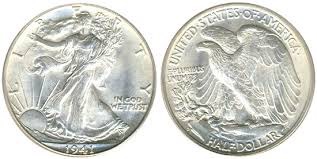
The popular Walking Liberty Half dollar was a silver 50 cent piece produced from 1916-1947 . The design bears a full-length figure of Liberty, the folds of the Stars and Stripes flying to the breeze as a background, progressing in full stride toward the dawn of a new day, carrying branches of laurel and oak, symbolical of civil and military glory. The hand of the figure is outstretched in bestowal of the spirit of liberty. The reverse of the half dollar shows an eagle perched high upon a mountain crag, his wings unfolded, fearless in spirit and conscious of his power. Springing from a rift in the rock is a sapling of mountain pine, symbolical of America. In 1917 the mint mark was moved from the obverse to the reverse resulting in 2 different types. There are few varieties in the series, and they are relatively minor. Minted from 1916 to 1947 at the Philadelphia, San Francisco, and Denver Mints with the following specs: Composition/Weight -12.5 grams, .900 Silver and .100 Copper. Diameter: 30.6 mm. Reeded edge. Designer: Adolph A. Weinman
Currency Note of the Month.
This month’s note is the 1918 large size $10,000 Federal Reserve note and it is the largest denomination of U.S. currency ever in public circulation. While numerous examples of small size $10,000 notes exist (336 as of May, 2009) only 5 large size examples are known. 2 New York, 2 San Francisco, and 1 unique Cleveland issues. All known large size notes are in government holdings thus values are unknown. The face has a portrait of Salmon P. Chase, (painted by Henry Ulke in 1880), and the reverse has a vignette, the “Embarkation of the Pilgrims”. Salmon P. Chase was Secretary of the Treasury during the Civil War and is credited with promoting our current U.S. banking system. The “Embarkation of the Pilgrims” vignette is from a painting by Robert Weir and the engraving was done W.W. Rice. Next month I will cover it’s little brother, the 1928 and 1934 issues of the small size $10,000 note.
Book Recommendation
This recommendation will be a little outside of the “box” so to speak. Instead of a specific book I am recommending joining either the Numismatic Association of Southern California (NASC) or the California State Numismatic Association (CSNA). While this may seem a little odd as a book selection, joining either organization entitles the member to receive the California Numismatist magazine. The publication is distributed quarterly and it’s informative subject material is second to none while maintaining a local perspective. Individual Membership is only $25.00 annually and the subscription to the magazine alone is well worth it! The California Numismatist has received the award for “Outstanding Regional Club Publication” from the ANA for the last ten years in a row. Just in case you think the information is mostly club oriented, each issue usually has at least 5 numismatic articles and I have seen the editor (Gregg Burns) squeeze in as many as 10! Even if your uninterested in the workings of the NASC or CSNA the quality magazine makes this membership worth it. If anyone wants to see a copy of the magazine see me at any club meeting. I usually have the latest issue.
NUMISMATIC AND HISTORICAL QUESTIONS AND FACTS (SEPTEMBER)
Q. When was the first time the motto “In God We Trust” used on U.S. currency?
A.The answer to this question is trickier than it looks. While the first deliberate use as part of the bills design was on the 1935H series $1 Silver Certificate, there was also an 1874 First Charter period Florida note that incorporated the Florida State Seal on the reverse. The motto was part of the seals design so technically that was first time the motto was on U.S. currrency. This clever question was posed to the audience at the recent Society of Paper Money Collectors breakast held in Memphis Tenn.
Q. Were Olympic winners always awarded medals represented as gold, silver, and bronze?
A. At the first two modern Olympic Games held in 1896 and 1900, winners were awarded silver olive branches, while runner-ups received bronze laurel branches. The custom of awarding gold, silver, and bronze medals was initiated in late 1900 by the IOC and retroactively authorized them for participants in the Olympic Games of 1896 and 1900. Over the years there has been a number of different alloys and sizes of Olympic medals but the last solid gold medals were struck and awarded in the Stockholm Games in 1912. An example of one of those gold medals was worn and displayed for decades by Gen.George S. Patton, a 1912 winner in the Pentathlon.
Numismatic Fact:The Russian- American Co. operated in the early 19th century mostly in Alaska and western North America. They produced a company script often referred to as “walrus or sealskin” money because some of the notes were actually printed on walrus skins, although many were printed on parchment. Otter skins were shipped to Russia in waterproof walrus skin bags and the bags were then recycled to produce the notes. In Russia the notes were known as Kozhanye (skins). The company issued notes from 1816 to 1852, with six different denominations reported: 10, 25, and 50 Kopeks along with 1, 10, and 25 Roubles. An estimated 150-200 pieces are believed to survive today, (mostly in museums), although 6 pieces were sold at auction in 2005 with auction prices between $7,000 and $9,000 ea. (Jul/Aug Paper Money Magazine)
Coin of the Month.
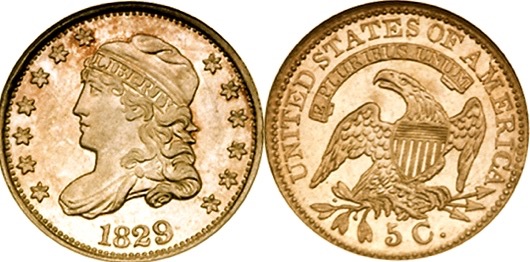
The Capped Bust Half Dime series was produced from 1829-1837 . The half dime, or half disme, was a silver coin, valued at five cents, formerly minted in the United States.These coins were much smaller than dimes in diameter and thickness, appearing to be "half dimes". The high circulating mintage in the series was in 1835, when 2,760,000 were struck, and the low of 871,000 was in 1837. Both Capped Bust and Liberty Seated half dimes were minted in 1837. Minted from 1829 to 1837 at the Philadelphia Mint with the following specs: Composition/Weight -1.35 grams, .8924 Silver and .1076 Copper. Diameter: 15.5 mm. Reeded edge. Designer: William Kneass
Currency Note of the Month.

This note is the famous $1 "Black Eagle" Silver Certificate – Series 1899. The vignette on this note is titled “Eagle of the Capitol”, but it is nicknamed "Black Eagle." The vignette depicts a large black eagle standing on a flag in front of the Capitol building with portraits of Lincoln and Grant beneath the denomination on the face. An engraved design with an obligation is on the back. The note shown is from Series 1899, and has a blue seal and serial numbers. There are 3 varieties of this note depending on the location of the series date and also 9 different combinations of Register/Treasuer facsimile signatures. Engraved by G.F.C. Smillie.
Book Recommendation

This month I decided to recommend a book that is a little outside of the boundaries of my usual informational volumes. The title of the book is “A Twisted Tale of Cover Up and Deceit”and it was written by Richard Kelly and Nancy Oliver. The book is part detective story and part historical novel and tells the tale of the theft of over $150,000 in gold from the first San Francisco Mint. This occurred in 1856 and it would have been multiples of the entire annual payroll of the Mint. Obviously a theft of this magnitude could only have been perpetrated by someone in a position of trust: a Mint Officer. I am not going to continue giving away any more of the story, because it is a fascinating read, other than to say that the theft appears to have been solved by the end of the book. An excellent fall read and well worth the effort! (Only available by purchase from the writers at noliver@sbcglobal.net for $23)
NUMISMATIC AND HISTORICAL QUESTIONS AND FACTS (AUGUST)
Q. Was any coin denomination produced at all the mints?
A. $5 gold pieces have been produced in various varieties and types since 1795. Commemorative and Bullion $5 coins have been produced at the West Point Mint since 1986 and 1994 respectively, thus, this is the only U.S. denomination made at each of the eight mints. (A Guide Book of United States Coins, R.S. Yeoman, 2008)
Q. Where was the first gold rush in the United States?
A. The Carolina Gold Rush, the first gold rush in the United States, followed discovery of gold in North Carolina in 1799. However, it was not until a few years later that word of the gold spread and men started coming to North Carolina from other states. In 1799 young Conrad Reed found a 17-pound shiny rock while playing at a creek on his family farm in Cabarrus County, North Carolina. He and his family kept it as a doorstop until 1802 when his father, John Reed, took the rock to a jeweler who recognized it as gold and bought it from the unaware Reed for $3.50 (a week's wages for farm labor.) A year later Peter, one of the slaves held by the Reed family, found a 28-pound nugget of gold on the property. John Reed started placer mining, and later underground mining, on his property and became a wealthy man. (Wikipedia)
Numismatic Fact: According to the Japanese Currency Law, a maximum of 20 coins of the same denomination can be used as legal tender. Rejection of the acceptance under 20 pieces of the same denomination is prohibited. In cases of over 20 pieces you can reject accepting the coins in daily transactions. However, the largest Japanese coin currently in general circulation is the 500 yen. With a value close to $5 each, 20 pieces would be would be almost $100 U.S.
Coin of the Month.
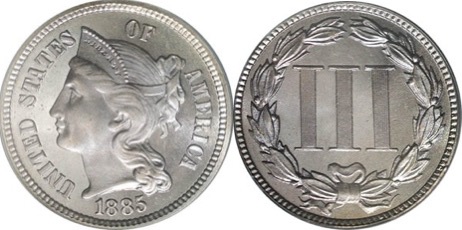
In 1865, the "Nickel" Three Cent coin was introduced, (the predominant metal in the coin was actually copper, but because the color was more whitish than brown, "Nickel" was considered a better descriptor). These were minted side-by-side with the silver version until 1873, when the silver type was discontinued. The nickel versions were minted until 1889, when the entire denomination was discontinued. There are 3 notable varieties and a number of low-mintage or Proof only years. Minted from 1865 to 1889 at the Philadelphia Mint with the following specs: Composition/Weight - 1.94 grams, .750 Copper and .250 Nickel. Diameter: 17.9 mm. Plain edge. Designer: James B. Longacre.
Currency Note of the Month.
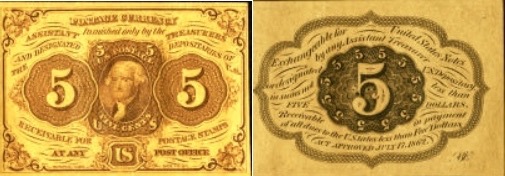
This is the first issue, Five-cent US Postal Currency, featuring Thomas Jefferson. Gold, silver and copper coins were hoarded at the start of the Civil War and postage stamps became a popular form of currency; however the adhesive back was a serious impediment. On July 17, 1862, Congress authorized printing of Postal Currency notes in the denominations of 5, 10, 25 and 50 cents. These notes could be redeemed for postage stamps or for a US bank note in the amount of five dollars or more. The Postal Currency was succeeded by Fractional Currency in 1863. The Post Office kept detailed records and 44,857,780 5c notes were printed from August 21,1862 to May 27, 1863. The note is 2.5 by1.75 inches (63.5 by 44.5 mm). The notes were printed on sheets of 20 and initially perforated like stamps. Later versions omitted the perforations and the notes were cut with a scissors. The front of the notes were engraved and printed with brown ink on yellow paper by the National Bank Note Company. The backs were engraved by the American Bank Note Company and printed by the American Bank Note Company and US government. There are 4 varieties of this note, perforated/non-perforated in conjunction with the presence or absence of the ABCO monogram as shown.
Book Recommendation
Ancient Coin Collecting (1996) by noted numismatist Wayne G. Sayles is a concise yet comprehensive introduction to the often passionate and rewarding hobby of collecting ancient coins. Basic information such as numismatic terms and their definitions, and the processes involved in how coins were made, is followed by descriptions of several ancient cultures and the coins commonly attributed to them. The author then spends considerable time to outline where to find ancient coins, how to buy them, what to avoid when considering a coin for purchase and lists numerous sources throughout the text for learning more about them. There is a very useful section on attribution, determination of authenticity, and finally, tips on beginning organized collections that will increase both in monetary and asthetic value with each addition. Although this book is titled volume I and five other texts are apparently to follow, Ancient Coin Collecting stands on its own and may be the only book of its kind necessary to spark a prolonged interest in this fascinating hobby and for some a lifelong pursuit and passion. (Review attributed to an unknown reviewer on amazon.com)
NUMISMATIC AND HISTORICAL QUESTIONS AND FACTS (JULY)
Q. I notice that most coin clubs start their meetings with the “Pledge of Allegiance”. What is the proper way of saluting the flag when this is done?
A. According to the “Flag Manufacturers Association of America” men and women should stand and salute the flag at the following times:
- At the moment the flag passes in a parade or review.
- Facing the flagpole during the ceremony of hoisting or lowering the flag.
- Facing the flag when the National Anthem is played. If the flag is not displayed, all those present should face toward the music.
- During the saying of the Pledge of Allegiance.
Men should remove their hats with the right hand and hold it at the left shoulder, with the hand being over the heart. Women and men without hats should place the right hand over the heart. Women are not required to remove their hats. Those who are not US citizens should simply stand at attention.
Current flag protocol allows veterans to salute the flag as military personnel do, with a military-style hand salute, if they choose. If veterans prefer, they may hold their right hand over their heart, as civilians do.
Q. What is a Higley copper?
A. Higley coppers are copper pieces the size of a half-penny and are believed to have been made by Dr. Samuel Higley. He owned a copper mine in Simsbury, Connecticut which opened in 1727 and produced copper ore that was used both locally and exported to England. The coppers come in 2 types, ones marked with a value of threepence and others marked “Value me as you please. I am good copper”. Dr. Higley perished in a shipwreck in 1737 but his brother continued to produce the coppers for approximately 2 more years. Highly collectible, even damaged tokens sell for $25,000 and up, and one of the best examples recently sold for $470,000!
Historical Fact: "E Pluribus Unum" is used on many of our country's seals and most of our currency and coins. However, during the American Revolution, the Continental Congress issued a three-dollar bill bearing the motto, "Exitus in Dubio Est," which translates to "The Outcome Is in Doubt." Despite congressional pessimism about the war, John Adams, Ben Franklin, and Thomas Jefferson proposed the more prophetic motto, "E Pluribus Unum" -- "One From Many." The motto first appeared on the Great Seal of the United States in 1782. The Great Seal, however, didn't appear on U.S. currency until 1902. (http://www.dailyfinance.com)
Coin of the Month.
The Alabama centennial half dollar commemorative coin was minted to celebrate the centennial of Alabama's admission to the Union in 1819. This was the last slave holding territory admitted prior to the Missouri Compromise in 1820. This was also the first commemorative coin minted with the image of a living individual. These coins were first distributed on October 26, 1921 when President Warren Harding passed through Birmingham to help dedicate a new Masonic temple. They were then sold by banks throughout the state and were widely circulated during the Great Depression. The obverse depicts overlapping profiles of William Bibb, who was the governor in 1819, and Thomas Kilby, who was the governor in 1919. The 22 stars flanking the portraits indicate that Alabama was the 22nd state admitted to the Union. On some coins, there is a 2X2 in the right field with the X representing the St. Andrew's cross. Minted in 1921at the Philadelphia Mint with the following specs: Composition/Weight - 12.5 grams, .900 Silver and .100 Copper. Diameter: 30.6 mm. Reeded edge. Designers: Obverse-Laura Gardin Fraser, Reverse-Marie Bankhead Owen
Currency Note of the Month.
The Educational Series of notes is the informal nickname given by numismatists to a series of United States Silver Certificates produced by the United States Treasury in 1896, after Bureau of Engraving and Printing chief Claude M. Johnson ordered a new currency design. The $5 note depicts an allegorical motif titled “Electricity as the Dominant Force in the World” The obverse of the note depicts the neoclassical alle- gorical motif, with Electricity surrounded by other allegorical figures, representing the dominant force in the world. The United States Capitol building can be seen behind the female figures. The naked breasts of the female figures on the $5 Silver Certifi- cate reportedly caused some minor controversy when several Boston society ladies took offense to the design. Some bankers reportedly refused to accept the notes in transactions, and the term “banned in Boston” allegedly originates from the $5 Silver Certificate. In response the Bureau of Engraving and Printing prepared a "draped" bosom $5 vignette design for a proposed 1897 series. The redesign also included a highly modified front face but was never utilized.The back contains the profiles of Ulysses S. Grant and Philip Sheridan set against an ornate background. The front face was designed by Walter Shirlaw and Thomas Morris, the note engraver was George Smillie, and the vignettes of Grant and Sheridan were designed and en- graved by Thomas Morris and Lorenzo Hatch.
Book Recommendation
The book I’m recommending this month has been in print since the 1940’s (updated a number of times) and for collectors of large cents it is a must have. Of course , I am re- ferring to one of the original coin reference books titled “Penny Whimsy, A Revision of Early American Cents, 1793-1814: An Exercise in Descriptive Classification with Ta- bles of Rarity and Value” by Dr. William Sheldon. The book covers large cents for the years 1793-1814 and goes to great lengths to describe the different die varieties for these years and documenting them with a photo of each one plus a rarity rating for each. This book is a very detailed on the production of early cents and is an excellent histori- cal and early American economics reference. He is also the creator of the 1-70 condi- tion rating system for coins which is outlined in the book and still in use today. This book is not a price guide but a research book with the large cent being it’s total focus and is indispensable for large cent collectors.
NUMISMATIC AND HISTORICAL QUESTIONS AND FACTS (JUNE)
Q. What is “clam shell” money?
A. There was a shortage of coins and banknotes throughout much of the united States when in March 1933, President Franklin D. Roosevelt closed all U.S. Banks in what he called a bank holiday. Merchants in Pismo beach, Calif., began issuing scrip written on clam shells to make change. (Coin Clinic, R. Giedroyc, 20 May 2104)
Q. What is a “five-shilling dollar”?
A. Over a period of years, during the reign of George III, a coin shortage had been developing in England. As the shortage increased, the people started to panic and took every opportunity to hoard any money containing gold or silver. This, of course, only made the situation worse. By 1798 it was so acute that the British government, through the Bank of England, bought Spanish and Spanish-American eight-reale pieces (silver dollar sized) which pictured the Spanish king, counter-stamped them with a small head of George III,and then announced that they had a value of 4 shillings nine pence. By 1890 the price of silver rose and the coins had to be revalued at 5 shillings. Using coins of an ofttimes enemy was repugnant to the citizenry, who composed the following jingle:
“To make the dollar of Spain for five shillings to pass, Stamp the head of a fool on the neck of an ass”
Whether or not this ridicule of the king had any effect, complete dies were prepared, dated 1804, and the Spanish pieces were completely overstruck with an obverse de- sign showing a bust of George III and the reverse design reading in part “Bank of England Five Shilling Dollar.” On most pieces some details of the original Spanish coin can still be seen.
Historical Fact: In 1951 the Hemet Police Department consisted of 6 Officers with Chief of Police Cecil W. Walsh and Capt. Nash Terrones in charge. The Hemet News printed in 1951 “a six man police force maintains the peace of the town, and this is provable by the virtual immunity Hemet enjoys from major crime.” Hemet’s population in 1951 was 3,386. (Images of America-Hemet)
Coin of the Month.
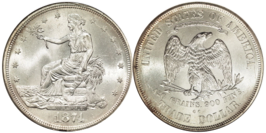
The trade dollar was a United States dollar coin minted to compete with other large silver coins that were already popular in East Asia. The idea first came about in the 1860s, when the price of silver began to decline due to increased mining efforts in the western United States. The Coinage Act of 1873 made trade dollars legal tender up to five dollars. The coins were first struck in 1873, and most of the production was sent to China. Eventually, bullion producers began converting large amounts of silver into trade dollars, causing the coins to make their way into American commercial channels. This caused frustration among those to whom they were given in payment, as the coins were largely maligned and traded for less than one dollar each. In response to their wide distribution in American commerce, the coins were officially demonetized in 1876, but continued to circulate. Because of its demand by collectors a large number of counterfeits exist made with base metal, and buyers should exercise caution when purchasing specimens. Also, many of the trade dollars that circulated in the Orient were counter-stamped with oriental characters called “chop marks” and these are generally less valued than normal pieces. Minted from 1873 to 1885 at the Phil- adelphia, Carson City, and San Francisco Mints with the following specs: Composition/Weight - 420 grains, .900 Silver and .100 Copper. Diameter: 38.1 mm. Reeded edge. Designer: William Barber.
Currency Note of the Month
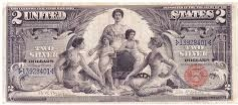
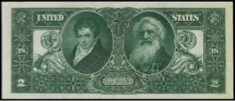
The Educational Series of notes is the informal nickname given by numismatists to a series of United States Silver Certificates produced by the United States Treasury in 1896, after Bureau of Engraving and Printing chief Claude M. Johnson ordered a new currency design. The $2 note depicts an allegorical motif titled "Science presenting steam and electricity to Commerce and Manufacture” The obverse of the note depicts the neoclassical allegorical motif, with Science (center) presenting Steam and Elec- tricity (the two children) to the more mature figures of Commerce (left) and Manufac- ture (right). The back contains the profiles of Robert Fulton and Samuel F.B. Morse set against an ornate background. The front face was designed by Edwin Blashfield and Thomas Morris, the note engravers were George Smillie and Charles Schlecht, and the vignettes of Fulton and Morse were engraved by Lorenzo Hatch.
Book Recommendation
I will apologize in advance for this month’s book recommendation as it is not about numismatics and will be of only limited interest to non-club members. The book I am going to recommend is titled “Images of America-Hemet Edition”. This book is one of a series of books detailing the history and development of local towns and areas of southern California. The Hemet edition is extremely well illustrated, with every page having at least 1 photo of a historical location or influential person of early Hemet. While the book is attributed to the Hemet Area Museum Association, the actual contents are a compilation by Bob Norman, Mary Whitney, and Gordon Sisk. If you want to know the history of the town of Hemet, this is the book to read.
NUMISMATIC AND HISTORICAL QUESTIONS AND FACTS (MAY)
Q. How much did Louis E. Eliasberg spend to assemble his famous collection of coins?
A. Louis E. Eliasberg, (The King of Coin Collectors), is known as the only individual, (so far), to ever assemble a complete set of U.S. coins, with regular-issue coins of every denomination from every date they were issued and every mint that made them in those years. This accomplishment was not a result of simply having enough wealth to buy any coin he wanted, but was due to his shrewd purchasing and tough bargaining. During the 16 years it took to complete the collection, (1934-1950), Eliasberg spent less than $400,000. When the collection was dispersed, at a series of auctions between 1982 and 2005, it realized a grand total of approximately $55 million-more than 100 times what it had cost. (Coin Capsule, E. Reiter, Jan. 2014)
Q. I have an early American obsolete banknote that indicates that it is “Payable on Demand to Daniel Webster or the Bearer.” Does it being associated with Daniel Webster increase the value or rarity of the note?
A. In the early days of U.S. Banking most banks were private entities and were not associated in any way with the government. So, in a number of instances, banknotes were embellished like this to impart the notion that the person named, (generally, a famous individual), was associated with the bank. Usually the named person had no idea that his name and reputation was being used this way. This technique and the use of bank names associated with reliability and strength gave the impression that a particular bank was solid. However, as banks came and went (i.e. failed), the general solution for the average citizen was to not accept paper money from any bank more than 10-20 miles away.
Historical Fact: Those that have either read General Lew Wallace’s book “Ben Hur” or saw the movie adapted from the book, may remember the betting on the chariot race. The wealthy Romans wagered one or more gold “talents”. At a time when coinage was in its infancy, many of the commercial transactions were completed in gold or silver by weight. The dictionary defines a talent as a unit of weight with a minimum of 58 pounds. The current open market price per ounce of gold is approx. $1300 meaning that one talent of gold would be worth $1,206,400. Thats quite a wager on a chariot race!
Coin of the Month.
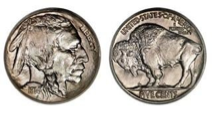
The Buffalo nickel or Indian Head nickel was a copper-nickel five-cent piece struck by the United States Mint from 1913 to 1938 and was designed by sculptor James Earle Fraser. In 1911, Taft administration officials decided to replace Charles E. Barber's Liberty Head design for the nickel, and commissioned Fraser to do the work. They were impressed by Fraser's designs showing a Native American and an American bison.Despite attempts by the Mint to adjust the design, resulting in Type 1 (Bison on a mound) and Type II (Bison on a plain) varieties, the coins proved to strike indistinctly, and to be subject to wear—the dates were easily worn away in circulation. In 1938, after the minimum 25-year period during which the design could not be replaced without congressional authorization had expired, it was replaced by the Jefferson nickel designed by Felix Schlag. Minted from 1913 to 1938 at the Philadelphia, Denver, and San Francisco Mints with the following specs: Composition/Weight - .750 Copper .250 nickel. Diameter: 21.2 mm. Plain edge. Designer: James Earle Fraser.
Currency Note of the Month.

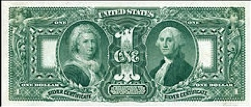
The Educational Series of notes is the informal nickname given by numismatists to a series of United States Silver Certificates produced by the United States Treasury in 1896, after Bureau of Engraving and Printing chief Claude M. Johnson ordered a new currency design. The $1 note depicts an allegorical motif titled "History instructing Youth”. The obverse of the note depicts the neoclassical allegorical motif, which dominates the front of the note. The back contains the profiles of George and Martha Washington set against an ornate background. The term "Educational" is derived from the title of the vignette on this $1 note, "History Instructing Youth". The front face was designed by Will H. Low, the note engraver was Charles Schlecht, and the vignettes of Martha and George Washington were engraved by Charles Burt and Alfred Sealey, respectively.
Book Recommendation
I am going to go out on a limb with this months Book recommendation and recommend a book that I have only recently ordered and not yet read. The name of the book is “Wampum and the Origins of American Money” written by Marc Shell. The following book description is provided courtesy of the February issue of “The Numismatist” with a review by Kendra Johnson. This should be a really interesting read for those interested in Early Americana.
Marc Shell, Irving Babbitt professor of Comparative Literature at the University of Illinois, presents an in-depth analysis of wampum and its many uses . The book contains more than 100 photographs and illustrations exploring the economics, literature, and racial and ethnic imagery of American money. Interweaving the multiple functions of wampum with Early American language, art, culture, and conflict negotiation, Shell unveils this currency’s influence on the founding of this nation.
NUMISMATIC AND HISTORICAL QUESTIONS AND FACTS (April)
Q. What is the difference between a “doubled die“ coin and a coin that is “doubled” and do both bring a premium as an error?
A. A double-die coin is a coin produced from a working coinage die on which the image itself is doubled. A coin displaying doubling can be produced from a die that has no doubling due to a momentary production problem , the coin having been struck more than once, creating a doubled image or machine doubling damage. Collectors tend to place much more value on a doubled die coin than a double struck coin. Every coin struck from the doubled die will display that doubling, while a double struck coin may be the only one. (Coin Clinic, R. Giedroyc, Mar. 2014)
Q. What are “Giori” notes?
A. In 1973, the U.S. Department of Engraving and Printing did some testing in Germany on new type of printing press called a Giori press. Various front and back vignettes and designs were printed on a large quantity of notes of various paper types. No complete notes were ever printed. When the testing was done the incomplete experiments were sold to an American collector who in turn sold them to U.S. dealers. There is a small dedicated group of collectors of these notes and also rumors of a forthcoming book cataloging these notes.
Historical Fact: The Fugio cent is recognized as the first U.S. Government coin and was produced when the Continental Congress contracted with James Jarvis to strike them. However, of the 32 tons of copper provided to Jarvis at bargain rates, only 4 tons was actually used to produce Fugio cents. The rest was diverted into making Connecticut state coppers, a much more profitable endeavor.The government eventually won a $10,842 judgement against Jarvis but was never able to collect it.
Coin of the Month.

The Kennedy half dollar is celebrating it’s 50th Anniversary this year and there are rumors from the U.S. Mint that as many as 3 different varieties may be issued this year. These will be in addition to the usual issues in the yearly Proof and Mint sets. Current reports indicate that a proof gold version, a silver version, and a copper-nickel version will be produced although product configurations, mintage, and pricing details have not yet been released. The Kennedy half was originally created as a commemorative piece after President kennedy was assassinated in 1963 and was released in 1964. It has had 3 different compositions since it’s release and has also had numerous updates to its design including a different reverse for it’s inclusion as a Bi-centennial release.
Minted from 1964 to the present at the Philadelphia, Denver, and San Francisco mints with the following 3 types: Composition/Weight - .900 Silver and .100 Copper/ 12.5 grams, .750 Copper and .250 Silver Clad/11.50 grams, and .750 Copper and .250 Nickel/11.43 grams. Diameter: 30.6 mm. Reeded edge. Designers: Gilroy Roberts (Obverse), Frank Gasparro (Reverse), and Seth Huntington (Bi-centennial Reverse).
Currency Note of the Month.

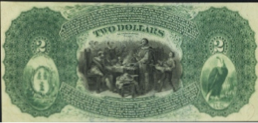
Collectors call 1865 $2 bills “lazy deuces”. The nickname derives from the fact that the large two on the front of each bill is laying on its side. At some point someone used the term “lazy deuce” and it stuck. The vignette at left is titled “Stars and Stripes” and is the work of engraver Luigi (Louis) Delnoce (1822-90). Delnoce studied with John W. Casilear in the early 1850s. He later went on to instruct Marcus W. Baldwin and Daniel F. Caughlan. His son, Louis, Jr., followed in his father's footsteps.
The vignette at center on the back is Sir Walter Raleigh Presenting Corn and Tobacco to the English (there are several variations of the title). That piece was also the work of Delnoce. Another appealing aspect of the design of the notes is that the state or territorial seal of the issuing bank was included within an oval frame on the back at left.
The two dollar national bank note was discontinued in 1878, so that leaves just a thirteen year production period. Most 1865 two dollar bills are very scarce today. The most common examples in poor condition are worth around $1,000. Examples from rare banks or bills that are in perfect condition are worth and sell for several thousand dollars or more. Even if a bank was open in 1865 it didn’t necessarily print two dollar bills. There were plenty of dollar coins circulating in the 1860s, so a lot of national banks didn’t bother to print one and two dollar bills because the need was already being satisfied by coinage. Even if a bank did choose to print 1865 two dollar bills, they were still only printed at a rate of one two dollar bill for every three one dollar bill. Most banks that did print $2 bills almost always issued less than 10,000 examples over the entire life of the bank. You can see why some are so rare and valuable today! (AntiqueMoney.com)
Book Recommendation
It’s been a couple month’s since I did a recommendation for a currency book, so this month’s book is titled “Collecting Paper Money for Pleasure and Profit” by Barry Krause. This book is older and probably out of print, (copyright is 1992), but I picked up a copy in my travels and find it to be a very practical guide for the beginning paper money collector. It covers a large variety of paper money collecting specialties and provides a great deal of information about the storing and grading of paper money. It also covers where and how to purchase notes and sources for notes. It has excellent references pertaining to museum collections and getting information about the background of specific note types and collecting of paper money. A good choice for the novice paper money collector or the person interested in collecting paper money but not sure where to start.
NUMISMATIC AND HISTORICAL QUESTIONS AND FACTS (March)
Q. I just started collecting currency and was warned to learn to recognize and identify "pressed" notes. What are "pressed" notes?
A. "Pressed" notes are notes that have had their appearance and paper quality artificially improved by using weight or heat or a combination of the two. This is usually done with an iron or even just pressing them in a heavy book. Also, sometimes starch or chemicals will be used in conjunction with heat in an attempt to remove folds, particularly corner folds, and also add crispness to the paper thus making the note appear to be of better quality than it really is. However, currency folds are difficult to totally disguise and can usually be detected by examining the note with a bright light background. Also, check the note on edge for paper waviness or wrinkling as a sign that it may have been pressed. Last, and this will sound strange, smell the note. Some agents used for pressing will leave a chemical smell that can be detected. As the popularity of currency collecting increases, note "doctoring" is becoming more of a problem.
Q. Was a murder ever commemorated on a coin?
A. Everyone knows of the assassination of Caesar by Brutus and Cassius on March 15th, 44 B.C. (The Ides of March). In the following year , Cestianus, a soldier under Brutus, had denarii (silver pennies) struck to commemorate the event. To their followers, Brutus and Cassius were not murderers but saviors. The obverse of the coin shows Brutus and the reverse shows a liberty cap or piles in the center with daggers on each side. Below are the Latin words “Eid Mar”. The coin is a rarity in the Roman series and many counterfeits exist.
Historical Fact: While we all bemoan the price of postage increasing, there actually was an instance where the price of postage went down! Prior to 1851, mailing a letter up to 300 miles cost 5 cents and double that for greater distances. That year rates were reduced to one cent to mail a letter locally and three cents to mail it up to 3,000 miles. This provided the impetus for the creation of the short lived 3 cent coin. In 1883, the distance postage rate was further reduced to 2 cents where it stayed until 1917.
Coin of the Month.

This month we have the Seated Liberty Half Dime. Minted in 4 major varieties, the first variety does not have stars on the obverse, the second added stars to the obverse (shown), the third added arrows beside the date to indicate a reduction in weight, and on the fourth the legend was moved from the reverse to the obverse. The third variety was only minted for 3 years before the previous weight was restored . Minted from 1837-1873 there are also many overdates plus numeral, mintmak, and drapery design variations through the years. Minted at the Philadelphia, New Orleans, and San Francisco Mints with the following specs: Weight-1.34 (Var. 4 1.24) Grams. Composition: .900 Silver and .100 Copper. Diameter: 15.5mm. Reeded Edge. Designer (all varieties) - Christian Gobrecht
Currency Note of the Month.
Last month as part of Jerry and Mary Ann’s excellent presentation on the dollar bill, there was some discussion on why there were different colors of seals and what they designated. So, here is the short version of what the different seal colors indicate with thumbnail pictures of the various notes! Seal colors indicate specific types of notes as follows:
Green seals are used on the familiar Federal Reserve Notes that are in daily use.
Red seals designated United States Notes issued directly by the U.S. Government rather than the Federal Reserve. These notes were issued from 1862 to 1971.
Blue Seals were used on silver certificates. These were backed by physical silver held by the U.S. Treasury. They were issued from 1878 to 1957.
Gold seals were used on Gold certificates and were also backed by physical gold. They were issued from 1863 to 1933. (Issued in $10 notes or larger only).
Yellow seals are actually a sub-set of the Silver Certificate issues. They were an emergency issue for use by the military in North Africa during WWII. This allowed for their cancellation in the event of enemy possession.
Brown seals are seen on 3 different issues. They were first used on National Bank notes ($% notes or larger) and were issued by individual chartered banks from 1863 to 1935. They were also used on a Federal Reserve note emergency issue in 1933 during the Great Depression. Lastly, they were used on emergency issues of Silver Certificates and Federal Reserve notes issued during WWII for circulation in Hawaii and the Pacific Theatre. Again, this allowed for cancellation in the event of enemy possession. They were issued from 1942 to 1945.
I’ve included some examples below (Not all types are shown):
(Thanks! to Mary Ann Bodenhorn for providing information on Treasury seals and their issues.)






Book Recommendation
My book recommendation for the month is a Whitman book titled “A Guidebook of Modern United States Proof Coin Sets”. Written by David Lange with a forward by Q. David Bowers, it is guide to the proof sets from 1936 to 1942 listed as vintage sets and then continues with proof sets produced when production recommenced in 1950. The book lists the number of sets produced and an estimate of the number of intact sets left. It also provides estimated values for both uncertified and certified sets with illustrations of complete sets in their original packaging. The initial sections gives tips on collecting and storing the sets and in the back sections it has (in color) the different types of packaging and mailing material for various proof sets. An informative book for those that appreciate the precision of proof type coins and collect them.
(Editors Correction: One of our sharp-eyed members noted that in last months issue. I had indicated as part of my review of “National Bank Notes” that the Federal Reserve System was created in 1928. That is incorrect, the Federal Reserve System was created on Dec. 23, 1913 with the enactment of the Federal Reserve Act.)
NUMISMATIC AND HISTORICAL QUESTIONS AND FACTS (February)
Q. What are Commutation Money receipts?
A. The first Federal drafts occurred during the Civil War. Draftees were given the options of fulfilling their service obligation, providing a substitute, or paying a fee of $300 fee to avoid service. The high cost of the fee meant that only the rich could avoid the draft. This, along with general anger toward the draft, led to the bloody New York City draft riots in 1863, when mobs took over parts of the city in the worst civil disturbance in the history of New York. Commutation Money receipts showed that the person had paid the fee to avoid the draft. The fee was a cheaper alternative to providing a substitute which reached the price of $2,000 at one point. (Bank Note Reporter, Aug. 2013)
Q. Was P.T. Barnum, (the famous circus showman), ever on a U.S. coin?
A. P.T. Barnum was pictured on a 1936 U.S. Commemorative coin celebrating the 100th Anniversary of the incorporation of the city of Bridgeport, Conn. Barnum was the city’s most distinguished citizen and it’s one-time Mayor. Congress authorized 25,000 fifty cent pieces and examples currently sell for $100-$200 in uncirculated condition
Historical Fact: The Chisholm Trail, named for trader Jesse Chisholm, ran from feeder trails in Texas to stockyards and the railhead at Abilene Kansas. Chisholm blazed a wagon trail between a post at the mouth of the Little Arkansas River to the Red River in the Indian Nations. This trail was first traversed by cattle in 1867 and eventually the entire trail was named for him. By the time the trail was about played out in 1884, cattlemen had used it to move more than 5 million head of cattle and over 1 million head of mustangs - the greatest migration of livestock in American history.
Coin of the Month.

Minted from 1865-1889 the 3 cent pieces struck in nickel were designed to replace the silver 3 cent pieces. The pieces were only struck as proofs in the years ’77, ’78, and ’86. There are also 2 types of varieties. Minted only at the Philadelphia Mint with the following specs: Weight-1.94 Grams. Composition: .750 Copper and .250 Nickel. Diameter: 17.9mm. Plain Edge. Designer (all varieties) - James B. Longacre.
Bill of the Month.
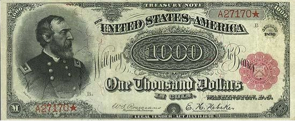
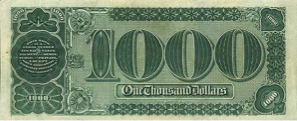
This month I am starting a new informational section similar to the Coin of the Month section. I will give background information on a particular currency note and, if possible, provide a photo image of the note. This month, I thought it would be appropriate to present this particular note since it just sold on January 10th for $3.29 million making it the most ever payed for a currency note! The note is an 1890 $1,000 Treasury bill and is the only one, of 2 known, in private hands. It gets it’s nickname “Grand Watermelon” from the denomination and the design of the “zero’s” on the reverse. The bust on the face is of General George Mead, commander of the Union troops at the Battle of Gettysburgh. Treasury notes were redeemable in actual coin but whether gold or silver should be paid out was left to the discretion of the Secretary of the Treasury. It has facsimile signatures of Rosecrans (Register of The Treasury) and Nebeker (Treasurer of the United States).
Book Recommendation
“National Bank Notes” by Don C. Kelly is this month’s book selection. This is a reference book with statistics and information related to all of the issues of National Bank notes. Prior to the establishment of the Federal Reserve system and the creation of the Federal Reserve note in 1913, individual banks were given a charter number by the federal government and the individual banks printed their own banknotes. This book identifies the banks, their charter numbers, the amount and types of notes they issued, and a census figure of the notes that still exist. There were over 12,000 charters issued so the number of entries and the research involved in collecting this information is staggering! The book is almost 600 pages long but the information presented is vital for collectors of National Bank notes. As can be imagined, this book is not cheap. New copies are about $90 and used copies can be had for around $50.
NUMISMATIC AND HISTORICAL QUESTIONS AND FACTS (January)
Q. How much would $1,000,000 dollars in Morgan silver dollars weigh
A. The amount would weigh in at a total of 71,643 troy pounds (a system used to weigh precious metals at 12 oz’s to a pound) or 58,930 avoirdupois pounds (the system used to measure everyday items with 16 oz’s to a pound). (Numismatic News, R. Giedroyc, Dec. 24 2013)
Q. With the discussion to eliminate paper dollars and replace them with a dollar coin in full swing, how many dollar coins do we currently have sitting unused in the Federal Reserve inventory?
A. According to a recently released General Accounting Office report, the Federal Reserve has 1.4 billion dollar coins in inventory, which it believes is enough to last for the next 40 years. Currently, the U.S. Mint is only minting dollar coins for sale to collectors and not for circulation. In 2014 we will see the release of 4 new Presidential $1 coin designs.
Historical Fact: Grover Cleveland first served as President from 1885 to 1889 when he was succeeded by Benjamin Harrison. Cleveland actually won the popular vote in the1889 election but Harrison prevailed in the Electoral College. In 1893 Cleveland was re-elected making him the only President that has served 2 terms unconsecutively.
Coin of the Month.

The Jefferson 5c nickel piece is one of the most popular and affordable of all U.S. coins. Designed by Felix Schlag, he was the design contest winner from some 390 submissions. His design established the definite public approval of portrait and pictorial themes rather than symbolic devices on our coinage. Minted from 1938 to 2003 at the Philadelphia, San Francisco, and Denver Mints. Minted in 35% silver composition (noted by a large mintmark on the reverse) from 1942-1945. Specs for the non-silver issue is Composition: .750 Copper and .250 nickel. Silver issue is .560 Copper, .350 Silver and .090 Manganese. Diameter: 22mm. Weight-5 Grams. Plain Edge.
Book Recommendation
This month marks 3 years of book recommendations from this editor and this month I am selecting a book for an area of collecting that I don't actively pursue. The book is titled the “Official Price Guide to Mint Errors” authored/edited by the late Alan Herbert. The book is currently in its seventh edition and it provides a concise method of cataloging the various types of coin minting errors. It also provides a listing of all known types of existing errors with suggested retail pricing. Due to recent changes in the minting and distribution of freshly minted coinage, error coins are becoming more difficult to obtain, so this area is one to watch and the information in this book will be very useful.
NUMISMATIC AND HISTORICAL QUESTIONS AND FACTS (December)
Q. Was the buffalo on the Indian Head 5 cent piece modeled from an actual animal?
A. The buffalo on the “buffalo nickel” five cent piece was an artist’s rendition of “Black Diamond”, actually a bison on exhibit at the New York Central Park Zoo in the early 20th century. He was the offspring of a pair of bison donated to the zoo by the Barnum Circus so he never actually roamed the plains. After an ignonimous end in 1915, (he was sold to a slaughterhouse), his head was saved and mounted. In 1985 it was displayed on the bourse floor of the American Numismatic Association convention held in Baltimore. (Coin World, G. Tebben, Oct. 2013)
Q. What is a cancellation hammer?
A. It is a special hammer used to cancel paper monetary instruments, usually banknotes or checks. When private banks issued their own currency, they needed a way to easily and reliably cancel the worn currency and/or counterfeits that they encountered. The typical cancellation hammer was designed to cut a large “X” or, in some cases, holes or half-moon shaped pieces, into the note thus rendering the note unpassable. There are a number of cancelled obsolete notes showing a variety of these type of hammer cancellations.
Historical Fact: According to legend, one Arizona cattle ranch earned the unsavory reputation of having the “thievinist, fightinest bunch of cowboys in the United States.” The Aztec Land and Cattle Company was organized in 1884 when is shareholders bought a million acres at 50 cents an acre in northern Arizona. With its headquarters at Holbrook, the ranch was 90 miles long and 40 miles wide. It was better known as the Hash Knife Outfit, since its brand resembled the type of knife cowboy cooks used to cut vegetables - the hash knife. Although the ranch is long gone, the Navajo County Sheriff’s Hashknife Posse proudly carries the name and the brand into the present day. (True West, Dec. 2012)
Coin of the Month.
The Seated Liberty Twenty Cent piece was a short-lived coin series. Authorized by the Act of March 3rd, 1875 it was only produced from 1875 to 1878. Soon after their first appearance, people complained that they were too similar in size and design to the quarter dollar. The mint mark is positioned on the reverse below the eagle. Only 1,315,140 total were minted at the Philadelphia, Cason City, and San Francisco Mints. Specs: Weight-5 Grams. Composition: .900 Silver

Book Recommendation
While it may not be something many of us want to think about , this book deals with how our heirs might dispose of our collecting efforts. The name of the book is “Cash In Your Coins: Selling The Rare Coins You’ve Inherited”. I’ll defer to the Amazon description of the book since they do it so much better than me! “Cash In Your Coins is for anyone who's inherited a collection (or hoard) of old coins. How rare are they? What are they worth? Should you sell? Where do you even begin? Your guide on this journey is Beth Deisher, an award-winning journalist and retired editor of Coin World, the hobby's premier news weekly. Drawing on more than 30 years of experience helping people understand and collect coins and paper currency, Deisher shows you how to identify what you own, how to create and inventory, how to pick out extra-valuable coins, how to value a large estate, "talking the talk" when you go to sell, the effect of the "fiscal cliff" and recent estate- and tax-related legislation, and other important and valuable lessons.” While this book is actually designed for the person that has inherited a collection, it is also very helpful in organizing what you currently have. An excellent book for your collecting library and your heirs may appreciate your efforts later!
NUMISMATIC AND HISTORICAL QUESTIONS AND FACTS (November)
Q. What are the meanings of the latin phrases on the dollar bill?
A. There are 3 latin phrases on the dollar bill. The most recognized is the phrase “E Pluribus Unum" translated as “Out of Many, One.” The second phrase is “Annuit Coeptis” meaning “God (or ‘He” or ‘Providence’) Has Favored Our Undertakings”. The third phrase, “Novos Ordo Seclorum” on the Great Seal means “New Order of the Ages”
Q. Did the United States ever experiment with holed coins?
A. The U.S. struck patterns for perforated coins in 1849, 1850, 1851,1852, 1884, and 1885. The center holes were of 3 types, round, square, and denticulated. The denominations were 1 and 5 cents, a gold half-dollar, and a gold dollar. Of the 13 holed pattern types on record, six were for one cent pieces, two for five cent pieces, one for a gold half-dollar, and four for gold dollars. (Coins: Questions and Answers. C. Mishler)
Fact: On October 17th 1814, beer became deadly in London when a a huge 20 foot vat containing 135,000 imperial gallons ruptured at the Meux and Company Brewery and a domino effect caused others to do likewise. More than 320,000 imperial gallons -nearly 1.5 million liters- of beer surged into nearby streets and flooded neighborhood homes in the impoverished St. Giles section of central London, where whole families lived in basement rooms. Those rooms quickly filled with beer and two homes were destroyed. Eight people drowned in this “London Beer Flood” and one person died the next day of acute alcohol poisoning. The incident was blamed on metal fatigue in the 29 hoops wrapped around the vat, which caused them to snap, one by one, until the vessel burst, producing an explosive sound heard five miles away. Nonetheless, a judge and jury ruled the disaster an act of God and the brewery was permitted to resume operations. (Coinage, Coin Capsule, Al Doyle: Sept. 2013)
Coin of the Month

The “Flying Eagle” cent was provided for by the Act of February 21st 1857 as a replacement for the large half-cents and cents that were currently circulating. Produced as a pattern in 1856 they were so popular that production continued thru 1858 when they were replaced with the Indian Head cent. Since the 1856 production was a pattern only 1500 to 2000 of that date were produced making them a rare date. During the period of 1857 and 1858, over 42 million were produced. There are many varieties including overdates and and large and small letter types. Minted only at the Philadelphia Mint. Specs: Weight-4.67 Grams. Composition: .880 Copper and .120 Nickel. Diameter: 19mm. Plain Edge. Designer- James B. Longacre.
Book Recommendation
This time I am recommending a book that I currently don’t even own in its new revision. The book is the Eighth Edition of the “Coin World Almanac” by The Editors of The Coin World Staff. I currently have the Sixth edition and this book, while having the same title, is a total revamp of the old info and has also added condensed versions of all the coin and currency news of the last 10 years all in one ready reference. The book is over 700 pages long with ready references to all U.S. and world coinage plus background info on Mints, numismatic law, key monetary and mint personages, bullion info, and just about anything related to the coins, currency, people,and facilities of all the Mints of the world. My review does not even come close to describing the depth of information in this guide but if you are interested in coins this will entertain and educate you for a long time. (I am going to order this book shorty for myself and if anyone wishes to purchase a copy at the same time Ill be happy to add additional copies to my order-Jim)
NUMISMATIC AND HISTORICAL QUESTIONS AND FACTS (October)
Q. Have Morse Code symbols ever been used on a U.S. coin or currency?
A. Morse code was used on the WWII 50th Anniversary $5 Commemorative coin. The symbol dot-dot-dot-dash (meaning “V” for Victory) was used on the reverse. Also, Samuel Morse, (the inventor of the telegraph and Morse code ) is portrayed on the reverse of the 1892 $2 Silver Certificate. (The Numismatist, World Currency, T. Uram, May 2013)
Q. Why was the silver in the half dollar reduced but not eliminated in 1965?
A. The silver in the half dollar was reduced from 90 to 40 percent in 1965 as a result of a political compromise between Congress and President Lyndon B. Johnson. This compromise resulted in the Coinage Act of 1965. The 1965 to 1970 half dollars have an outer layer of .800 fine silver bonded to an inner core of .210 percent silver, resulting in a purity of 40% silver composition. (Coin Clinic, R. Giedroyc. Oct. 1 2013)
Fact: The famous song “The Battle of New Orleans”, written by Johnny Horton in 1959, is a lighthearted musical version of the final battle of the War of 1812. The actual battle should never taken place, however! The Treaty of Ghent that ended the War of 1812 was signed on Christmas Eve, 1814 but due to the poor communication systems at the time the Battle of New Orleans took place on Jan 8th 1815! On that date, Andrew Jackson’s U.S. forces routed the British despite being outnumbered 3 to 1 due to their deadly and accurate fire.(Coinage, Coin Capsule:1814, A. Doyle, Sept. 2013)
Coin of the Month
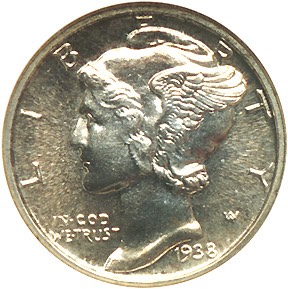
Commonly called the “Mercury Dime” the obverse design is a actually a depiction of Liberty. The wings crowning her cap are intended to symbolize liberty of thought. Produced from 1916 to 1943, they are a very popular collector choice. Rare dates in this series include the 1916-D (only 264,000 minted), the 1921 and 1921-D, plus there are 2 rare 1942 overdate varieties. Minted at the Philadelphia, Denver, and San Francisco Mints. Specs: Weight-2.50 Grams. Composition: .900 Silver and .100 Copper. Diameter: 17.9 mm. Reeded Edge. Designer- Adolph A. Weinman.
Book Recommendation
A few months ago the book recommendation was “100 Greatest U.S. Coins”. This month I am recommending it’s sister book the “100 Greatest American Currency Notes: The Stories Behind The Most Colonial, Confederate, Federal, Obsolete, and Private American Notes”. Written by David M. Sundman and Q. David Bowers, it is a collection of full-color photo’s and information about America’s best known, most collectible, and most sought-after issues of paper money. Lavishly illustrated, it also contains background information on the people that created the notes and the circumstances at the time of their creation. A must have for any currency collector or anyone interested in the history surrounding our currency!
NUMISMATIC AND HISTORICAL QUESTIONS AND FACTS (September)
Q. How much did a cowboy hat cost during the Wild West era?
A. The original Stetson hat sold for $5. During the heyday of the cowboy, roughly the 1860’s to the 1890’s, a good beaver hat sold for $10-$15. How long these hats lasted depended on how much wear and tear they took-and how often they were out in the elements. The hats could last for several years if they were worn for dress only, but work hats had a shorter life. (True West Magazine, July 2012, Marshall Trimble)
Q. When did the U.S. switch from the Large Cent to the size of the current Small Cent?
A. The first small cent used in American commerce was the copper-nickel coin known as the Flying Eagle Cent minted from 1856-1858. (Contributed by Dot Williams)
Fact: Large Cents really were Large Cents! A 2008 Lincoln Cent is 19 millimeters across and weighs about 3.11 grams vs. the 1794 Liberty Cap Large Cent which weighed a hefty 13.5 grams. This makes the Large Cent even heavier than the Kennedy Half Dollar which weighs in at 12.5 grams. (www.squidoo.com/largecents Contributed by Mary Bodenhorn)
Coin of the Month.
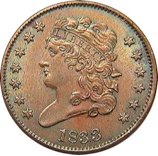
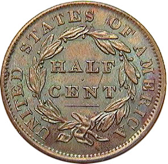
One of the tougher type coins to locate and collect in original condition, the Capped Bust, (also called the Classic Head), design appeared on Half Cents beginning in 1809 and ran through 1836. No Half Cents were issued between 1812 and 1824, mostly because demand for the denomination was low and the Mint had difficulty obtaining planchets. In 1825, Half Cent coinage resumed, with breaks in 1827 and 1829. Rare dates of this type include 1831 and 1836, both issued only as Proofs. Minted as noted above at the Philadelphia Mint. Specs: Weight-5.44 Grams. Composition: Copper. Diameter: 23.5 mm. Plain Edge. Designer-John Reich.
Book Recommendation
“Facts, Mysteries, and Myths about U.S. Coins” is this months book recommendation. It is a compendium of stories about U.S. coins and some of the myths behind the headlines. Written by Robert R. Van Ryzin it is a collection of stories from his years of research about coins and the people behind their making. It’s not intended to be a historical refereence but more of an entertaining read.I found a lot of the stories fascinating and for coin collectors it should be a fun, lighthearted read. A great deal of the book is about the people behind the minting of our coins and some of the liberties those people took in the minting of U.S. coinage. There is large variety of interesting information in this book. Perfect for a summer read!
NUMISMATIC QUESTIONS AND FACTS (August)
Q. Was the U.S. the first country to issue a clad coinage of the “sandwich” variety?
A. Silver was successfully fused to copper sheets and was employed for “sandwich” coinage as early as the eighth century by the Greeks. (Coins: Answers and Questions , C. Mishler, 2008).
Q. Did the Bureau of Engraving and Printing (BEP), produce the Military Payment Certificates (MPC) of WWII?
A. The WWII MPC notes produced in the U.S. were printed under the auspices of the BEP at 2 factories. They were the Forbes Lithograph Manufacturing Co.in Boston and the Stecher-Traung Lithograph Co. in San Francisco. WWII MPC’s were also produced by the British and the Soviet Union with the Soviet Union using printing plates engraved by the U.S.
Fact: U.S. coins and currency don’t have a monopoly on record prices. On May 1st 1912, 5 year Anne Judith Denman, was given the privilege of imprinting Australia’s first banknote. She was presented with the 10 Shilling note, Ser.# M000001and retained it till her passing in 1987. It first appeared for sale on the open market in 1999 when it was purchased by Australian dealer Barry Windsor for $1,000,000. In 2008 it was sold to John Pettit for $1.909 million. It is currently available for sale by private treaty by Belinda Downie of Coinworks with an anticipated sale price of $3.5 million! (Bank Note Reporter, K. Rodgers, Aug. 2013)
Coin of the Month.
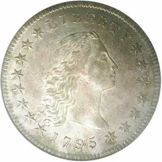
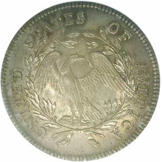
This month’s coin is the “Flowing Hair Silver Dollar”. The silver dollar was authorized by Congress April 2, 1792. The Flowing Hair design appeared on the first United States Silver Dollars in 1794, but only lasted until sometime in 1795, when it was replaced with the Draped Bust design. The 1794 Silver Dollar is a rare coin, represented by approx.150-200 survivors. The 1795 Silver Dollar is more common, but the demand from type collectors keeps the prices high. Minted from 1794 to 1795 at the Philadelphia mint. Specs: Weight- 26.96 grams. Composition: .8924 Silver and .1076 Copper. Diameter: 39-40 mm. Lettered Edge-HUNDRED CENTS ONE DOLLAR OR UNIT. Designer-Robert Scott.
Book Recommendation
A couple of years ago I recommended both the traditional “Red Book” and “Black Book” references. While indispensible as informational and retail pricing references, both books fail to provide dealer wholesale coin values. The “Blue Book”, published annually is the missing reference ro the prices a dealer will likely offer when presented with coins for sale.The following description is from Amazon.com’s website and provides an excellent description of the purpose and listings the “Blue Book” offers. “Since 1942, coin dealers have used the annual Handbook of United States Coins - THE OFFICIAL BLUE BOOK - to make buying offers. You can use it to find out how much your coins are worth! The Blue Book’s price listings offer a real-world look at the coin market, gathered from dealers around the country. Coverage includes colonial and early American coins, federal coins (half cents through gold double eagles), commemoratives, Proof and Mint sets, die varieties, private and territorial gold, tokens, the newest Presidential dollars, National Park quarters, bullion coins, and much more. More than 24,000 prices in multiple grades. Easy-to-follow coin-grading instructions. Coins and tokens from the 1600s to today. Historical information. Hundreds of detailed, actual-size photos. Collecting tips. An appendix on how to sell your coins. Detailed mintage records, and much more! Now 16 pages longer than the 2012 edition.” (Amazon.com)
NUMISMATIC QUESTIONS AND FACTS (June)
Q. What is a “pistareen”?
A. It was a debased 2 reales Spanish coin that circulated in Spain, the Americas, and the West Indies in the 1700‘s, equal to 1/5th of the Spanish dollar (8 reales). By 1827, it was down to 17 cents value in the U.S. (Coin Clinic, Numismatic News, 18 June,2013)
Q. Is gold straight out of a gold mine pure ?
A. Gold comes out of the ground in different purities, depending on the location of the mine. Typically, natural or 'placer' gold ranges from 65% to 98% pure, with most around 85%. Gold can also be found mixed with silver, copper, or other metals in varying percentages. And gold is often extracted in minute quantities per ton of dirt or ore. There are gold mines in Nevada that profitably remove .05 ounces, or about $14 worth of pure gold from a ton of dirt.
Fact: The only person officially tried and executed for war crimes committed during the Civil War was Captain Henry Wirz. Wirz was the Commandant of the infamous Andersonville Confederate prison camp. Of the 33,000 prisoners held there, over 12,000 died due to lack of medical attention, clothing, and proper nutrition.
Coin of the Month.
This month’s coin is the “Gold Dollar, Liberty Head Type”. Authorized by the Act of March 3rd, 1849. There are 2 varieties of wreaths on the reverse. Minted from 1849 to 1854 at the Philadelphia, Charlotte, Dahlonega, San Francisco, and New Orleans mints. Specs: Weight- .04837 oz. Composition: .900 Gold and .100 Copper. Diameter: 13mm. Reeded Edge. Designer-James B. Longacre.

Book Recommendation
This month’s book recommendation is “100 Greatest Coins” by Jeff Garrett. I am going to defer to Amazon’s description of this months' book since its written as well as anything i could write! “In the third edition of the best-selling and award-winning 100 Greatest U.S. Coins, numismatic author Jeff Garrett takes the reader on a personal guided tour of the nation's greatest coinage. "Each of the 100 Greatest was voted into place by leading coin dealers, researchers, and historians," says Whitman publisher Dennis Tucker. Inside the reader will find prized and seldom-seen rarities - the unique and high-valued pieces that collectors dream about, like the 1913 Liberty Head nickel and the 1804 dollar (the "King of American Coins"). The book also explores more readily available and widely popular coins: pieces so beautiful or with such strange and facinating stories that everybody wants one. By Jeff Garrett. Hardcover, 144 Full Color Pages” (Amazon.com) An excellent book and well recommended!
NUMISMATIC QUESTIONS AND FACTS (May)
Q. What were “Sanitary Fairs”?
A. The fairs were organized as fundraisers during the Civil War to provide money and supplies to improve the sanitary conditions faced by Union troops when they were in camps or hospitals. The first was held in Chicago in 1863. Before the war over nearly $14 million was raised and distributed by the U.S. Sanitary Commission. (Coin Clinic, Numismatic News, 9 April 2013)
Q. What is the origin of the dollar sign ($) currently in use on our currency?
A. According to the Readers Digest, the dollar sign is thought to be derived from the symbol of Philip V of Spain. The symbol is a ribbon winding between the two pillars of Hercules, Gibraltar and Ceuta.
Fact: “Gunsmoke” was one of the most popular and long running TV western series of all time. It featured James Arness as the Marshall Matt Dillon. It was a tough job on the show and he was frequently shot and injured in performing his storyline duties. According to noted western historian Marshall Trumble, Marshall Dillon, during the course of the show, was shot at least 56 times, knocked unconscious 29 times, stabbed 3 times, and poisoned once. Thats’s one tough lawman!
Coin of the Month.

This month’s coin is the “Three Cent (Silver)”. This smallest of U.S. coins was authorized by Congress on March 3, 1851. There are 3 varieties of lines enclosing the star. Minted from 1851 to 1873. Minted at the Philadelphia and New Orleans mints. Specs: Weight- .80 Grams (1851-1853) and .75 Grams (1854-1873). Composition: .750 Silver and .250 Copper (1851-1853), and .900 Silver and .100 Copper (18534-1873). Diameter 14mm. Plain Edge. Designer-James B. Longacre.
Book Recommendation
This months' book recommendation is “The Founding of the United States 1763-1815” by Gerry and Janet Souter. This book is similarly designed to a couple of other books I’ve reviewed in that the content is arranged as short articles supported by seperate related background pictures and information. But it’s biggest draw are the recreations of period documents that are included in folder sections of the book. There are recreations of Thomas Jefferson’s first draft of the Declaration of Independence with marginal notes by John Adams and Benjamin Franklin, George Washington’s Inaugural Address, and a copy of the handwritten Constitution among others. It certainly brings the period to life and makes for an interesting historical book vice the usual drab recitation of facts. Well recommended!
NUMISMATIC QUESTIONS AND FACTS (April)
Q. A number of western movies depict hangings where the hangman is a professional brought in to perform the execution. Did such a profession exist in the Old West?
A. There is very little to no evidence that such professional hangmen existed. The most famous hangman was George Meladon, who worked for “Hanging Judge” Isaac Parker of Fort Smith, Arkansas. Maledon started out as a deputy marshal and evolved into the position as Chief Executioner of the Federal Court presided over by Judge Parker. He got $100 a hanging and it’s said he executed 60 men. (Source: True West Magazine, M. Trimble, Oct. 2012)
Q. Is there more copper in a cent or a nickel?
A. The nickel, to the surprise of some, contains 75% copper or 57.87 grains. Cents minted prior to 1982 were composed of 97.5% copper but still only had 45.60 grains of copper each. The modern cent is copper clad zinc and is only 2.5% copper. So the nickel has more copper content than the cent.
Fact: When referring to the purity of gold, “karat” and “fineness” have different meanings. “Karat” is a jeweler’s term, while “fineness” is a coiners term for quantifying the purity of the precious metal in an alloy. Fineness denotes the number of parts of gold, or the percent of gold, contained in an alloy. A gold item identified as .750 fine contains 3 parts gold and one part of another metal, such as copper or other metals, and consequently contains 75% pure gold. A karat is defined as “a unit of fineness for gold equal to 1/24th part of pure gold to an alloy”. Thus, a gold item identified as 18-karat gold contains 75% pure gold, and consequently has a fineness of .750.
Coin of the Month.

This month’s coin is the “Two Cent Piece”. First U.S. coin with the motto “In God We Trust”. . Minted from 1864 to 1873. Minted only at the Philadelphia Mint. Specs: Weight- 6.22 Grams, Composition: .950 Copper and .050 tin and zinc. Diameter 23mm. Plain Edge. Designer-James B. Longacre.
Book Recommendation
This months' book recommendation is “The Comprehensive Catalog and Encyclopedia of Morgan and Peace Dollars”, by Leroy C. Van Allen and A. George Mallis. This book details known die varieties and variations, both significant and obscure, for Morgan dollars and Peace dollars. There is a significant group of specialized collectors that collect Morgan and Peace dollars by these varieties and this book is the bible for identifying those varieties. These varieties are identified by number and are called “VAM” numbers from the last name initials of the authors. While extremely detail oriented, VAM collecting has become very popular and knowledge of at least the top 100 die varieties (there are over 2,000 known) is very useful when collecting Morgan and Peace dollars and this book is a valuable reference for collecting this series of coins.
This is the recognized website for the Hemet Coin Club
Copyright © 2019 Hemet Coin Club. The original contributors retain the copyright of certain portions of this site.
For errors or corrections on the website, please Contact t